Trekking and Peak Climbing in Nepal
- Regd. No.:63295/065/066
- Tourism Licence:1632
- VAT No.:303818070
Home » Annapurna Guide » Annapurna Circuit Trek in January and February

Annapurna Circuit Trek in January and February
When winter arrives it’s cold everywhere, even in your bed. Well, if you are laying and waiting for winter to go away. That’s a bad idea. Rather go to a colder place and flare heat in your body. If okay, then trek to Annapurna circuit in January and February. Its difficult one but you know that “Difficult roads often lead to Beautiful Destinations”
Annapurna Circuit is a supreme place to stray and lost in nature and its wildness. It is the second-most walked trail only to Everest Base Camp trek in Nepal. Annapurna circuit trek in Autumn , Spring season are the most popular times. Whereas, due to rainfalls the Summer trek to Annapurna circuit is preferred by trekkers. So, if you are a peace lover and missed out on Autumn and Spring, the snowfall months of Jan and Feb are here to take you to Annapurna Circuit.
No rainfalls, clear skies and plain visibility of snow-filled mountains are some of the pros of Winter trek. The cold is worth enough to bear, as it provides the most beautiful views of the most beautiful peaks.
This trial will take you from traditional villages of the Lamjung to the snowy heaven. You will come across a range of ethnic peoples. Heavenly hills, snowfield mountains, fast-flowing rivers, and endearing villages are the main attributes of this Annapurna circuit trek . This circuit has ample beauty to pour in front of your eyes may resemble shutterbug’s paradise.
Poon Hill , one of the stops of this trek provides an astonishing view of sunrise over Annapurna Massif . From there you can enjoy the sight of towering peaks like Manaslu, Dhaulagiri, Annapurna I and several others. Likewise, “ Thorong La Pass ( 5416m ) the highest pass of the trek” this uphill climb can wake your long-hidden power.
Highlights of Annapurna Circuit trek in January and February
- Peaceful trekking routes
- Reaching the Thorong La Pass (5416m)
- Crystal-clear views of Mt. Manaslu, Mt. Dhaulagiri, and Mt. Annapurna
- Trailing through Nepal’s Largest protected area-Annapurna Conservation Area
- Beautiful villages and apple farms of Mustang region
- Evidencing the cultures and civilizations of the Annapurna region
- Visiting the most sacred Muktinath Temple
- Trails along with the speedy Marshyangdi River
- Walking by the world’s deepest gorge Kali Gandaki Gorge
- The breathtaking sunrise from Poon Hill
- Healing hot spring bath at Tatopani
Facts of Annapurna Circuit Trek
- The distance that will be covered – 260Km i.e 161 miles(Complete route)
- Length: 8 to 21 days
- Difficulty level – Moderate to Strenuous
- Highest point – Thorong La Pass(5,416 m) 17,769 ft
- Accommodation – Hotels, Teahouses
- Food – Nepali, Indian, Western Cuisine
- Permits required – Annapurna Conservation Area Permit and Trekkers Information Management System Card
- Full Name *
- Country * Afghanistan Åland Islands Albania Algeria American Samoa Andorra Angola Anguilla Antarctica Antigua and Barbuda Argentina Armenia Aruba Australia Austria Azerbaijan Bahamas Bahrain Bangladesh Barbados Belarus Belgium Belize Benin Bermuda Bhutan Bolivia Bonaire, Sint Eustatius and Saba Bosnia and Herzegovina Botswana Bouvet Island Brazil British Indian Ocean Territory Brunei Darrussalam Bulgaria Burkina Faso Burundi Cambodia Cameroon Canada Cape Verde Cayman Islands Central African Republic Chad Chile China Christmas Island Cocos Islands Colombia Comoros Congo, Democratic Republic of the Congo, Republic of the Cook Islands Costa Rica Côte d'Ivoire Croatia Cuba Curaçao Cyprus Czech Republic Denmark Djibouti Dominica Dominican Republic Ecuador Egypt El Salvador Equatorial Guinea Eritrea Estonia Eswatini (Swaziland) Ethiopia Falkland Islands Faroe Islands Fiji Finland France French Guiana French Polynesia French Southern Territories Gabon Gambia Georgia Germany Ghana Gibraltar Greece Greenland Grenada Guadeloupe Guam Guatemala Guernsey Guinea Guinea-Bissau Guyana Haiti Heard and McDonald Islands Holy See Honduras Hong Kong Hungary Iceland India Indonesia Iran Iraq Ireland Isle of Man Israel Italy Jamaica Japan Jersey Jordan Kazakhstan Kenya Kiribati Kuwait Kyrgyzstan Lao People's Democratic Republic Latvia Lebanon Lesotho Liberia Libya Liechtenstein Lithuania Luxembourg Macau Macedonia Madagascar Malawi Malaysia Maldives Mali Malta Marshall Islands Martinique Mauritania Mauritius Mayotte Mexico Micronesia Moldova Monaco Mongolia Montenegro Montserrat Morocco Mozambique Myanmar Namibia Nauru Nepal Netherlands New Caledonia New Zealand Nicaragua Niger Nigeria Niue Norfolk Island North Korea Northern Mariana Islands Norway Oman Pakistan Palau Palestine, State of Panama Papua New Guinea Paraguay Peru Philippines Pitcairn Poland Portugal Puerto Rico Qatar Réunion Romania Russia Rwanda Saint Barthélemy Saint Helena Saint Kitts and Nevis Saint Lucia Saint Martin Saint Pierre and Miquelon Saint Vincent and the Grenadines Samoa San Marino Sao Tome and Principe Saudi Arabia Senegal Serbia Seychelles Sierra Leone Singapore Sint Maarten Slovakia Slovenia Solomon Islands Somalia South Africa South Georgia South Korea South Sudan Spain Sri Lanka Sudan Suriname Svalbard and Jan Mayen Islands Sweden Switzerland Syria Taiwan Tajikistan Tanzania Thailand Timor-Leste Togo Tokelau Tonga Trinidad and Tobago Tunisia Turkey Turkmenistan Turks and Caicos Islands Tuvalu Uganda Ukraine United Arab Emirates United Kingdom United States Uruguay US Minor Outlying Islands Uzbekistan Vanuatu Venezuela Vietnam Virgin Islands, British Virgin Islands, U.S. Wallis and Futuna Western Sahara Yemen Zambia Zimbabwe Country
- Number of Travellers *
- Phone Number
- Approximate Date Day 1 2 3 4 5 6 7 8 9 10 11 12 13 14 15 16 17 18 19 20 21 22 23 24 25 26 27 28 29 30 31 Month 1 2 3 4 5 6 7 8 9 10 11 12 Year 2025 2024 2023 2022 2021 2020 2019 2018 2017 2016 2015 2014 2013 2012 2011 2010 2009 2008 2007 2006 2005 2004 2003 2002 2001 2000 1999 1998 1997 1996 1995 1994 1993 1992 1991 1990 1989 1988 1987 1986 1985 1984 1983 1982 1981 1980 1979 1978 1977 1976 1975 1974 1973 1972 1971 1970 1969 1968 1967 1966 1965 1964 1963 1962 1961 1960 1959 1958 1957 1956 1955 1954 1953 1952 1951 1950 1949 1948 1947 1946 1945 1944 1943 1942 1941 1940 1939 1938 1937 1936 1935 1934 1933 1932 1931 1930 1929 1928 1927 1926 1925 1924 1923 1922 1921 1920
- Send us your enquiry *
- Solve (6+6=?) & submit button will appear *
Weather conditions of Annapurna Circuit Trek In January and February
The weather conditions of the Annapurna region in January and February vary with altitudes.
Lower altitude areas are warmer than the higher altitude areas on the same day. The average temperature of Annapurna Base Camp (highest point of this trail) during January and February is -5 degrees C .The minimum temperature during January can mark -11 degree C . And, in February the temperature can get even colder by dropping to freezing -13 degree Celsius . On the other side, The lower altitude circuits are much comfortable to deal with
Let’s look at months specific weather and temperature of the Annapurna Circuit are places:
Annapurna Circuit place’s Temperature and Weather in January and February:
Pokhara | Altitude: 1400m | Min Temp Jan: 7.3°C, Max Temp Jan: 19.1°C | Min Temp Feb: 8.6°C, Max Temp Feb: 21.4°C
Ghorepani | Altitude: 2750m | Min Temp Jan: -3.3°C, Max Temp Jan: 7.2°C | Min Temp Feb: -2.2°C, Max Temp Feb: 9.4°C
Chhomrong | Altitude: 2340m | Min Temp Jan: -5°C, Max Temp Jan: 18°C | Min Temp Feb: -5°C, Max Temp Feb: 19°C
Dobhan | Altitude: 2600m | Min Temp Jan: -8°C, Max Temp Jan: 15 °C| Min Temp Feb: -8°C, Max Temp Feb: 16°C
Ghorepani | Altitude: 4130m | Min Temp Jan: -19°C, Max Temp Jan: 7°C | Min Temp Feb: -20°C, Max Temp Feb: 6°C
In the months of January and February, 19-24 days are sunny, 4-6 days partly cloudy, and some days are overcast. So, there is a very low chance of rainfall during the months of January and February. And, sunny days allow the best observance of clear and clean views of terrains and Mountains.
Similar articles you may like:
- Annapurna Circuit Trek in December
- Annapurna Circuit Trekking Map
- Trek Difficulty – Annapurna Base Camp
- Annapurna Circuit Trek in June, July, and August
Fitness Level Required For Annapurna Circuit Trek in January and February
Annapurna Circuit trek demands a good level of fitness. The average of 4-7 hours of walking is done every day. The entire trek covers 160km to 230km by foot. The toughest climb of the whole trek is from Thorong Phedi(4,540m) to Thorong La pass(5,416m). It normally takes 45 minutes to climb and tests your fitness level.
If you can walk for 7 hours a day, you are eligible for this trek. If not, you can do some fitness training to make yourself fit for this trek. Moreover, visit the doctor for a checkup and to discuss altitude sickness. Altitude sickness is the major problem of this trek. To avoid altitude sickness you should walk slowly and take Acclimatization day.
Annapurna Circuit Trek Difficulty in January and February
Annapurna Circuit Trek in January and February is a possible trek to do. There are some trekkers who favor this period to trek. The main issues are freezing cold, high altitudes, and snowfalls. The temperature during January and February is the coldest one. So, higher altitudes are even colder than lower ones. Also, an average of 6 hours walk per day is done. So, You may find it difficult to walk and cope with the cold.
Acute mountain sickness (AMS) is a common problem faced by trekkers. The level of oxygen lowers as you move up to higher altitudes. Headache, nausea, vomiting, dizziness, tiredness, loss of appetite, shortness of breath are the major symptoms of High Altitude Sickness . No immediate action can lead to serious health problems. If you can brace the cold and acclimatize well with altitudes, you can do it.
The snowfall can increase the difficulty level of Annapurna Circuit Trek in January and February. This area may receive moderate to an extreme level of snowfall during winter. Snowfall can add adventure depending on the level of snowfall. If it’s mild snowfall, you can trail on. If not, you have to make way back.
Pros of Trekking in January and February
Annapurna Circuit trek in January and February is most popular for the clear views of snow-capped mountains. During these months, this area receives little or no rainfall. No rainfall means no clouds and overcast. So you can just enjoy the gorgeous views of snowy hills and mountains.
Also, you will enjoy peaceful routes in the months of January and February . Plus, trekking in January and February is also cheaper as there is a winter discount offer. Altogether, Annapurna Circuit Trek in January and February is a lifetime experience.
Cons of while Trekking in January and February
The harsh cold is the main problem of Annapurna Circuit Trek in January and February. Temperature can fall down to -20 degrees Celsius . With a fall in temperature, it’s very difficult to walk. Sometimes, the high points of Annapurna Circuit are restricted or blocked to travel due to shivering cold or snowfalls.
Also, such highpoints have a higher risk of Avalanches. Thus, trekkers have to know every bit about the weather and conditions of Annapurna Circuit before tying shoelaces. Thorong la pass can be the most difficult trail due to harsh cold and ice-filled tracks.
Also, there will be fewer open tea houses around trails. Most Tea house owners move down to lower altitudes due to freezing cold. It means you need to carry some food items to face an emergency supply.
Accommodation During the Trek
Finding accommodation during January and February is the easiest thing to do. As it’s the off-season, the hotels and tea houses are mostly empty. You can also do some bargaining as well. Annapurna Circuit has hotels ranging from basic rooms to reasonably good hotels. They provide basic arrangements for your comfortable stay. They also provide heaters and hot waters to avoid cold. But keep in mind that, the price of accommodation increases as we move up.
Foods During the Trail
You will get a typical Nepali cuisine i.e Dal Bhat known. It is a popular trekking food in Nepal which can be found in other popular trekking routes like Everest Base Camp Trek , Manaslu Circuit Trek , Kanchenjunga Base Camp Trek , and Langtang Valley Trek . The mixture of steamed rice and cooked lentil with other condiments provides long-lasting calories. As the Nepalese say “ Dal Bhat Power, 24 Hour ”, you can walk the whole day by having one diet of Dal Bhat.
Annapurna Circuit hotels also serve snacks like steaks, pasta, chop suey, Macaroni. They also provide some energy and soft drinks. There are plenty of bakery shops as well in Annapurna Circuit. All you need to have is the money to buy.
Equipment List for Annapurna Circuit Trek in January and February
It’s too cold in Annapurna Circuit Trek during January and February. Your essentials have to be thicker and warmer. Here is the list of things you will need:
- A strong pair of trekking boots
- Thick windcheater Jacket
- Full Sleeve shirts
- Down jacket
- Waterproof trek pants
- Warm winter hat
- Thermal Underwear
- Woolen gloves
- Pair of Sandals
- Water purification system
- Sleeping Bag
- Toilet Paper
- Diamox- for altitude
- Paracetamol
- Anti-nauseant
- Mosquito spray
- Antibacterial sanitizer
- Playing Cards to kill time
- Notebook and Pen
- Voltage converter
Permits Required for Annapurna Circuit Trek
You need to have two special permits for the Annapurna Circuit Trek. These permits can be taken from both Kathmandu or Pokhara’s Tourist information center. The two permits are:
Annapurna Conservation Area Project Permit(ACAP)
Annapurna Conservation Area is a protected area in the Annapurna region. It is Nepal’s largest protected area. ACA is rich in biodiversity which is home to varieties of plants, mammals, birds, reptiles, and amphibians. You have to pay NRS 3,000 for the ACA permits.
Trekker Information Management System Card(TIMS)
This Trekker Information Management System Card is for the safety purpose of trekkers. TIMS Card is compulsory for ensuring the safety of trekkers in the trekking areas. There are various checkpoints in Annapurna Circuit where you have to show this particular card. If any visitor goes missing the checkpoints provide the exact search area. That is why it is an important card to get. The fee for specific regions trekkers are as below:
For SAARC countries trekkers TIMS Card fee are Group Trekkers: NRS 300 per pax, Free Individual Trekkers: NRS 600. Whereas, for Non-SAARC countries trekkers TIMS card fees are: Group Trekkers : NRS 1000 per pax, Free Individual Trekkers: NRS 2000 per pax
DO’s and DON’Ts of Annapurna Circuit Trek in January and February
Annapurna Circuit Trek is a difficult trek and even more difficult in winter months. So if planning for Annapurna Circuit trek in January and February, here are some Dos and Don’ts to look upon :
Stay Hydrated:
This is the most important thing while trekking. Drinking enough water makes you hydrated and walk continuously. High altitudes make you dehydrate so fast. So, be hydrated to walk easily in higher regions as well. Carry hot water it will help to warm your body.
Wear the Right Gears :
When trekking in winter, carry correct trekking gear. The right clothing and gears will make the trek easier and safer. Thick windcheater jacket, Full Sleeve shirts, Down jacket, Waterproof trek pants, Warm winter hat, Thermal Underwear, Woolen gloves, and Strong trekking boots are the perfect gears to wear in this trek.
Don’t consume alcohol:
Consumption of alcohol causes dehydration to your body. And, a dehydrated body is not got for any steep and strenuous trek.
Keep Diamox:
This is a high altitude trek, you have to reach the altitude above 5000 . During the trial, you can have altitude sickness. Diamox will help you to avoid this problem.
Don’t trek alone :
It’s very dangerous to travel without a guide in the Winter season. The trails can go crazy with heavy snowfall, so having a guide will be helpful in such situations.
Check the weather before embarking:
Harsh weather can be deadly in higher altitude treks. You have to be smart enough to check the weather forecast and prepare accordingly.
Altitude Sickness is real:
The altitude sickness in the Annapurna circuit can hit anyone, even the healthy and fit ones. Thorong La pass(5416m) is the highest reach of this trek. Inadequate acclimatization day and nonstop walk can lead to altitude sickness. Headache, nausea, vomiting, and lightheadedness are the major signs of Altitude sickness . It can take a life if immediate action is not taken after symptoms.
Don’t walk as if its race
The continuous walk is one of the factors causing altitude sickness. You may encounter breathing difficulty. So, walk as if it’s a slow walk-in Heaven. Give short breaks to yourself and then walk.
Travel Insurance
Annapurna Circuit trek is a difficult endeavor. Anything can happen on this trek to the Annapurna region . Travel insurance covers all the costs of bad events of the entire trek. For instance, events like Medical treatment, Lost of Luggage, Personal Items, and High-Value Items.
Please feel free to contact us if you are searching for any travel-related information.
Similar trips you may like:
- 13 Days Annapurna Base Camp Trek
- Mardi Himal Trekking
- Jomsom Muktinath Trekking
Managing Director
Mr. Subash K.C ventured into the tourism industry after completing his studies in Management Stream in 2001 at Tribhuvan University. Mr. K.C, born and brought up in the Lalitpur district, is keenly interested in exploring the different trekking routes. Getting the opportunity to work in the tourism industry helped him gather insights about trekking across Nepal. In addition, he also learned about customer care and group management. By leading solo and group trekkers himself, he started collecting data about many trekking destinations in Nepal. He creates an enriching experience for national and international travelers through exceptional hospitality.
Apart from managing trekking and tours, Mr K.C also handles client inquiries, accommodation reservations, arrangements of transportation and flights, and other logistics. Recognizing the importance of personalized service, he proactively takes care of clients' needs and requirements. He is fluent in English and excels in organizing treks, tours, and adventure sports in Nepal, Tibet, and Bhutan.
He is highly committed to promoting responsible tourism and prioritizes client satisfaction by providing top-notch service through his well-organized company. He believes that through responsible traveling, we can protect the natural environment and promote sustainability. He has expanded his knowledge by traveling to various countries worldwide, such as India, Bhutan, Switzerland, Germany, France, Italy, Thailand, China, Singapore, Philippines, Vietnam, USA, Japan, UK, Canada etc and is passionate about exploring more destinations.

- You are here:
- Annapurana Guide
Annapurna Circuit Trek During January and February
- Jun 4, 2024
- Marvel Adventure
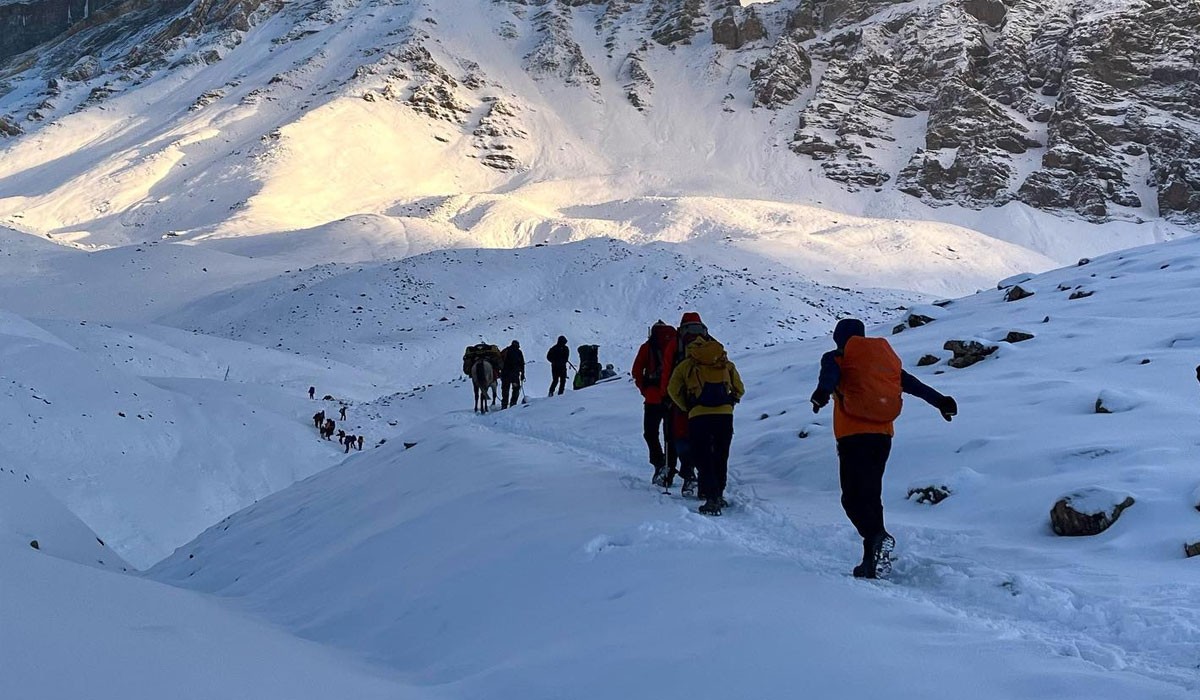
Annapurna Circuit Trek during January and February offers a unique trekking opportunity that explores the second mainstream trekking route in the Himalayas when the region is at its peak. This circumnavigating adventure of the tenth-highest peak in the world, Mt. Annapurna [8,091 meters/ 26,545 feet], in January and February, lets you experience a different side of the magnificent Himalayan region clad with the pristine blankets of snow.
During these months, the Himalayan region is at its pinnacle, and the entire landscape of the region is adorned with snow. The enthralling trekking experience across the beautiful landscapes with striking white-clad visuals, traditional settlements adapting to the cycle of nature, frozen lakes, vibrant festivals, and the opportunity to explore distinctive prospects of the Himalayas make trekking in these months a remarkable adventure. If you want to add thrills to your Himalayan exploration and don’t mind a little bit of cold, the Annapurna Circuit Trek during January and February will offer you a remarkable adventure with a great sense of accomplishment and a lifelong memory.
Table of Contents
Annapurna circuit trek in january.
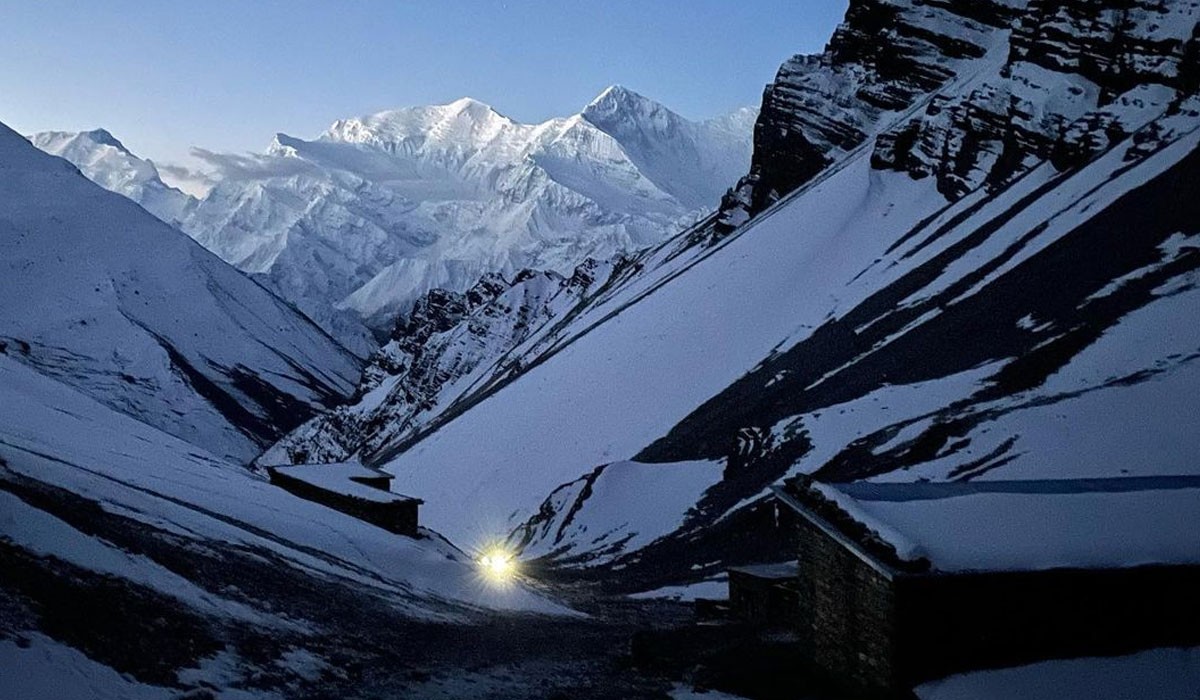
January is considered the peak of the winter season in Nepal; starting from December, the winter climatic conditions of the Himalayas reach their peak during January. However, it is also the best time to enjoy the magnificent landscape of the region covered with the pristine sparkling snow.
The temperature of the Annapurna region averages around 5°C to 10°C at the lower trekking trails; however, at the higher alpine altitude, the temperature can drop up to -10°C to -15°C during the night and early morning. So, if you are planning your trekking adventure in this month, make sure to pack right for an incredible experience.
Annapurna Circuit Trek in February
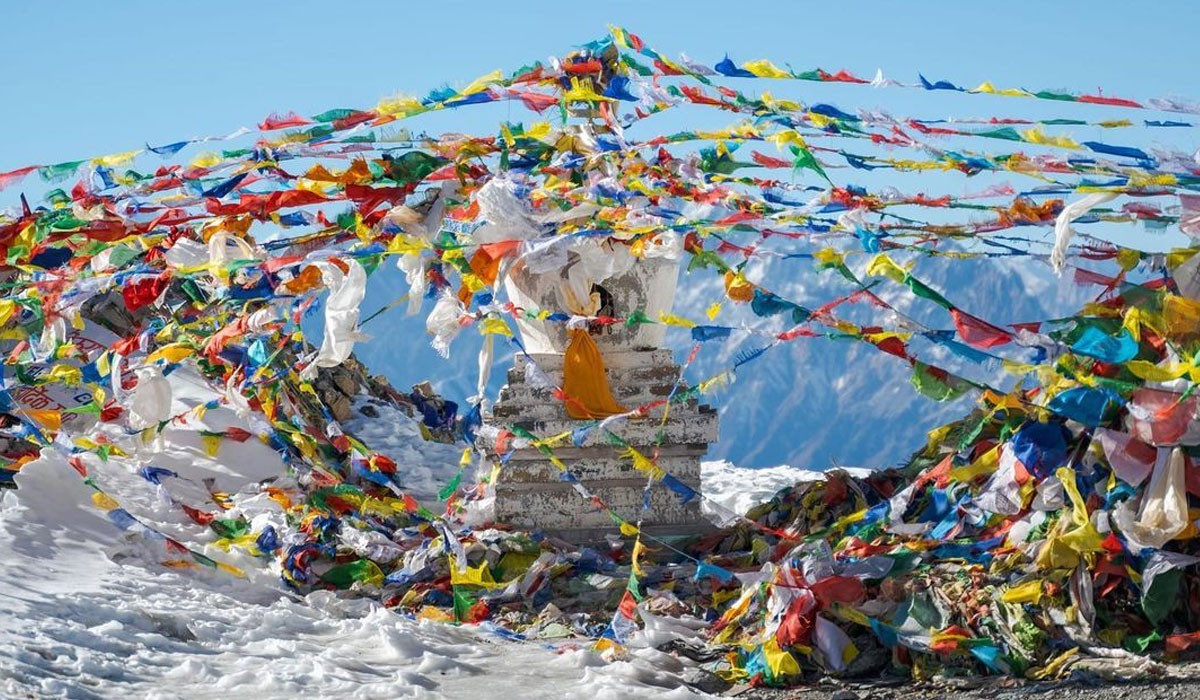
Compared to January, the climatic conditions are a little bit moderate during February. As the spring season is just at the doorstep, you might start seeing a few traces of the blooming season that slowly awakens the whole Himalayas.
This month adds a unique experience to your Himalayan exploration; you will get the opportunity to experience the true essence of the region at its peak and, at the same time, the fascinating cycle of nature that gradually introduces you to the stunning visuals of nature’s peak season. The day temperature of the Annapurna region at the lower trekking sections hovers around 8°C to 12°C and can drop up to -2°C to -14°C at the alpine altitudes.
Trek Duration
The general trek duration of Annapurna Circuit Trek is between 8 to 22 days; the itinerary plans of the package may differ depending on the highlight exploration, route, side detours, and acclimatization days. This iconic Himalayan expedition used to be a three-week exploration, however, thanks to the construction of the road on both sides of the circuit trekking route, the trek duration is now shorter and easily accessible.
Since 2015, the driving route in the Annapurna region stretches to Manang from the Besisahar side (eastern side) and all the way to Jomsom of the Kali Gandaki Valley (western side). Thus, now you can book the trekking packages that suit your taste and are within the timeframe of your vacation span.
Check our packages:
- 10 Days Annapurna Circuit Trek
- 12 Days Annapurna Circuit Trek
- 15 Days Annapurna Circuit Trek
Difficulty Level of Annapurna Circuit
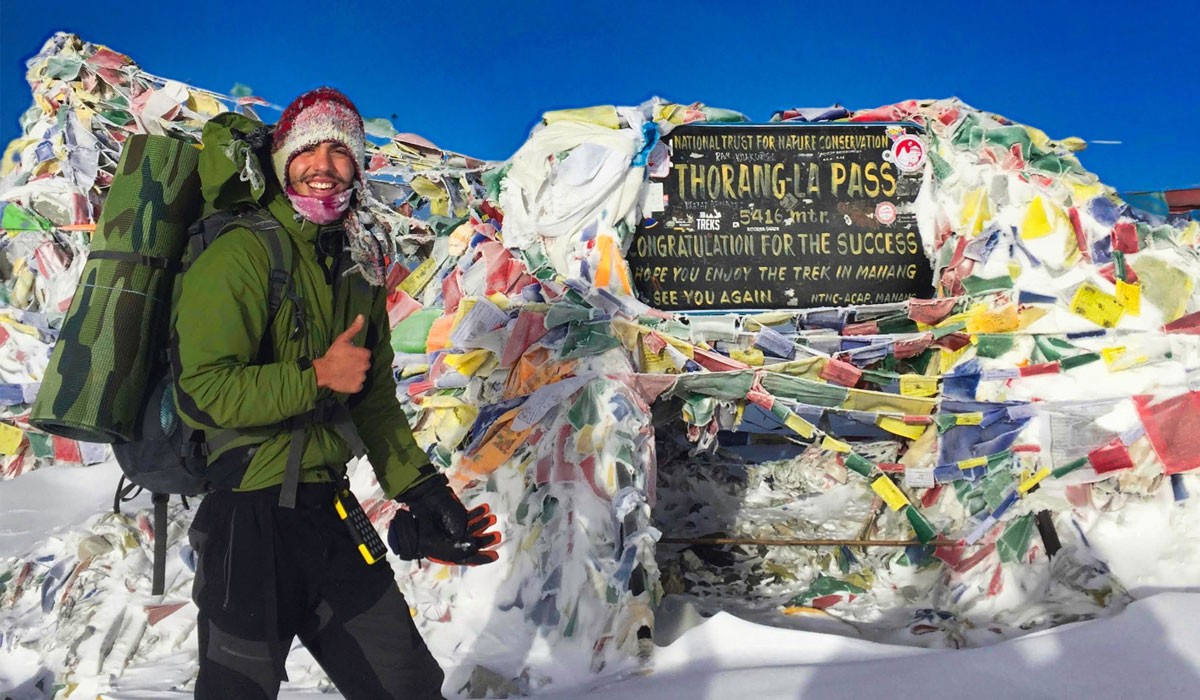
Annapurna Circuit Trek is one of the most iconic trekking adventures in the Himalayas that you have to try at least once in your lifetime. In case you are wondering about the difficulty level of this epic Himalayan exploration, it is just a ‘ moderate ’ level. You don’t need to have any prior Himalayan trekking experience or need to acquire any kind of technical skills to do this trek.
This amazing Himalayan exploration is perfect for even beginners who are new to the trekking game; however, you will still need to put in some effort to make the experience comfortable. Regardless of the moderate difficulty level, the Annapurna Circuit Trek is still a Himalayan exploration, and you have to overcome several challenging factors during your exploration, which is not easy to accomplish without enough preparation. Let's discuss some of the major hurdles in your Annapurna Circuit Trek during January and February that you have to overcome during your adventure.
Altitude Gain
Altitude gain is one of the major concerning factors in any kind of high-altitude adventure. It is hard for the human body to cope with an altitude above 2,500 meters due to the low oxygen saturation level. In your Annapurna Circuit Trek during January and February, you will traverse across significant altitudes of over 3,000 meters and 4,000 meters, so you will have to stay attentive toward any symptoms of altitude sickness .
Starting your adventure at Bhulbule (923 meters), you will move along the high elevation points like Lower Pisang (3,240 meters), Manang (3,540 meters), Yak Kharka (4,120 meters), Thorong Phedi (4,560 meters) and the highest elevation point of this adventure Thorung La pass (5,416 meters). So, you have to prepare adequately, stay hydrated, and pay attention to your body language to prevent altitude sickness.
Trekking Distance
The second hurdle of this beautiful exploration is the distance that you have to cover during your trekking adventure. The approximate trekking distance of the Annapurna Circuit Trek is approximately 160 km to 230 km , depending on the route and side excursion. So, during your trekking days, you will have to cover an approximate distance of 6-7 hours of walking on average.
It may not seem like a big deal at first; however, trekking for long hours at rising altitudes can be demanding and exhausting due to thin air. If you are not well-prepared for the long hours of walking, you may end up dragging yourself from one trekking point to another without actually enjoying the experience.
Yes, the Annapurna circuit is the second most popular trekking Himalayan trekking destination, but many forget to take into account that it is still a Himalayan exploration. This means you will be traversing across the remote part of the Himalayas, where the transportation facilities, infrastructural, and technological aspects are not well developed. So, if you're expecting anything like your regular vacation getaways, then you might end up getting disappointed.
Although you will be able to enjoy a moderate to grand level of services in this mainstream trekking route, they might not be on par with the top-tier services of an urban exotic tourist hub. So, you have to mentally prepare yourself that this exploration is about re-connecting with nature away from bustling life and not a luxurious cruise.
Acclimatization
If you have done any high-altitude adventure before, then you understand the importance of acclimatization in your exploration. It is recommended that when doing a high-altitude adventure, you should only gain up to 500 meters of altitude during a single day, and after overcoming over 1,000 meters of altitude, you should have an acclimatizing day.
So, if your trekking package doesn’t have enough acclimatizing days, you might struggle with day-to-day adventure and put yourself at risk of altitude sickness. So, finding the most ideal package for this expedition is an absolute necessity for a comfortable, safe, and memorable adventure.
Is Annapurna Circuit Trek Right For Me?
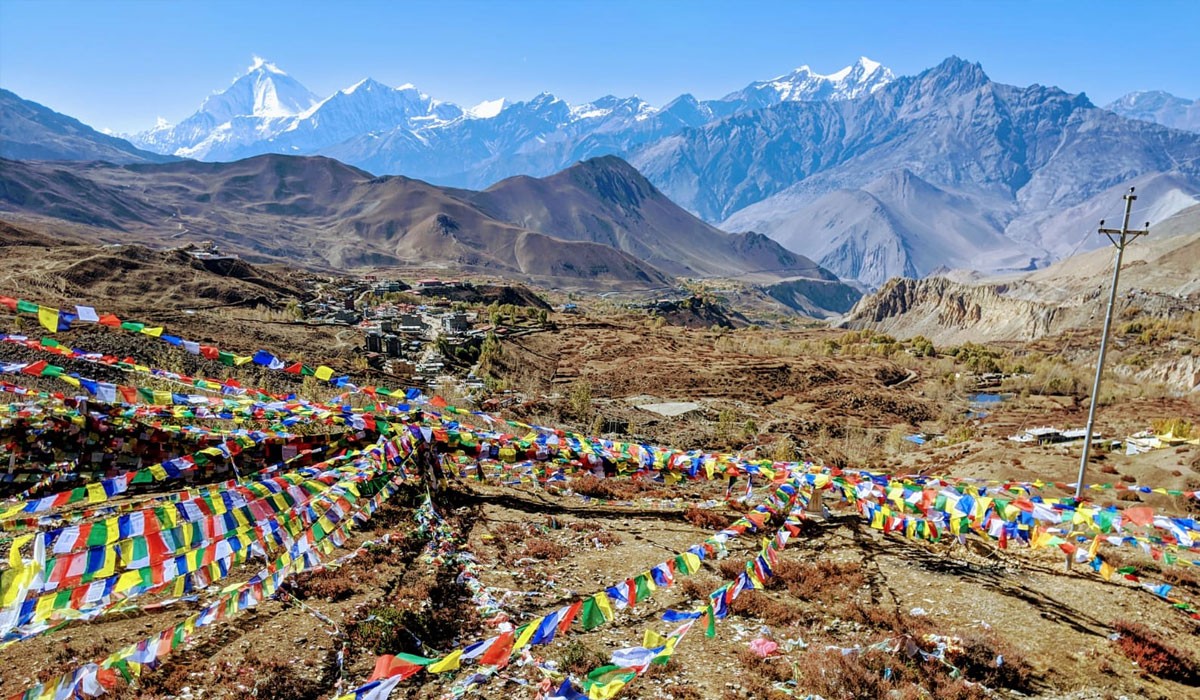
Considering the hurdles of the adventures, if you are wondering if this is the right adventure for you or not, rest assured. Even if you are a beginner, you can easily complete this Himalayan quest with enough preparation and determination. The difficulty factors of this expedition are relatively lower than other high altitude and remote exploration. Graded as a moderate Himalayan trekking adventure, the overall success rate of the Annapurna Circuit Trek is 98% to 100% .
So, if you have a basic level of fitness and good health conditions, you will be able to easily complete this expedition. Just don’t miss out on the preparation part and put some effort during your training to enjoy a comfortable experience. In case, you have any kind of health issues, you can consult your physician and trek guide for the trek.
Training and Preparation for Annapurna Circuit Trek During January and February

As Annapurna Circuit is a Himalayan adventure, you are recommended to prepare at least 4-6 weeks prior to your expedition. This way, your body will get enough time to get used to the physical activities. If you are an athlete or work out routinely, you may not need to put in a lot of hours during your training; however, if you don’t work out that much, then, you need to set an effective training program after assessing your physicality.
Doing practice hiking at steep landscapes is considered to be one of the most effective ways to prepare for the Annapurna Circuit Trek during January and February. As you have to overcome long hours of trekking, you are recommended to focus on strength, endurance, and cardiovascular exercises.
Strength and Endurance Exercises: Pull up, push up, plank, deadlift, squat, lunge, bicep curl, bench press,l overhead press, dips, etc.
Cardiovascular Exercises: Running, swimming, rowing, jogging, power walking, rope jumping, aerobics, etc.
Why Annapurna Circuit Trek During January and February?
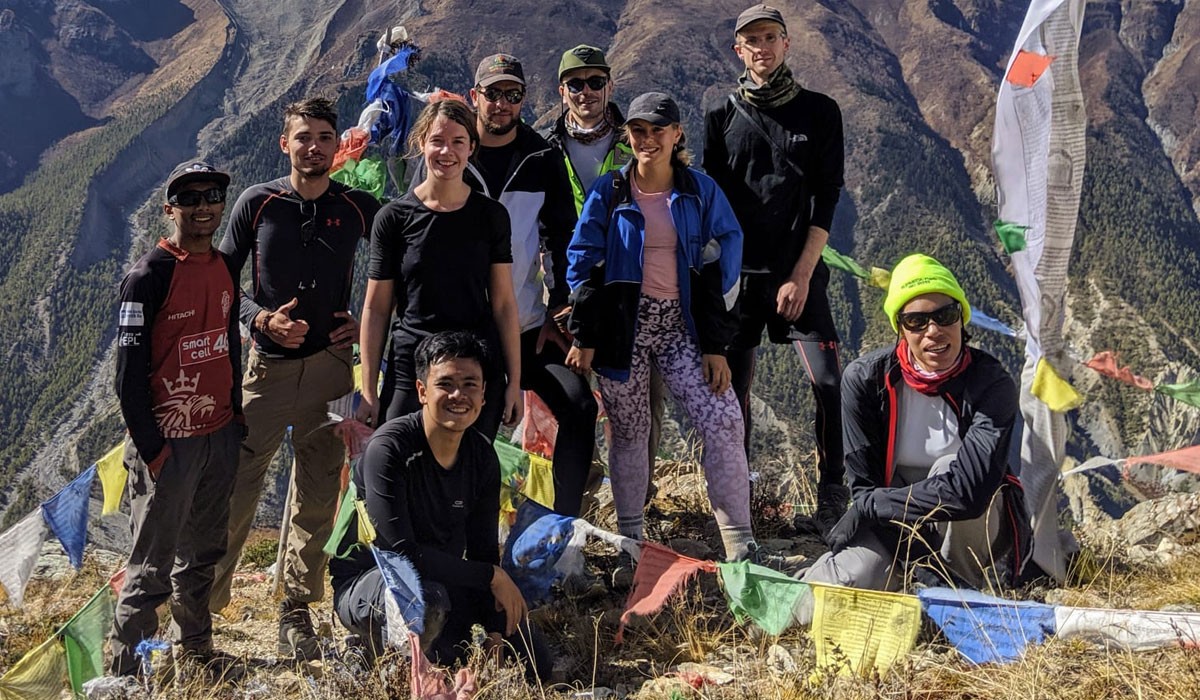
Magnificent Landscapes
The winter season is known as the peak season of the Himalayas doing the Annapurna Circuit Trek during January and February will offer you the most incredible views of the magnificent massifs at its peak. Even your higher trekking trails are covered in snow, so you will be able to enjoy the views of the pristine snow-clad landscapes that reflect the true magnificence of the Himalayan region.
Trekking amidst the surreal landscapes covered with the snow-clad blanket creates a picturesque setting that makes you feel like you have entered an enacted winter wonderland.
Clear Views
Although doing the Annapurna Circuit Trek during January and February may feel like you may not catch the incredible unobstructed views of the Himalayan vistas like the spring season, however, even if it is winter, the skies are often clear, and nothing like the skies covered with rain clouds in the monsoon season. So, even when trekking during these months, you will have the opportunity to enjoy the picturesque views of the wide, stunning vistas. The snow-clad terrains make the views of snow figurines even more magical as they reflect how truly magnificent the Himalayan region is.
As these months are considered off-seasons, while doing the Annapurna Circuit during these months, you can expect less crowd on the trails. Many trekkers prefer exploring the Annapurna circuit during the peak seasons like autumn and spring. However, they often have to deal with the crowded trails and struggle with peaceful exploration.
However, if you choose January and February for this remarkable trekking adventure, the trekking routes are less crowded. Although, you will find some other true explorers like you along the trail who want to experience the magnificence of the Himalayan region at its pinnacle. It is nowhere near the crowded trekking trails of the peak season, so you can expect to enjoy a peaceful trekking route, immersed in the serene ambiance of the enthralling Himalayan region.
Festive Season
The winter season also invites a festive atmosphere in Nepal, this beautiful Himalayan country celebrates some of the fascinating and immersive festivals during January and February. So, if you are planning your Annapurna Circuit Trek during January and February, you will have the opportunity to add cultural prospects to your Himalayan exploration.
Maghe Sankranti, Saraswati Puja, Basanta Panchami, Losar, Tibetan New Year, Maha Shivaratri, and the festival of colors, Holi, are some of the grand festivals that are celebrated in Nepal during the winter season.
Cheaper Services
The winter and monsoon seasons in Nepal are considered the off-season when tourist activities are pretty low. So, while doing Annapurna Circuit Trek during January and February, you can expect the cost of the services and amenities to be pretty low. Unlike the surge of trekkers during the peak seasons, only a limited number of trekkers set out on the exploration of the Himalayan region, so besides the cost of services being low, you can also expect the teahouses to provide special offers and extra amenities.
For instance, in Annapurna Circuit Trek during January and February, some teahouses may provide extra blankets, free warm beverages, room heaters, etc, whereas your trekking agencies may offer your free trekking equipment like sleeping bags, heavy down jacket, and other kits to deal with the cold. So, not only will you enjoy trekking at lower costs, but you can also enjoy the free amenities to make your journey more comfortable.
Photography Opportunities
While doing Annapurna Circuit Trek during January and February, the unique lighting condition of the snow-clad terrain sets off the perfect conditions for striking photographic moments. The landscapes are covered with pristine snow, and the unique beauty of the settlements adorned with snow allows you to capture the incredible beauty of the winter perspective. Further, the magnificent frozen lakes of the region create an otherworldly atmosphere and add tranquility to the surrounding snow-clad landscapes.
Food and Accommodation on Annapurna Circuit Trek During January and February
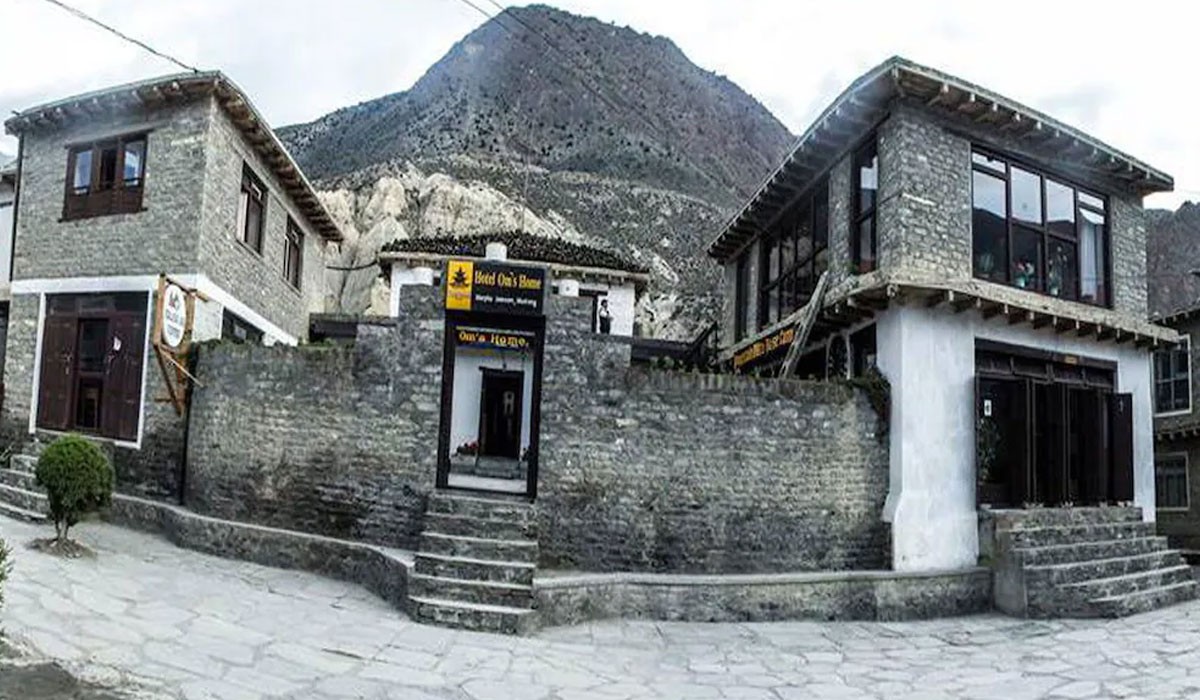
Annapurna Circuit is the second most popular trekking destination in the Himalayas; you can expect a wide range of delicacies to keep you warm during your exploration in January and February. You will be able to enjoy diverse delicacies that represent the whole nation, including the delicacies inspired by neighboring cultures like Indian and Tibetan.
For breakfast, you will be able to enjoy a light menu like bread and toast with jam, butter, or honey and other dishes like pancakes, cornflakes, oats, muesli, paratha, etc. As for lunch and dinner, the heavy traditional meal Dal Bhat Tarkari (steamed rice, lentil soup, and vegetable dishes) takes the first spot. You will also be able to savor other delicacies like momo, Chowmein, macarons, pizza, spaghetti, sandwiches, Thukpa, meat dishes, fries, burgers, etc.
Note: Vegetarian and vegan options are also available.
Accommodation
During your trekking adventure in the Annapurna region, you can enjoy moderate to luxury level of accommodation facilities. In a standard package, you will be accommodated in well-furnished rooms at the teahouses; there are two to three adjacent beds in a single room. The beds are equipped with comfortable mattresses and clean sheets; you will receive a pillow and warm blanket during your stay. The bathroom facilities are also on a shared basis in a standard package if you want a more personalized experience, then you can go for a luxury package.
Send an Enquiry - Annapurna Circuit Trek During January and February
Recent post.
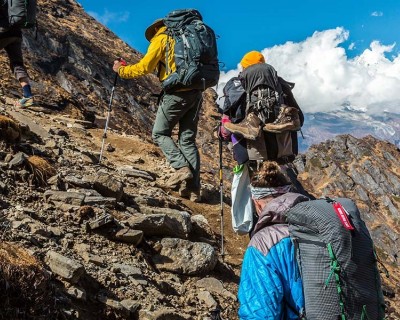
Packing Essentials for the Kanchenjunga Trek
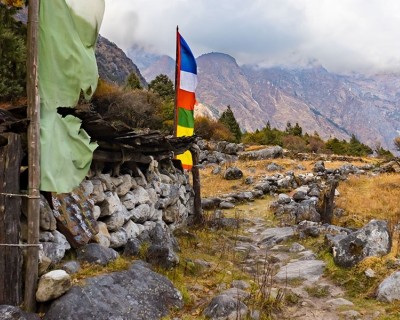
A Day in the Life on the Kanchenjunga Trek: What to Expect on the Trail
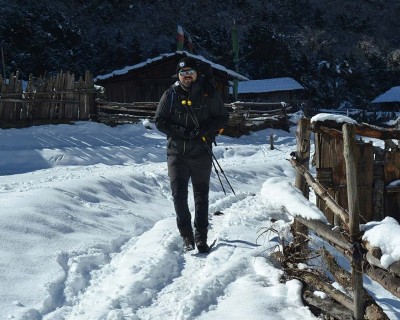
Kanchenjunga Trek for Beginners: Is It Possible?
- Annapurana Guide - 16
- Climbing - 1
- Dolpo Trek Guide
- Everest Guide - 58
- Kanchenjunga Guide - 11
- Langtang Guide - 6
- Makalu Trek Guide - 2
- Manaslu Trek Guide - 19
- Mustang Guide - 4
- Nepal Trekking Tips - 9
- Places to see in Nepal - 4
- Things to do in Nepal - 14
- Trekking in Nepal - 12
- Uncategorized - 5
Marvel Adventure Pvt. Ltd.
Share this:
Marvel adventure affiliations & certificates, registered with: company registration office, government of nepal, licensed by: nepal tourism board & department of tourism, proud member of trekking agency's association of nepal, general member of nepal mountaineering association.
- Meet the Team
- Our Manifesto
- Work with Us
- Budget Travel
- Personal Development
- Work & Travel
- United Kingdom
- More of Europe
- Philippines
- More of Southeast Asia
- More of South America
- More of Central America
- South Korea
- More of Asia
- More of North America
- New Zealand
- Pacific Islands
- More of Oceania
- South Africa
- More of Africa
- More of the Middle East
- Travel Essentials
- Travel Gear
Home » Asia » Nepal » The Annapurna Circuit and Beyond: Ultimate Guide to Hiking in Nepal (2024)
The Annapurna Circuit and Beyond: Ultimate Guide to Hiking in Nepal (2024)
Until 1951, Nepal was off-limits for foreign travellers; a secretive, isolated kingdom kept under wraps from outsiders…
But a change of regime gave birth to a new era of travel, and Nepal has remained a magnet for intrepid adventurers for over 70 years.
It was the summiting of Annapurna I – before that of Everest – that captivated the world of mountaineering and turned the spotlight on Nepal as an outdoor-lover’s haven in the Indian subcontinent.
This guide will offer everything you need to know to explore the majestic Annapurna region and get to grips with experiencing Nepal on foot. There’s a magical culture of generosity and kindness to discover, against a backdrop of some of the most impressive peaks to be found anywhere on earth.
There are three main routes we’ll cover here – the Annapurna Circuit , the Annapurna Base Camp ( Sanctuary ) trek, and the Mardi Himal Trek . These are each superb journeys in their own right, and escape the much heftier permit fees that visits to some parts of the Annapurna Conservation Area require.
Read on for all you need to wander your way through the Annapurna massif.
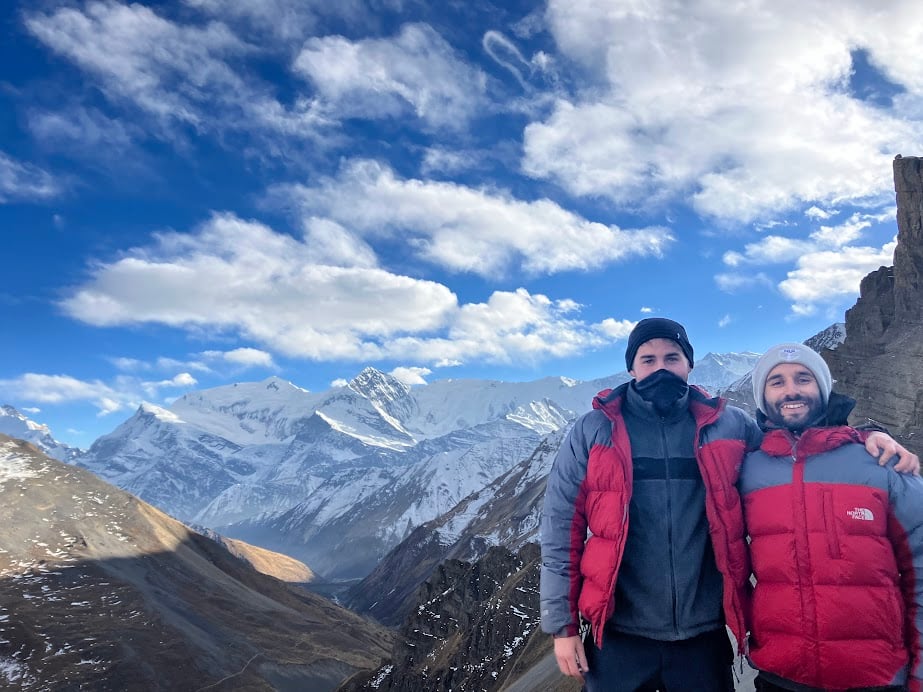
The Broke Backpacker is supported by you . Clicking through our links may earn us a small affiliate commission, and that's what allows us to keep producing free content 🙂 Learn more .

Do You Want to Travel FOREVER??
Pop your email in below to get a FREE copy of ‘How to Travel the World on $10 a Day!’.
Where is the Annapurna Region?
A household name when it comes to backpacking Nepal , the Annapurna Conservation Area covers nearly 3000 square miles of stunning terrain, and spans five districts in the central part of the country.
This includes the Annapurna massif, a monstrous range of mountains home to thirty peaks over 6000m. Here you’ll find Annapurna I , the tenth-highest mountain in the world, and the first over 8000m on earth to be summited.
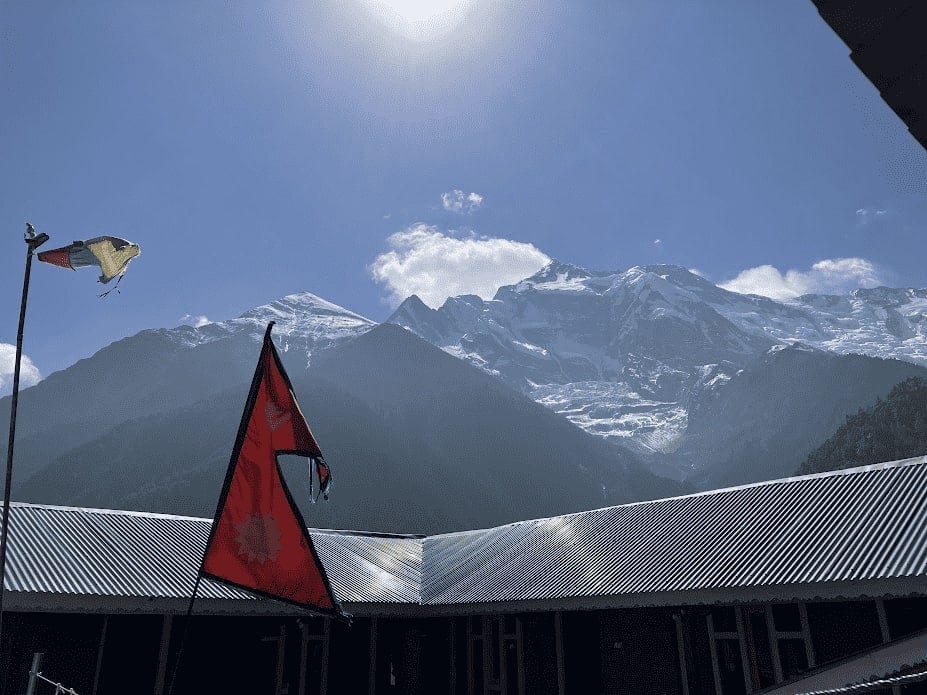
If that’s not enough, the Khali Gandaki gorge – which the Annapurna Circuit weaves through – is believed by many to be the deepest gorge in the world . Across the gorge lies Dhaulagiri , the world’s seventh-highest peak at 8167m.
As you’d expect, it’s a ridiculously impressive and unique part of the world that feels almost ethereal at times.
The starting points for most treks in the area are easily reached from Pokhara . This backpacker hangout is also an ideal place to sort your stuff. Shop for nearly-genuine but well-made outdoor equipment for your foray into the mountains, and stash any surplus travel gear while you’re away.
When is the best time to visit the Annapurna Conservation Area?
There are two main trekking seasons in Nepal: Autumn and Spring .
The Autumn season includes September, October and November , when clear skies should permit superb panoramic views of the jagged skyline. Temperatures are typically quite mild and the chances of heavy snow are relatively low. The trail and teahouses may well be quite lively. Across October, you’d also catch the festivals of Dashain and Tihar , giving rise to an abundance of kites, lights, and bamboo swings.
The Spring season covers March , April and May . As it melts, the preceding snowfall breathes new life into the rhododendrons (Nepal’s national flower), and, like Autumn, the temperatures should be manageable. The weather can be changeable, however. For example, this year, a relatively dry and mild February gave way to heavy snow and extremely nippy weather throughout March. Pack wisely, whatever season you’re aiming for.
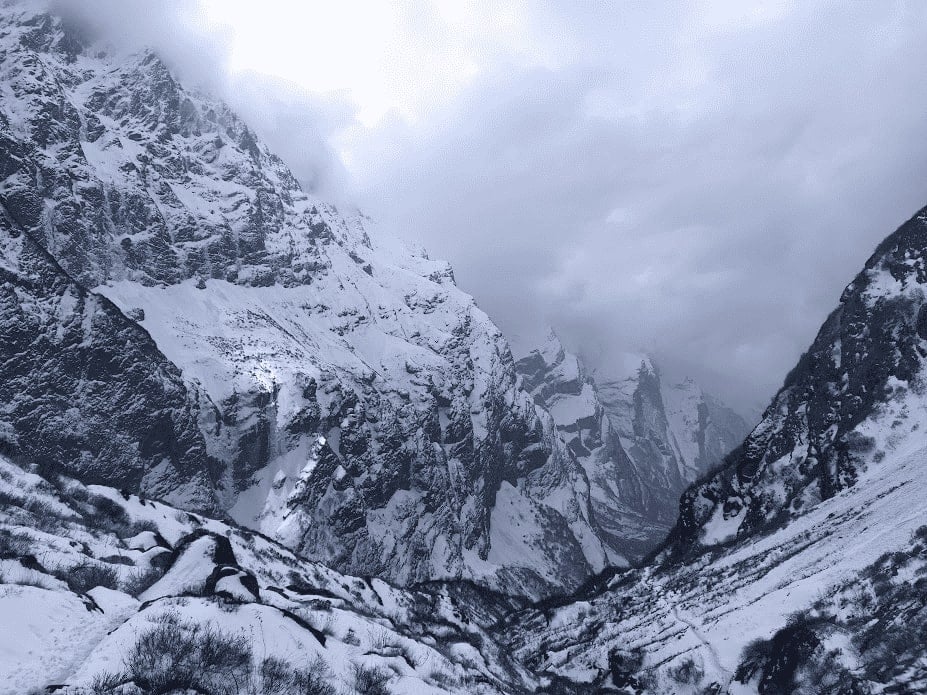
Trekking in Winter is less common, but certainly possible: December, January and February can be uncompromisingly chilly. We’re talking lows of minus 20 degrees Celsius. On the Circuit, be prepared for the possibility of days spent in teahouses waiting for the pass to reopen, and invest in a proper winter sleeping bag (read on for the low down on gear).
But there are enough teahouses that remain open to take on the treks discussed here, and your resolve will be rewarded with clear views of snow-capped peaks and a relatively empty trail.
Last and least appealing, is the monsoon season ( June, July and August) . The rains obscure the views, the trails become sodden and mudslide-y, and the leeches come out to nibble. (If you want to trek in the summertime, you’re better off heading to the Karakoram Mountains of Pakistan , the Indian Himalayan region, such as Ladakh or Himachal Pradesh, or Nepal’s Upper Mustang which is protected from the rains.)
Introducing the Routes…
I would urge you not to overthink which trek to do: the main thing to consider is time, as something like the Circuit takes a good chunk of the calendar, and it’s better not to be rushing around. Each route has its charms and challenges, which are likely to change on each and every journey on foot. Read on and see which takes your fancy.
1. The Annapurna Circuit
The Annapurna Circuit Trek is one of the most renowned and cherished trekking routes in the world, found on many travellers’ bucket lists.
First opened in the late 70s, the circuit takes you high into the Annapurna massif and right to the edge of the Tibetan plateau, crossing the Thorong La Pass at 5417m. This is one of the highest mountain passes in the world . Not too shabby.
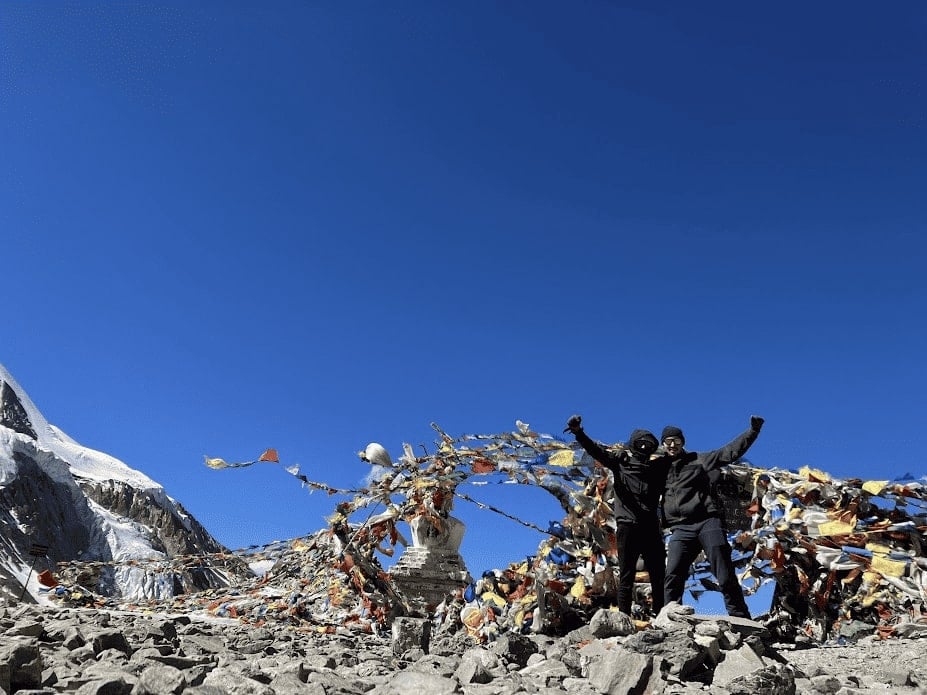
The circuit is a significant undertaking. Completing the full route usually takes around three weeks. However, this can be shortened by taking a jeep up and down the valleys either side of the pass for some of the way…
If you have time, it’s certainly worth going all in by starting in Besisahar and finishing in Nayapul. It’ll be better for both the body and gaining respect from hippie-trail hikers who did it back in the day…
Get ready for a stunning stroll: the Annapurna Circuit is a classic for a reason.
How many days does the Annapurna Circuit trek take?
The full circuit takes around 20 days, while variations on the route can massively reduce the distance covered and time taken to around 10 days.
It may be tempting to skip walking parts of the ‘road’ section, but to be honest, the traffic is usually minimal on the track and the views are still excellent so don’t be too quick to hop in a 4×4. Climbing from the original start point of Besisahar or nearby will pay dividends in terms of acclimatisation.
Suggested Annapurna Itinerary and Notes
The trail is well supplied, with teahouses scattered relatively frequently along the path. The below table contains a suggested itinerary but can also be used to plan your own, using the village names, altitude and distances between them.
Keep things flexible on your trek, both by stretching, and building in some leeway in case you need an extra day of acclimatisation (or just don’t fancy leaving the hot springs in Tatopani).
How do I visit Tilicho Lake?
On the Annapurna Circuit, you’ll have the option for an out-and-back trip to Tilicho Lake, the highest glacial lake in the world !
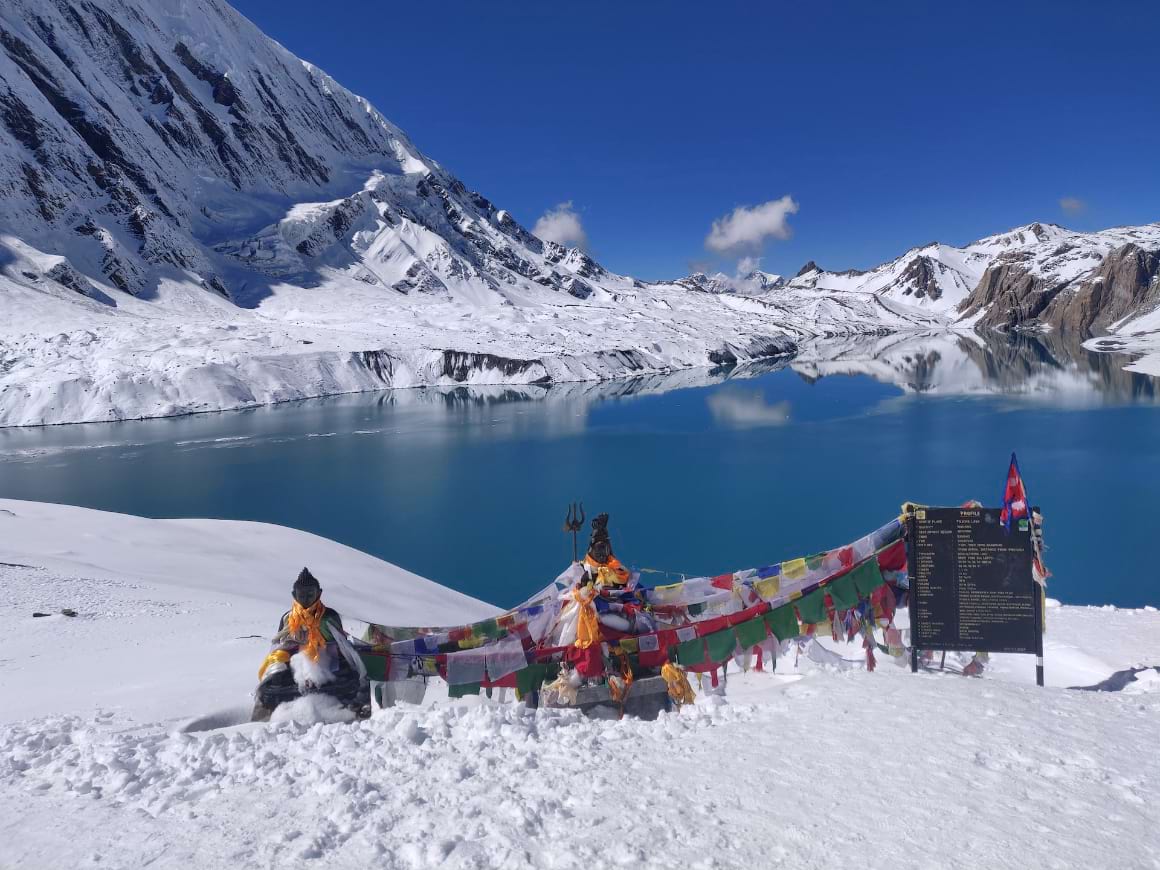
It’s not an easy side-quest. You’ll start from Manang at 3519m, and climb up to above 4900m to reach Tilicho, usually over two or three days. Along the trail you’ll find Shree Karka and Tilicho Base Camp for overnighting, as you can’t stay at the lake itself.
In winter, don’t be too surprised or disappointed if the water is frozen…it’ll still be a wicked couple of days out.
2. Annapurna Base Camp (Annapurna Sanctuary)
The Annapurna Base Camp lies right in the heart of the ‘Annapurna Sanctuary ’ which is a protected area but not an official Nepali national park .
The full trek can be completed in around a week, covering 100km and reaching 4130m, although route variations can be made.
This place is something special, both physically, and culturally. Held as sacred by the Gurung people, this glacial basin is only accessible via a thin pass between the peaks of Hiunchuli and Machhapuchhre .
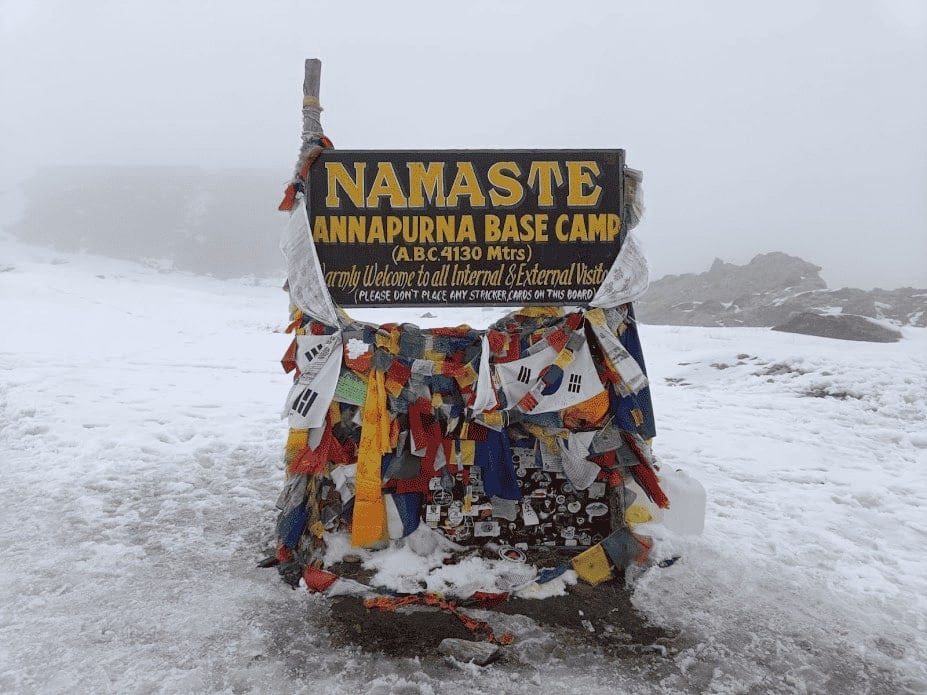
The Base Camp itself can feel quite bizarre. You’ll find statues of climbers lost on epic expeditions in years gone by, yet today, you might wake up to skiers and wedding parties being dropped off by helicopter to catch the morning sun…
However, you’ll sip your chai with a sense of satisfaction having reached this surreal spot on foot and braving the weather. Watching the sunrise hitting the dramatic skyline is a just reward for taking on this outstanding Nepali adventure.
How many days does the Annapurna Base Camp (Sanctuary) trek take?
The Annapurna Base Camp trek can take between 7-10 days, depending on fitness, whether you’ve previously acclimatised to the altitude, and route options. See the suggested itinerary below for inspiration, but don’t be afraid to use the list of villages to create your own plan (being mindful of altitude gain).
Suggested Itinerary and Notes
It would be very difficult to get lost on the Annapurna Base Camp trek, as all villages tend to lie on the single trail leading to the basin. A list of places to stay can be found below.
Popular ‘linkages’ include adding on a day at Ghorepani for a sunrise at Poon Hill, or joining the Base Camp route at Ghorepani having completed the Annapurna Circuit anti-clockwise.
These options are noted on the table below.
3. Mardi Himal
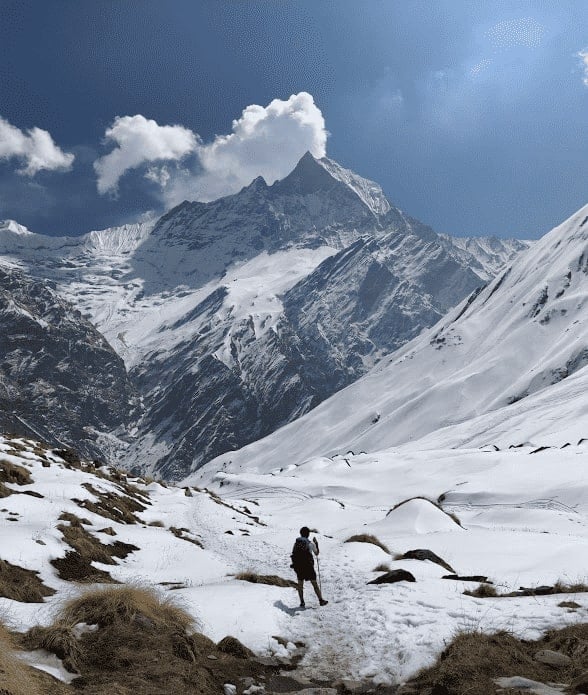
Mardi Himal is a relatively new trekking route, and it’s an absolute cracker.
On the Annapurna Base Camp trek, you look across the valley at an imposing landscape that appears unattainable. This is where the Mardi Himal route takes you.
Passing through rich rhododendron forests, you’ll eventually reach the High Camp teahouses, which seem to be dotted precariously on the ridgeline. It’s a truly remarkable place , and the final push to Mardi Himal Base Camp is equally majestic.
Plus, if you’re short on time, the trek can be completed in well under a week, and the Himalayan views are up there with the very best to be found.
What’s not to like?!
How many days does the Mardi Himal trek take?
The Mardi Himal trek is usually completed in 4 days. The elevation gain is quite fierce if you head straight from Forest Camp to High Camp, so if you’re struggling at all with fitness or the altitude, add in an extra sleep at Low Camp.
For the immersion in the mountains you’ll be rewarded with, this it’s a superb shorter trek option that’ll take you up to 4500m.
Like with the other routes discussed, you can use the following list and a paper map to devise your own plan, however, you can’t sleep at the Base Camp, so sleeping at High Camp is certainly the best option.
The itinerary for the way back just depends on personal preference and speed, but don’t go so quick you miss savouring the views.
After an early out and back to Mardi Himal Base Camp, you can then stay again at High Camp.
Alternatively, there’s certainly time to continue back down the trail towards Low Camp, or even get a 4×4 back to Pokhara that same evening from Sidhing (public bus from Lumre) if you’re speedy.
Beware, in the depths of winter or otherwise, if the snow is thick, it may well be that reaching the Base Camp isn’t possible and that the Upper Viewpoint stops you in your tracks. The trail can easily disappear in the snow and clouds, and it can become unclear what is solid ground and what is the edge of a steep drop.
Don’t take stupid risks at this point in trying to push on. Even if the viewpoint is the furthest trekkable point, it’s still super exciting being up on the ridgeline freshly covered in snow.
The Mardi Himal Trek is gaining in popularity, and rightly so. It almost feels as though you can reach out and touch Machhapuchre (‘fishtail’) from the upper reaches of the trail, while the dense forest below provides some cool variation in terrain.

We’ve tested countless backpacks over the years, but there’s one that has always been the best and remains the best buy for adventurers: the broke backpacker-approved Osprey Aether and Ariel series.
Want more deetz on why these packs are so damn perfect? Then read our comprehensive review for the inside scoop!
A Few Other Options in Annapurna Region…
Here’s a quick overview of some other trekking routes in the region to consider. There are so many ridiculous spots in this area, grab a map and head somewhere – it’s likely to be a winner.
4. Manaslu Circuit
An epic 12-14 day excursion over the Larke Pass, reaching 5100m . This route is more expensive than the Annapurna Circuit, as additional permits are required.
These include the Annapurna Conservation Area Permit (needed for the ABC, ACT and MH treks too), the Manaslu Conservation Area Permit (MCAP), and a Restricted Area Permit (RAP). During the Autumn season (September to November), the RAP is $100 for the first week and then $15 for each extra day in the restricted area.
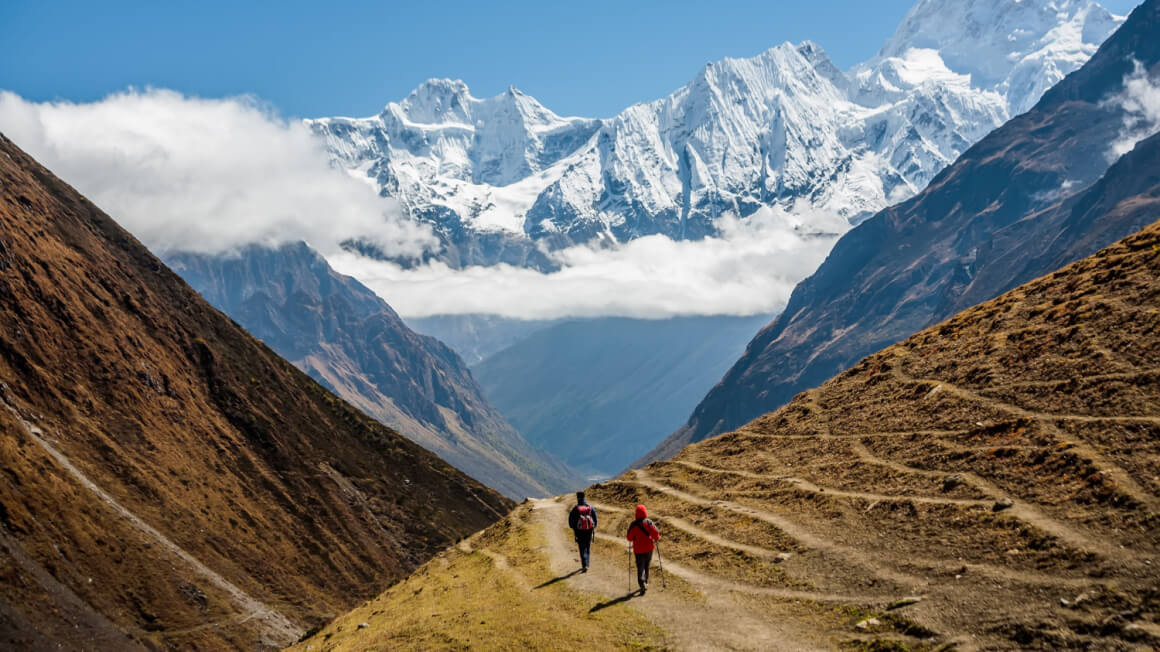
These figures are lowered to $75 and $10 for the rest of the year. It’s also rightly essential to take a guide on this route – this was always the case, well before the recent rule changes, due to the area being restricted and more remote than other routes.
If you’re able to shell out for the permits and guide, this beast of a trek is guaranteed to be a grand adventure.
5. Poon Hill
Poon Hill is an introductory-level trek, over 3 or 4 days. The climax is waking up early in Ghorepani to witness sunrise at Poon Hill, offering panoramic views of both Annapurna and Dhaulagiri.
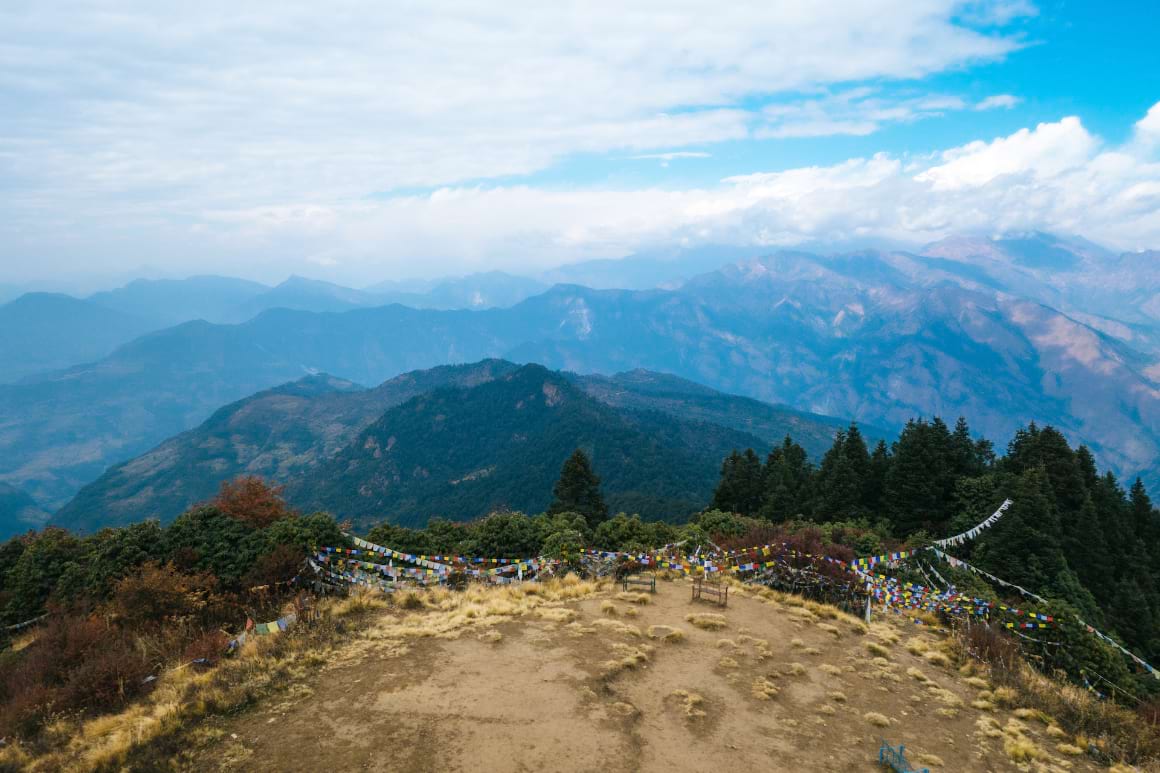
Be ready for a chunky number of stairs on the first day from Nayapul, and some potentially busy trails: this route can become quite a highway in busy season. But if you’re short on time or new to trekking, the reward/effort ratio is strong as the views are still spectacular.
6. Mohare Danda
A fantastic alternative option for a short trek, just outside the Annapurna Conservation Area, which requires no permit or guide! The route is much more off the beaten path than the likes of Poon Hill, which means quieter trails, more peace and lower costs. It is outside the Annapurna Conservation Area, but still affords enviable views of the Himalayan ranges.
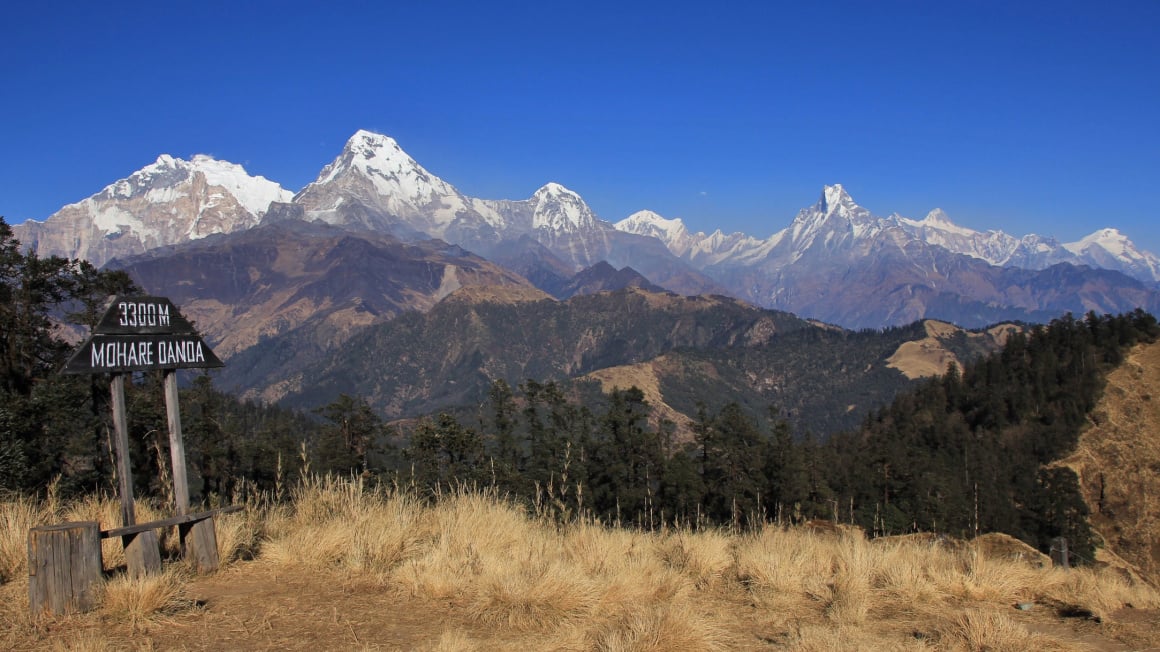
This 3-4 day route is reached from Pokhara by taking a bus to Beni. The trek peaks at the 3300m station of Mohare Danda (‘Danda’ is equivalent to hill in Nepali) for a scenic sunrise across Annapurna and Dhaulagiri. Finish in Tiplyang (buses run back to Pokhara).
This local outing should not be overlooked!
Once you’ve got the hang of it, why not try and construct your own route? Be mindful of the permit zones – this is easier outside of the Annapurna Conservation Area – but don’t be afraid to head to places off the tourist trail.
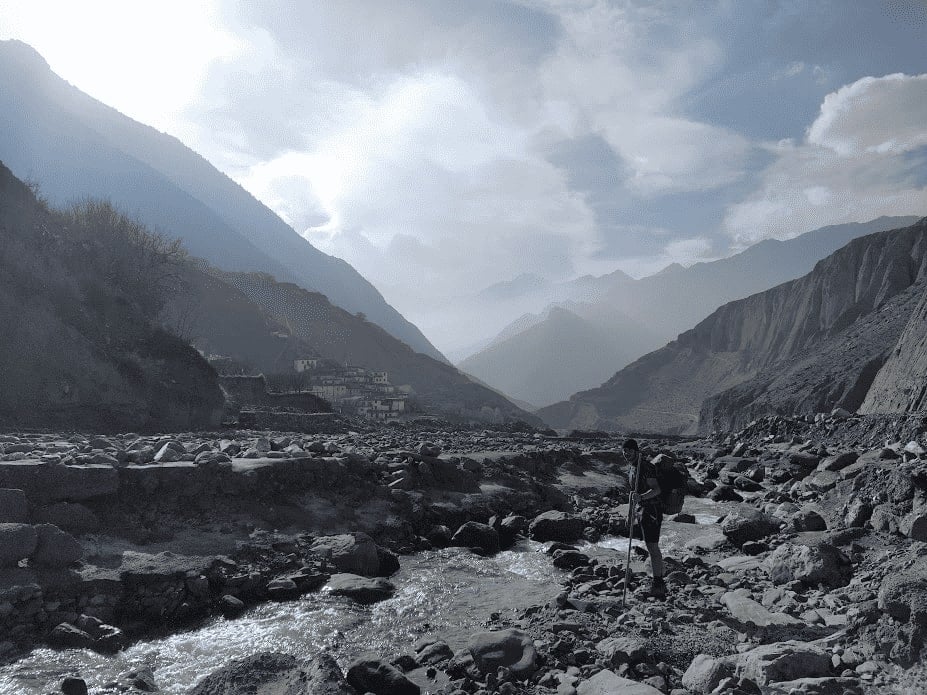
Spending 10 days on foot in the mid-hills between Pokhara and Kathmandu was one of the best travel experiences I’ve ever had. The kindness of Nepali villagers means you’ll be treated like family, and after your trip, longing to return soon!
Permits, Rules and Regulations
In April 2023, new rules were introduced that compel all trekkers to hire a guide when undertaking treks in the Annapurna Conservation Area. This decision was made citing (reasonable) safety concerns for FITs (‘free independent trekkers’), but remains controversial. This means there are three things to sort out for the routes covered in detail here: a TIMS card , an ACA permit , and a guide .
On the usual trekking trails, there are ‘checkpoints’ in certain villages, where you’ll have your ACAP permit checked and stamped (this has always been the case, before the new rules were introduced).
You must obtain this permit before starting the trek, at the Immigration Offices in either Pokhara or in Kathmandu (opening hours are reduced during off-seasons; check on the door in advance of your trek). This is also where you’ll grab your TIMS card. Take your passport, insurance policy details, and passport photos if you have some (if not, you can usually get them taken in the office for free).

The ACAP costs 3000 rupees and the TIMS card 2000 rupees, for a total set-back of around $38.
In addition, hiring a guide can cost between $20-40 per day, meaning the new rules add greatly to the backpacker’s budget.
On one hand, the news rules seem to benefit trekking agencies. On the other hand, many teahouses and local restaurants are concerned less FITs will lead to reduced income for their businesses and families.
However, some trekkers have recently been completing the circuit independently, and reported having no issues at all when getting their permits checked, despite being guideless. This is obviously not guaranteed, and the situation is likely to evolve over the coming months and seasons.
The Annapurna Circuit Trek group on Facebook is a useful source for the latest deets on what’s happening week-by-week .
Here are some commonly raised pros and cons of hiring a guide:
- You’ll gain added insight into Nepalese culture and history.
- You’ll have experience and expertise on hand for navigating more risky areas like the Thorong La Pass.
- Guides will usually help organise permits and the trekking itinerary – less admin for you.
- Significantly increases daily costs (extra $20-40 per day).
- Limited flexibility on schedule in case of altitude sickness or individual preference (particularly if in a group).
- Guides often have deals with tea-houses that may limit your choice.
Preparing for your Annapurna Trek
Preparing for a big trek may seem like a daunting task. There are things to prepare, like gear, route-planning and some permit-related admin.
Fortunately, you don’t need to be a sponsored athlete, master orienteer or avid form-filler to swiftly get your ducks in a row and be ready to head high into the mountains.
Aside from gear, it’s also extremely important to be aware of weather conditions before hitting the trail or even starting the trek. On 14 October 2014, a record-breaking storm dumped nearly 1.8 meters of snow in the Annapurna region which led to a series of devastating avalanches that resulted in the deaths of at least 43 people, 21 of these trekkers.
While mountain weather can change quickly, I highly recommend having a satellite device with you, and to ensure you get updates on conditions at each teahouse you stop at.
What should you pack for Annapurna trekking?
Firstly, if you’re reading this on the bus and realise you’ve left something at home on the bed, rest assured you can find all you need for trekking at the shops in Pokhara or whilst backpacking Kathmandu .
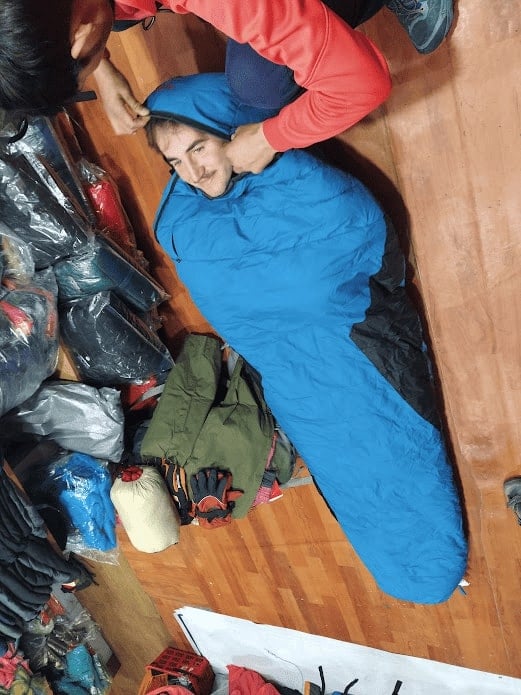
What to pack exactly will depend on personal preference and weather. Use the list below as a checklist.
A word of warning/comfort: don’t pack a different t-shirt for every day, there’s simply no need.
If desired, you can hand-wash items along the way and dry them above the fire in a teahouse, but nearly everyone stinks to high heaven by around day eight, so don’t overly stress. You’ll be in good – probably nose-blind – company.
If you’re looking to make a long-term investment in some clothing for multi-day hiking, check out merino . It’s a breathable, temperature-regulating and odour-resistant blessing for backpacking in colder climates.
There’s usually a healthy supply of gear circulating in the hostels on Lakeside, with backpackers selling, trading or giving away items after finishing their treks. Kiwi Backpackers Hostel on 5th Street is a hub of backpacker activity, and one of the best hostels I’ve ever stayed in.
What to Pack for an Annapurna Trek:
Here’s exactly what you should bring on any trek in the Annapurna Region.
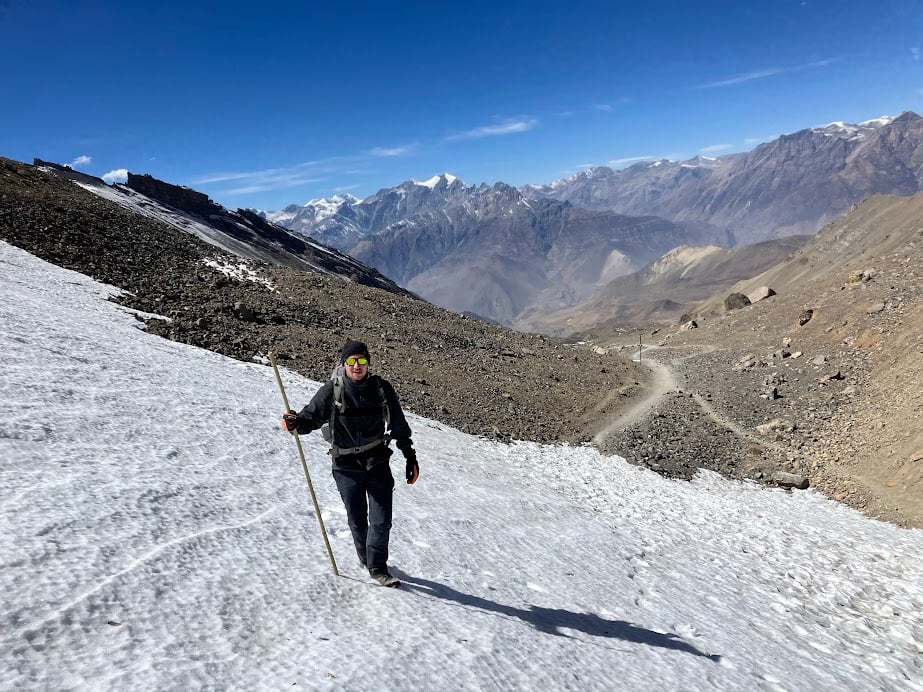
- Osprey Aether Backpack : Sturdy and comfy, with good support and a rain cover. It’s truly the best pack out there.
- Clothing : (Ideally) lightweight, quick-drying shirts, trousers, and shorts.
- Base layers : It can be numbingly chilly at the high points of each route.
- Mid Layer(s) : Go for fleece or soft shell.
- Arc’teryx Beta AR Jacket : Or hiking poncho (good for keeping cool).
- Waterproof Trousers : Ideally can be put on over shoes.
- Patagonia Down Sweater Hoodie : Like a portable hug.
- Hat and Gloves : Sun hat if desired; warm beanie and gloves for higher elevations.
- Abaco Sunglasses : Protect your eyes!
- Water Bottle(s) : At least two litres of capacity.
- Marmot Never Summer Sleeping Bag : Rated at 0F and -18 C, you can’t be better prepared than with this epic bag.
- Water Treatment : Purification tablets or a water filtration system (like the Grayl Geopress).
- First Aid Kit : Grab basic medications and blister treatment from a pharmacy before leaving. Consider Diamox (see altitude section).
- Lip Balm : Chops may otherwise become drier than a moth sandwich.
- Headtorch : With spare batteries/ charger. A real adventure isn’t complete without one.
- Sunscreen : High SPF for sun protection.
- Hanging Toiletry Bag : Toiletries themselves are cheaper in Pokhara than on the trail.
- Physical Map : Found all over the place (shops, hostels, etc).
- Micro Fibre Towel : Compact, dries fast and gets the job done.
- Footwear : More to follow…
- Black Diamond GTX Gaiters : Particularly if wearing low-rise walking shoes or trail runners.
- A good travel camera : The scenery justifies the extra weight.
- Black Diamond Carbon Trekking Poles : Can be an absolute boon on uphill sections. Alternatively, pick up a sturdy bamboo stick en route, with which you will become inseparable.
- Kahtoola Microspikes : ‘Micro-spikes’ can be found cheaply in Pokhara. Highly recommended in Winter.

Wanna know how to pack like a pro? Well for a start you need the right gear….
These are packing cubes for the globetrotters and compression sacks for the real adventurers – these babies are a traveller’s best kept secret. They organise yo’ packing and minimise volume too so you can pack MORE.
Or, y’know… you can stick to just chucking it all in your backpack…
Can I rent rather than buy gear for my Annapurna Trek?
Yes ! The trekking shops on Lakeside in Pokhara and Thamel in Kathmandu will allow you to rent all sorts of gear without breaking the bank.
A down jacket and sleeping bag will each cost around 150-200 rupees to rent per day ($1.15-$1.50), and if you want to stay out in the mountains for longer than planned, you can usually just pay the difference on returning. (Just in case, take photos of the condition of the gear you hire as you leave the shop.)
What footwear is best for Annapurna trekking?
A hotly debated topic.
What type of footwear to go for is largely down to personal preference, within the reasonable bounds of frostbite prevention.
Hiking boots are the most popular choice, as they provide top-notch ankle support, superior weatherproof protection in case of snow, and shielding from rocky ground beneath. Be sure to wear them in advance though, to prevent a blistery first few days on the trail.
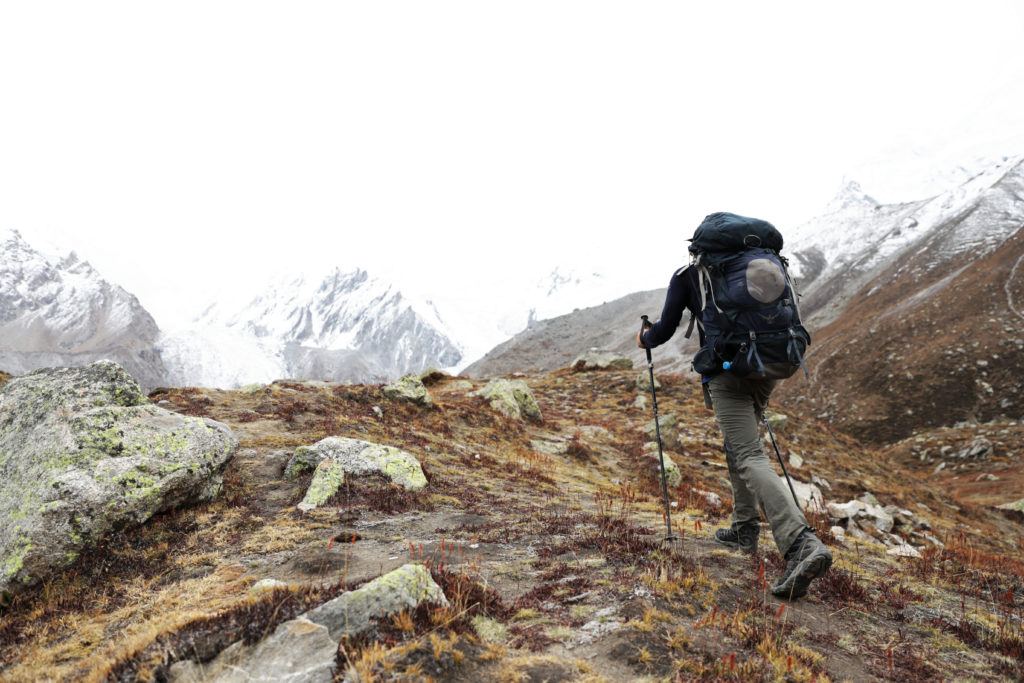
Boots are a shrewd choice. However, they can feel clunky, and you may find yourself hankering for something more nimble.
An increasing number of trekkers are using trail running shoes, when not in the depths of winter. A pair of waterproof (look for Gore-tex) trail running shoes can provide solid support while remaining light and agile. You’ll want a pair with deep treads (grip) on the sole and a sturdy construction. Combine with a pair of gaiters in case of snow.
Chuck in some flip-flops/ jandals/ slippers for downtime in the teahouses. Your feet will be eternally grateful.
Why You Should Travel With a Water Bottle
As travellers, we have a joint responsibility to reduce the environmental impact of our excursions, and plastic waste is one of the biggest problems facing Nepal’s Annapurna Region.
Travelling with a filtered water bottle is a wise move. There’s no better option than the Grayl Geopress: this water bottle and filter system removes all manner of threat, including viruses and heavy metals – no mean feat. This bottle is a popular choice amongst trekkers and backpackers in Asia.
It’ll last for years, reduce plastic waste, and save you money. The Grayl Geopress is a sound investment for anyone taking on some Annapurna trekking.

Drink water from ANYWHERE. The Grayl Geopress is the worlds leading filtered water bottle protecting you from all manner of waterborne nasties.
Single-use plastic bottles are a MASSIVE threat to marine life. Be a part of the solution and travel with a filter water bottle. Save money and the environment!
We’ve tested the Geopress rigorously from the icy heights of Pakistan to the tropical jungles of Bali, and can confirm: it’s the best water bottle you’ll ever buy!
Life on the Trail
Are there places to stay on an Annapurna Trek?
On all treks discussed in this guide, there are a plethora of accommodation options available. This means you won’t need a tent or shelter to take on these Annapurna treks. Luxury!
These are in the form of teahouses – some large, some small – and you’ll find them in the villages along the trails, plus some extras dotted in between.
What’s more, your room for the night is usually offered very cheaply or even for free, provided you eat dinner and breakfast at the teahouse where you stay. Here are a few things to keep in mind when choosing your residence for the night:
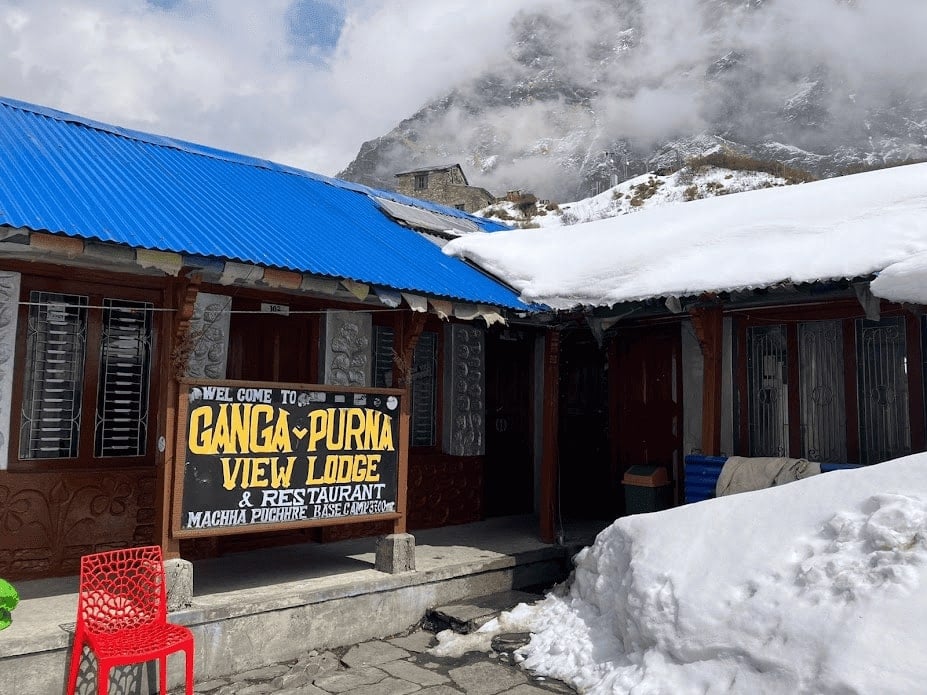
- Check out the views for sunrise and sunset!
- Ask if using a hot shower, wi-fi and e lectricity is available and included in the rate agreed, or whether you’d have to pay extra. You can often strike a ‘package deal’ if you chat to the owner.
- If it’s cold, a fire to sit around is an unrivalled treat. (Even if it’s a yak dung inferno..)
- Of course, the price !
You’ll be given a simple private room for the vast majority of stays, which come with beds, blankets and pillows.
You’re more likely to get a plug socket at lower altitudes. Otherwise, there’ll probably be a shared extension cable in the kitchen area but you may have to pay.
Gas-heated showers can be found throughout the treks, except near the highest points of each route. Toilets are a mix of squat style toilets and Western designs, but take your own loo roll! It grows crushingly expensive further up the hillside, and splashing your behind from a bucket of icy shards in the early hours might not be ideal.
Sitting round the table in a teahouse after a long day’s trek is a quintessential part of a Nepali trekking experience; playing cards and sharing tales with locals and fellow travellers is sure to leave lasting memories to treasure.
What food is available while trekking in the Annapurna Region?
The Nepali word ‘Annapurna’ can be translated as ‘everlasting food ’, which certainly seems fitting when it comes to Dal Bhat.
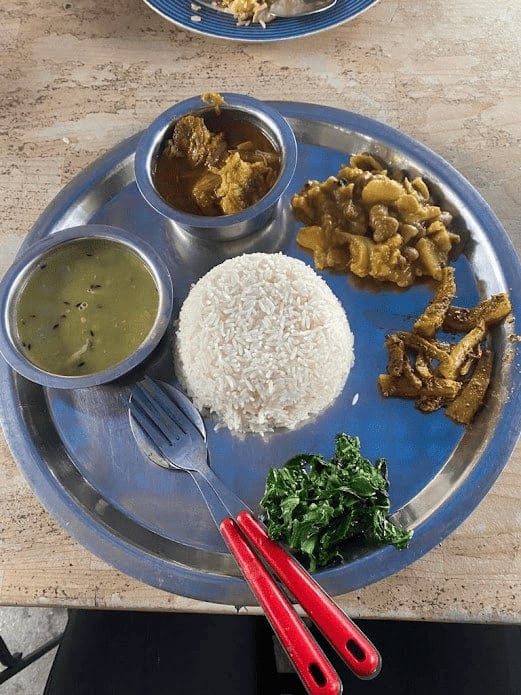
This national dish is a staple for people all across Nepal, and is likely to become a dearly treasured feed when trekking in the Annapurna region.
Dal bhat consists of steamed rice paired with dal (cooked lentils or other pulses), accompanied by a varying array of saag (spinach cooked in spices), papad (poppadom), vegetable tarkari (seasonal vegetables) and pickle amongst other things. You can order small bowls of meat to go with it too.
And, in very healthy news for us lovers of value, most elements of dal bhat can be replenished at no extra cost!
You’ll also find things like fried rice, noodle soup, curry and even some surprisingly good pizza, cooked on a stove. Try thukpa, a classic Nepali noodle soup with a warm broth.
Porridge, omelettes and toast are all usually there too. At least once, give ‘Tibetan bread ’ (or ‘Gurung bread ’) a go, with honey. For breakfast, this is an absolute triumph.
Food is expectedly more pricey than in Pokhara but not outrageously so. See an example menu below, typical of those found on the Annapurna Base Camp trek. For reference, one US dollar is currently equal to around 130 Nepalese rupees.
Dealing With the Altitude While Trekking in Nepal
Trekking in the Annapurna region naturally means you’ll be dealing with some serious loftiness.
For example, Thorong La – the pinnacle of the Annapurna Circuit – is just about the highest mountain pass in the world .
The sub-par oxygen levels found here are likely to have some kind of effect on all trekkers, and the severity of its impact doesn’t seem to be linked to physical fitness. Your gym-obsessed mate could find themselves back of the pack, being overtaken by heavy smokers flying up the hills.
While it’s a bit of a lottery in that sense, there are things you can do to reduce your risk of feeling groggy or worse, which I’ll cover here. Altitude sickness is not something to mess about with, and one of the most dangerous aspects of Nepal , so here’s a breakdown of some key tips and information surrounding AMS , HACE , and HAPE .
What is altitude sickness?
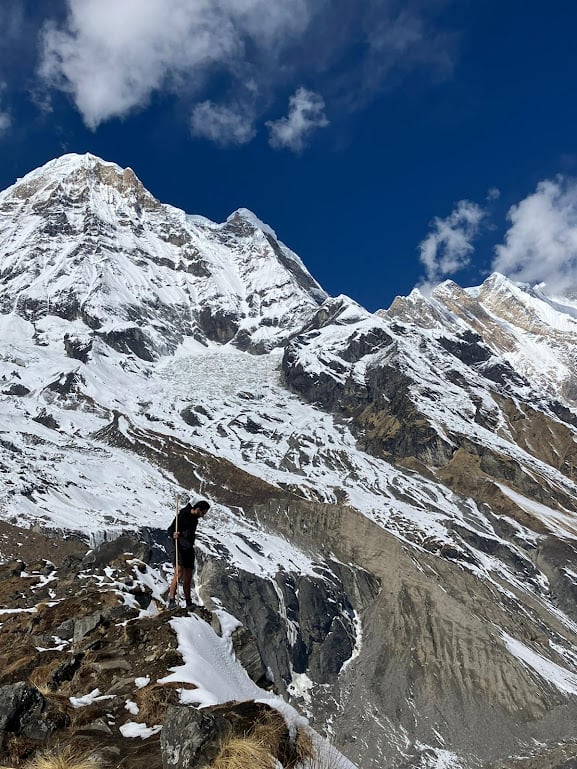
Altitude sickness essentially refers to the ill effects on the body of being exposed to lower levels of oxygen.
Acute mountain sickness (AMS) is the mildest form of altitude sickness, but should certainly not be ignored. Symptoms include:
- Nausea/vomiting
- Loss of appetite
If these crop up, it’s important to STOP ascending. Acclimatisation and rest can give the body sufficient time to adjust to the conditions, before continuing with care.
On the other hand, the more serious high-altitude pulmonary edema (HAPE) and high-altitude cerebral edema (HACE) require rapid descent, and are life-threatening emergencies. HACE refers to fluid buildup in the brain, while HAPE refers to fluid buildup in the lungs.
Symptoms of HACE include:
- Severe weakness
- Acting drunk
- Personality changes
- Balance issues
Symptoms of HAPE include:
- Pink sputum
- Breathlessness at rest
Keep an eye on each other and report any symptoms to mates and locals at teahouses. HAPE and HACE require immediate attention. Descend down the mountain right away, while limiting physical exertion as much as you can while doing so.
How to Minimise Risk of Altitude Sickness:
As mentioned previously, developing symptoms of altitude sickness when trekking is seemingly unrelated to overall fitness. However, there are things you can do to reduce your risk. Here are some tips for trekking in the Annapurna region:
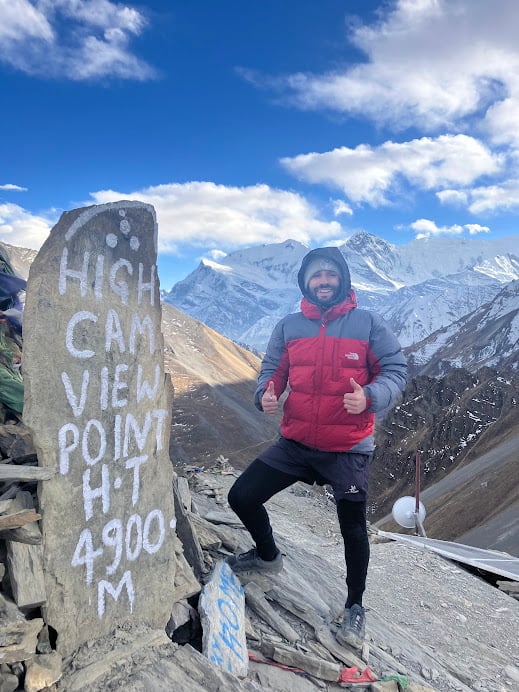
- Limiting daily ascent when above 2500m is the best way to reduce your risk. Ascending no more than 500m a day is optimal, while more may be manageable for some. It’s quite common for trekkers to climb more than this in a day on occasion , but be careful in doing so, and be sure to stop and rest for a day or more if you develop symptoms.
- Drink loads of water ! Increase your intake as you ascend.
- Consider using Diamox (acetazolamide). This is by no means essential, but taking Diamox a day or two before ascending to high altitudes can speed up acclimatisation. (If you have any other health conditions, check with your doctor before doing so). Side effects can include tingling fingers and lips – a quite odd, but not particularly troublesome sensation.
- Keep plans flexible to build in any acclimatisation days that become necessary.
- Walk high, sleep low ! Walking to a new ‘high point’ but sleeping below it when possible can be great for your body.
- Look after your mates ! Check in on one another and keep an eye out for anyone struggling or showing changes in personality.
Getting Insured BEFORE Trekking Annapurna
Altitude sickness is no joke. Make sure you’ve got some good travel insurance before heading up there!
ALWAYS sort out your backpacker insurance before your trip. There’s plenty to choose from in that department, but a good place to start is Safety Wing .
They offer month-to-month payments, no lock-in contracts, and require absolutely no itineraries: that’s the exact kind of insurance long-term travellers and digital nomads need.

SafetyWing is cheap, easy, and admin-free: just sign up lickety-split so you can get back to it!
Click the button below to learn more about SafetyWing’s setup or read our insider review for the full tasty scoop.
How Much Does it Cost to Complete an Annapurna Trek?
This will greatly depend on whether you opt for a ‘package tour’ or not.
For broke backpackers, going without a tour is certainly the more budget-friendly option, and you can easily meet trekking mates on the route itself, or in hostels before setting off.
Without a package tour, a decent budget is around $25-30 per day , excluding the cost of hiring any gear and a guide . Rooms are very cheap ($2-3 per night) or even free when you eat there, so the main daily costs go on calories and any toiletries.
A guide costs around $20-35 a day, which can be shared amongst a group.
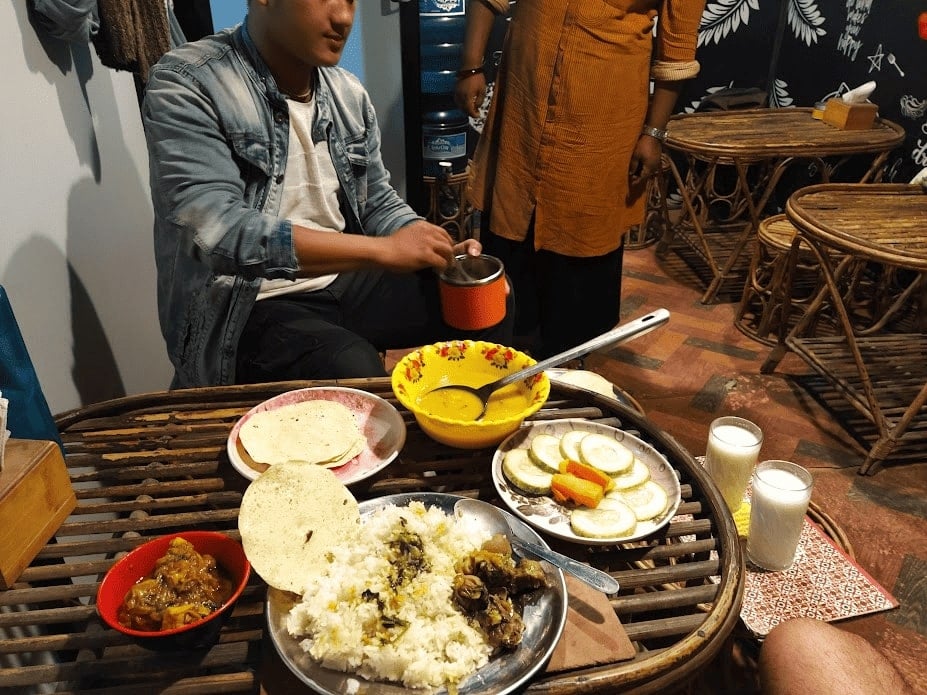
There are no ATMS on the circuit – take more cash than you think you’ll need! You never know if you might need an extra day of rest due to altitude, or fancy the occasional beer. (My mate and I didn’t heed this advice, got addicted to Snickers, and ended up with a budget of $7 each for the last couple of days, which was far from ideal.)
Another key money-saving tip: take your own loo roll! Its price seems to rise exponentially with the trail.
Overall, trekking in the Annapurnas isn’t a great deal more expensive than backpacking in other parts of Nepal, largely thanks to the generous portions of Dal Bhat served up of an evening.
Nepali Customs and Phrases
Travelling in Nepal is an immense privilege. Along with some introductory Nepali to get to grips with, here are some tips to help you remain a conscientious rambler.
- Order food together , and if asked, make breakfast choices the night before. This will reduce the amount of fuel needed to heat food.
- Minimise plastic waste! Take a filter bottle instead of buying water as you go.
- Ask before taking photos of anyone.
- Reduce your meat intake, as most is not fresh and carried up the mountains from lower villages.
- Learn some lingo!
Nepali is not a particularly difficult language to learn for English speakers, especially for a handful of essential phrases. Make an effort and it’ll be hugely appreciated!
- Namaste = hello/ greetings (polite).
- Dhanyabaad = thank you.
- Kasto cha = how are you?
- Ramro cha = it is nice/ beautiful/ good.
- Baya tira = leftwards.
- Daya tira = rightwards.
- Bhaato = ‘path’ or ‘way’.
- Mitho = tasty/delicious.
- Deraye = very (e.g. Deraye mitho = very tasty).
- Pheri bhetaula = see you again.
- Kukhura ko maasu = chicken meat.
- Bhaisi ko maasu = buffalo meat.
- Pani = water.
- Tarkari = vegetable curry.
- Shauchalaya = toilet.
- Kati tadha = how far?
- Tapaaiko nam ke ho ? = what is your name?
- Mero nam —– ho . = my name is ——.
- Bhetera khoosi laygo = nice to meet you.
Final Thoughts on Trekking the Annapurna Circuit
Stuck in a rainy city, fantasizing about booking that travel extravaganza, your mind might conjure up images of pristine beaches and pina coladas. ‘Landlocked’ may not seem conducive to your dreams of a blithe, hostel-hopping existence…
But trust me: central Nepal is as laid back and inviting as anywhere on the planet, offering a simply unrivaled combination of its superb lakeside hostel scene and the best mountainous scenery around. The fact this guide is full of “ Xth biggest/longest/tallest in the world ” says enough in itself.
Memories forged on the trails over endless portions of dal bhat and games of cards are bound to be precious, as are any moments spent in the company of the ever-hospitable Nepalese people. The routes featured in the guide have been found on backpackers’ bucket-lists for generations, for very good reason.
Backpacking has changed greatly in many places in recent years, as mobile data and online bus booking systems abound. Traveling on foot through the mountains, with an actual, physical, paper map is a uniquely gratifying experience that no technological advancement can replace.
Trekking in the Annapurna Region -whether you choose the classic Annapurna Circuit or one of the other majestic options – is guaranteed to be an epic adventure that you should not think twice about booking!
Just don’t forget to wear in your boots first…
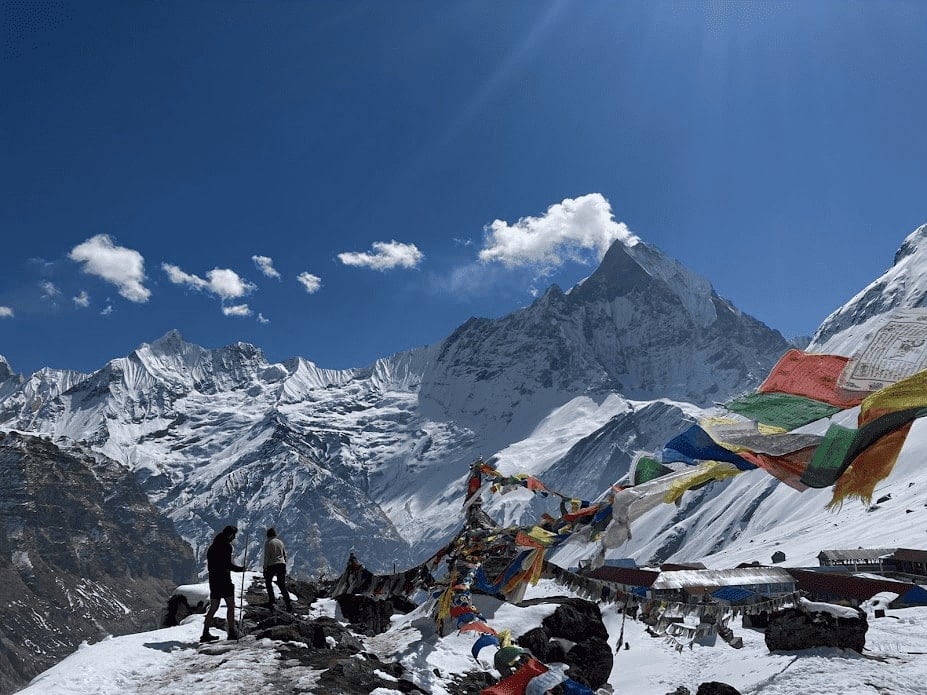
Buy Us a Coffee !
A couple of you lovely readers suggested we set up a tip jar for direct support as an alternative to booking through our links. So we created one!
You can now buy The Broke Backpacker a coffee . If you like and use our content to plan your trips, it’s a much appreciated way to show appreciation 🙂

Share or save this post

Leave a Reply Cancel reply
Your email address will not be published. Required fields are marked *
Save my name, email, and website in this browser for the next time I comment.
Notify me of followup comments via e-mail.

- Best Hikes In The World
- Appalachian Trail
- European Hikes
- Nepal Hikes
- Patagonia Hikes
- See All Hikes
- Mount Kenya
- Mount Kilimanjaro
- Mount Toubkal
- See All Mountains
- South Africa
- New Zealand
- Switzerland
- United Kingdom
- Packing Lists
Annapurna Circuit – Nepal’s Classic Circuit Trek
Asia , Hikes , Nepal
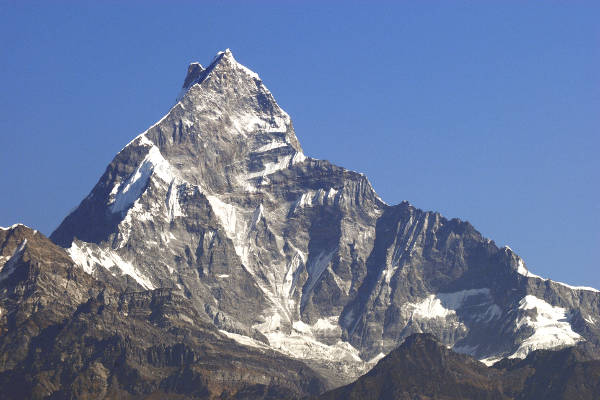
The Annapurna Circuit is one of the most popular and most epic treks in Nepal . This classic trek meanders through Himalayan foothills and over high passes, offering picturesque mountain views along the way.
Annapurna Circuit Trek
Route overview.
The Annapurna Circuit is one of the greatest treks in Nepal, if not the world.
Although road construction over the past two decades has severely impacted the trekking experience (more on this later).
Note: if you are a mountain biker, the road on the western side makes for one of the most exhilarating and scenic mountain biking experiences!
Where Does The Annapurna Circuit Start and End?
The trek begins at Besisahar (which is a 7-8 hour drive from Kathmandu) and concludes in the Kali Gandaki Gorge – the disputed highest gorge in the world that separates Dhaulagiri (8,176 meters) in the West and Annapurna (8,091 meters) in the East.
The circuit is traditionally followed on an anti-clockwise trail – for acclimatization reasons – that circumvents the Annapurna Massif. It takes trekkers through the Annapurna, Manang and Mustang region of central Nepal.
Route Details
At its pinnacle, the trek crosses the Thorung La Pass (5,416 meters) before descending down to the town of Muktinath. From here the road construction activities (2004 -2008/09) have had a measurable impact on the Annapurna Circuit trekking experience.
The Nepalese government have realized that the road on both the Western (Pokhara-Muktinath) and Eastern (Chame-Manang) side of the circuit has had a negative impact on trekking tourism. Thus, they have created a number of New Annapurna Trekking Trails (called NATT-trails).
These NATT-trails, marked blue and white or red and white, take trekkers away from the dusty and unpleasant roads. The alternative routes provide a much more pleasant trekking experience.
How Long Is The Annapurna Circuit?
The Annapurna circuit typically takes between 16-20 days to complete. This is depending if you decide to tack on a diversion to Annapurna Base Camp and the Annapurna Sanctuary ). It covers between 150-240 km depending on when you decide to end the tour or use transportation vehicles.
Scenery and Landscape
The scenery on the Annapurna Circuit is extraordinarily beautiful. Trekkers pass through rice terraced paddy fields, subtropical forests, and glacial environments.
You will see a number of major mountains including the Annapurna Massif (I-IV), three 8,000 metre peaks – Dhaulagiri (8,176 meters), Manaslu (8,156 meters) and Annapurna I (8,091 meters). There are numerous other peaks of 6,000 to 7,000 meters.
Please Note: The Annapurna Circuit is situated in the Annapurna and Mustang regions of central Nepal. It is home to the Annapurna Massif. The schematic below illustrates Nepal’s trekking regions (not to scale).
Annapurna Regional Map
The Annapurna Circuit is situated in the Annapurna and Mustang regions of central Nepal. It is home to the Annapurna Massif. The schematic illustrates Nepal’s trekking regions (not to scale)
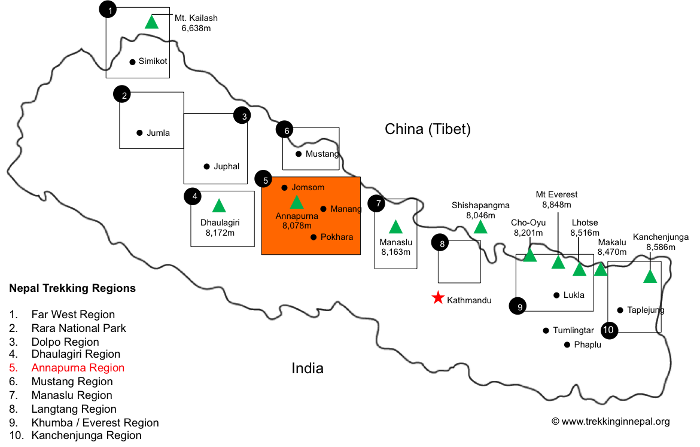
Annapurna Trek Altitude Profile
The schematic diagram below shows the route altitude profile for the Annapurna Circuit.

Annapurna Circuit Itinerary
Below is a detailed Annapurna Circuit itinerary. Where possible we have highlighted the NATT-Trails that can be used to avoid the road. Please note that this is a typical Annapurna Circuit itinerary. Some tour operators offer variations on this route.
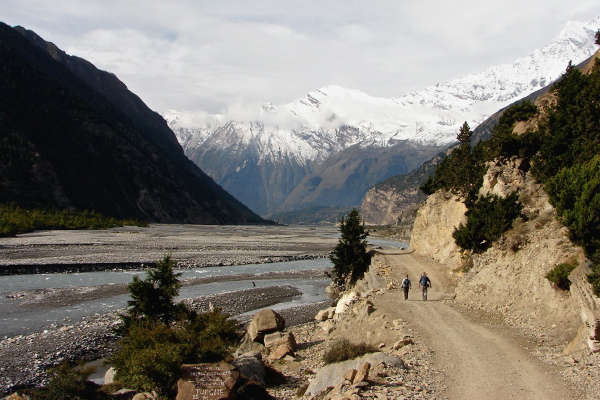
Day 1-2: Arrive Kathmandu (Drive to Besisahar / Fly to Pokhara)
Arrive in Kathmandu, usually spend a day sightseeing in the capital city.
See more in our guide on what to do in Kathmandu .
Drive from Kathmandu (1,300 meters) to Besisahar / Khudi (circa 800 meters) via bus. The trip takes between 7 and 8 hours, meandering through countryside villages.
The Annapurna Circuit typically starts at Besisahar, an hour’s trek from Khudi. Some operators may drive you to Khudi and commence the trek from there.
Day 3: Trek from Besisahar (820 meters) to Khudi and onto Bahundanda (1,310 meters)
Trek from Besisahar (820 meters) to Khudi and onto Bahundanda (1,310 meters). This traditional route has been impacted by the road construction so some operators have started using new trails that bypass the road. Instead, you go to the village of Sikrung (2,200 meters).
The latter is a fairly steep climb to a rather high altitude. But it does offer a more untainted Annapurna trekking experience. Expect to trek between 6-7 hours.
Day 4: Trek from Bahundanda (1,310 meters) / or Sirung (2,200 meters) to Jagat (1,300 meters) or potentially Chamje (1,410 meters)
Trek from Bahundanda (1,310 meters) / or Sirung (2,200 meters) to Jagat (1,300 meters) or potentially Chamje (1,410 meters). If on day 4 you followed the traditional route to Bahundanda, you will trek to Ghermu (1,130 meters) and onto Jagat. You might stay the night here or take a steep hour-long trek up to Chamje (1,410 meters).
We recommend staying the night at Chamje instead of Jagat, which is a dirty and crowded village. If on day 4 you stopped at Sikrung, you will likely follow a route via Syange (1,100 meters) to Jagat and up to Chamje.
Expect to see great rice terraced landscapes and views of the Manaslu Range during early stages of this day’s trekking.
Day 5: Trek from Jagat / Chamje (1,300 / 1,410 meters) to Dharapani (1,960 meters)
Trek from Jagat / Chamje (1,300 / 1,410 meters) to Dharapani (1,960 meters). Continuing north into the Manang region, you will trek through agricultural fields of corn and potatoes and then forests of rhododendrons.
Eventually reach the quaint village of Tal (1,700 meters). From Tal you will trek for another 6 kms (circa 3 hours) via Karte to the village of Dharapani (1,960 meters).
Day 6: Trek from Dharapani (1,960 meters) to Chame (2,710 meters) via Bagarchap and Danakyu, and then either along the lower trail or upper trail to Koto (2,640 meters)
Trek from Dharapani (1,960 meters) to Chame (2,710 meters) via Bagarchap and Danakyu, and then either along the lower trail or upper trail to Koto (2,640 meters).
From Koto you trek a further hour to the busy village of Chame. Some trekkers and operators prefer an overnight stay in the quieter village of Koto. On this rather steep trekking day you will get some great views of Annapurna II and IV, as well as Lamjung Himal.
Day 7: Trek from Chame (2,710 meters) to Pisang via Bhratang (2,850 meters) and Dhukur Pokhari (3,240 meters)
Trek from Chame (2,710 meters) to Pisang via Bhratang (2,850 meters) and Dhukur Pokhari (3,240 meters). From Dhukur Pokhari the trail splits and you may either trek to Upper Pisang (3,310 meters) or to Lower Pisang (3,250 meters) for an overnight stay.
If you take the latter to Lower Pisang we highly recommend re-joining the upper trail on day 8. This provides arguably the best views of the whole Annapurna Circuit.
Day 8: Trek using the upper trail from Pisang (3,310 meters) to Manang (3,450 meters) via Ghyaru (3,730 meters), Ngawal (3,680 meters), Humde (3,330 meters and Bhraga (3,450 meters)
Trek using the upper trail from Pisang (3,310 meters) to Manang (3,450 meters) via Ghyaru (3,730 meters), Ngawal (3,680 meters), Humde (3,330 meters and Bhraga (3,450 meters).
The mountain views on this portion of the Circuit are exceptional, as are the quaint villages along the trail. A visit to Barge monastery is worthwhile before the final stretch to Manang.
Day 9: Acclimatization day in Manang
Manang is one of the main towns on the Circuit. Many trekkers take this opportunity to spend a rest acclimatization day in the town.
Short excursions to the Gangapurna Lake and Bhojo Gompa (a Buddhist ecclesiastical fortification of learning) are common among trekkers. There are also day trips around the town. You might want to consider visiting the offices of the Himalayan Rescue Association for a talk on high altitude risks.
Day 10: Trek from Manang northwest out of the Marshyangdi Valley and up to the small village of Yak Kharka (4,110 meters)
Trek from Manang northwest out of the Marshyangdi Valley and up to the small village of Yak Kharka (4,110 meters). If you haven’t started feeling the effects of altitude yet, you might start doing so from today. Some trekkers continue onto the tiny village of Letdar (4,200 meters). Teahouse accommodation is limited in both these villages.
Day 11: Trek from Yak Kharka (4,110 meters) to High Camp (4,850 meters)
Trek from Yak Kharka (4,110 meters) to High Camp (4,850 meters). This is a fairly tough and steep day. Some tour operators will stop for the night at Thorang Phendi (4,450 meters). This is a good idea if trekkers are struggling with the altitude.
However, continuing on to High Camp is, in our opinion, preferable. This is because it makes the next day’s treks to Muktinath (3,800 meters) a lot shorter and easier. Accommodation facilities and amenities in Thorang Phendi and High Camp are both good. Please note: continuing onto High Camp means sleeping at high altitude, which is not advised if you are suffering from acute mountain sickness (AMS) symptoms .
Day 12: Trek from High Camp (4,850 meters) across the Thorung Pass (the highest point on the trek at 5,416 meters) and then back down to Muktinath (3,800 meters) via Charabu (4,230 meters)
Trek from High Camp (4,850 meters) across the Thorung Pass (the highest point on the trek at 5,416 meters). You then go back down to Muktinath (3,800 meters) via Charabu (4,230 meters). Prepare for a tough, icy-cold day of trekking. The descent from Thorung Pass is steep and trekking poles come in handy. Muktinath, although an important pilgrimage site for both Hindu’s (see the Vishnu Temple) and Buddhists (see the Monastery), is a rather characterless village. Depending on your operator, you will likely stay overnight in Muktinath. For independent trekkers, the Bob Marley Guesthouse in the center of town is a great shout!
Day 13: Trek from Muktinath (3,800 meters) to Marpha (2,665 meters) via the awesome village of Kagbeni (2,800 meters)
Trek from Muktinath (3,800 meters) to Marpha (2,665 meters) via the awesome village of Kagbeni (2,800 meters). From Kagbeni to Jomsom we recommend taking a jeep to avoid the unpleasant dusty roads.
Once you get to Jomsom you can join the ne NATT-trail (which is 2 hours longer than the road option) to Marpha. Marpha is famous for being the centre of the apple region in Nepal. Do try the apple brandy if you get a chance.
Day 14: Trek from Marpha (2,665 meters) to Kalopani (2,530 meters), via Chokhopani, and continue to Kokhethanti to avoid the road
Trek from Marpha (2,665 meters) to Kalopani (2,530 meters), via Chokhopani, and continue to Kokhethanti to avoid the road. Some trekkers grab a jeep from Marpha all the way to Tatapani (see day 15).
Day 15: Trek from Kolapani (2,530 meters) to Tatapani (1,200 meters)
Trek from Kolapani (2,530 meters) to Tatapani (1,200 meters). Using a new NATT-trail (marked in red and white), you can avoid the road and follow a trail that climbs steeply before joining a path that will take you through the towns of Kopochepani, Rupsechhahara, Dana and finally Tatapani.
Day 16: Trek up from Tatapani (1,200 meters) to Ghorepani (2,870 meters)
Trek up from Tatapani (1,200 meters) to Ghorepani (2,870 meters), via the towns of Ghara, Sikha and Chitre. You will most likely stay overnight in Ghorepani in preparation for an early start the next day.
Day 17: Trek from Ghorepani (2,870 meters) up Poon Hill (3,870 meters) and back down to Tadapani (2,710 meters)
Trek from Ghorepani (2,870 meters) up Poon Hill (3,870 meters) and back down to Tadapani (2,710 meters). You will start this days trekking early so as to get up Poon Hill for the impressive sunrise. First light illuminates surrounding rice terraces and Annapurna and Dhaulagiri massifs. The classic Annapurna Circuit trek then descends to Tadapani for an overnight stay.
Note: we have heard that instead of heading up Poon Hill, the hill opposite in the direction of Chomrong provides an equally impressive (if not better view) without any crowding issues.
Day 18: Trek from Tadapani (2,710 meters) to Naya Pul (1,070 meters) via Gandruk and then catch a short bus ride back to Pokhara
Trek from Tadapani (2,710 meters) to Naya Pul (1,070 meters) via Gandruk and then catch a short bus ride back to Pokhara. This is the end of the Annapurna Circuit and an extraordinary 18 days!
Note: It is possible to follow the old Annapurna Circuit from Ghorepani to Phedi via Landruk, although this takes an extra 2 days compared to the direct exit from Ghorepani to Naya Pul.
Please Note: From Muktinath onwards the classic Annapurna Circuit has been severely impacted by the road that joins Jomsom to Muktinath. If you choose to trek this route be prepared for an unpleasant and dusty experience, as jeeps wiz by you. Thankfully there are alternative options via the New Annapurna Trekking Trails (NATT-trails).
Suggested route options from Muktinath
If you are not on a set tour we suggest the following route:
- Trek to the charmingly wonderful town of Kagbeni (2,800 meters) for an overnight stay. We recommend taking the high trail out of Muktinath via Jhong, as this offers better mountain views
- From Kagbeni to Jomsom take a jeep as dust driven from the common winds in this region and the constant flow of vehicles on the road make for unpleasant trekking
- From Jomsom take the new NATT-trail (marked in red and white) to Marpha (2,665 meters) where you can stay overnight and then continue following the route set out from Day 13 below
Also Note: As the road starts in Muktinath, you can cheat and catch a truck all the way to Jomsom. Continue your trek or catch a flight to Kathmandu if you need to shorten your trek (we highly recommend not skipping Kagbeni though). You can also get a bus from Muktinath all the way back to Pokhara if you have run out of time. If you are a mountain biking fanatic you can rent a mountain bike to take one of the most amazing rides down and out of Muktinath – this area of Nepal is fast becoming mountain biking Mecca
Annapurna Route Variations
There are a number of route variations on the Annapurna Circuit. Here are three worth mentioning.
If you don’t have much time in the Annapurna Circuit you may want to consider the Poon Hill Trek , The Royal Trek or the Ghorepani Poon Hill Trek (also called the small Annapurna Circuit). Nepal is heaven for trekkers and has some of the best thru-hikes in the world .
- Annapurna base Camp Trek
- Naar-Pho Valley
- Tilicho Lake
It is possible to include a five day diversion to Annapurna Base Camp onto the Annapurna Circuit trek. This involves continuing north from Tadapani so as to join the old Annapurna Circuit at Landruk.
Read more about the Annapurna Base Camp Trek
A variation to the Annapurna Circuit that has been growing in popularity since opening to foreigners in 2002 is the Naar-Pho Valley.
The route begins near Koto (on day 5/6 of the classic Annapurna Circuit) and follows a trail via two distinctly Tibetan villages – Phugaon and Naar – which are both located at over 4,000 meters. After nine days trekking the route exits via the Kang La Pass (5,300 meters) to Ngawal, where you re-join the Annapurna Circuit on your way to Manang. The detour via the Naar-Pho Valley in effect adds seven days to the traditional Annapurna Circuit as you would have spent two days trekking from Koto to Ngawal and on to Manang had you stayed on the main track.
A special permit, which can only be organised through a trekking agency, is required to enter the Naar-Pho Valley. You will also need to take a guide as tourist infrastructure is poor. Most trekkers opt for the traditional camping style of trekking with porters, tents and cooks.
A 3-4 day trek to Tilicho Lake (4,920 meters), one of the highest lakes in the world, has become a relatively popular diversion on the Annapurna Circuit.
The trek starts in Manang, and follows a path on the northern side of the valley to Khangsar (note: there are maps that show a path on the southern side of the valley but we recommend avoiding this as it is in poor condition and prone to landslides).
From Khangsar there are two paths that leave the town – the lower and upper path. Take the upper path, as it is safer, until you reach Shree Kharka where you can overnight at one of the two teahouses there.
From Shree Kharka walk about 45 miuntes until you reach point where the path splits into a lower and upper trail. Make sure to take the lower trail (the upper trail is marked ‘Danger’). A further 3 hours trekking and you will arrive at Tilicho Base Camp where you can stay overnight at one of the teahouses.
Depart Tilicho Base Camp early the next morning to avoid the high winds and clouds that roll in by mid-morning. The trek up to the lake is steep and tough. It takes about 3 hours and can be very cold due to the altitude, so dress warmly. The descent follows the same path back to Base Camp (approx. an hour) or to Shree Kharka (4 hours from the lake). Overnight at Shree Kharka.
The next day take a trail (which is signposted) directly to Yak Kharka via Old Khangasar, where you re-join the Annapurna Circuit.
Recommended Guidebook

Need an up-to-date guide book with maps that include the NATT-Trails? We recommend either Andrées de Ruiter and Prem Rai’s guide, Trekking the Annapurna Circuit , or Sian Pritchard-Jones and Bob Gibbons guide, Annapurna: A Trekker’s Guide .
Annapurna Circuit FAQ
How much does it cost to hike the annapurna circuit.
The cost of an Annapurna Circuit varies depending on which route variation you take. It also depends when you trek (out of season tends to be a little cheaper) and whether to trek with a local or western trekking agency, or indeed independently.
We have provided a detailed Annapurna Circuit Cost article here but in summary you should budget for the following key expenses:
Visa, Vaccinations, Insurance etc: ~$300-$500
Equipment (buying and hiring): ~$500-$800
Flights to Kathmandu: ~$1,000
Tour Agency: ~$1000 for a cheap local agency to ~$3,000 for a pricey Western trekking agency. You could do an independent trek for ~$700 employing a local guide
check out our list of Nepal trekking companies recommendations .
Tips: ~$200-$300
Misc (additional food, unplanned travel / hotels ect): $200
Total Costs: $2,500 – $5,000
Do I need a permit for the Annapurna Circuit?
Yes. An Annapurna Conservation Area Project permit and Trekker Information Management System registration are required for the Annapurna Circuit trek.
If you are joining an organised tour, these will be arranged for you. If you are looking to go it alone you will have to bring four passport-sized photographs and go to the offices of the Nepal Tourism Board in Kathmandu to apply. We recommend bringing copies of your passport and insurance policy. The offices follow government working hours and days, and are not open on Sunday.
When is the best time to hike the Annapurna Circuit?
The best time to trek the Annapurna Circuit is either in the Spring (March to Mid May) or in the Autumn (mid / late September to December). Unfortunately these also happen to be the busiest times of the year as they are the best time for Nepal trekking ..
Towards December the weather starts getting particularly cold and the routes get distinctly quieter. If you are a hardened trekker a winter Annapurna Circuit (late December through February) can provide a very authentic Nepal trekking experience.
The main challenge of a winter trek, apart from the cold, is the snow and ice that often obstructs the higher trails and the Thorung Pass. During bad winter seasons these trails may be closed.
Unlike the Everest region that gets very wet during the rainy monsoon season, the Annapurna and Mustang regions stay relatively dry, making June through September, a relatively good time to trek as well.
Here’s a detailed article on weather on the Annapurna Circuit .
Is altitude sickness a risk on the Annapurna Circuit?
Yes, some trekkers do suffer from altitude sickness on the Annapurna Circuit as it is a high altitude trek. At its highest point, Thorung Pass, you will reach an altitude of 5,416 meters (17,769 feet).
Fortunately because of the circuits length the opportunities for appropriate acclimatisation are good. Hence, the prevalence of moderate or sever altitude sickness is low.
Nonetheless, it is important to have a detailed understanding of the risks associated with high altitude trekking and how the body acclimatises.
We recommend you read our detailed article on Altitude Sickness and Acclimatisation .
How difficult is the Annapurna Circuit hike?
The Annapurna Circuit trek is challenging. You will be trekking for 4-7 hours a day for over two weeks, so you will need to be peak physical condition. The best way to prepare is to get as many kilometres under foot on hikes in your home country.
What do I need to pack for the Annapurna Circuit trek?
Trekking in the Annapurna region requires a number of essential pieces of trekking clothing and equipment. AC is a long and tough trek. You will be exposed you to a range of altitudes where temperatures fluctuate dramatically between night and day.
Many pieces of equipment can be rented or bought in Kathmandu or Pokhara. Even so, we recommend bringing the most important pieces of gear with you.
We've written a detailed Annapurna hiking packing list .
Insurance Information
Trekking insurance is a must in Nepal. This is particularly the case in the Annapurna Region, which at stages is very remote. If an accident should occur that requires medical assistance and evacuation you will definitely want trekking insurance that can cover the costs of air ambulance and treatment.
Moreover, it is prudent to have insurance that covers you for any travel related risks. insurance should cover stolen, damaged or delayed baggage; flight delays and interruptions; and tour operators default.
This article on travel and trekking insurance in Nepal provides detailed information on what type of insurance you need.
About the author
Mark Whitman
Mark has trekked extensively in Asia, Europe, South America and Africa. He founded Mountain IQ in 2014 with the sole aim to be the best online information portal to some of the most popular mountain destinations around the world. When not writing for Mountain IQ, Mark is out exploring the outdoors with his wife!
Leave a Reply
Your email address will not be published. Required fields are marked
Thanks for the useful information. Really helpful!
Hi Mark, this is a really nice blog with very comprehensive information!!
I'd like to do the trekking on my own, as an independent trekker, but I've heard that there are some new regulations comming for this year (2023) and that a local guide or agency is mandatory to do the central part of the annapurna circuit. Also, that the TIMS can not be got by independent trekkers but only if you hire an agency. Would you have any up to day news about it?
Hi Daniel, thanks for checking in. I’m not aware of the new regulations, but it is definitely possible. Nepal authorities have been talking about this for years. Here’s the latest from the Guardian: https://www.theguardian.com/travel/2023/mar/30/nepal-imposes-ban-on-mountain-trekking-without-a-guide
I'm looking to do a trek around the 2 week period in january.
What would be your recommendation, preferebly in asia.
Hi Hugh, this is winter time in Asia so I would stick with a well trodden path like EBC: https://www.mountainiq.com/guides/trekking-in-nepal/routes/everest-base-camp-trek/
Hi Mark, Great information thanks. I am trekking the APC in October with a local company. I think I have all the bases covered but would you recommend anything of that is more important than anything.
Hi Tony, make sure you have some warm layers, gloves and beanie for the pass, and that you’re guide is clued up on the weather forecast for the days leading up and over the pass. Otherwise, enjoy, you’re in for a treat!
We work with local guides to offer great value adventures at unbeatable prices
Annapurna Circuit Itinerary: Hike Through Nepal’s Majestic Himalayas
.webp)
If you are dreaming of hiking the Annapurna Circuit without a guide and wondering if you should do it, let this be your sign and reassurance that - yes, you can and should do it.
To give you a little context, I'm not the fittest person, and after 9 months of traveling around Southeast Asia on my own, I had led a less-than-healthy lifestyle. Also, I am 5’2, my legs are short, and I hadn’t trained in any way for this strenuous hike. Still, I did it together with a girl I met at my hostel in Kathmandu. I hiked the Annapurna Circuit without a guide or a porter.
Will I ever do this trek again? Absolutely, in a heartbeat!
Though if you'd asked me the same question right after my 9th day of trekking, I would’ve told you no. This is a challenging hike, and I recommend preparing for it.
Here is a 9-day Annapurna Circuit trekking itinerary where you can find a day-to-day guide that outlines the route, distance, and estimated time for each day of the trek. I also detailed my experience, including the teahouses, lunch stops, and highlights along the way to help you plan your trek effectively.

Annapurna Circuit Hike Overview
Length: 9 to 15 days
Difficulty: Challenging
Starting Elevation: 840m (2760ft) at Bhulbhule
Peak Elevation: 5416m (17,769ft) Thorong La Pass
Accommodations: Teahouses
Best Time to Trek: October to early December, March and April

Annapurna Circuit Trekking Itinerary
Day 1: Bhulbhule to Jagat
Day 2: Jagat to Dharapani
Day 3: Dharapani to Chame
Day 4: chame to upper pisang.
Day 5: Upper Pisang to Manang
Day 6: Manang: Rest Day
Day 7: Manang to Yak Kharka
Day 8: yak kharka to thorung phedi (base camp).
Day 9: Thorung Phedi to Muktinath

Detailed 9 Day Annapurna Circuit Itinerary
Here is a detailed itinerary of my 9-day hike on Nepal's Annapurna Circuit. You'll find the elevation gain of each location, as well as the distance and time it took for us to get there. We've also included the teahouses where we stayed during the trek and what you can expect on the hike itself.
Note that we hiked in October , so depending on when you trek, the weather conditions may vary. Use this route as a rough outline, and be prepared to make adjustments based on your own preferences and the current conditions.

Kathmandu to Bhulbhule
Elevation Loss: 560m (1837ft)
Distance by Bus: 187km
Time by Bus: 6 to 9 Hours
Teahouse: Manang Hotel and Restaurant
From Thamel (1400m), you can either book a jeep or take the local bus to your starting point. The jeep is the more popular option among tourists due to its convenience.
However, taking a public bus with the locals is an amazing experience you don’t want to miss out on. The local bus isn’t air-conditioned, so it gets hot during the day. But you tend to see more amazing views from the countryside, which makes the heat bearable.
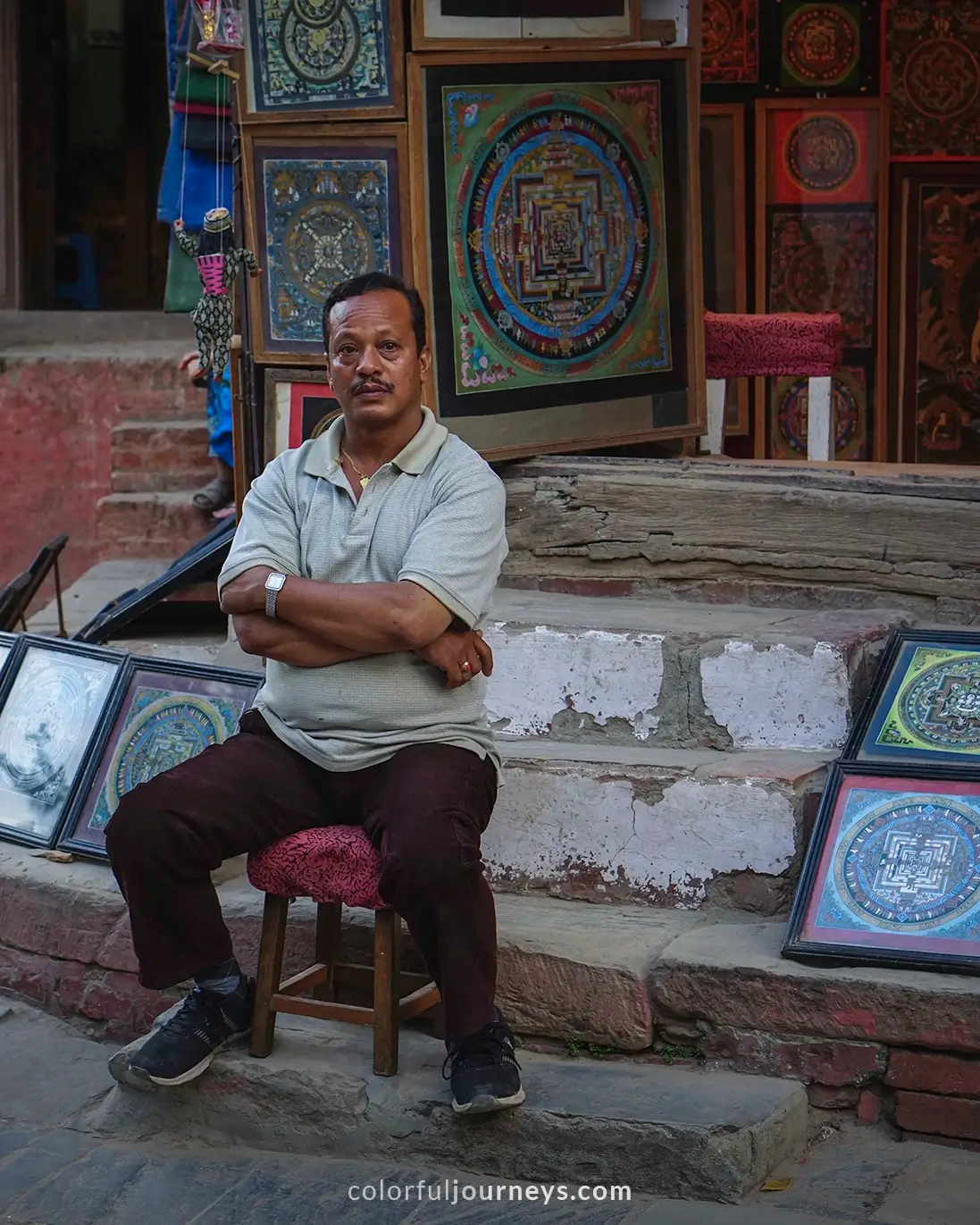
As far as we know, you cannot book your ticket in advance. So, head to the Gongabu Bus Station around 6:30am and buy your ticket at the office .
Tip: Start your trek at Bhulbhule instead of Besisahar. Numerous jeeps and buses go between the villages, so it is not the best place to walk because of the heavy dust and the busy roadways.
Similar to the majority of the villages along the Annapurna circuit, the tea houses in Bhulbhule are situated next to one another. With an elevation of 840m , Bhulbhule is located next to the Marshyangdi River, with about ten tea houses providing simple but comfortable lodging. Plus amazing river views!
.webp)
My Experience
We boarded a local bus from Kathmandu to Bhulbhule, which took around 9 hours . The bus was mostly filled with locals, with the exception of an elderly British couple, whom we ended up seeing a lot on the trail. Along with their Nepali guide and porter, we formed a camaraderie early on and throughout the trek as we shared tea houses and recommendations on which villages to stay in at night.
Once we reached Bhulbhule, we stayed at the first tea house we saw, the Manang Hotel and Restaurant . Our room, located beneath the main restaurant, was modest with two single beds, just enough for a night’s rest. The sound of the river lulling me to sleep and waking me up the next morning was the perfect start to my Annapurna hiking journey.

Day 1: Bhulbule to Jagat
Elevation Gain: 160m (525ft)
Trek Distance: 19km
Trek Duration: 6 Hours
Teahouse: Hotel Mont Blanc
Today marks the first day of your hike on the Annapurna Circuit from Bhulbhule to Jagat. As you are still at a relatively low altitude, it gets really hot during midday . While today’s hike is difficult, you will be rewarded with numerous waterfalls along the way and a picturesque backdrop to enjoy.

You will follow the river and hike along a cliff for the first portion of the trek. As you pass through some green forests, the path becomes steeper and more uphill until you reach Bahundanda (1310m). The climb to the village is tough with countless steep steps to tackle.
Once you reach Bahundanda village, you can stroll around its blue-toned houses and interact with the locals. After passing through the village, there'll be a large stand-alone tree facing a dramatic mountain cliff and you can hear the rushing river below. From here, the rest of today's route will be downhill.

For lunch, stop at the village of Ghermu (1130m) and then continue on to Jagat with an elevation of 1000m. Jagat is a small, colorful village surrounded by lush trees and mountains. Once you reach the village, you will hear people talking about the hot spring nearby .
Turns out, the hot spring is indeed nearby, but the path there is downhill! The hot water will relieve your sore thighs from the whole day of walking, but the climb back up is difficult, resulting in sore thighs once again.

Today’s hike was a bit challenging as I was still getting used to the heat, the long day of walking, and carrying my bag.
We stayed at the Hotel Mont Blanc in Jagat Village. It was simple, spacious, and our second-floor room offered large windows providing a spectacular view of the valley. I ended the evening with a plate of Momos (Nepali dumpling) and a cup of creamy hot chocolate.

Day 2: Jagat to Dharapani
Elevation Gain: 860m (2822ft)
Trek Distance: 15km
Trek Duration: 7 hours
Teahouse: Crystal Hotel and Restaurant
Similar to the first day, today's hike has steep trails, hot temperatures , and dusty trails .
You'll most likely wake up with a sore body after yesterday's hiking and carrying your bag. So, make sure you stretch your legs before heading out, and do not skip breakfast!
.webp)
Again, it will be hot during the midday, with many uphill and downhill trails . The view is still spectacular, with rolling green mountains and fields, as well as numerous suspension bridges to cross.
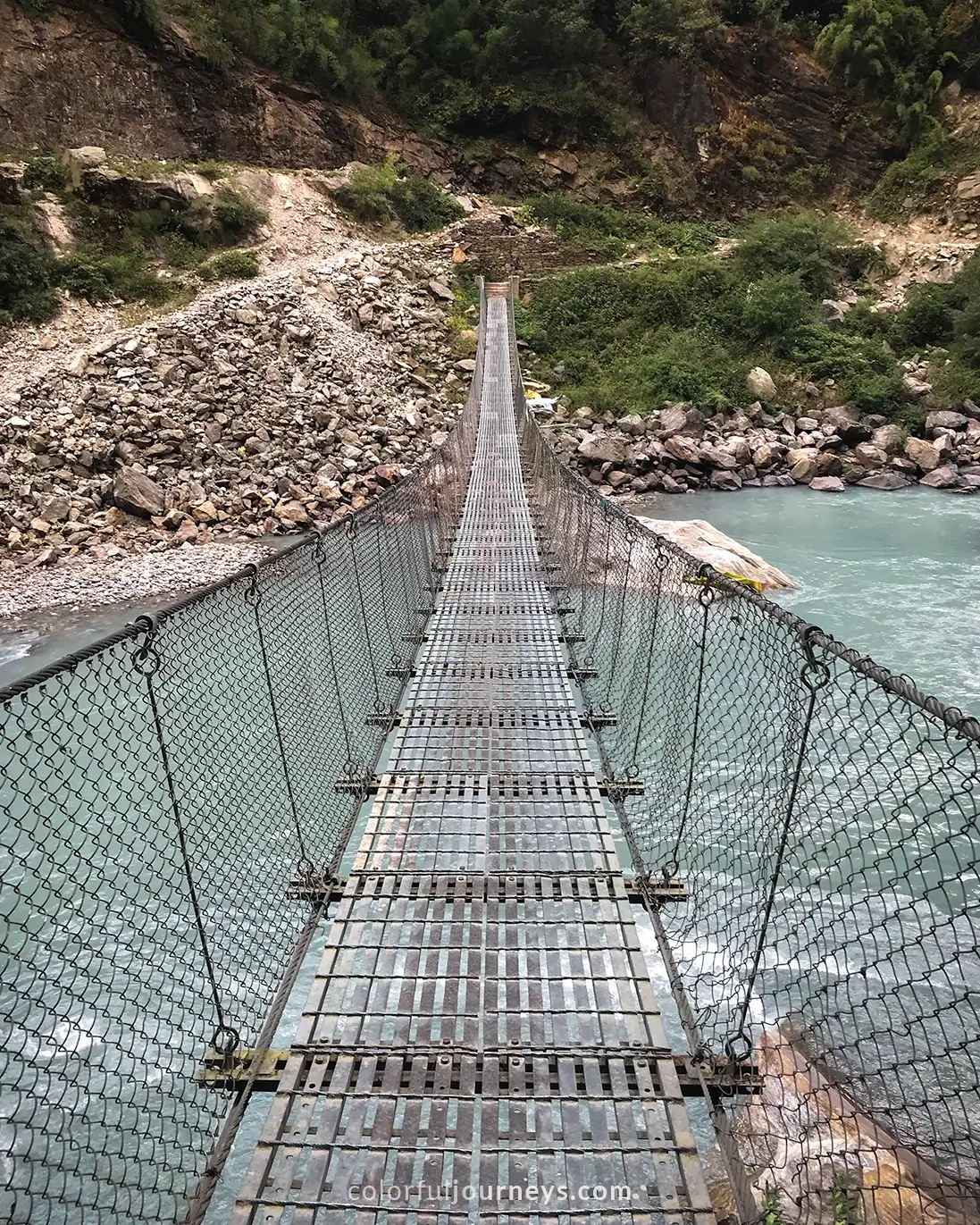
The route from Jagat follows the Marsyangdi river closely. After crossing the river, you will arrive in the colorful village of Tal , which is nestled in the midst of the high mountains. This village houses a lot of restaurants, making it the most logical place to stop for lunch.

You will get closer to the river as you leave Tal village. The rocky trail is sandwiched between the river and the high cliffs, and you’ll be greeted by five waterfalls scattered along the towering green slopes.
From there, you’ll continue to Dharapani village , which is located at an elevation of 1860m.
.webp)
We stayed at Crystal Hotel and Restaurant , located towards the end of the village. The brick-built teahouse is situated on higher ground with a large garden. Our room was basic, and the restaurant was warm, but I didn’t necessarily feel cozy, possibly because we were the only guests. I got very cold at night and made a mental note to wear more layers to bed .
Also, we did our laundry and hung it in the garden overnight. This was a bad idea, as we found our clothes completely frozen the next day. As a result, we had to tie our wet clothes on our backpacks.
.webp)
Elevation Gain: 810m (2657ft)
Trek Distance: 15.5 km
Trek Duration: 8 hours
Teahouse: Tilicho Guest House
Today's hike leads from Dharapani to Timang and then to Chame (2,670m), where you'll spend the night. The route passes through a variety of scenery, from massive rock formations to pine trees, and you will catch your first glimpse of the snow-capped mountains!
The temperature tends to fluctuate on the third day as you gain elevation. So remember to layer your clothes !

As you keep walking, the green mountains will slowly disappear to make way for the towering, rocky mountains. One feature of this trail is the steep steps on the side of a massive boulder, which are dangerously close to a cliff.
Stop at Timang village (2624m) for lunch as you take in the majestic view and enjoy the cooler temperature. After Timang, the trail goes downhill into a pine tree forest and then goes uphill once again past waterfalls and between villages.

If you’re struggling, always remember that the higher you climb, the more rewarding the views are. You will pass by the village of Koto (2600m ), which is a great option to stop by for some tea and snacks.
From here, it won’t be long until you reach Chame, a village with plenty of teahouses to choose from. There are a few stores where you can shop and restock your snacks. Additionally, you can find gear such as gloves, scarves, and jackets as the weather will get colder after Chame.

Despite a solid 8 hours of sleep, I woke up feeling fatigued, and my bag started to feel a bit heavier. As we gained altitude, our pace got slower and my hips started to ache.
After many minutes of stretching my legs during the lunch break, I was able to alleviate the pain. This was the moment I realized how important stretching is . Since then, before I started walking, I made sure to stretch.
.webp)
We stayed at Tilicho Guest House . The rooms circle around a small courtyard in the center, which creates a cozy atmosphere. This was also the most comfortable stay during our trek as the rooms had better insulation.

Elevation Gain: 530m (1706ft)
Trek Distance: 14km
Teahouse: Hotel Royal Nyeshang Cottage
Day four takes you to Upper Pisang (3200m) via Bhratang and Dhukur Pokari. The trail from Chame to Upper Pisang is fascinating with its rushing rivers, mountain hugging roads and snow covered peaks above.

As you leave Chame village following the river, the route will take you past green fields and then through a dense pine forest. After an hour or so, you'll arrive at Bhratang village . You'll pass apple orchards along the side of the road, enclosed in tall fences and clearly marked with signs warning hikers not to pick the apples.
Here, you will find Bhratang Tea House , a cafe where you can buy apples, desserts, and coffee. Expect some crowds as this is a popular rest stop for most hikers, but the apple pies and freshly squeezed juice are worth the wait. There is also a water station just across the cafe to refill your bottles.

Continue on to Dhukur Pokari , where you can have lunch. The trail splits at the end of the village, leading to either Lower Pisang or Upper Pisang. Take the right trail heading to Upper Pisang where the last stretch gets very dusty, so be prepared to do some laundry at your teahouse.

If you arrive early, you should walk around the village. The whole village of Upper Pisang consists of simple stone homes with maze-like walkways throughout the village. There is also a temple at the top of the village where you can witness the locals during their afternoon prayer ceremonies.

Though still difficult, I started to get the hang of walking and carrying my bag on day 4. Also, the higher elevation really started to slow me down. Yet, it was this day that I started to really enjoy the trek more and more as the scenery kept getting more spectacular.
We stayed at Hotel Royal Nyeshang Cottage in Upper Pisang. The teahouse was really comfortable, and offered some of the best views of the snow-capped mountains. Particularly unusual was that our room had a toilet inside, the first one we've seen during our trek.

Day 5: Upper Pisang to Manang
Elevation Gain: 340m (1115ft)
Trek Duration: 9 hours
Hiking Time: Mountain Lake Resort
The route from Upper Pisang to Manang (3540m) is not only one of the longest and most challenging on the Annapurna Circuit but also offers some of the most breathtaking scenic views you'll encounter.
.webp)
As you depart from Upper Pisang, the landscape transforms from lush green forests to dusty roads. The first hour involves downhill paths, followed by two more hours of navigating narrow and steep ascents that zigzag through the mountains until you reach Ghyaru village (3730 m).
.webp)
Once you reach the village, your efforts will be rewarded with a jaw-dropping panoramic view of Annapurna 2 and 3. There is a temple where you can rest and observe the natural beauty of the Himalayan mountain ranges. You'll also find a woman selling delicious bread in the temple.

Continue down the increasingly narrowing trail from Ghyaru village to Ngawal village , where you can stop for lunch. The trail provides countless photo opportunities, so make the most of each pause.

Head next to Manang where you'll be treated to striking views of the distant Annapurna mountains and the expansive valley below. Manang is one of the biggest towns on the trek and offers some of the best facilities. Also, since most of the hikers take a rest day in this village, it is notably the busiest.
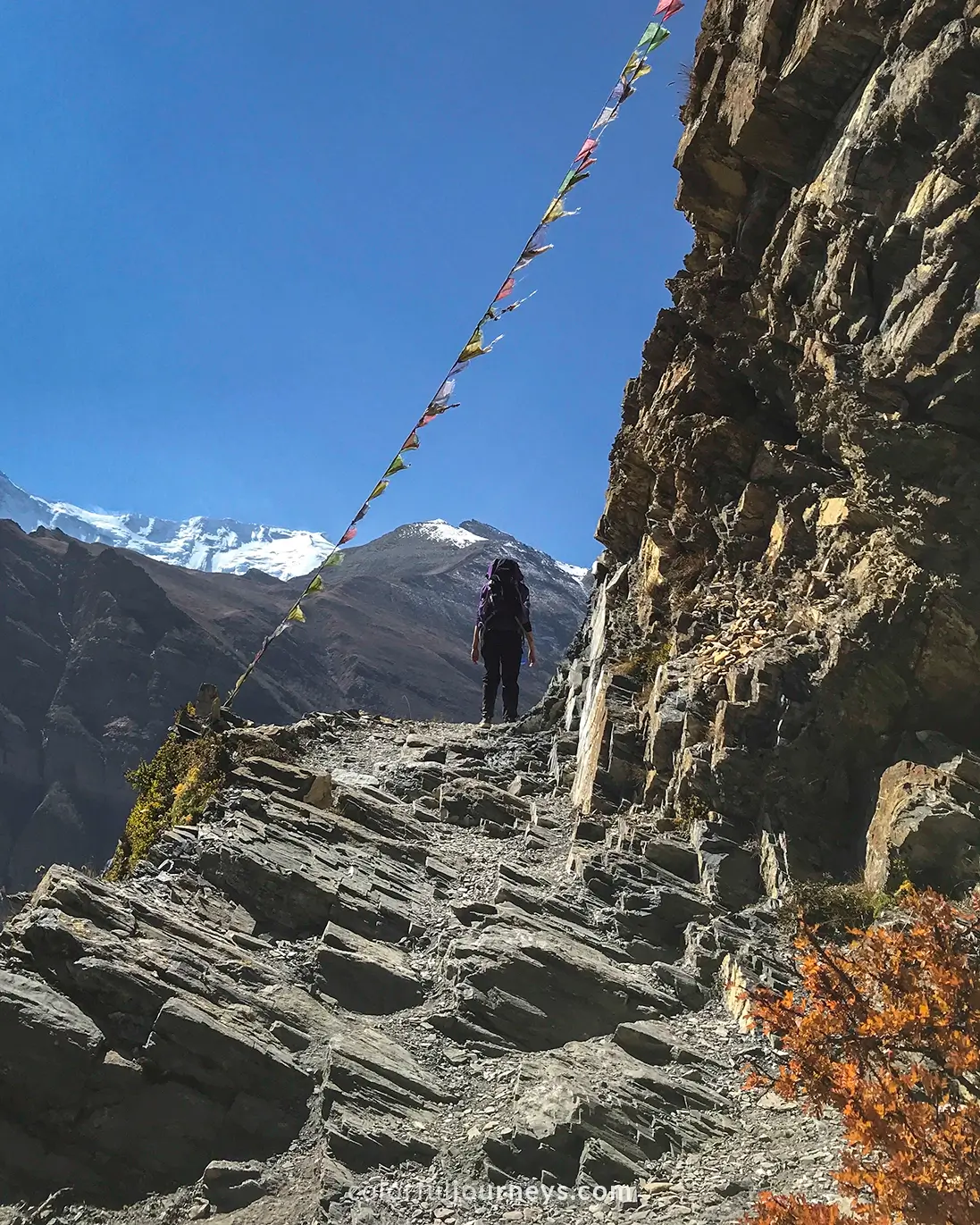
Climbing uphill to Ghyaru village for two hours straight was truly exhausting. However, the journey from Upper Pisang to Manang stands out for its breathtaking views and remains one of my favorite days on the trek.

We arrived in Manang pretty late in the afternoon and by this time, most of the accommodations were occupied. Fortunately, the guide we had met on the bus to Bhulbule, and whom we encountered along the way, secured the last room for us at Mountain Lake Resort .
The stone teahouse featured spacious rooms and numerous available toilets. Additionally, the heated restaurant offered a variety of delicious meals, a much-appreciated treat after a long day.

Day 6: Rest Day in Manang
Extra Hike: Praken Gompa
Trek Duration: 2 Hours
It is advisable to take a rest day in Manang to let your body get used to the altitude. In the morning, head up to Praken Gompa for acclimatization, which should take you around 2 hours back and forth.
.webp)
Praken Gompa is a Buddhist temple nestled in a mountain wall towering above Manang at an elevation of 3945m. The trek is relatively easy compared to the last few days since you won't be carrying your heavy bags.
.webp)
Grab a seat at the tea shop close to the summit and enjoy the breathtaking views surrounding it! Head back down to the village, do the last of your laundry and take a long shower while the sun’s still out. This might be the last chance you get as it only gets colder from here on.
.webp)
At 3pm, attend the free seminar at the Himalayan Rescue Association . Here you will receive information about altitude sickness and tips to combat it. They also sell basic medicines.
.webp)
In the afternoon, explore the village and stock up on your snacks! There’s really nothing else to do but to relax and rest on this day. You will need all your energy for the next few days as you gain more elevation, so head to bed early and prioritize getting as much sleep as you can.
.webp)
Elevation Gain: 155m (509ft)
Trek Distance: 9.5km
Trek Duration: 5 hours
Teahouse: Hotel Nyeshyang
On day 7, the journey takes you from Manang to Yak Kharka village , situated at an elevation of 4100m. This day is relatively short, allowing for lunch and overnight stay at Yak Kharka if you start early.
.webp)
As you ascend, the air gets thinner, and you may begin to feel more tired and breathless . Take it easy and make frequent stops as needed.
.webp)
Start your trek before 8am and head towards upper Manang, where most of the locals live. You'll ascend steep stone steps and navigate through tight alleys, passing by the stone houses with flat roofs. There’s also a temple along the way where you can stop.

Once the road ends, continue on dusty mountain paths. The steady incline at this section makes it easier than the earlier part of the day. Stop at the Chullu West teahouse which is the only place along the route where you can order some hot tea and enjoy the view.
.webp)
The remaining stretch of the trail is dusty, with small shrubs and grasses covering the ground, and has a steady, barely noticeable incline. You might also encounter traffic jams on the path, not caused by cars but the occasional yaks and donkeys carrying their cargo up the hills. So, keep an eye out!
.webp)
Once you reach Yak Kharka, order your lunch right away and take a shower while the sun’s still out. Afterwards, walk around the small village and refill your water bottles at the small water station.
Note: Remember to charge all your batteries since you will need to pay for charging in the next village.
.webp)
We stayed at Hotel Nyeshang , situated at the end of the road. We liked how our room was a spacious bungalow with its own toilet and a big front yard, offering magnificent views.
.webp)
We spent the remainder of the day at the restaurant, keeping warm as we awaited dinner. Following our meal, we opted for an early bedtime, ensuring we got as much rest as possible.

Elevation Gain: 910m (2986ft)
Trek Distance: 6.5km
Trek Duration: 2.5 hours
Teahouse: Thorong Phedi Base Camp Lodge
Today's route takes you from Yak Kharka to Thorong Phedi, also known as Base Camp , situated at 4450m. It is the shortance distance on the circuit but also one of the busiests routes.
.webp)
When you first go out in the morning, you'll find patches of frost ice on the ground, which causes slippery conditions, so take your time. Despite the sunshine, the weather will be significantly colder.
.webp)
The trail to Thorong Phedi is short yet very steep and narrow, featuring dusty and rocky pathways. You will also notice visible signs of landslides. Nonetheless, the views are spectacular.
.webp)
The only place to stay at Base Camp is Thorong Phedi Base Camp Lodge . So it’s recommended that you leave early to make sure you can secure a place to stay.
Alternatively, you can head to High Camp (4800m), approximately an hour’s trek from Thorong Phedi. But, it is recommended to sleep at a lower altitude to reduce the risk of getting altitude sickness.
.webp)
There’s a limited number of power outlets in the lodge and you’ll have to pay for each device that you want to charge. So we recommend charging your devices as soon as you arrive to avoid the crowds for dinner.

After dinner, head to bed early. Wear all your warm clothes and bundle up as the temperature drops below zero.
Additionally, make sure you have plenty of snacks packed in preparation for a long day of walking. You won't have time for breakfast tomorrow, so eat some snacks before starting your trek.

We arrived at the lodge just before 12pm and found it to be quite busy. Luckily, we secured a basic room, although there were better rooms available. It seemed like the better rooms might have been reserved or prioritized for organized group treks.

What stood out to me was the cozy restaurant with its wooden interior and large windows offering stunning views of the snow-capped mountains. With limited activities, most hikers spent their time socializing and keeping warm at the restaurant, which also offered a fantastic selection of food!
.webp)
During this time, I had a severe headache. I wasn't sure if it was due to the altitude or the extended trekking while carrying my big bag, which seemed to be taking a toll on my body.
One of the guides I spoke to at the lodge kindly ordered an onion soup for me, which was very effective in soothing my pain. Apparently, the locals swear by it.
.webp)
Day 9: Thorung Phedi to Muktinath (Thorong La Pass)
Elevation Loss: 1040m
Trek Distance: 16km
Trek Duration: 10 Hours
Teahouse: Hotel North Pole
Today marks the longest and most challenging hike of the Annapurna Circuit, making it possibly the most anticipated day of the trek.
From Thorong Phedi, you will ascend to High Camp (4800m) before crossing Thorong La pass, which is the highest point of the circuit at 5416m . Following the pass, you'll reach the small settlement of Chabarbu for a late lunch.
.webp)
It is highly recommended to begin your day at dawn, preferably no later than 5am , to avoid the strong afternoon winds at the pass. During the first hour, you'll ascend a steep incline to High Camp. The trail is damp and icy from the night dew, and the air is thin. Some parts are slippery and rocky at the same time, so be careful.
This stretch is also one of the busiest parts , with many people hiking up simultaneously. Additionally, there may be traffic from ponies carrying people up.
.webp)
From High Camp, you will be walking uphill for about 4 hours until you reach the only teahouse serving hot tea. Take a rest and warm up as you continue on the steep mountain towards the pass.
Remember: Apply sunscreen as the UV levels are stronger with the high altitude, snow reflection, and long exposure.
.webp)
From the tea house, it’ll take another 2 and a half hours to reach the Thorong La Pass. As you gain altitude, you will feel more breathless. Take your time and continue to push through. You’ll know you’ve reached Thorong La Pass when you see the sign covered in prayer flags accompanied by countless people taking photos.
.webp)
After the pass, it takes about 4 to 5 hours to hike downhill on a rocky and slippery road till you reach the settlement of Chabarbu that serves lunch. As most people have lunch at this spot, it takes a while to be served.
Use this as a rest and after lunch continue on for another 2 hours until you reach Muktinath village (3760m). Though Muktinath offers multiple accommodations for trekkers, you might have a hard time finding one if you arrive later in the afternoon.
.webp)
Today was undeniably the most difficult hike for me. I didn't check my headtorch beforehand, and it was empty. As a result, I hiked with my phone flashlight. This proved to be even more challenging because I had to use my hands to climb up parts of the trail. Other than that, the temperature was freezing, leaving my hands exposed even with gloves on.

This day was also the first time I walked on snow during the trek. My socks weren't thick enough to keep me warm, so I highly recommend investing in good quality socks and hiking boots !
My pace was much slower today, with the ever increasing altitude and my pounding headache. With every five steps I took, I had to take a pause. But once I reached the pass, everything just seemed so surreal, and I took my time to celebrate.
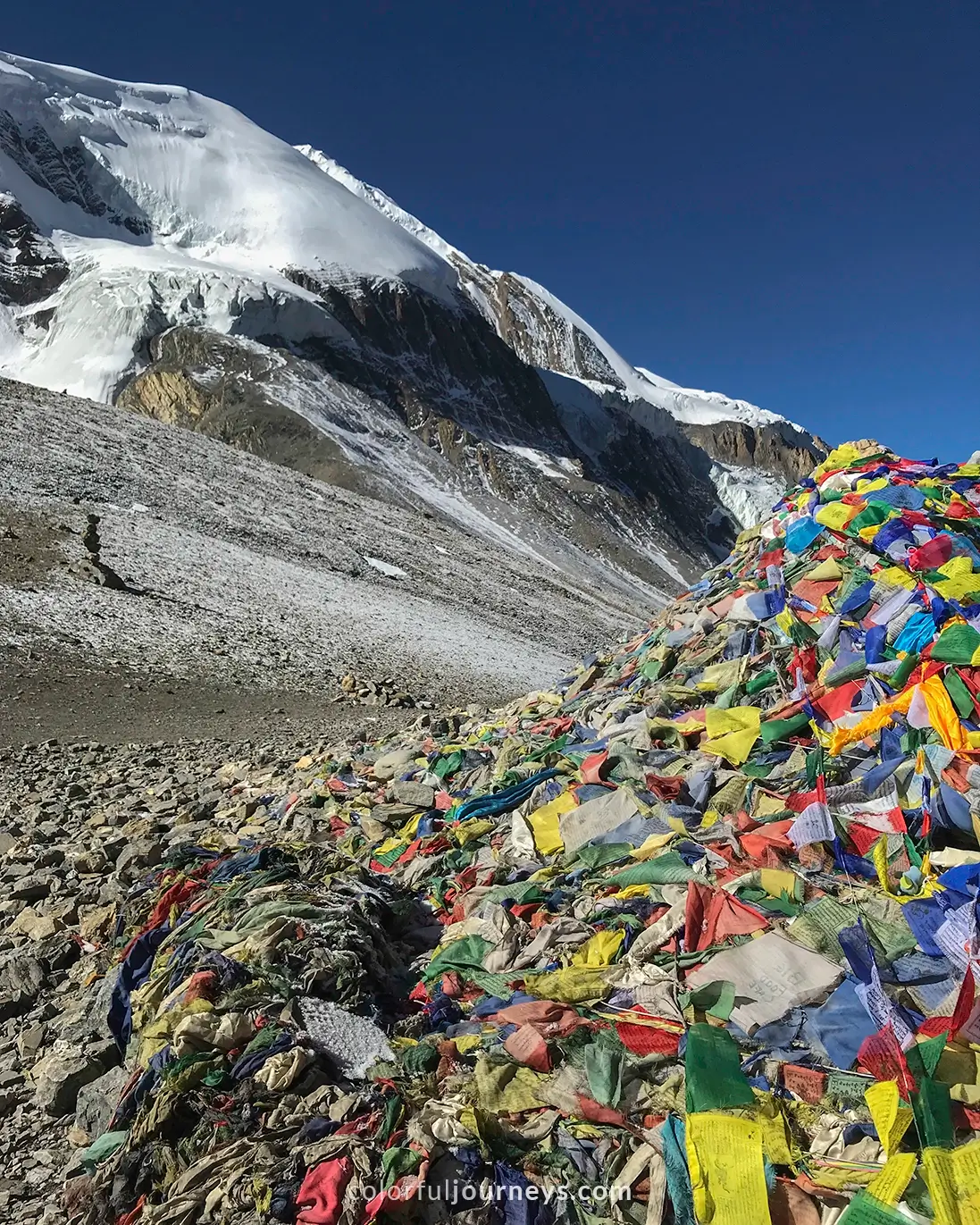
I thought the hardest part was done, but soon I found the downhill section was just as hard as the ascent . The descent however was soothing my headache.
We arrived at Muktinath around 5pm as our lunch took longer than we expected. Thankfully, we were able to stay at Hotel North Pole because of our guide friend who reserved a room ahead of time. Our room was very comfortable, warm, and spacious, which was all we needed after a grueling day.
.webp)
Muktinath to Pokhara
Elevation Loss: 2938m
Distance by Bus: 175km
Time by Bus: 8 to 10 Hours
Today marks the end of your Annapurna Circuit Trek.
If you have more time, you can continue on to Jomson, otherwise you can book a jeep or local bus to Pokhara (822m ). The bus leaves at 7am and takes around 10 hours, while a jeep will take about 8 hours.
.webp)
The road back will take you past steep and narrow cliffs.The views are spectacular but the roads can be daunting at times. Especially when the road gets so narrow it makes you wonder if the bus even fits.
Tip: Sit on the right side of the bus, so you don’t look down the steep cliffs.
.webp)
My Experience:
We took the public bus back to Pokhara which broke down several times and it took us 16 long hours ! Definitely not the best journey, but it’s one of those experiences that sticks with me, even till now. Do I recommend it to other travelers? Only if you have the time and are up for an adventure!
.webp)
Looking for places to stay in Pokhara ? Here are some of the most popular accommodations to book in the area.

Final Thoughts on Trekking Annapurna Without a Guide
Hiking the Annapurna Circuit is undoubtedly a challenging yet incredibly rewarding experience. From climbing those steep paths to enjoying the amazing views, every moment is a big win.
Yes, it is possible to do it on your own, without a guide! Just make sure you come prepared so you can make the most of your hiking adventure.
.webp)
And that’s the detailed 9-Day Annapurna Circuit Trek Itinerary.
Hiking the Annapurna circuit is an unforgettable experience, from the breathtaking views of the Himalayas to the sense of accomplishment when you reach the Thorong La Pass.
I hope this guide inspires you to hike the circuit and helps you plan your next hiking adventure.
Let us know if you have any questions and leave them at the comment section below.
Some links in this 9-Day Annapurna Circuit Trek Itinerary may be affiliate links.
This means that if you make a purchase after clicking on one of our links, we will receive a small commission at no extra cost to you. Please know that by doing so, you are supporting Colorful Journeys in continuing to provide free high quality content to help you in your travels!
Share this article
Related posts.
.webp)
Essential Guide to Hiking the Annapurna Circuit in Nepal
Find all the essential information about trekking the Annapurna Circuit in this comprehensive guide, from preparation to top tips!

The Annapurna Circuit Trek Itinerary: the ultimate guide
This post offers you the ultimate Annapurna Circuit trek itinerary. The Annapurna Circuit trek was once the most popular tea house trek in Nepal . In about a month it was possible to walk around the Annapurna mountain peaks. This trek was famous for its ethnic villages, natural beauty and easy access from Kathmandu or Pokhara.
But the Annapurna Circuit trek has changed tremendously in recent years. There was a time that the further up you went, the more isolated the villages were. It took people days on foot to reach the nearest city, the nearest school or the nearest health care post. For tourists, this remoteness was part of the charm.
Ongoing road construction now connects most villages on the Annapurna Circuit with the outside world. Jeeps drive up and down on dusty roads, changing the landscape for better and worse. Tourists planning a trek in Nepal are wondering whether the Annapurna Circuit trek is still worth it.

Why choose the Annapurna Circuit trek
Despite the new roads going up the Marsyangdi and Kali Gandaki valleys, the Annapurna Circuit trek is still very much worth it. Although many things have changed with the new roads, a lot of things also remained the same. People are just as friendly, the villages just as authentic and the mountain views just as spectacular.
In short, it is still a very beautiful trek with a huge variety in landscapes, villages and people. The road itself is nothing more than a dirt track and actually carries relatively little traffic. In addition, there are plenty of alternative side trails to bypass them all together. The NATT trails set up by Prem Rai and Andrees de Ruiter are well marked and follow the traditional circuit, but avoid the road as much as possible.
The Annapurna Circuit trek requires a certain amount of time, but most of the hike is easygoing. Gradual climbs and well marked trails with frequent restaurants and lodges to take a break. What makes it challenging is the tough day you climb the Thorung La Pass and the altitude after Manang.
To prevent altitude sickness it is important to give yourself enough time to acclimatize. Don’t go up too fast and take some days to rest. The better your body has adjusted to the height, the easier the climb up to Thorung La will be.
This was my first trek in Nepal and even though many others followed such as the Langtang Trek , Poon Hill trek and The Gokyo lakes trek , I still consider myself an amateur hiker. Thorung La was difficult, but I made it. If I can do it, you can too, as long as you prepare well.

Annapurna Circuit trek itinerary
The classic Annapurna Circuit trek itinerary started in Besisahar where you climbed up the Marsyangdi valley towards Manang, crossed the Thorung La Pass, visited Muktinath and Jomsom and then walked down the Kali Gandaki valley towards Beni. This took about 20 – 30 days
The roads give you more flexibility in where to start or end the trail as well as how much time you take. Jeeps go as far up as Manang on the Marsyangdi valley side and Muktinath on the Kali Gandaki valley side.
Clockwise or anti Clockwise ?
The Annapurna Circuit Trek is a loop with different starting and end points. The first thing to decide is whether you hike clockwise starting at the Kali Gandaki valley or anti clockwise starting at the Marsyangdi valley.
The general advice and also my recommendation is to hike anti clockwise from east to west. This is the easier and safer direction to go. The Marsyangdi valley offers a more gradual climb and Manang is a great village to acclimatize well, before attempting Thorung La.
The Thorung La Pass is at 5416 meters high and altitude sickness is a serious risk. From Manang to Thorong La, there are several more villages like Yak Kharka (4020 m) and Letdar (4230 m) to stop and acclimatize or get help if you do suffer from altitude sickness. Thorung Phedi (4450 m) and High Camp (4850 m) are the last lodges before the pass.
From west to east the last village is Muktinath (3750 m) and a few basic lodges at Charabu (4210 m). After the last lodge it is a very long and steep ascent to Thorung La with nothing in between. Taking this approach is not only more difficult and requires you to be very fit, it is also potentially dangerous. You go high quickly and without proper acclimatization small things like bad weather or an injury can become very problematic.

How much time?
The roads have made it possible to do the Annapurna Circuit trek in much less time than the original 30 days. Still, the Annapurna Circuit trek is an area where slow travel is very rewarding. The villages on the way are very interesting and a destination in their own right. Furthermore, there are lots of side trips to escape the crowds.
Another reason to take it slow on the Annapurna Circuit Trek is again the altitude. Yes it is possible to take a jeep all the way to Manang (3520), but you will not only miss out on lots of beautiful scenery, you will also increase your risk of getting altitude sickness.
Looking at the distances and trekking times, it looks possible to trek from Manang to Thorong La in less than two days, but again, this would be very foolish. Experts advise to not ascend more than 300 – 400 meters per day once you are above 3000 meters high.
On the Annapurna Circuit trek this advice translates in at least one acclimatization day in Manang and another acclimatization day in Letdar before spending the night at Thorung Phedi. I followed exactly this advice and still struggled with the altitude when crossing the Thorung La pass.
Even if you are short on time, you need to acclimatize. You could do the Annapurna Circuit trek in 2 weeks if you decide to fly from Jomsom back to Pokhara. If you have more time, walking down the Kali Gandaki valley is definitely worth it. Although road construction has had a big impact here, I still enjoyed the villages of Marpha and Tukuche as well as the scenery from Tukuche to Letdar and Ghasa.

Where to start the Annapurna Circuit trek
With jeeps now going all the way to Manang, where to start the Annapurna Circuit trek has become a big question. I already mentioned that going straight to Manang isn’t the best idea for several reasons. In fact, my favorite trekking days were from Chame to Pisang and Pisang to Manang.
Some trekkers still decide to follow the original Annapurna circuit trek itinerary and start at Besisahar. Because I had recently done the Poon Hill trek through the lower foothills of the Annapurna’s I decided to take a jeep up to Syange.
Others start at Bhulbhule or Chame. To help you decide, it is maybe good to know that the road is most busy between Besisahar and Bhulbhule although there is an alternative NATT trail as well.
From Kathmandu there are direct buses all the way up to Bhulbhule. The direct bus is a great option if you like to start in Bhulbhule. If you prefer to start later on, it is better to take a bus to Besisahar and then change to local jeeps that go all the way to Syange, Chame or even Manang.
My personal advice is to start no further than Chame. The scenery after Chame is very beautiful.
Where to end the Annapurna Circuit
A lot of hikers end their Annapurna Circuit trek in Jomsom from where you can fly back to Pokhara. A comfortable option if you are short on time, but you will miss out on the beauty of the Kali Gandaki valley.
Marpha and Tukuche are very scenic traditional villages worth a visit. Furthermore, the hike from Tukuche to Lete and Ghasa is very beautiful. I hiked in the Kali Gandaki valley twice. The first time I ended my hike in Tatopani. A small village with warm water pools. The second time I ended my hike in Ghasa.
From both towns it is possible to take a jeep down to Beni. There you can change on a bus to Pokhara.

My Annapurna circuit trek itinerary
In this Annapurna Circuit trek itinerary I mention every day the amount of time it took me from start to finish. I am a slow hiker though. I like to take frequent breaks to enjoy the beautiful views. If you are a fit hiker, you can probably do it in much less time
Day 1: Bus from Kathmandu to Besisahar/Syange
I started my Annapurna Circuit trek itinerary from Kathmandu where I took a bus to Besisahar. The original start of the trail. After a long and bumpy bus ride of 8 hours in a crowded bus I was happy to arrive for a late lunch.
I was curious about the new road all the way up to Manang. As I had recently done the Poon Hill trek I already saw the lower foothills of the Annapurnas in all its beauty and decided to skip the first two days of trekking by taking a jeep to Syange.
At the jeep station I quickly found a jeep that was slowly filling up. Jeeps leave mostly in the early mornings. It was already late in the afternoon and now it took at least two hours before the jeep had enough passengers and cargo.
It is only 30 kilometers from Besisahar to Syange, but the jeep journey took over 3 hours. I soon regretted my decision not to walk. The first part to Bhulbule was quite ok, but after that the road got really bad and scary.
I am glad I had a careful driver that knew what he was doing and took it slow. Not all drivers are like that in Nepal. There was even an extra person that frequently got out to check the road or to remove stones. Just as it got dark I saw the lodges of Syange.
Logistics : Direct buses to Besisahar (7 – 8 hours) and Bhulbule (8 – 9 hours) leave everyday from the Gongabu bus station (new bus park or Machapokhari) in Kathmandu. Get there early as it is a chaotic bus station and buses leave between 6 – 8 AM in the morning. It is best to reserve your tickets a day in advance at the bus station or at a travel agency in Thamel.
For destinations further up the trail (Syange, Ghermu, Chame, Pisang, Manang) take a bus to Besisahar. Jeeps leave from the jeep bus station in Besisahar. There is a dual price system with foreigners paying slightly more.
Personally, I would start walking in Bhulbule and certainly not go much further than Syange by jeep. After Bhulbhule the road is not in a very good condition and the journey will be adventurous to say the least.
Day 2: Syange – Tal
16 kilometers, 8 hours
I always feel excited on my first day of hiking. Being in the mountains with the fresh air feels invigorating. After an early breakfast I left Syange and immediately entered a narrow gorge where I shared the road with porters carrying chickens and goats.
Walking on the jeep road wasn’t as bad as I had imagined and there was little traffic. The scenery was nice with waterfalls on the other side of the road and the Marsyangdi river below.
The Marsyangdi river kept me company for the rest of the day. I had lunch in Chamye after which it was a steep climb over boulders up to Tal.
Insider tip: there is an alternative NATT trail from Ghermu to Jagat that bypasses the road. It is much longer and I heard the path is very narrow and close to the edge. With my fear of heights I decided to stay on the road.

Day 3: Tal – Danaque
11 kilometers, 5 hours
From Tal you can choose to make it a long day to Chame (20+ kilometers) or split it up in two days and spend the night somewhere in between.
I left Tal to see how far I would come that day. Till Dharapani the trail was very quiet and scenic with several waterfalls. At Dharapani the trail joined the road again. Both Dharapani and Bagarchap are nice villages with lots of restaurants.
At Bagarchap I had my first Annapurna views and I stopped for lunch. I already knew Chame would be too far for me, but I could still hike a bit more and decided to continue to Danaque. A nice village with a Mani wall and prayer wheel.
Insider tip : It is possible to take an alternative NATT trail from Dharapani to Bagarchap up to the village of Odar. It adds 2 hours to your trekking time and is a steep 200 meter climb up and down again.

Day 4: Danaque – Chame
12 kilometers, 6 hours
Today started with a steep and long climb through the forests from Danaque to Timang. A difficult beginning, but the rewards were beautiful mountain views once I reached the top. After Timang the ascent became more gradual and passed the occasional village.
I noticed more and more Buddhist influences like mani walls, prayer wheels and chortens. The mountain views too became more beautiful as I approached Chame. A lively village right next to the Marsyangdi river.

Day 5: Chame – Pisang
14 kilometers, 7 hours
The part from Chame to Pisang was simply spectacular. Panoramas on the snow capped peaks of the Annapurna’s all day as I hiked along the Marsyangdi river. The increase in altitude is also visible as pine forests give way to open fields with sweeping views.
This was one of my favorite days on the Annapurna Circuit trek. Parts of the road were carved out of the side of the mountain and high above the river. With my fear of heights this was a bit of a challenge, but I made it.
When I arrived in Pisang it was tempting to stay in lower Pisang. I heard the views are much better from Upper Pisang though and so they were.

Day 6: Pisang – Manang
18 kilometers, 8 hours
Pisang to Manang was another beautiful day on the Annapurna Circuit trek. The trail is a gentle climb with beautiful views all around you. I enjoyed every minute of my hike, but also started to feel the effects of the altitude.
From Pisang to Manang you can choose to hike the easier lower trail or a more spectacular higher trail. Because I woke up with a slight headache I didn’t want to add 3 more hours to my hiking trail and choose the lower option on the road.
I am sure the higher trail offers even better views, but for me it was a good decision to take it easy. By the time I was in Manang (3540 m) I was having mild symptoms of Altitude sickness.

Day 7: Manang acclimatization
In Manang I had a much needed acclimatization day. My first night in Manang was a night of insomnia, vivid dreams and a mild throbbing headache that got only less in the early hours of the next day. Mild symptoms of altitude sickness.
Manang is a small village, but there are lots of side trip possibilities. The strenuous hike to the ice lake is very popular, but I did not feel fit enough. Another popular hike is to Chongkor viewpoint where you can see a glacial lake. There are also several gompa’s in the area you can visit.
I went to the Chongkor viewpoint to see the lake and then visited the excellent information session about altitude sickness from the Himalayan Rescue Association. They give this for free every day at 3 pm.

Day 8: Manang (3540) – Yak kharka (4020)
10 kilometers, 5 hours
My second night in Manang I slept well. I therefore decided to continue to Yak Kharka. An elevation increase of 500 meters.
The climb was hard. Although the obvious symptoms of altitude sickness were gone, I was more easily out of breath and every step seemed to take a lot of energy. The next village, Gunsang, was only 3 kilometers away but I took a long tea break.
With a cup of tea and the sun warming me up in the chilly morning air I still felt so lucky to be here. The views on the Annapurnas and the flocks of birds flying by were all so beautiful.
After Gunsang the landscape changed again to high altitude fields with shrubs and grazing goats. The trail climbs slowly to over 4000 meters high. Technically, the path is very easy, but my body was struggling more than ever.
I was glad to see the cluster of lodges at Yak Kharka. Yak Kharka translates as yak pastures and therefore it was no surprise to see a few yaks wandering around.

Day 9: Yak kharka (4020) – Letdar (4230)
2 kilometers, 2 hours
I slept well at Yak Kharka and woke up full of energy. However, after only 20 minutes of hiking I felt tired and out of breath. Luckily I had already made the wise decision to stay in Letdar.
Letdar is less than 2 kilometers from Yak Kharka and it is a very easy hike, but I can feel my body needs an extra night to adjust to the altitude.

Day 10: Letdar (4230) – Thorung Phedi (4540)
6 kilometers, 4 hours
With an extra night at Letdar I felt more prepared to continue to Thorung Phedi (4540). It was an easy hike except for a scary part where there is a risk of landslides. Thorung Phedi is right after that.
It is possible to continue to High Camp (4850). The last lodge before Thorung La, but the general advice is not to sleep here, because of the altitude. It does make for a great afternoon hike to help acclimatization

Day 11: Thorung phedi – Muktinath
15 kilometers, 10 hours
The day you cross Thorung La will be the most beautiful, but also most difficult day on the Annapurna Circuit Trek.
Most people start early as the weather is less windy in the morning. I started around 4 AM. The ascent to high camp was difficult and I definitely felt the altitude. At High Camp I was in doubt whether I should stay one more night here before attempting the pass.
After a quick cup of tea I pushed myself on to continue. It was difficult. Every few steps I was out of breath and had to stop. My head started hurting again and I felt very tired. There were many false summits and I started to wonder whether I should turn back.
After 4 hours I finally saw the bundle of prayer flags that is Thorung La at 5416 meter. I felt pure joy that I made it, but at the same time absolutely miserable because of the altitude. After a quick selfie I did not even want to stop for a cup of tea. All I wanted was to go to a lower altitude.
The first hour I happily hiked down and started to feel better by the minute. Then I realized that the 1600 meter descent to Muktinath is actually more difficult than the ascent. My knees started hurting, my muscles trembling.
It was a very long day. Looking down I could see Muktinath in the distance. Ít just didn’t seem to come closer. After 4 hours I arrived at a cluster of lodges called Charabu. If they weren’t full I would probably have stayed here.
After a quick dahl bath I had to continue to Muktinath. The last bit was the most difficult. I stumbled into the first lodge I saw, had dinner and went to bed.

Day 12: Muktinath – Kagbeni
12 kilometers, 4 hours
In Muktinath I woke up feeling all my muscles from the steep and long descent yesterday. Slowly I got out of bed. This is my third time in Muktinath. A small village home to an important Vishnu temple popular among Indian and Nepali pilgrims.
As jeeps now go all the way from Pokhara to Muktinath, it is a busy town and a culture shock after the desolate stretch of barren rocks that I walked through yesterday. I brought a short visit to the temple and then walked straight to Jharkot.
Jharkot is a traditional village with mud and stone houses. The signs of animist religions that predate Hinduism and Buddhism give a clue to its old age. Rather than just passing by I would recommend to take a look and wander through the narrow streets for a bit.
After Jharkot, it is a beautiful hike down to Kagbeni. Another traditional village that is at the border of Lower and Upper Mustang. Mustang was once an independent kingdom that played a big part in the salt trade between Tibet and Nepal.
Beyond Kagbeni lies Upper Mustang. A remote region that remains isolated and protected from mass tourism by expensive permits. Kagbeni is as far as you can get and gives a good sense of the unique culture of Upper Mustang that is still very close to that of Tibet.
Kagbeni is an interesting mix of new hotels and restaurants catering to tourists as well as medieval monasteries and ancient fortress ruins. The 15th century red monastery stands out between the whitewashed mud homes.
The Red House Lodge was one of the most interesting places where I stayed. It has its own 350 year old buddhist chapel and the best dried yak meat (yak sukuti).

Day 13: Kagbeni – Marpha
17 kilometers, 6 hours
The hike from Kagbeni to Jomsom follows the riverbed of the Kali Gandaki river. The Kali Gandaki valley lies in the rain shadow of the Annapurna mountains and therefore the landscapes are quite unique.
Barren desertlike mountains that differ in color. Different shades of brown, gray and yellow contrast sharply with the deep blue sky, white snow capped peaks and green farm fields.
South of Kagbeni starts Lower Mustang. An area home to the Thakali people that also played an important role in the salt trade. Between Kagbeni and Jomsom there is not much but spectacular landscapes.
Jomsom is the first Thakali village. Because of its airport it is very well developed and touristic. This is where most people end their Annapurna Circuit trek and take a plane back to Pokhara.
If you do decide to continue on foot it is much better to stay in Marpha. A more authentic Thakali village with an old monastery and the so-called apple capital of Nepal. I was not a big fan of the local dried apples, but the apple pies here were delicious.

Day 14: Marpha – Tukuche
7 kilometers, 3 hours
I thought Marpha was one of the most interesting villages on the Annapurna Circuit trek. Marpha alone is a reason why you should not stop at Jomsom.
Marpha is a true Thakali village and you can see that people have done much effort to preserve their traditional architecture and culture. Iconic are the flat mud roofs that are used to store stacks of firewood. The roofs are also used to dry the apples and other food items.
Rather than leaving in the morning to start hiking, I spent some time exploring the village. There is a monastery in the center of the village as well as above the hill with beautiful views. You can also visit the apple gardens and taste apple products at the apple distillery.
The Thakali people are famous for their cuisine. Tibetan dishes like Thukpa (noodle soup) and Tsampa (barley porridge) are popular. But most famous are the Thakali sets. A more luxurious version of dahl bath with all kinds of extras like fermented spinach (gundruk) and pickles (aachar). I couldn’t resist having one for lunch before hitting the trail again.
Tukuche is only 7 kilometers away, but another picturesque Thakali village that is very well worth the detour from the main road. When I arrived they were filming a Nepali movie song and it seemed all the children of the village were out and about to see what was happening. I also enjoyed the show and decided to stay in Tukuche for the night.

Day 15: Tukuche – Ghasa
20 kilometers, 9 hours
After Tukuche the landscape started to become more green again with trees and bushes. Tukuche was the last lively Thakali village on the trail. The other villages were small with just a few lodges. They seemed rather empty and not that inviting.
I decided to hike all the way to Ghasa. It was a long day, but because it was downhill it was not that difficult. Right before Ghasa is a hanging bridge high above the river. I knew it was coming and with my fear of heights a scary experience.

Day 16: Ghasa – Tatopani
15 kilometers, 6 hours
This was going to be my last day of hiking on the Annapurna Circuit trek. Back to the lower altitudes of the Annapurna’s, the landscapes reminded me a lot of the Poon hill trek . Lush and green and also more warm and humid.
Yesterday’s day was maybe a bit too long for my liking, but the last kilometers of today I felt sad it would be over soon. Tatopani has several warm water pools annd they felt like a great reward after 17 days on the road.

Day 17: Tatopani – Beni/Pokhara
From Tatopani I took the jeep to Beni. The road became more busy and there were not a lot of ways to avoid it. It is also possible to hike to Ghorepani and connect with the Poon Hill trek .

The Annapurna Circuit Trek Travel tips
Annapurna circuit trek permits.
For the Annapurna Circuit trek you need two permits.
TIMS card : The Trekkers information management card is necessary for almost all treks in Nepal. You can get your TIMS card at the Tourism Board office at Bhrikuti Mandap in Kathmandu. Bring your passport and two passport size photos. The TIMS card costs 2000 nepalese rupees.
Annapurna Conservation Area permit : For the Poonhill trek you also need a national park entrance permit. I recommend you to get it as well at the Tourism Board Office at Bhrikuti Mandap in Kathmandu. This costs 3000 nepalese rupees.
Do I need a guide on the Annapurna Circuit?
The Annapurna Circuit trek is moderately difficult, but easy to do without a guide. The trails as well as the NATT trails are well marked. Unless you go off season there will be enough other hikers on the trail to keep you company.
I hiked the Annapurna Circuit alone and did not experience any problems. When hiking alone I always make sure not to hike after sunset and listen carefully to my body. At Manang I did feel mild symptoms of altitude sickness and took two acclimatization days as well as an extra night in Yak Kharka and Letdar.
If you are alone and not that experienced, you might want to consider joining a guided trek or hiring a guide, porter or porter guide.
In Nepal there is a clear distinction between a porter and a guide. A guide shows you the way and can tell you more about the history and the culture of the places you visit. A porter will only carry your luggage. Despite their heavy burden they often walk far in front of you and might have reached the lodge when you are only midway. A porterguide is less common, but does both.
In Pokhara I can recommend the 3 sisters adventure trekking that works to empower women and trains women to become trekking guides in Nepal.
Update April 2023 : The Nepal Tourism Board issued a press release that trekking without a guide is no longer permitted from 1 April 2023 onwards. Trekkers planning to hike in Nepal’s National Parks where you normally need a TIM’s card should have a government licensed guide that is registered with the official Trekking Agency Association of Nepal (TAAN) . It is unclear yet how this rule will play out in practice. Everest issued a press release stating that they will not enforce it. Other areas do. However, there are no guidelines on how they are going to implement the ban on solo trekking .

Accomodation on the Annapurna Circuit
Along the Annapurna Circuit trek there is plenty of accomodation and teahouses to choose from. They are basic and can’t be booked online beforehand. There is a first come first serve basis and some lodges are fully booked by big tour groups.
There are enough lodges that there will always be a bed for you somewhere. I trekked the Annapurna Circuit twice in spring and in November and never had any problems finding a place to stay.
The prices of accomodation is incredibly cheap, sometimes even free, but they do expect you to order dinner and breakfast at their establishment. Things like hot showers and WIFI are getting more common, but are sometimes at an extra cost.

Food on the Annapurna Circuit
The good thing about tea house treks in Nepal is that however basic lodges might be, the food is often quite good if you stick to Nepali cuisine . Yes, many lodges try all kinds of international dishes to attract tourists, but in my opinion often not the best choice.
When trekking in Nepal I eat Dahl bath at least once a day. This national dish of rice with lentils knows a huge variety in how it is prepared. Different vegetable curries from fermented spinach to roasted cauliflower and different pickles to spice it up. Not one dahl bath is the same. Other Nepali foods to try are Tibetan bread, Thukpa and Momo’s.
The Annapurna’s are a multicultural area with local foods as well. In Kagbeni it is possible to find yak meat on the menu. Marpha is the apple capital and has the best apple pies as well as dried apples. In the south are the Gurungs with specialities like dried meats (sukuti) and fermented leaf curries (gundruk).
When to hike the Annapurna Circuit
The best time to go trekking in Nepal is Spring and autumn.
January and February are too cold with lots of snow on the trail. The Thorung La Pass will be closed due to heavy snowstorms and a risk of avalanches. By March/April the pass reopens again, but you can still expect snow at the higher altitudes.
April and May are the warmer months before the monsoon and a very good time for the Annapurna Circuit Trek. The blooming flowers and rhododendrons are a highlight in this period. At the lower altitudes it can already become hot, dusty and humid while the higher altitudes are comfortable.
June, July and August are the monsoon months. The Marsyangdi valley up to Manang sees lots of rainfall. The trails will be muddy with lots of leeches, but the landscapes will be lush and green. The Kali Gandaki valley is in the rain shadow and sees much less rain.
September, October and November are the most popular months for trekking. Autumn brings clear blue skies and mild temperatures before the cold sets in in December. Autumn is also a festive season with the celebration of Tihar and Dashain. Nepal’s biggest festivals .
Regardless of the seasons, the weather conditions at Thorung La can change rapidly and there is always a chance of unstable weather, cold and snow storms. It is important to check the weather forecast before crossing Thorung La. A freak storm in October 2014 killed several trekkers as they got stuck in bad weather and snow.

Altitude Sickness on the Annapurna Circuit
The Annapurna Circuit trek involves a serious risk of altitude sickness. Crossing the Thorung La Pass at 5416 meters high requires proper acclimatization. To allow yourself enough time to do so, it is best to trek anti clockwise from east to west.
Experts advise to not ascend more than 300 – 400 meters per day once you are above 3000 meters high. Pisang (3310) is the first village above 3000 meters and that is why it is not wise to take a jeep straight to Manang at 3540 meters high. Those first days of walking at the lower altitudes are not only beautiful, but helps your body adjust to the increasing altitude.
For the Annapurna Circuit trek, the general advice is to spend at least one acclimatization day in Manang and another day in Letdar before spending the night at Thorung Phedi. I followed exactly this advice and still struggled with the altitude when crossing the Thorung La pass.
The key to prevent altitude sickness is to take it slow, give your body enough time to adjust to the height and to drink enough water. Diamox is a medicine that might help your body to acclimatize, but will not cure altitude sickness once you have severe symptoms. In that case, the only remedy is to go down to a lower altitude as soon as possible.
Mild symptoms may include being tired and more easily out of breath. More severe symptoms of high altitude sickness are headache, dizziness, trouble sleeping, breathing problems, loss of appetite, nausea and vomiting.
Severe symptoms indicate you are developing high altitude cerebral edema (HACE) or high altitude pulmonary edema (HAPE). Both conditions are fatal if you do not get to a lower altitude on time.
Take these symptoms seriously and watch out for symptoms in others, even in your nepali guides or porters. It is a misconception that they cannot get altitude sickness. The health clinic in Manang gives daily information sessions about altitude sickness that I can highly recommend.
The Annapurna Circuit Trek Books and Guides
Cicerone and trailblazer both have excellent and comprehensive guides about treks in Nepal with detailed guides about the Annapurna. Another option is the Lonely Planet’s trekking in the Nepal Himalayas guide.
The Himalayan Map house published the guidebook from Prem Rai and Andrees de Ruiter who developed the NATT trails on the Annapurna Circuit trek.
The Annapurna Circuit Trek packing list
If you need to carry your own gear on a multi day trek the advice is to bring as little as possible. The Annapurna Circuit trek is not a difficult trail. There is no need to bring a tent or food. Below a few things to consider
Sun protection : no matter what time of the year you will need to bring protection against the sun. Sunscreen and a hat are a must. There are stretches with little shadow
Rain protection : there is always a risk of rain. I brought a poncho along that protected both me and my backpack from the rain.
Sturdy shoes : There is no need for proffesional hiking boots. However, there are some rocky trails so do bring sturdy shoes that fit you well. It’s important you don’t bring brand new shoes. Make sure your shoes are tested and comfortable to prevent blisters.
Hiking socks : Besides good shoes, good hiking socks are key to prevent blisters. Merino wool socks are lightweight and dry quickly. Wrightsocks are specially designed with double layers to prevent blisters. Decathlon has good merino wool socks too.
Layers : there can be a big difference in temperatures during the day and night. The best way to deal with this is to wear layers. As a base layer I bought merino wool tshirts at Decathlon. They are lightweight and dry quickly. I had a fleece vest as a midlayer and as the upper layer I had a windproof jacket.
Backpack : Your shoes and backpack are two things that will have a big influence on the comfort of your multi day trek. I recommend to go to an outdoor store to get some good advice to buy a backpack that fits your torso length and that is comfortable when you wear it. I own the Osprey Fairview trek 50 that I am very happy with.
Reusable water bottle : to prevent plastic waste I always bring a reusable water bottle with me and a water filter or steri pen.
Sustainable Travel on the Annapurna Circuit Trek
The Annapurna Circuit trek is very popular. The trails become more crowded and pollution is a growing problem. Traveling sustainably to the Himalayas is essential to minimize your environmental impact and preserve the area’s natural beauty for future generations.
Support the local community : You can support the community by purchasing goods and services from local vendors. It is better to try Nepali Cuisine that uses local ingredients rather than imported foreign foods. Nepali food is vegetarian friendly and it is very easy to follow a vegetarian or vegan diet.
Stay in small scale sustainable hotels : It is also better to stay in locally-owned guesthouses or homestays to support the local economy directly. These accommodations often have a more positive impact on the environment compared to large hotels.
You can try to look for guesthouses or homestays that prioritizes sustainable practices. That said, environmental awareness is still low. It’s up to you to use water sparsely, turn off lights, air conditioning, and heating when leaving your accommodation.
Leave no trace principle : When hiking the Annapurna Circuit Trek, stick to designated trails to protect the fragile alpine ecosystem. Straying off the marked paths can cause soil erosion and damage to plant life. If you are lucky enough to spot wildlife, observe quietly from a distance to prevent disruption to their habitats and help maintain their natural behaviors.
I encourage you to take all your trash back with you and dispose of it responsibly. In other words, leave no trace of your visit. Even better is when you bring something to pick up any of the trash that other people left behind.
To avoid single-use plastics, invest in reusable items. For example, you can bring your own water bottle with a filter. At last, use biodegradable and eco-friendly personal care products to minimize pollution of water sources.
Respect the culture : Besides environmental concerns it is also important to be sensitive of the community’s way of life. Nepal is a multicultural country and on the trail you will encounter different ethnic groups.
People will appreciate it, if you dress modestly. Learning a few basic phrases in Nepali, can go a long way in building meaningful connections and to learn more about the local culture. Not everybody is happy to have their picture taken. When in doubt, ask permission.
Disclaimer : This post with a travel guide about the Annapurna Circuit trek in Nepal contains affiliate links. If you buy any service through any of my links, I will get a small commission at no extra cost to you. These earnings help me to keep Backpack Adventures alive! Thanks for your support!

3 thoughts on “The Annapurna Circuit Trek Itinerary: the ultimate guide”
I found your post incredibly useful. I appreciate the time and effort you took in gathering and posting all of this information. Thank you!
I have enjoyed looking at your photographs and reading your description of villages and landscape, food, and people. My husband and I lived in Marpha from 1981 to 1983! My husband was with the Food and Agriculture Organization and was helped develop a vegetable seed program with the farmers. Back then there was no electricity, no cell phones, and no road. We’re sorry to learn of the modernization which detracts from the experience of being geographically isolated and more dependent on using inner resources to survive. However, a lot of the new changes are beneficial to the villagers who require easier access to medical care. Back in he day, a porter with a wooden chair strapped to his back was the ambulance service. The sick person was strapped in and the porter ran all the way to Pokhara. Thanks for your interesting update on life along the Kali Ghandaki River.
The Annapurna Circuit Trek appears to be a memorable adventure through some of the world’s most spectacular scenery! Your descriptions of the varied views, from rich green lowlands to snow-covered summits, perfectly reflect the enchantment of this journey. I can only picture the sensation of success and amazement you must have had along the journey. This post has fueled my wanderlust, and I can’t wait to go on this voyage myself. Thank you for sharing your great experience and encouraging others to visit this stunning place!
Leave a Reply Cancel reply
Your email address will not be published. Required fields are marked *
- Kale by LyraThemes.com.
Himalayan Odyssey Nepal Trek
Best Himalayan Trekking Agency | 2024/25
Registration No: [74407/067/068]
Write a review on [Tripadvisor]
Feel free to reach out to us at your convenience.

Annapurna Circuit Trek
Annapurna circuit trek | 2024.

- Trip Duration: 12 Days
- Altitude: 5,416 m / 17,769 ft
- Best time: Feb-May, Sep-Dec
- Grade: Challenging
- Trek Type: Tea House
- Meals: Included
- Accommodation: Hotel & Tea House
- Group Size: Min. 2 pax
Overview of the Annapurna Circuit Trek
The Annapurna Circuit Trek presents a remarkable and incomparable experience for all trekkers seeking a professional adventure. Spanning across four districts, namely Lamjung, Myagdi, Manang, and Mustang, and covering a vast distance of 160–230 kilometers, this trek provides the opportunity to explore the diverse natural vegetation, cultural beliefs, landscapes, altitude, trail, pristine little settlements, culturally affluent tribal groups, and religious sects of the region.
Commencing from Jagat, the journey gains altitude and provides a transformed landscape and vegetation that convert into rugged alpine terrain. The highlight of this trek is crossing one of the highest navigable passes in the world, Thorong La (5,416 m), which offers splendid and breathtaking views of the snow-capped Himalayas that exceed expectations.
Highlights of the Annapurna Circuit Trek
The Annapurna Circuit Trek is one of the most classic and oldest treks in Nepal.
Thorang La Pass is one of the world’s highest navigable passes (5,416 m).
Glorious lakes, stunning glaciers, the deepest gorge, and incredible waterfalls.
Majestic views of Mt. Annapurna, Thorung Peak, Nilgiri, Chulu, Tukuche Peak, Dhaulagiri, Lamjung Himal, and Annapurna.
Explore the diverse natural vegetation, landscape, altitude, trail, and pristine little settlements.
Observe cultural beliefs, culturally affluent tribal groups, and religious sects in the region.
Outline Itinerary of the Annapurna Circuit Trek
KTM ) Arrival in Kathmandu city, transfer to the hotel
Day 01 ) Drive to Jagat via Besisahar (1,300 m) (8/9 hours)
Day 02 ) Trek to Dharapani (1,860 m) (5/6 hours)
Day 03 ) Trek to Chame (2,620 m) (6/7 hours)
Day 04 ) Trek to Pisang (3,200 m) (6/7 hours)
Day 05 ) Trek to Manang (3,540 m) (5/6 hours)
Day 06 ) Acclimatization Day
Day 07 ) Trek to Yak Kharka (4,018 m) (6/7 hours)
Day 08 ) Trek to Thorong Phedi (4,560 m) (5/6 hours)
Day 09 ) Trek to Muktinath (3,767 m) via Thorang-La Pass (5,416 m) (7/8 hours)
Day 10 ) Drive to Jomsom (2,710 m) (1 hour)
Day 11 ) Drive/flight to Pokhara
Day 12 ) Drive/flight back to Kathmandu
KTM ) Departure to your home
Not satisfied with this itinerary?
Annapurna Circuit Trek: Detailed Itinerary
Ktm) arrival in kathmandu city, transfer to your hotel.
- Meal: Breakfast
- Accommodation: Hotel
- Altitude: 1,400 m | 4,593 ft
Upon arrival at Tribhuvan International Airport in Kathmandu, you will be warmly greeted by a representative from the Himalayan Odyssey Nepal Trek. They will then escort you to your hotel. We wish you a comfortable and enjoyable stay at your hotel.
Day 01) Drive to Jagat from Kathmandu via Besisahar (1,300 m) (8/9 hours)
- Meals: Breakfast, Lunch, Dinner
- Accommodation: Lodge
- Altitude: 1,300 m, Jagat
- Distance: 211 Km | 131 Miles
We embark on a journey from Kathmandu to Besisahar via tourist bus with scheduled stops for breakfast and lunch. Our route takes us through the stunning Trishuli River valley before arriving in Besisahar. From there, we progress towards Jagat by Jeep, along the majestic Marshyangdi River, passing through charming villages, verdant paddy fields, and lush forests until our arrival in Jagat. An overnight stay at the lodge would be arranged at Jagat.
Day 02) Trek to Dharapani (1,860 m) (5/6 hours)
- Altitude: 1,860 m, Dharapani
We are traversing a rugged path adjacent to the Marsyangdi River, observing breathtaking cascades, verdant fauna, and wildlife. The trail ascends towards a hamlet known as Tal. Continuing further up the valley, we ascend by means of stone steps until we arrive at Dharapani. We are lodging here for the night.
Day 03) Trek to Chame (2,620 m) (6/7 hours)
- Altitude: 2,670 m, Chame
The path ascends along the Marsyangdi River, amidst trees such as pine and fir. Spectacular views of Annapurna II (7,937 m), Mt. Manaslu (8,156 m), and other peaks can be admired before reaching Chame. We’ll be spending the night at the lodge.
Day 04) Trek to Pisang (3,200 m) (6/7 hours)
- Altitude: 3,200 m, Pisang
Following breakfast, we will embark on the Marsyangdi Trail towards Bharatang. Annapurna II (7,937m) will be closely observed along the way. We will then ascend a steep hill and behold a plethora of oak, fir, pine, hemlock, and maple trees. The Pangida Danda will provide us with a magnificent view. Subsequently, we will cross a suspension bridge, ascend slightly, and then descend to the valley floor. Dry, grazing land be seen as we reach Dhukure Pokhari. After roughly half an hour’s walking, we will reach Pisang where we will stay overnight at the lodge.
Day 05) Trek to Manang (3,540 m) (5/6 hours)
- Altitude: 3,540 m, Manang
Our day will commence with a stroll on a path that hardly experiences any precipitation and offers stunning landscapes. There are two routes leading to Mungi that we may take. The tougher route, laced with exquisite stone houses surrounded by wheat, barley, buckwheat, potatoes, and beans, passes through the beautiful Ghyaru village. Following that, we will progress towards Ngawal, a hamlet with a gompa and prehistoric juniper trees. Later, we will travel down a trail that runs to Mungji and intersects the other route. Eventually, we will arrive at the renowned village of Manang, where you may delight in the picturesque Annapurna mountain range. You will be lodging overnight at the accommodation establishment.
Day 06) Acclimatization Day at Manang village
Today is designated as the acclimatization day for our body to adjust to gaining altitude and avoiding any form of high-altitude sickness. Our itinerary includes a higher-elevation hike either to the ridge near the Gangapurna glacier or a walk up to the cave above Manang village. During the acclimatization day, we will also take time to visit the native people in the village, gaining insight into their lifestyle and culture. Overnight stay will be at the lodge.
Day 07) Trek to Yak Kharka (4,018 m) (6/7 hours)
- Altitude: 4,018m, Yak Kharka
Commencing the trek with an ascent to Tenghi, the last permanent settlement below the pass, we shall proceed upwards until we reach Gunsang, and then turn towards Jharsang Khola Valley. The trail steadily leads us through scrub juniper and alpine grass, ultimately reaching Yak Kharka. Accommodation for the night shall be at the lodge.
Day 08) Trek to Thorong Phedi (4,560 m) (5/6 hours)
- Altitude: 4,560 m, Thorong Phedi
After consuming breakfast, we proceed towards Thorong Phedi. We walk for approximately one hour and arrive at Churi Leder. We then descend to the river and use the wooden bridge to cross it. The trail subsequently becomes challenging as one climbs upstream of Jharsang Khola on the ridge of the cliff and ultimately arrives at Thorong Phedi. We spend the night at the lodge.
Day 09) Trek to Muktinath (3,767 m) via Thorang-La Pass (5,416 m) (7/8 hours)
- Altitude: 3,767 m, Muktinath
Today, we shall embark on a journey to reach the highest point of the Annapurna Circuit trek. We will depart towards Thorong-La Pass (5,416 m) early in the morning, commencing the ascent. The trail is steep and narrow, but with diligence, we shall ascend for approximately four to five hours, culminating at the summit at 5,416 m. From the top, we shall revel in the breathtaking beauty of magnificent mountain ranges such as Annapurna and Dhaulagiri. The summit also boasts some chortens and colorful flags, symbolizing our triumphant hiking success. Upon taking memorable photos and adoring the unspoiled wilderness, we shall trek downhill through the rocky terrain before meandering through verdant fields that lead us to a sanctuary called Muktinath. We shall spend the night at the lodge in cozy comfort.
Day 10) Drive to Jomsom (2,710 m | 1 hour)
- Altitude: Jomsom, 2,710 m
Upon our arrival in Jomsom, we will proceed directly to our lodgings, where we will take a moment to refresh ourselves before embarking on a leisurely exploration of the local area. We may visit museums, apple orchards, or other points of interest in the city. Finally, we will retire to our overnight accommodations.
Day 11) Flight to Pokhara (822 m) (20 minutes)
- Altitude: 2,874 m, Ghorepani
Today, we will be taking a morning flight from Jomsom to Pokhara. This flight is renowned for its picturesque journey between two stunning mountains and offers a breathtaking view of the area. Upon arrival in Pokhara, there are numerous activities to engage in, including shopping, boating, engaging in the nightlife, or simply unwinding.
[Note:] In view of the unpredictable weather in Jomsom, it may become necessary to commute to Pokhara via jeep, rather than by flight. Should this occur, we kindly ask for your patience and understanding as alternative transportation options are arranged.
Day 12) Drive/flight back to Kathmandu
Ktm) departure to your home.
- Airport pickup and drop-off for arrival and departure
- A total of two nights’ accommodation in Kathmandu (Bed and breakfast) after the arrival and after the trek
- Annapurna Conservation Area Permit (ACAP) fee
- Trekkers Information Management System (TIMS) card fee
- All government, local taxes, and official expenses
- A government-licensed, experienced trek leader (guide), an assistant trekking guide for 8 or more trekkers, and porters to help trekkers with luggage ( *1 porter for two trekkers; the maximum luggage limit per trekker is 14 kg. )
- Guides and porters costs, which include meals, insurance, salary, lodging, transportation, and other necessary equipment
- One-night accommodation in Pokhara (Bed and breakfast) after the trek
- Kathmandu to Besisahar tourist bus fare
- Private transportation: *Besisahar – Jagat *Muktinath – Jomsom
- Domestic flight *Jomsom-Pokhara [ flight worth USD 160 per person ] *Pokhara-Kathmandu [ flight worth USD 105 per person ]
- All accommodations during the trek
- Three meals a day (Breakfast, Lunch, and Dinner) during the trek
- Arranging rescue operations in cases of complicated health conditions (funded by travel insurance)
- International flight airfare
- On Arrival Visa Fee at Entry Points: [15 days: USD 30, 30 days: USD 50, 90 days: 125 USD]
- Extra nights’ accommodation and meals in Kathmandu and Pokhara due to early arrival, late departure, or an early return from the trek
- Lunch and dinner in Pokhara
- Personal expenses (shopping, snacks, bottled water or boiled water, hot (tea, coffee) and cold drinks, hot shower, alcohol, Wi-Fi, telephone call, battery recharge fee, extra porters, etc.)
- Personal clothing and gear
- Tips for guides and porters
- Additional costs due to delays caused by circumstances outside company control like landslides, weather conditions, itinerary modifications due to safety concerns, illness, changes in government policies, strikes, etc.
Client Inquiry Form
[natural habitats of the annapurna region].
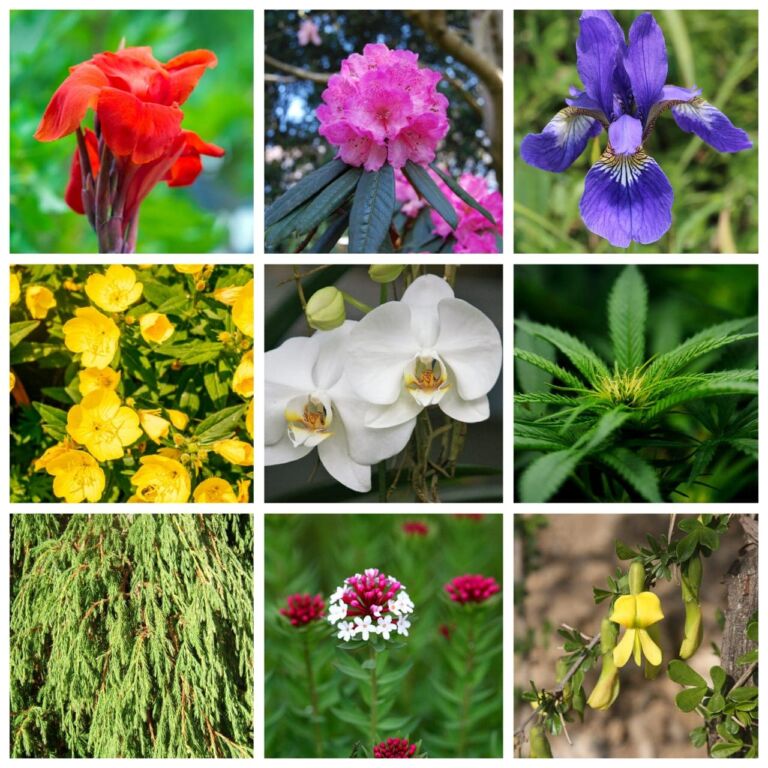
Flora found in the Annapurna region
Row 01: Canna lily, Rhododendron, Iris Row 02: Yellow primrose, White orchid, Marijuana Row 03: Juniper bush, Stellara, Caragana brevispina

Fauna found in the Annapurna region
Row 01: Bharal (Blue sheep), Snow leopard, Himalayan wolf Row 02: Gray langur, Leopard, Jungle cat Row 03: Red fox, Himalayan marmot, Red giant flying squirrel
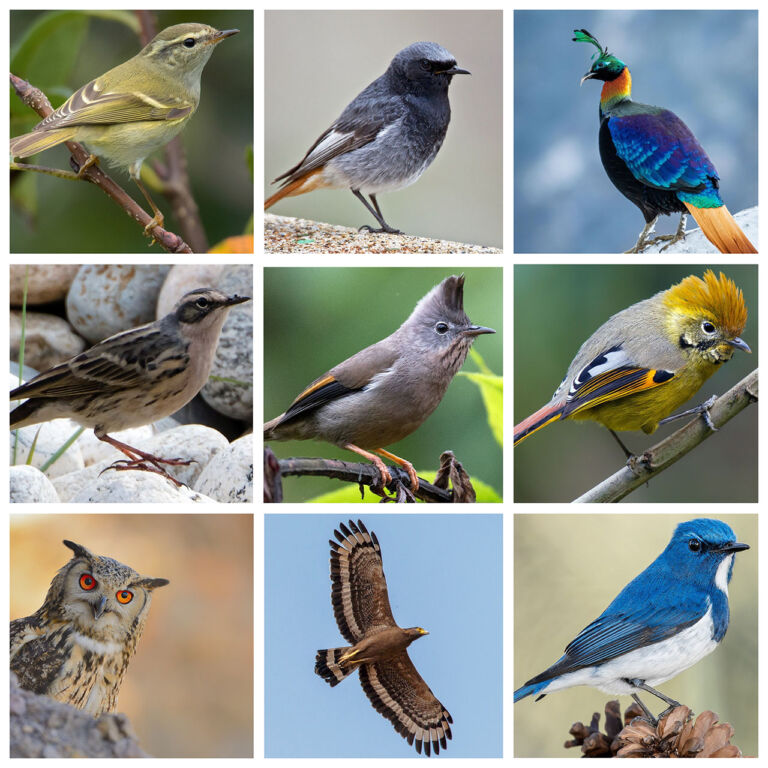
Birds found in the Annapurna region
Row 01: Hume's leaf warbler, Black redstart, Impeyan pheasant Row 02: Rosy pipit, Stripe-throated yuhina, Chestnut-tailed minla Row 03: Rock eagle owl, Crested serpent eagle, Ultramarine flycatcher
Travel Information
All trekkers must provide a copy of their comprehensive travel insurance policy certificate to the Himalayan Odyssey Nepal Trek before starting the trek.
[Note:] The policy must cover medical and emergency repatriation, including helicopter rescue and evacuation expenses at high altitudes.
Trekking permit requirements Two permits are required for the Annapurna Circuit Trek : 1) a TIMS (Trekkers Information Management System) card 2) an entry permit for the Annapurna Conservation Area Project permit
Permit Cost * Annapurna Conservation Area Project permit : NPR 3000
The level of difficulty for the Annapurna Circuit Trek is challenging (grade IV). One commences the Thorong La Pass Trek at an altitude of around 1,000 meters above sea level and ascends to as high as 5,416 meters at Thorong La Pass. This height is considerable. There is a possibility of experiencing altitude sickness.
During the trek, potable water is conveniently accessible. Kindly bring a reusable water bottle for refilling at every lodge. For your safety, it is advisable to carry purifying tablets to ensure the water is safe to drink.
If you experience symptoms of high-altitude sickness, it is recommended that you immediately return to a lower altitude. You may find more information on altitude sickness on our website’s dedicated Altitude Sickness page.
Cellular networks are available on the trekking trails of the Upper Mustang trek, though occasional areas may have limited or no reception.
The standard length of the Annapurna Circuit Trek is approximately 160-260 kilometers. The duration of the trek can vary between 10 to 21 days, depending on your itinerary or the starting and ending points.
Trekking Map of Annapurna Circuit Trek: 12-Days Itinerary

Duration: 10 Days

Duration: 11 Days
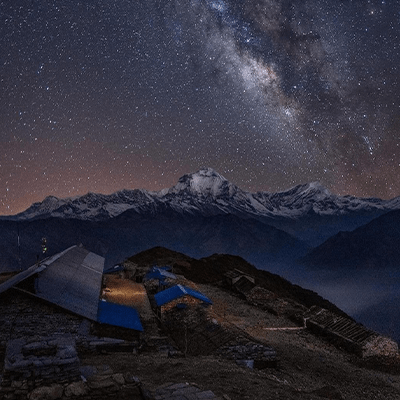
Duration: 9 Days
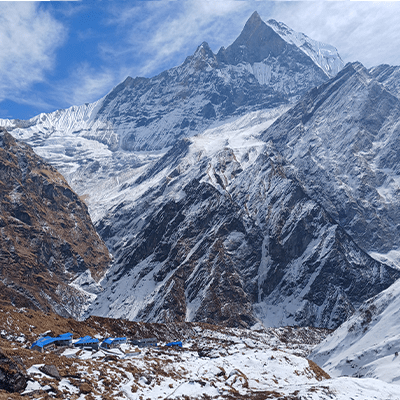
Duration: 7 Days
Best Price Guarantee – Book with Confidence!

Himalaya Discovery

Annapurna Circuit Trek Map
The Annapurna Circuit Trek is one of the best treks in Nepal, if not the world–although road construction in the last two decades has had a significant impact on the trekking experience (more on this later). Note: if you’re a mountain biker, the road on the west side is one of the most exciting and scenic mountain biking experiences!
The trek starts at Jagat or Dharapani (approx. 8 hrs drive from Kathmandu) and ends in the Kali Gandaki Gorge– the disputed highest gorge in the world between Dhaulagiri (8,176 meters) and Annapurna (8,091 meters)
For acclimatization reasons, the circuit is followed by an anti-clockwise trail that circumvents the Annapurna Massif and takes trekkers through Central Nepal’s Annapurna, Manang and Mustang region. At its peak, the trek crosses the Thorong La Pass (5,416 meters) and descends to the town of Muktinath .
The road construction activities that began in 2004 and completed in 2008/9 have had a measurable impact on the trekking experience of the Annapurna circuit.

The Nepalese government realized that the route had a negative impact on hiking tourism on both the western (Pokhara-Muktinath) and eastern (Chame-Manang) sides of the circuit and created a series of New Annapurna Trekking Trails. These NATT trails, marked blue and white or red and white, take trekkers off the dusty and unpleasant roads and enjoy a much more pleasant walk.
The Annapurna circuit typically takes 10 – 17 days to complete (depending on whether you decide to take a detour to the Annapurna Base Camp and the Annapurna Sanctuary) and covers 150 – 240 km (depending on when you decide to stop the tour or use transport vehicles).
The scenery on the Annapurna Circuit is exceptionally beautiful, with trekkers crossing rice-terraced paddy fields, subtropical forests and glacial surroundings. There are a number of major mountains, including the Annapurna Massif (I-IV), three 8,000m peaks–Dhaulagiri (8,176m), Manaslu (8,156m) and Annapurna I (8,091m) and numerous 6,000 to 7,000m peaks.
Detailed Annapurna Circuit Trek Map

The Himalayan Map house, New Annapurna Trekking Trails map & Annapurna Circuit Trek map, which can be purchased in Kathmandu, Pokhara or online.
Please note : The classic Annapurna circuit has been severely affected by the road from Muktinath to Jomsom. If you choose to walk this route, be prepared for an unpleasant and dusty experience, as you wiz jeeps. Fortunately, the New Annapurna Trekking Trails (NATT-trails) offer alternatives. We suggest the following route if you are not on a set trip.
Trek to the beautiful town of Kagbeni (2,800 meters) for an overnight stay. We recommend taking the high trail via Jhong from Muktinath, as it offers better views of the mountains.
From Jomsom take the new NATT- trail (marked in red and white) to Marpha (2,665m), where you can stay overnight and then continue along the route from Jomsom/Marpha below. Though, we highly recommend not skipping Kagbeni.
If you run out of time, you can also get a bus or jeep from Muktinath to Pokhara. If you are a fanatic of mountain biking, you can rent a mountain bike for one of the most amazing rides down and out of Muktinath this area of Nepal is rapidly becoming a famous mountain biking routes.
Annapurna Route Variations.
If you have much time on the Annapurna Circuit, you might want to consider the Poon Hill Tre k, the Mardi Himal Trek or Annapurna Base Camp Trek .

Trekking in Annapurna is a classic trip with all aspects for a classic trek and a great adventure. This trek is perfect for adventure seekers.
Do you have any question about trip to Nepal?
- Solo Traveller
- Number of child (if you have child in your family/group) (Optional)
- When will you be traveling?* * Day 1 2 3 4 5 6 7 8 9 10 11 12 13 14 15 16 17 18 19 20 21 22 23 24 25 26 27 28 29 30 31 Month 1 2 3 4 5 6 7 8 9 10 11 12 Year 2025 2024 2023 2022 2021 2020 2019 2018 2017 2016 2015 2014 2013 2012 2011 2010 2009 2008 2007 2006 2005 2004 2003 2002 2001 2000 1999 1998 1997 1996 1995 1994 1993 1992 1991 1990 1989 1988 1987 1986 1985 1984 1983 1982 1981 1980 1979 1978 1977 1976 1975 1974 1973 1972 1971 1970 1969 1968 1967 1966 1965 1964 1963 1962 1961 1960 1959 1958 1957 1956 1955 1954 1953 1952 1951 1950 1949 1948 1947 1946 1945 1944 1943 1942 1941 1940 1939 1938 1937 1936 1935 1934 1933 1932 1931 1930 1929 1928 1927 1926 1925 1924 1923 1922 1921 1920
- How many days do you have?* *
- Give your trip a short title* *
- Private Trip
- Bellow 200$
- 200$ - 500$
- 500$ - 800$
- 800$ - 1200$
- 1200$- 2000$
- 2000$ and above
- Describe your trip* *
- Full Name* *
- Your Email* *
- Country* * Afghanistan Albania Algeria American Samoa Andorra Angola Anguilla Antarctica Antigua and Barbuda Argentina Armenia Aruba Australia Austria Azerbaijan Bahamas Bahrain Bangladesh Barbados Belarus Belgium Belize Benin Bermuda Bhutan Bolivia Bonaire, Sint Eustatius and Saba Bosnia and Herzegovina Botswana Bouvet Island Brazil British Indian Ocean Territory Brunei Darussalam Bulgaria Burkina Faso Burundi Cabo Verde Cambodia Cameroon Canada Cayman Islands Central African Republic Chad Chile China Christmas Island Cocos Islands Colombia Comoros Congo Congo, Democratic Republic of the Cook Islands Costa Rica Croatia Cuba Curaçao Cyprus Czechia Côte d'Ivoire Denmark Djibouti Dominica Dominican Republic Ecuador Egypt El Salvador Equatorial Guinea Eritrea Estonia Eswatini Ethiopia Falkland Islands Faroe Islands Fiji Finland France French Guiana French Polynesia French Southern Territories Gabon Gambia Georgia Germany Ghana Gibraltar Greece Greenland Grenada Guadeloupe Guam Guatemala Guernsey Guinea Guinea-Bissau Guyana Haiti Heard Island and McDonald Islands Holy See Honduras Hong Kong Hungary Iceland India Indonesia Iran Iraq Ireland Isle of Man Israel Italy Jamaica Japan Jersey Jordan Kazakhstan Kenya Kiribati Korea, Democratic People's Republic of Korea, Republic of Kuwait Kyrgyzstan Lao People's Democratic Republic Latvia Lebanon Lesotho Liberia Libya Liechtenstein Lithuania Luxembourg Macao Madagascar Malawi Malaysia Maldives Mali Malta Marshall Islands Martinique Mauritania Mauritius Mayotte Mexico Micronesia Moldova Monaco Mongolia Montenegro Montserrat Morocco Mozambique Myanmar Namibia Nauru Nepal Netherlands New Caledonia New Zealand Nicaragua Niger Nigeria Niue Norfolk Island North Macedonia Northern Mariana Islands Norway Oman Pakistan Palau Palestine, State of Panama Papua New Guinea Paraguay Peru Philippines Pitcairn Poland Portugal Puerto Rico Qatar Romania Russian Federation Rwanda Réunion Saint Barthélemy Saint Helena, Ascension and Tristan da Cunha Saint Kitts and Nevis Saint Lucia Saint Martin Saint Pierre and Miquelon Saint Vincent and the Grenadines Samoa San Marino Sao Tome and Principe Saudi Arabia Senegal Serbia Seychelles Sierra Leone Singapore Sint Maarten Slovakia Slovenia Solomon Islands Somalia South Africa South Georgia and the South Sandwich Islands South Sudan Spain Sri Lanka Sudan Suriname Svalbard and Jan Mayen Sweden Switzerland Syria Arab Republic Taiwan Tajikistan Tanzania, the United Republic of Thailand Timor-Leste Togo Tokelau Tonga Trinidad and Tobago Tunisia Turkmenistan Turks and Caicos Islands Tuvalu Türkiye US Minor Outlying Islands Uganda Ukraine United Arab Emirates United Kingdom United States Uruguay Uzbekistan Vanuatu Venezuela Viet Nam Virgin Islands, British Virgin Islands, U.S. Wallis and Futuna Western Sahara Yemen Zambia Zimbabwe Åland Islands Country
- Phone Number (Optional)
Recommended Articles

Annapurna Base Camp Trek 7 Days

Annapurna Base Camp Vs Everest Base Camp Trek

Annapurna Base Camp Trek Packing List

A Guide to Annapurna Base Camp Elevation

“ I was born and raised in Nepal, nearby Everest region. I am proud to be a native Sherpa, and I have been a Mountain guide over a decade now. Following my passion, I decided to start helping travelers with their travel plans! I think life is a journey, a trip where you collect experiences when you share with other people and with nature. “

Trip Designer
→ PLAN YOUR TRIP – FREE

Privacy Overview

- Travel Guides
- Bucket List
- Experiences
- Collaboration
The Ultimate Guide: Hiking The Annapurna Circuit Trek 2024
Featured on.

DID YOU KNOW?
Where and Wander uses affiliate links on this page. When you purchase or book something using my links, I might earn a small commission and it costs you nothing.
If you’re planning a trip to Nepal, you’re most likely here to do some trekking. And there’s no trek grander than the Annapurna Circuit that takes you up 5416m (17769 ft) and across 220 km (~137 mi) of remote mountains and villages, beginning in Besisahar and ending in Pokhara. After debating long and hard between Everest Base Camp and the Annapurna Circuit, I chose the latter and have no regrets.
Is The Annapurna Circuit Open in 2024?
Nepal is currently open to foreign visitors. Check your visa requirements beforehand, but for most countries, a visa on arrival is available.
How Long Does It Take To Complete The Annapurna Circuit Trek?
This classic Annapurna Circuit Trek hike used to take about 3-4 weeks to complete by foot with teahouses along the way to offer food and shelter for trekkers, but can now be done in less time. With the construction of new roads, the landscape and access points are changing. For better or for worse, the trek can now be done in as little as 10-12 days. There are even trips that cut it down to 8 days, which I do not recommend.
Choose your adventure. This should help you figure out how long you should plan for it, the best time of year to go, and what to expect along the way. It’s a long read with a lot of useful information, so skip to whatever sections you need. And bookmark it to get back to the parts you need as you progress in your planning.
If you’re interested in other hikes besides the Annapurna Circuit, there’s a great guidebook with 14 of Nepal’s best hikes . Otherwise, keep reading for all information you need to plan your Annapurna Circuit hike this year.
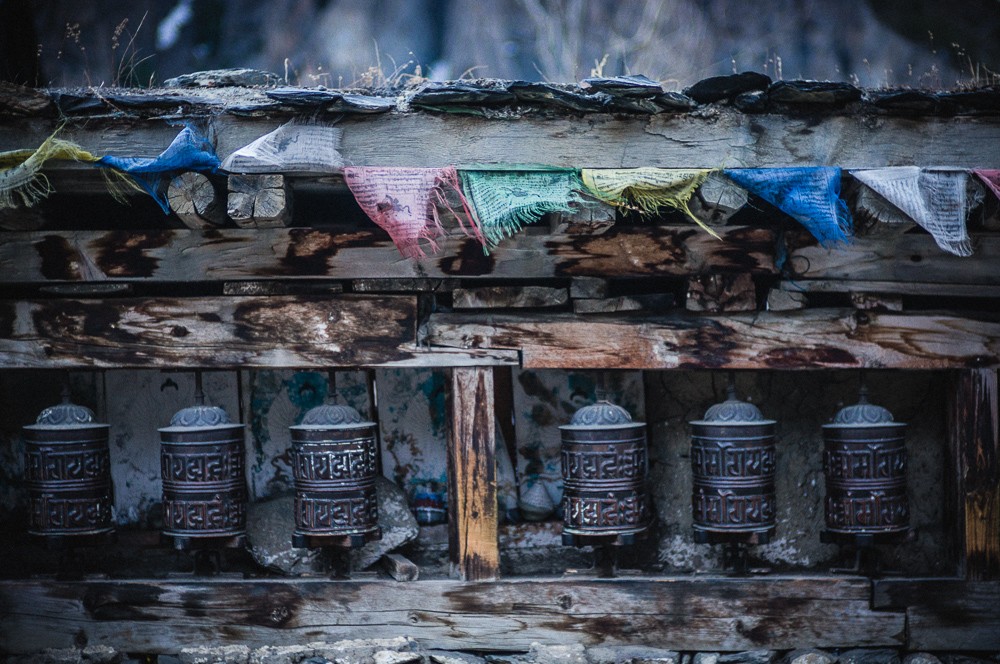
You can use the links below to jump to any of these sections:
Hiking Solo | Group Tours | Where To Stay | Annapurna Circuit Route | Villages | TIMS | Permits | Cost | Time | 10 Day Route | 12 Day Route | 14 Day Route | Teahouses | Food | WIFI and Data | When To Hike Annapurna Circuit | Should You Get A Guide? | What To Pack | Health and Insurance | Last Thoughts
Can You Hike The Annapurna Circuit Alone?
It may come as a surprise, but you can definitely and easily do the Annapurna Circuit hike solo. Not only is the path pretty straightforward, but it’s a lot easier nowadays with the aid of things like offline maps and GPS on your phone. Maps.me is a great app that allows you to download maps to use offline. Cellular and data reception has improved, especially around the villages, but it’s still hit or miss at times. You can read more about this below.
If you were the only person on the mountain and you had to do the Thorong La Pass alone in the dark, it might be best to have mountaineering and navigational experience. Fortunately, High Camp (the last stop before the pass) is always packed with hikers and guides (many of whom you’ve probably met and interacted with along the way there).
Everyone is more or less doing the same thing and information is shared readily. Just follow the lead of other guided parties.
The paths along the way are pretty well marked to get from one village to the next. You’ll see many people throughout the day, so if you use common sense, it is completely reasonably to do the Annapurna Circuit solo.
Group Tours To Hike The Annapurna Circuit With Other People
For those who would like to do the hike with other people, I recommend joining a guided group. You’ll still complete every part of the hike, but everything will be arranged for you, including permits, transports, fees, daily accommodations, meals (optional), and guide fees. Most importantly, you will be sharing the experience with other people. The social aspect of the Annapurna Circuit should not be overlooked.
Himalayan Nomad Treks offers a 10 day circuit trek and Dream Noble Adventure offers a classic 9 day circuit trek , and a 17 day circuit trek that also includes a side trip to Tilicho lake.
Hiking Alone Vs Hiking In A Guided Group
This is a very important decision. You can hike the circuit alone, but you should ask yourself if you want to. When you go it solo, you are on your own schedule. Hike when you want, break when you feel like it, and pick the teahouse that catches your fancy. You go at your pace and fitness level and you don’t’ have to worry about anyone else’s.
You can choose to socialize with people along the way or at the teahouses. And even share parts of the route with them. It’s up to you. But if something goes wrong while you’re alone, you might have to wait until someone else comes along. There’s that element of safety.
If you’re hiking with a partner or a group, you will make decisions together, or follow the lead of the guide. Individual problems within the group can affect everyone.
I hiked with another person I met in Kathmandu. We shared a guide. The evening before the Thorong La Pass, my friend was unsure he could make the pass and wanted to turn back. Since we were sharing a guide, we had to decide whether to both turn back, or have one of us finish the trip without a guide. Luckily, he changed his mind in the morning, and we proceeded without any issues.
Personally, I’m glad I had a hiking partner and that we met others along the way. It was nice to have conversations with people from other parts of the world, and share parts of the last few days’ hike with them.
Where To Stay In Kathmandu
Thamel is the best area for you to stay in Kathmandu before your hike. It’s where you’ll find all the tourist offices, shops for gear, and the best restaurants.
There are no shortage of cheap guesthouses and hostels for those on the budget. You’ll also find some higher end hotels for very reasonable prices. These are a great way to splurge at the end of your trip.
The Best Hostel In Thamel
Yakety Yak Hostel is go to hostel right in the middle of Thamel. Rest Up and Planet Nomad are both good social hostels where you can meet other hikers.
The Best Hotels In Thamel
Taleju Boutique Hotel
Nepali Ghar Hotel
Nirvana Boutique Hotel
Kumari Boutique Hotel
Hotel Barahi Kathmandu
Fairfield by Marriott Kathmandu
The Best Luxury Hotels In Kathmandu
These are all located a bit outside of Thamel, so you’ll escape the crowd and hustle for a bit of quiet and comfort. I recommend one of these hotels as a treat to celebrate the completion of the hike. These are the nicest hotels you’ll find in Kathmandu.
Baber Mahal Vilas
Dwarika’s Hotel
Hotel Thrive
The Annapurna Circuit Loop Route
Trekkers typically begin their hike in the small village of Besisahar , arriving by bus from either Kathmandu (6-10 hours) or Pokhara (2-4 hours). With the newly form dirt “road”, you can skip the first 9 km and take a jeep or van to Bhulbhule . From here, the trail is more or less restricted to foot powered transport.
Villages are located every 3-5 km apart, some with just a teahouse or two while others are larger checkpoints with many food and accommodation options.
Trekkers are advised to ascend slowly to acclimate, taking in about 5-8 km each day between villages. In the beginning, you can do more, but trust in the process.
The major landmark villages are located at Tal (1700 km), Bagarchap (2160m), Chame (2710m), Lower Pisang (3250m), Manang (3540m), Yak Khark a (4050m) and High Camp (4850m) before making the climb to the Thorong La Pass , the highest point on the trek at 5416m.
Although there are recommended hiking itineraries, trekkers can make their own plans and decide to stop wherever they can find a teahouse with lodging. After the pass, it’s a sharp drop in elevation to Muktinath (3800m). From here, there are roads so weary hikers have more options on how to continue.
Jomson (2720m) has an airport and an exit option for those on a shorter 10-12 day itinerary. Those continuing can finish the last 80m from Jomsom to Pokhara via Tukuche (2590), Kalopani/Lete (2535m), Ghasa (2010m), Tatopani (1200m), Ghorepani (2870m) and Birethanti (1025m).
Annapurna Circuit Elevation Map and Villages

Guide To All Annapurna Villages And Teahouses Elevation and Distance
Name: Elevation / Km Marker Besisahar: 820m / 0km Khudi: 790m / 7km Bhulbhule: 840m / 9km Ngadi: 890 / 13km Bahundanda: 1310m / 17km Ghermu: 1130m / 22km Jagat: 1300m / 25km Chamche: 1385m / 29km Tal: 1700m / 34km Karte: 1870m / 38km Dharapani: 1900m / 40km Bagarchap: 2160m / 42km Danaqyu: 2200m / 44km Latamarang: 2400m / 48.5km Thanchowk: 2570m / 50km Koto: 2640m / 54km Chame: 2710m / 56km Bhratang: 2850m / 63km Dhukur Pokhari: 3240m / 69km Upper Pisang: 3310m / 70.5km Ghyaru: 3730m / 75km Lower Pisang: 3250m / 75km Ngawal: 3680m / 80km Humde: 3330m / 82km Bhraga: 3450m / 88km Manang: 3540m / 90km Yak Kharka: 4050m / 99km Letdar: 4200m / 100km Thorang Phedi: 4450m / 105km High Camp: 4850m / 107km Thorong La Pass: 5416m / 111km Charabu: 4230m / 117km Muktinath: 3800m / 121km Jharkot: 3550m / 122km Khinga: 3355m / 125km Kagbeni: 2800m / 131km Eklebhatti: 2740m / 133km Jomsom: 272m / 140km Marpha: 2670m / 146km Tukuche: 2590m / 152km Kobang: 2640m / 156km Larjung: 2550m / 157km Kokhethanti: 2525m / 160km Kalopani/Lete: 2535m / 163km Ghasa: 2010m / 170km Kopchepani: 1480m / 174km Rupsechhahara: 1500m / 176km Dana: 1400m / 179km Tatopani:1200m / 183km Ghara: 1700m / 188km Sikha: 1935m / 194km Chitre: 2350m / 195km Poonhill: 3200m / 197km Ghorepani: 2870m / 200km Ulleri: 2010m / 202km Tikhedhunga: 1500m / 204km Birethanti:1025m / 210 km Naya Pul: 1070m / 211 km
How To Get A TIMS Card In Kathmandu
Before you hike the Annapurna Circuit, or do any other treks in Nepal, you will need a TIMS (Trekker Information Management Systems) card. This a basic identification card for all hikers.
Different treks might require more specific permits. You can apply for your TIMS card at the TIMS counter at the Tourist Service Center in Kathmandu. It’s open from 10 am to 5 pm, 7 days a week. There’s normally a lunch break between 1 and 2 pm.
The TIMS card costs 1000 NPR ($7.5 USD) for SAARC (citizens of South Asian countries) applicants and 2000 NPR ($15 USD) for the TIMS card for everyone else. The whole process takes just a few minutes if you have all the required documentations.
What You Need To Bring To Apply For A TIMS Card?
Before you apply for a TIMS card in Kathmandu, you need to have the following:
- Copy of your passport
- 2 passport-sized photos
When you fill out the form, you’ll need to put in the following information.
- Estimated Entry and Exit Date
- Estimated Entry and Exit Point
- Route/Itinerary
- Insurance policy number and coverage
- Emergency contact in Nepal (you can use your tour agency or hostel as the emergency contact)
- Emergency contact at home
For more information on the TIMS card, check out the website of the Nepal Tourism Board.
For more information about which areas require permits and the costs, check out the official Trekking Agencies Association of Nepal (TAAN)’s website .
How Much Is The ACAP (Annapurna Conservation Area Permit) Fee?
In addition to the the TIMS card, you will need to pay the ACAP Fee to enter and hike the Annapurna Conservation Area.
For SAARC citizens, the fee is 1000 NPR ($7.5 USD)
For Non-SAARC citizens, the fee is 3000 NPR ($23 USD)
You can apply for and pay for this fee when you apply for your TIMS card.
Restricted-Area Permits
This is only applicable for people hiking in restricted areas. See the list below:
2. Kanchenjunga
4. Nar–Phu Valleys
5. Tsum Valley
6. Lower Dolpo
7. Upper Dolpo
8. Upper Mustang
This will only be applicable if you’re doing a special guided hike, since you can’t hike alone in restricted areas. Restricted areas follow a fee schedule. Your tour operator will help you organize this.
How Much Does It Cost To Trek The Annapurna Circuit?
The TIMS card and ACAP permit will cost you around 5000 NPR ($38 USD).
For day to day costs, here’s a rough estimate of what you can expect, which was similar to what I spent. Not much has changed the last few years, but 2021 might be a little different as the economy struggles to deal with the pandemic.
- Food & Accommodation: $15/Day
- Guide: $20-25/Day
- Porter: $15/Day
- Transportation From Kathmandu: $5-15
- Transportation From Pokhara to Kathmandu: $7-$20
Also factor in any additional expenses if you plan to take public transportation or transport between Muktinath and Pokhara.
How Much Time Do I Need For The Annapurna Circuit Trek?
This is actually a pretty hard question to answer and prior to doing it, I used to hear that it takes 3 weeks or 20 days to complete the Annapurna Circuit trek. After doing it in less time than that, I’d say that 20 days is the amount of times it takes to leisurely hike the entire loop with time to get back to Kathmandu. Most people can complete the hike in 14-16 days ending up in Pokhara.
There are others though, who are more limited on time and want to complete the trek in less time. This has led to new shortened itineraries, offered by tour agencies in Kathmandu, to do a trip in as little as 10 days.
To be fair, most of the really lush and mountainous parts of the trek take place before the Thorong La Pass. The second half of the Annapurna Circuit loop takes you downhill through bigger towns across flatter and more open terrain. Construction has opened up many roads along this stretch, so there are more options to take motor transportation or even to bike the rest of it.
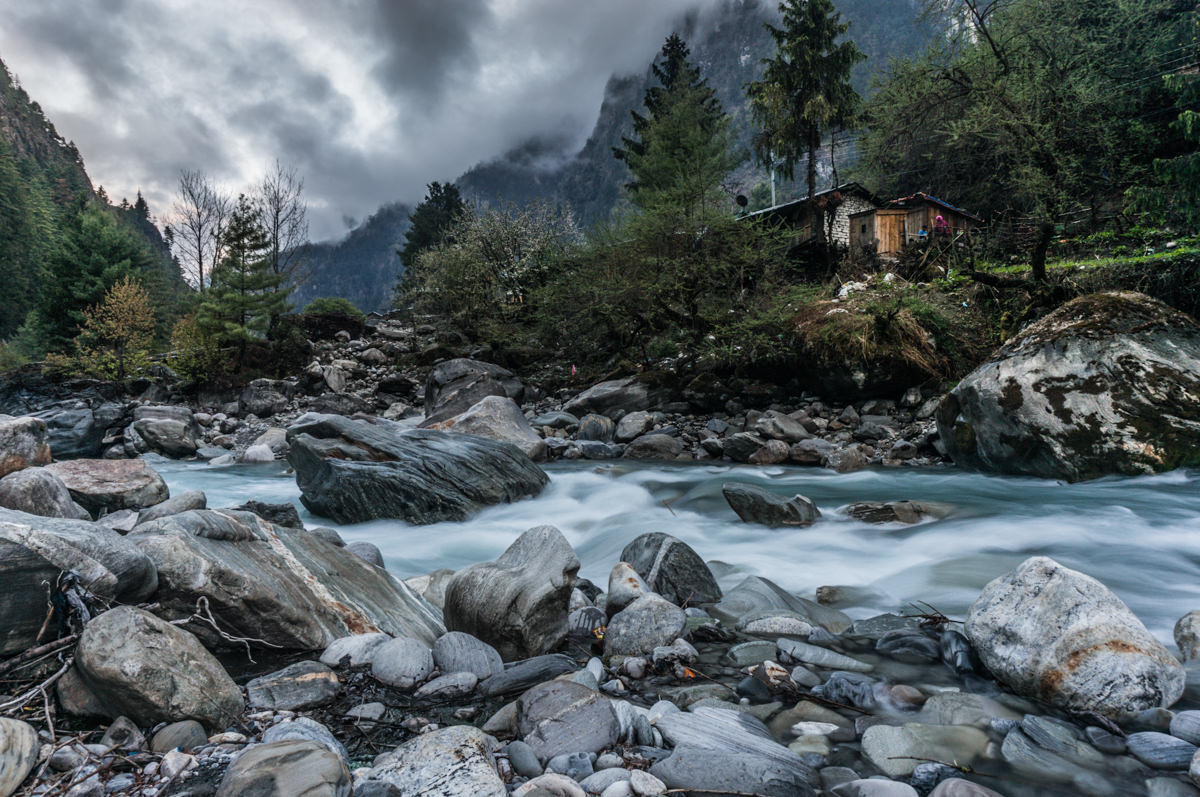
Can You Really Do The Annapurna Circuit In 10 Days?
No matter how fast you ultimately end up hiking, it is extremely difficult to finish the entire Annapurna Circuit loop in 10 days. You, however, can easily complete the circuit up to the Thorong La Pass in 10 days and take buses to finish out most or all of the second half of the loop starting in Jomsom.
This is what many people with limited time end up doing. It’s really about 8 days of trekking because you spend the first day getting from Kathmandu to Beshisahar and then take a jeep to the village of Chame (29 km into the trek) to begin hiking on day 2. The last day is a transfer day from Jomsom to Pokhara, where you can fly back to Kathmandu or take another 6-7 hour bus.
Here’s what a 10 day itinerary typically looks like if you go with a tour/guide.
Fast 10 Day Annapurna Circuit Trek Itinerary
Day 1: Bus from Kathmandu to Beshisahar. This takes about 6-7 hours with stops along the way.
Day 2: Drive by 4WD from Beshisahar to Chame. This takes about 5 hours.
Day 3: Hike about 5-6 hours Chame to Pisang. You end up at around 3200m elevation by the 3rd night.
Day 4: Hike 5-6 hours from Pisang to Manang. You slowly gain another 340m.
Day 5: Spend the day in the village of Manang to acclimatize. You have the option of doing a 5-6 hour trek to an ice lake that’s at 4600m to acclimate.
Day 6: Hike 5-6 hours from Manang to Ledar. You spend the night at 4200m elevation. This is the biggest elevation gain so far, hence the extra day in Manang to acclimate and rest.
Day 7: Hike 5-6 hours from Ledar to High Camp at 4833m. There’s a short, but steep hike at High Camp that a lot of people do during the day to be at a higher elevation before sleeping at 4833m.
Day 8: Hike before dawn from High Camp to the Thorong La Pass. You reach the highest point of elevation on the trek at 5416m. From here you descend down to Muktinath at 3760m. This takes about 8 hours.
Day 9: Hike about 6 hours from Muktinath to to Jomsom dropping down to 2720m.
Day 10: Take a 9-10 hour bus or a 1 hour flight from Jomsom to Pokhara.
For advanced and acclimated hikers: To get from Besisahar to Birethanti/Naya Pul and complete the full trek, it’s 211 km or 131 miles. That’s comes out to about 13 miles a day over 10 days. While this seems very doable, you would have had to already be acclimated to altitudes near 4500m.
For people who are properly acclimated, it is definitely possible to hike the 107 km or 66 miles to High Camp (the stop before the Thorong La Pass) in 5-7 days. You can skip the day of acclimating in Manang and start the hike on Day 1 to one of the few first villages.
On each of the days, you would either hike faster or longer and stop at one of the villages in between the proposed itinerary. The advantage to this is you avoid the main crowd who congregate in those villages. The disadvantage is those in between villages are much smaller and have fewer options for accommodations.
By Day 6, you should be able to get to the Pass and start your descent. Days 7-10 gives you 4 days to hike the 90 kms from Muktinath to Birethanti/Naya Pul. There are optinos now to bike part of the way down to the end.
It’s all downhill, but it’s also very exposed to the heat during this stretch.
12 Day Annapurna Circuit Trek Route
With an additional 2 days, you have the option of starting the hike from the beginning instead of taking a jeep 29 km straight to Chame and hiking to Kalopani. Alternatively, you can start in Chame and use the extra two days to get to Tatopani, taking you 3/4 of the way around the circuit. If you are somewhat acclimated, you can also skip the day in Manang and push to complete the last 28 km to Birethanti/Naya Pul from Tatopani.
14 Day Annapurna Circuit Trek Route
This is probably the most common number of days for people who want to complete the entire Annapurna Circuit loop from start to finish in a well paced but still expedited manner. It’s similar to what I just mentioned for the 12 day trek, but you can complete the first section without the jeep, still have your acclimatization day in Manang, and make a push for the downhill and flat sections to get to Birethanti/Naya Pul.
Teahouse Food and Accommodation On The Annapurna Circuit
Teahouses are a cornerstone part of the Annapurna Circuit experience. It’s where you rest for lunch and it’s where you spend the night and eat dinner. The offerings are pretty basic, but any and all comfort will be welcomed after a long hard day of walking. The higher up you go, the more you appreciate reaching one of these villages at the end of the day.
As far as food goes, trekkers often take breakfast and dinner at the teahouse where they stay and lunch at a different village on the trail. Sometimes, you can only get a room if you eat at that teahouse and these rooms generally run around 300 Rupee (3 USD) for a double.
You might even get away with asking for free accommodation if you are hiking without a guide or porter and agree to eat there. But I don’t recommend this. A large part of Nepal’s economy is built around tourism and income from trekkers. You might be saving a few dollars that’s worth a lot more for these families. Many of who are desperate for business, especially with everything happening since 2020.
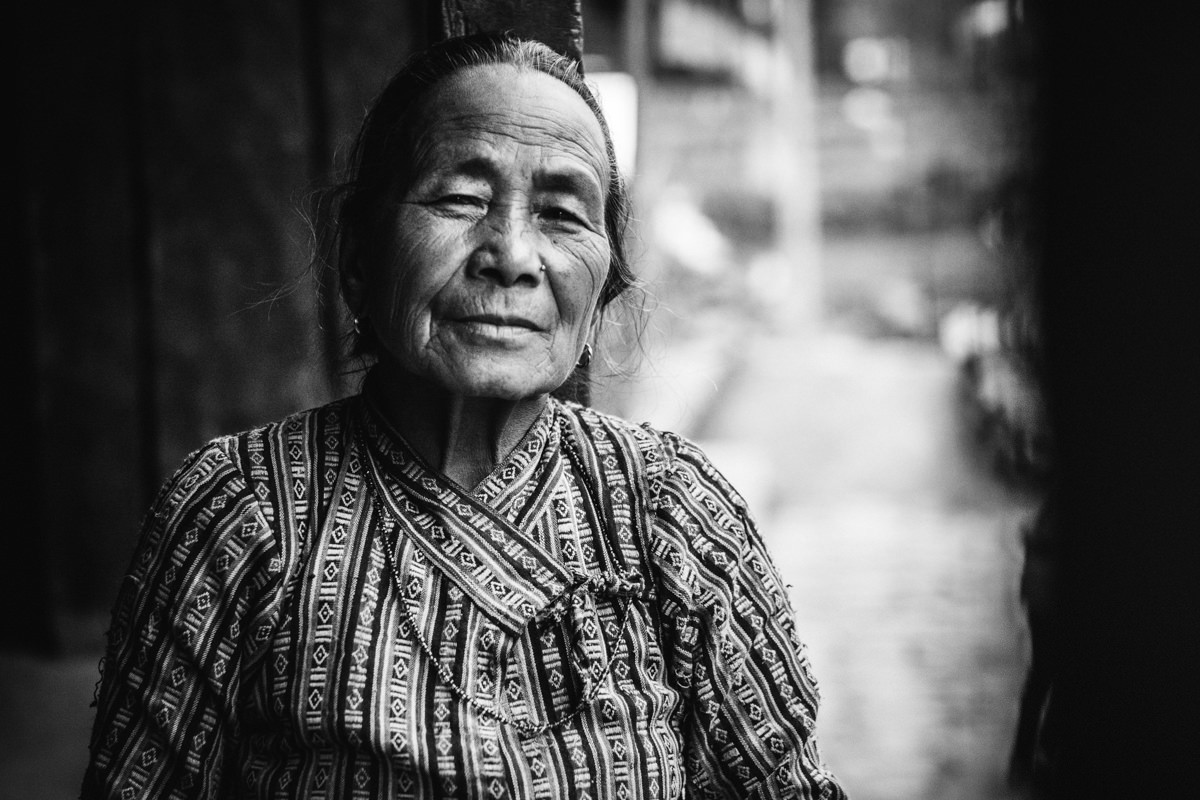
Eating At The Teahouses On The Annapurna Circuit Trek
Food and tea service is how locals earn their income and benefit from the tourism. It’s a simple rule of thumb that the price of food, tea and water will rise with the altitude. Without roads in and out of these remote villages, they have to transport that cold beer or Snickers bar you are enjoying by foot or donkey. You’ll be passed by porters in sandals carrying large loads on their back doing the same trek as you. The higher you go, the longer it took them, so keep that in mind as you wonder why prices are higher.
Are There Vegetarian Restaurants On The Annapurna Circuit?
You’ll find similar menus across all the teahouses with the Dal Bhat sets being the most cost-effective option. Most meal offerings at these Annapurna Circuit teahouses will be vegetarian. A set will come with rice, lentil soup, and vegetables. If you are hungry, they will serve you seconds. Beyond this and the delicious Tibetan bread, there are your western entrees like pasta and pancakes if you need a break from lentils.
Finding a meat option is pretty rare except at some of the larger villages where you can find more exotic dishes like yak steak and yak stew.
Water is an essential requirement. Consider bringing a couple of refillable bottles, like these collapsible water pouches and treat your water with iodine tablets if you don’t want to add to the one time use plastic problem. It’s also a good idea to stock up on snacks ahead of time. Your selection will be more limited at the villages. You’ll appreciate any forms of carbs to keep your blood sugar level up during the hike.
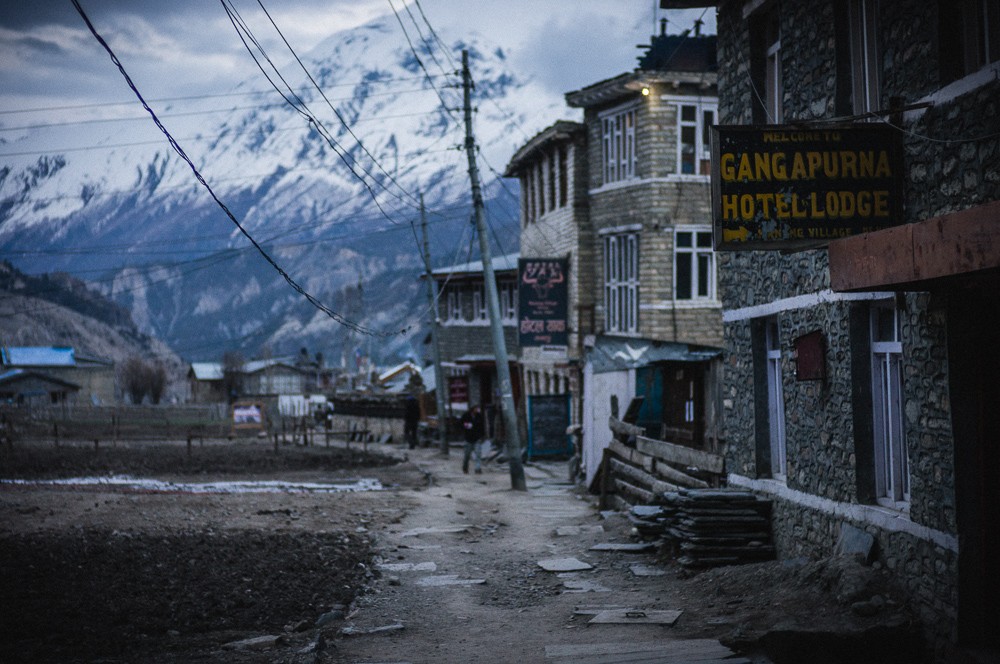
Wifi and Cellular Data Coverage On The Annapurna Circuit
Most teahouses and lodges now have internet and WIFI connection, but expect to pay a few hundred rupees for access. Depending on the weather, the strength of the connection may not be what you’re used to, so do not always rely on and expect a strong steady connection.
Nepal Local SIM Price and Procedure
It’s best to buy a local SIM ahead of times if you need data on the trail, but once again, due to the remote area and terrain, data will not always be available on the trek. I recommend just picking up a free Nepal Telecom SIM at the airport or in Kathmandu (you pay for a small fee) before you start. You can charge up for the number of days you require during your visit. There are a number of packages starting ranging from 1 day to 28 days with prices starting from 55 NPR ($.40) to 800 NPR ($6). The upper end will get you 25 GB of data for 28 days. Though you can get the SIM for free at the airport, the packages will cost more, so it’s better to just get it at the official Nepal Telecom store in Kathmandu.
Ncell Nepal also offers cheaper SIM packages if you just need data.
If data is really important to you, I recommend getting a SIM from each provider to maximize your chances of getting coverage. It’s quite economical to do and it will give you some peace of mind, especially if you’re hiking solo.
Getting a SIM in Nepal will require you to register with your passport along with a passport sized photo.

Charging Your Phone And Devices On The Annapurna Circuit
While the tea houses have outlets to charge, it is not enough for everyone and the guides and locals will need to charge their devices first. I keep my camera battery chargers in an easy to access location so I can do quick charging sessions at lunch or as soon as I get to a teahouse.
Though it adds a bit of weight, it is highly recommended to carry a large reliable power bank with around 20000 mAh worth of juice that holds its charge in cold weather. It’s not possible to recharge or charge overnight with the limited number of sockets in the teahouses.
Best Time To Hike The Annapurna Circuit
A bit of knowledge can go a long way when it comes to choosing the best time to visit Nepal and hiking the Annapurna Circuit. While getting to the start of the Circuit doesn’t require a stomach-churning and weather-dependent flight like it does to get to start the Everest Base Camp trek, heavy snow can close off the Thorong La Pass cutting off your access to the other half of the circuit.
The Annapurna Circuit follows Nepal’s general hiking seasons. The dry season starts in October/November , making it one of the best time of year to do the Annapurna Circuit trek amidst landscapes that are lush and green from the recent monsoons. Visibility is clear and you can get amazing views of the Himalayas throughout the hike.
December and January offers similar visibility but a drop in temperature that can make the Annapurna Circuit trek very cold or even closed at the pass. February to April reopens the window for a more comfortable trek before the monsoon and heat hits in May . It’s best to avoid the Annapurna Circuit trek from June through early September where the humidity and monsoon arrives in full force. The trails are wet and muddy and waterfalls and floods can partially block the trails and roads to and on the Annapurna Circuit.
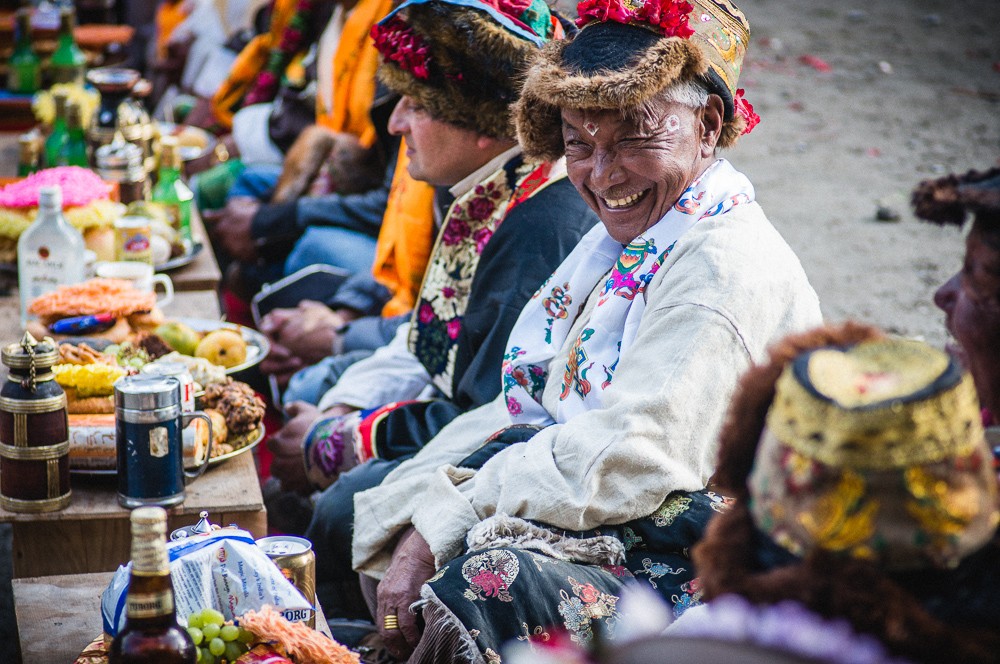
Should You Get An Annapurna Circuit Guide Or Porter?
If you’ve met someone who’s trekked the Annapurna Circuit on their own, they’ll probably tell you that you don’t need a guide. If you walk into one of the tour offices in Thamel, they’ll probably tell you that not only should you do it with a hike, you should probably hire a porter to carry your pack as well. So which is it? Instead of giving you a convoluted one-size-fits-all answer, check out this little FAQ below.
Can You Find Your Own Way?
The circuit doesn’t require you carry a personal GPS system to find your way through unmarked trails. It’s pretty easy to follow. There are several times where the road splits, but you will generally be able to figure it out. You can get by communicating with basic English, simple gestures or just pointing to things.
Maps and information are available so you can figure out where it’s recommended you stop each day and how long you should take to acclimate to each of the stages leading up to the pass.
You will meet other travelers along the way as well as plenty of guides accompanying different hikers and groups. In other words, if you start alone and feel like joining up with people, you just have to ask or make friends.
For the Thorong-La Pass, there will be many people at the base camp doing the same thing. You can just join in and do what others are doing if you feel unsure of hiking in the dark up a snowy mountain pass.
How Much Does A Guide Cost?”
Guides generally run between 15-25 USD per day. If you are splitting the cost, it’s more cost effective. If you’ve factored in the cost of getting to Nepal and taking the time to do this once in a lifetime trek, the added cost of having a guide is pretty reasonable. You also support the local economy and provide a job to one of the locals, which is the least you can do in return for what you’re getting on the hike. The cost of their accommodation and food is included.
As far as I know, there is an agreement that guides are provided food and accommodation when they are accompanied by hikers.
Side note: We still invited our guide to join us for coffee breaks and we shared our snacks we brought along the way with him. Remember that every dollar they make counts and goes towards supporting their family. A bag of chips or a chocolate bar may not cost much, but it adds up.
Do You Like To Make Your Own Schedule?
While the guide will accommodate for your needs, they will generally stick to the schedule that you and the tour office decided on beforehand. If you came in and said I have 14 days, they will come up with an itinerary to make that work. If you said, you had 10, they will still find a way to make that work. But this is almost an arbitrary number since you really don’t know how you’ll feel after 5 days of hiking for 4-8 hours uphill.
Doing it on your own means you can stay longer in a village if you want to relax and enjoy the mountain air. We loved that we had extra time when we came across an annual archery festival in the town of Manang.
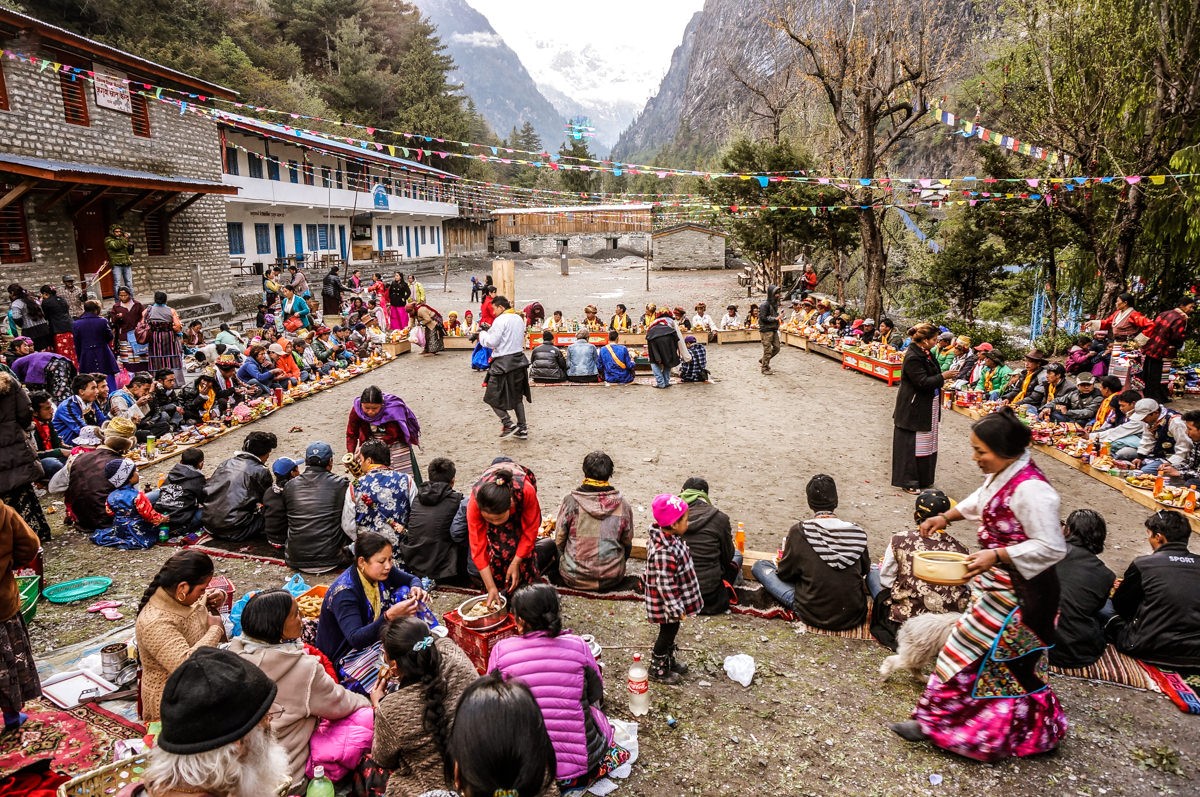
Will The Guide Carry My Stuff?
A guide will generally not be expected to carry your stuff. That’s the job of a porter, who you can hire to carry your backpack. This may seem luxurious, but it enables weaker hikers to do the trek without having to carry their a 15-20 pound pack. For photographers, it can free you up to carry just your camera in a smaller pack.
You can also get a porter guide, a 2 in 1 solution. I suspect that it’s just the tourist office telling a guide you need help carrying your pack. If you are going with this option, remember to tip your guide a bit more after the trip.
Do you want to search for a place to sleep every night?
It’s not difficult to walk into a teahouse and ask for accommodation, but it was nice to not have to think about it or worry about negotiating. We felt like our guide always made decisions in our interest and we always paid the fair price for a bed and a meal every night.
What Happens If I Get Hurt On The Annapurna Circuit?
There’s always an inherent risk in hiking. I always prefer to hike with at least one other person in case you get hurt and require assistance. Cuts and bruises are easy enough to deal with, but can you identify the symptoms of high altitude cerebral edema (HACE) or high altitude pulmonary edema (HAPE) and make the right decisions to descend or call for a helicopter evacuation? Unfortunately, altitude sickness is more common than people think and having someone experienced by your side can be useful or even life-saving.
What I Did For My Trek
Usually, I think there is something more fulfilling about tackling a challenge on your own (or with a friend). The independence of it is an intangible but significant consideration. If you prefer to have a more comfortable experience, hiring or sharing a guide won’t break the bank, but will put your mind at ease as far as not getting lost and not having to do the research to plan your own itinerary. One last thing to consider is that you will be spending the better part of 10-21 days with this person. You may enjoy the conversation and company or you may attempt a night time escape.
I met another traveler before the trek, and we decided to share a porter for many of the reasons I listed above. Back in Kathmandu, the hostel held on to a few things we didn’t need to bring on the trip. I lightened my load enough so that I could carry my camera gear in a one backpack and used the spare space for a few more items. The rest of it went into a part of the porter’s pack. My friend did the same. We all ended up hiking with a lighter pack, including the porter, who usually expects to carry a fully loaded backpack for his guest, along with his own stuff.
What To Pack For The Annapurna Circuit
A backpack is a good start. A comfortable backpack would be a better start. Then there’s the trekking shoes, the trekking sticks, the trekking socks, the trekking beanie, a trekking shirt, a warmer trekking shirt, and you get my point. You’re going on a trek. You’ll need some trekking gear. You can also do the whole thing with just a pair of shorts, a tank top, and a toothbrush but it might not be comfortable.
Thamel and Pokhara is a one stop shopping town where you can buy everything you need on the cheap (if you don’t mind buying some North Fake instead of North Face). I recommend you get your stuff before coming to Nepal. Here’s a list of essential things you should bring for the hike.
Essential Trekking Gear List
Passport Sized Photos. This is not a piece of gear, but I also travel with a few passport sized photos of myself. In Nepal, you will need to for things like buying a SIM card and getting your TIMS card that permits you to hike the Annapurna Circuit.
Trekking Shoes. Something comfortable, preferably broken in, with good grip and ankle support. The terrain will range from dirt roads to rocky snow-covered trails.
Socks. Moisture wicking socks will keep your feet dry and happy. Merino wool socks are the best balance of warmth, comfort and breathability. Personally, I prefer toe separation and these are my favorite socks . I’ve never gotten any blisters or feet damage in them. Bring as many pairs as you feel you need, but you can also air out a pair while you wear another.
Base Layer. This is arguably one of the most important layers that’s often overlooked. You want a good moisture wicking base layer that’s snug but comfortable. Even though it’s cold, you’ll still sweat while hiking and you’ll want to keep the moisture away from your body. Get a layer that doesn’t leave empty spaces against your skin where your salty sweat can deposit and dry, thereby causing uncomfortable chafing.
At the same time, it shouldn’t be too tight and restrict your movement. I prefer a base layer that doesn’t go too high up the neck, opting to protect that area with my outer layers or a buff/balaclava.
Fleece or Merino Wool Top. This is your middle layer and provides the insulation to keep the warmth generated from your body from leaving. I prefer my favorite compact fleece , but a merino wool sweater is a also good alternative that provides comfort and warmth while staying lighter than the fleece.
Down Jacket. This is my favorite layer because a good down jacket will keep me cool and warm in most weather. On slightly warmer days, I can even use this over the base layer and skip the middle layer. When it’s not raining, my favorite down jacket protects well against the wind and insulates even better than my merino wool pull-over. This one is something you replace once a decade, so something worth investing in and making the right choice up front. I personally always have two different down jackets for aesthetic and practical reasons.
My favorite is this Mountain Hardwear 800 fill goose down jacket . It is my go to all weather jacket because I can wear it in the snow and still stay cool enough in the spring and fall. It’s unbelievably light and packs into itself so it will go with me everywhere.
I also own this North Face synthetic hooded down jacket . Synthetic down has come a long way and offers much better insulation retention when it gets wet. It’s not as light, so a comparable jacket (in warmth) will be thicker and heavier than goose down. The problem with the goose down is that you can’t get it wet. As soon as it gets wet, you lose almost all the insulation very fast and it is almost useless.
Waterproof Shell with Hood. This is another item that I consider a necessary investment. After using my last one for nearly 10 years, I switched to this Marmot shell that’s breathable and keeps the water out for extended periods of rain. This was also one of the few jackets that WAS NOT boxy and overflowing, making it something I can wear in the city as well as the great outdoors.
Travel Underwear. I’ve only worn one type of underwear for the last 10 years and don’t plan on changing. The Ex-Officio ‘travel’ underwear is the best underwear for traveling. It’s super comfortable, fits very well, has anti-microbial properties, and dries on its own in like an hour after a washing. They are very durable, each pair, though more expensive than your standard Fruit of the Loom, lasts much longer. I wear the boxer briefs version , which I recommend for active guys. The streamline women’s version is here .
Thermals or Leggings. We’ve moved downtown now. Like a base layer top, you’ll want a base layer bottom. A good pair of thermals should not get sagging throughout the day or make you feel like you’re wearing two pairs of pants. Leggings are a good options for both men and women and can be worn like a second skin over the thermals to keep you lightweight but warm.
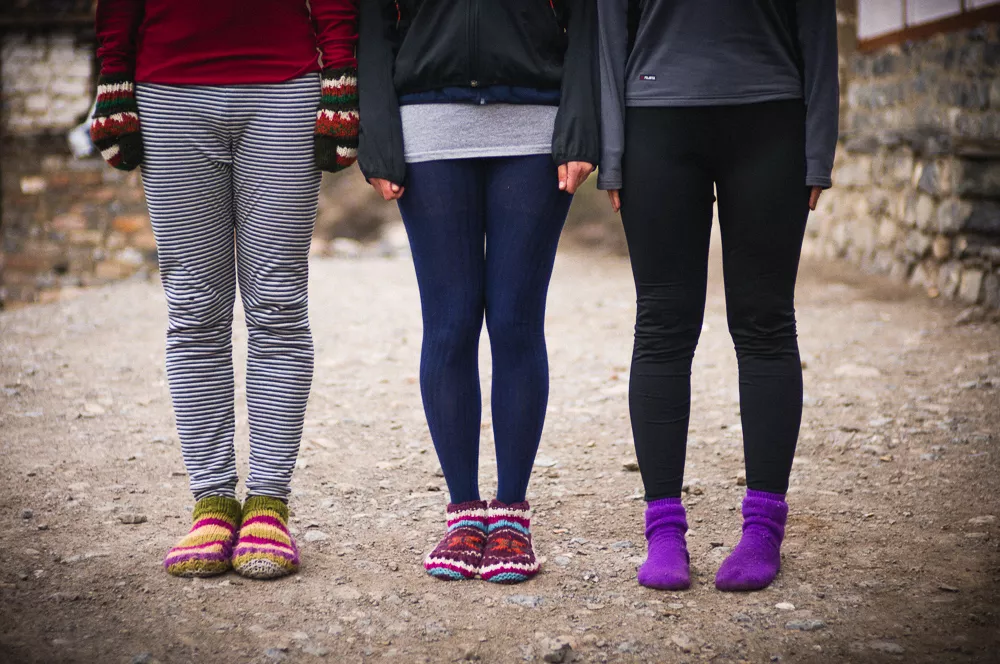
Stretchy Pants. Hiking pants or jeans, it doesn’t really matter. Just make sure it’s stretchy so you can move with the multiple layers on. I actually have a couple of nice pairs of denim from Japan that have a little stretch to them and I wear these everywhere, even rock climbing. They are form fitting and stylish, but flexible enough that I can hike in them comfortable.
Waterproof Pants. If you going during the rainy season, which I don’t recommend, remember to get waterproof pants or else the waterproof jacket is kind of pointless. A lot of people make this mistake for some reason, packing only the latter. You don’t need to get fancy here, but find a pair that is not too baggy.
Backpack. Get one with a hip belt. It’ll save your shoulders across all those miles. I suggest a a bag between 30-45L. It should carry everything with room to spare for times when you want to pack away your outer layers.
Beanie/Gloves. While it’s a myth that you lose most of your heat from your head, it’s still nice to keep that noggin of yours warm. The same goes for those fingers.
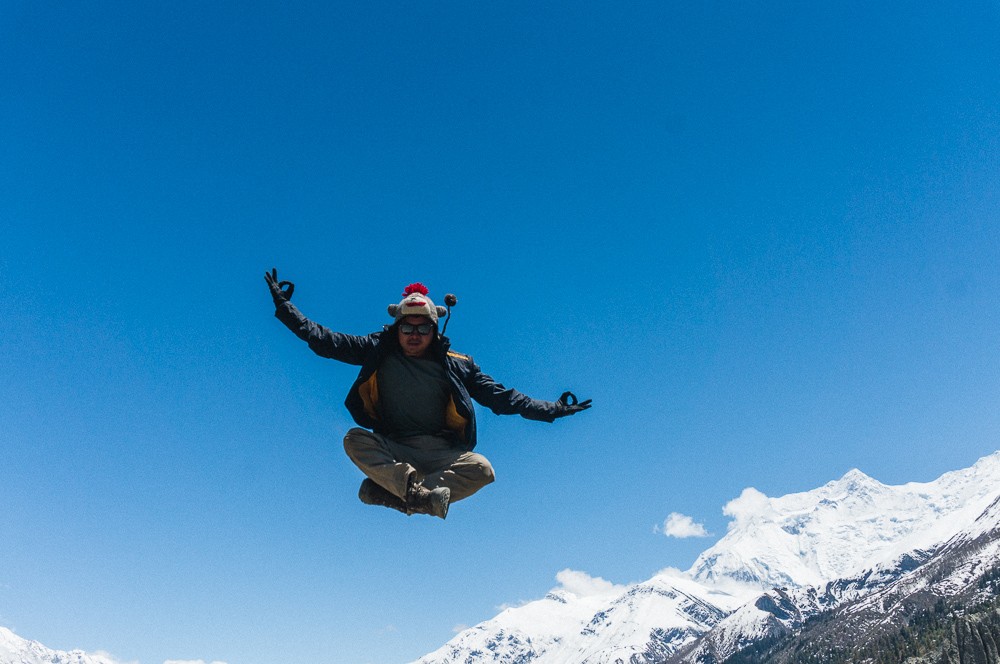
Flip Flops/Sandals. Give your feet a break at the end of the day.
Sunglasses. Protect your eyes. Remember that the snow will reflect the sunlight, which can be quite blinding during the hike to the pass.
Headlamp. Bring a headlamp and bring extra batteries. This will probably save you from spraining your ankles walking around those uneven pavement and trails at night. Or keep you from stepping into the squat toilet before, or even worse, after you take care of your business. Invest in a good waterproof headlamp with high lumens. It will always come in handy for other trips and your travels.
Snacks. There are little shops in villages selling you those Oreos and chips, but this can add up as you get closer and closer to the pass. Save that money to pay for that warm cup of tea or the Tibetan bread. Go for calorie-packed snacks with a small footprint to save space in your bag.
Other Things To Pack
Passport. You’ll obviously have this, but don’t forget to bring it on the trek. You’ll need this to check in at the security check points.
Cash. There aren’t many ATMs along the way. Pretty much all the way until you get to Jomsom. I suggest at least 1500-2000 NPR a day to cover all your accommodations and food and a bit more for those just in case moments. As in, just in case you want extra celebratory beers or you rip your pants and need to buy a new pair along the way.
Camera. Capture those special moments. I like to travel with light gear on long treks like this.
The RX-100 VII is the best all-in-one compact camera to bring as far as minimal gear. It fits in your pocket, takes incredibly high resolution photos, 4K videos and has a 24-200mm range. This means you can take wide photos, portraits, and telephotos like the one below, all in one tiny package.
If you’re a professional photographer with proper gear, I suggest you take one wide zoom, like a 16-35mm and a long telephoto that reaches 200-300mm close up of the mountains. If you want to know what I shoot with, check out what’s currently in my camera bag .
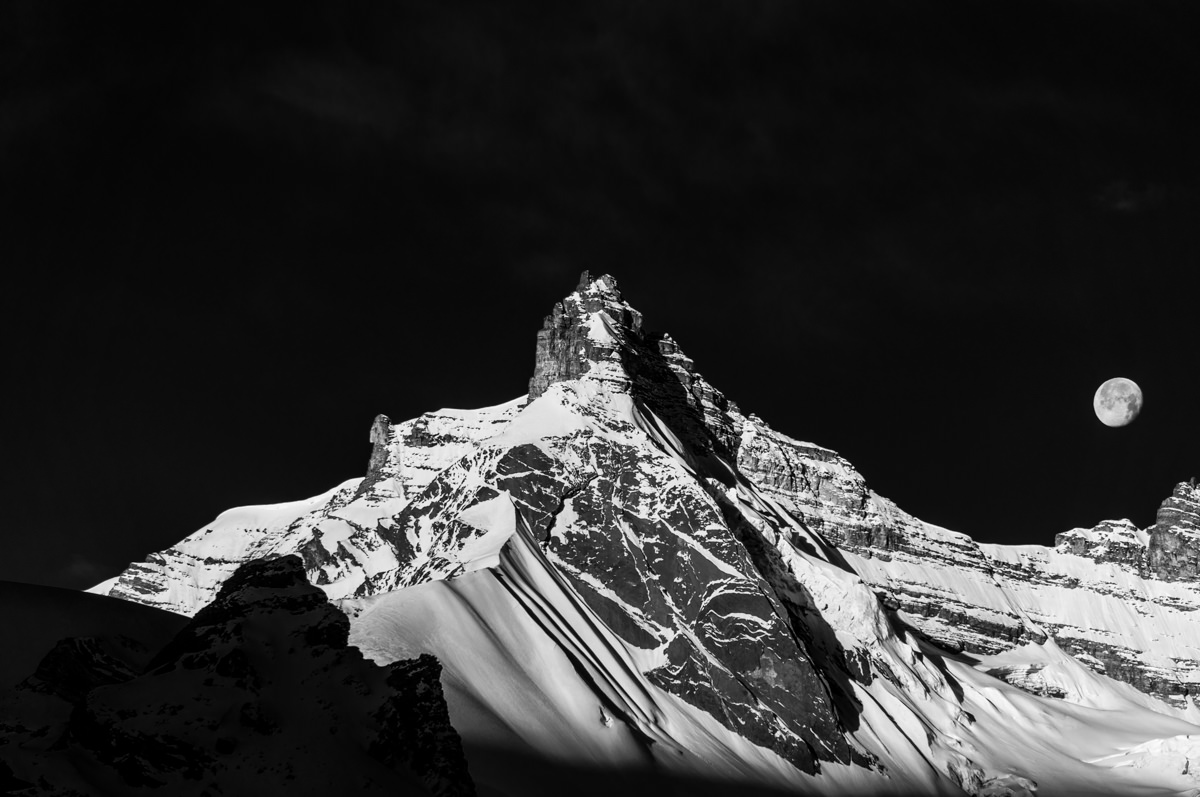
Extra Batteries/Charger. You’ll be on this circuit for quite a few days, so don’t forget the chargers. You won’t need your phone for calls, but it doesn’t hurt to keep it charged and don’t expect to be able to charge it at every teahouse. Bring a high capacity power bank with 20000 mAh.
International Adapter. Unfortunately Nepal doesn’t have a standard socket. You’ll find the two pronged and three pronged sockets seen in Europe and India, but also find North American sockets. Be prepared. This powerful and small 66W wall charger has replaced all my adapters and it comes with slim international adapters. Trust me on this.
Compass. Not exactly required, but nice to make sure you are heading in the direction you think you’re heading in.
Water Bottles/Iodine Pills/Electrolyte Tablets. You can buy water along the way. This can add up. A bottle of water can get up to around 200 rupees near the pass. If you fill up along the way, treat your water with iodine pills. There are stations with safe drinking water as well, but it’s not available at everywhere. Electrolyte tablets will help to restore some of that salt you are sweating away. It’ll also come in handy if you get some funky bowel movements and lose a lot of liquid out of that other end.
Sunscreen. Bring your sunscreen. It will cost a lot more in Nepal and you can’t be guaranteed of its quality and effectiveness. Remember to apply every morning and reapply every couple of hours. I looked like Rudolph the red-nosed reindeer by the end of my trek. This is my favorite SPF50 sunscreen .
Trekking Poles. Extra stability and support. Might save you from a stumble or two. My favorite are these super compact ones that take up no space at all in my travel bag. It’s held up well for something so small and I’ve only replaced it once in 10 years.
Alarm. A phone or watch will work. You don’t want to accidentally oversleep and miss half a day’s hike. This is especially important the of the pass crossing when you’ll want to leave early enough to get across in time.
Book. You’ll probably want to take a nap or sleep after a hard day’s hike, but a book is a great way to pass the time when you’re not sharing stories with other trekkers at dinner. I always carry my paperwhite .
Music. I loved the beautiful silence of hiking along the Annapurna Circuit, but sometimes it was nice to have a motivating song to get you through the tougher uphill climbs.
Moleskines. Not the journal. I’m talking about the little adhesive strips that will cover your blisters and keep it from being rubbed on.
Toiletries. Bring your toothbrush, toothpaste, deodorant and anything else you might need like contact lens solutions. I’m not going to tell my female readers what to bring. You know better.
Travel Insurance And Vaccinations For Nepal
Although this comes at the end of the article, it is still very important to note that I highly recommend getting travel insurance for Nepal. As beautiful as the country is, it’s still a developing country. You should always keep up to date with your routine vaccinations. Many of these might require multiple vaccination follow-ups so plan ahead of time.
There’s no vaccination requirements for Nepal, but you should keep up to date with these:
- Hepatitis A
- Hepatitis B
- Yellow Fever
- Japanese Encephalitis
- Measles (Routine)
- TDAP (Routine)
- Chickenpox (Routine)
- Shingles (Routine)
- Penumonia (Routine)
- Influenza (Routine)
- Meningitis (Routine)
As far as travel insurance goes, one thing I want to point out is that there are some travel credit cards that offer mild medical insurance coverage, it is often not comprehensive. Sure, if you lose your luggage, get stranded because your flight’s been canceled, or need to travel for home family medical emergencies, you may be covered. However, it is very rare, if not impossible, to find a travel credit card that offers medical coverage in any capacity. I personally recommend not relying on it for your medical needs.
For Nepal, I strongly advise you get proper travel insurance, especially for any hikes at altitude. High Altitude sickness affects everyone differently and can even hit you hard if you’re a healthy and fit person. In rural and hard to reach areas, you might need medical evacuations if something goes wrong. I always get travel insurance mainly for medical evacuations, because this can cost a lot of money and may not be covered by your insurance plan.
The go to travel insurance that most backpackers and traveler, including myself, swear by World Nomads. They are priced reasonably and while I haven’t had to make a claim with them, others haven’t had problems.
Last Bit Of Advice For Hiking The Annapurna Circuit
This is a once in a lifetime hike. I’m not exaggerating because most things change and the Circuit is no exception. With the construction of roads to provide better access between the villages, some of the old trails are disappearing or have disappeared. A hike that used to demand 3 weeks can now be done in a much shorter timeframe with a combination of buses, jeeps and plane rides.
While this will enable more people to enjoy the Annapurna, it also means that those who’ve hiked it 10, 20 or 50 years ago will not get to do the same hike again. The is true even for those doing the hike this year.
Take your time and enjoy it. But also take your time because it’s safer that way. Don’t ascend too fast. Listen to your body. If you are getting the symptoms of altitude sickness, descend immediately and take it from there. Turn back if you need to. It happens and while it’s disappointing, it’s better than leaving in a body bag.
Stay hydrated and try to sleep at a lower altitude than you hike to during the day. This will give your body more time to acclimate. And of course, try the Tibetan bread.
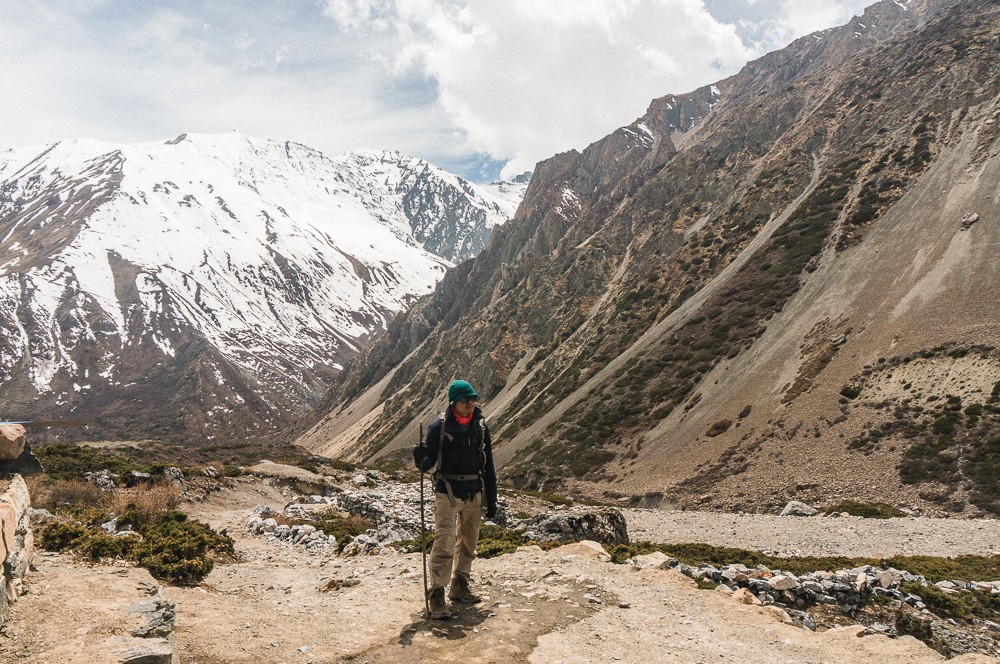
If you’re looking for more travel inspirations, scroll through some of the 450+ experiences on my bucket list . Maybe you’ll find your next adventure on there.
How You Can Help
When you make a purchase using these links, you’ll help support this site at no cost to you.
Updated on July 3, 2024
Kien is an international photographer and filmmaker based in Los Angeles. He captures his adventures on whereandwander.com and believes in living for those moments that make the best stories, told or untold. He is working through his bucket list and wants to help others do the same. Follow him on Instagram @hellokien .
KEEP ON READING

Istanbul Foodie Must Eats 2024: 16 Things To Try And Where To Eat Them
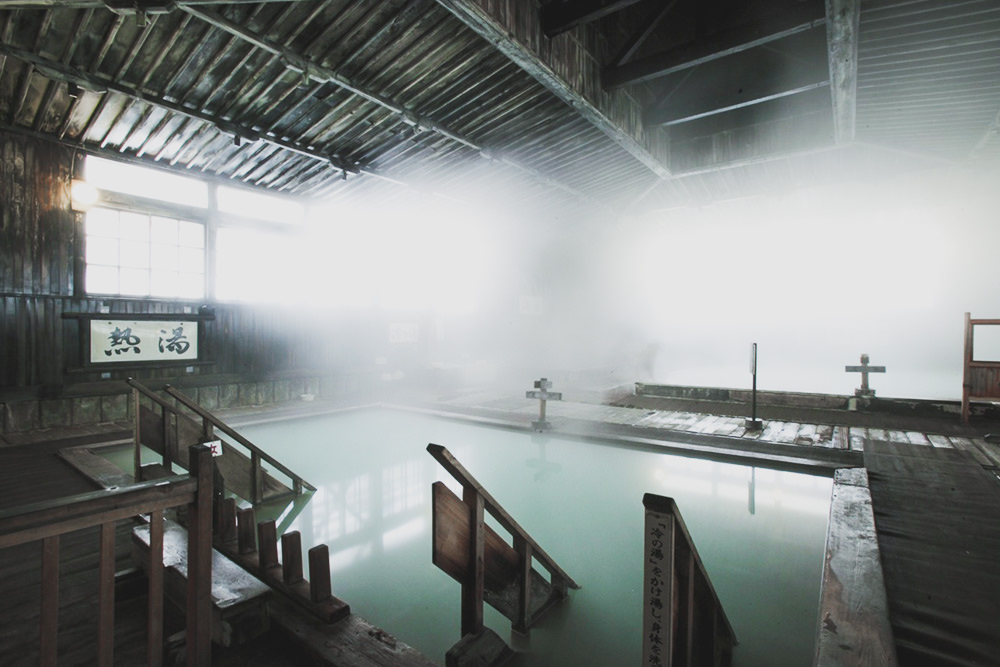
Beneath The Mist: Sukayu Onsen And The Timeless Tradition of Konyaku

The Complete Guide To Celebrating Holi In Pushkar 2025
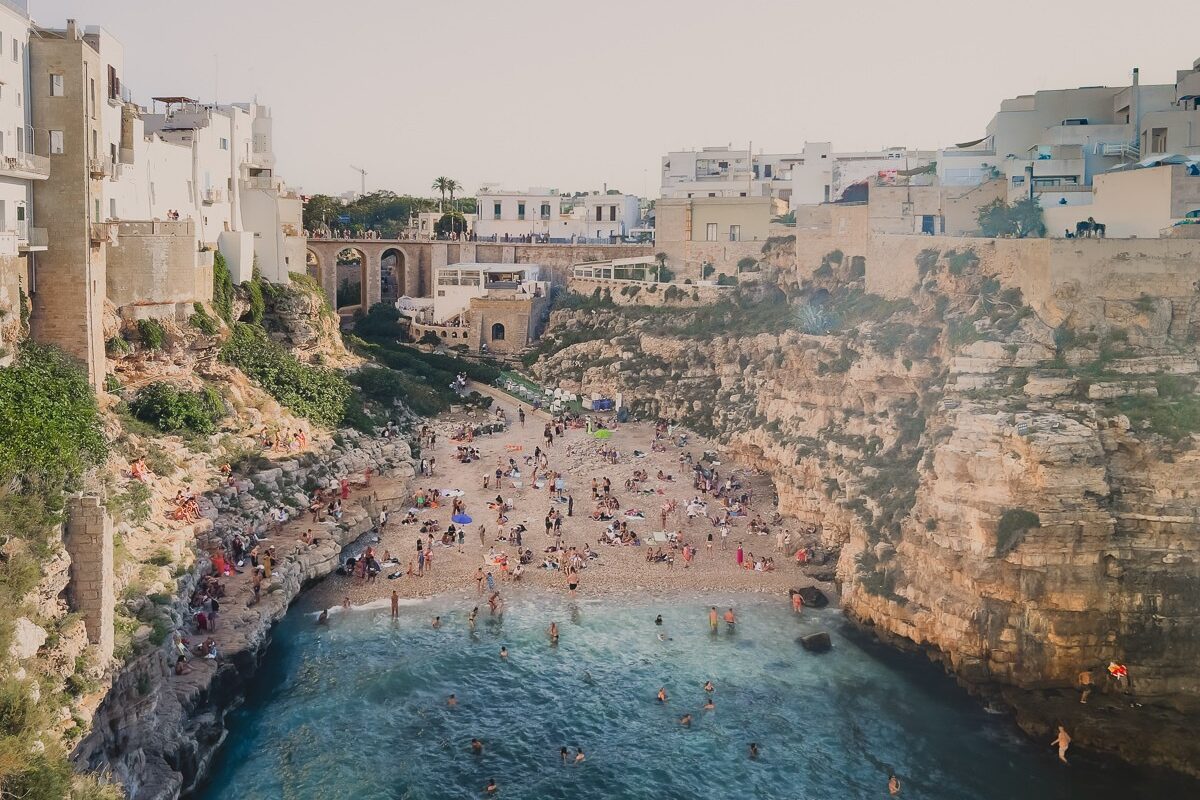
Volare! 24 Hours In Polignano A Mare: The Guide To Puglia’s Coastline Gem
[…] This is Part II of my Ultimate Guide To Hiking The Annapurna Circuit. Read Part I. […]
Very useful information, thanks a lot!
ps: Great photos!
Leave A Comment Cancel reply Your email address will not be published
Save my name, email, and website in this browser for the next time I comment.
Notify me of follow-up comments by email.
Notify me of new posts by email.

Copyright Where and Wander 2024. All Rights Reserved.
- BACKPACKERS WANDERLUST - AN AWARD WINNING TRAVEL BLOG
- Work With Me | Backpackers Wanderlust

- DISCLOSURE & PRIVACY POLICY
- United States
- Cook Islands
- New Caledonia
- New Zealand
- Accommodation Goals
- Budget And Cost Of Travel
- Foodie Goals
- Packing & Planning
- Travel Inspiration
- Volunteering Abroad
- Working & Studying Abroad
- Other Travel Tips
Nepal , Asia
Annapurna circuit itinerary: all you need to know about the best trek in nepal.
Find out about my 2 week Annapurna Circuit itinerary. Learn about everything you need to know such as permits, what to pack, accommodation, transportation to and from the trail, as well as so much more important information.
If you are planning to hike the Annapurna Circuit this hiking guide is a must-read!
One of the top treks in the world is the Annapurna Circuit in Nepal. In this guide, you will find everything you need to know from an Annapurna Circuit itinerary to what to pack and permits you may need.
Hiking through the Annapurna Himalayas you will get some of the best views and memories to last a lifetime. Though the conditions here can be intense. This is certainly a hike you need to prepare for otherwise you could find yourself in grave danger.
Luckily, if you are reading this you must be on the right page. So, let’s get into it a little further and find out the best Annapurna Circuit Itinerary, my experience and everything else you need and will want to know. Here is the link to a helpful PDF guide which I highly recommended downloading offline for use while trekking the Annapurna Circuit:
Annapurna Circuit Itinerary: Important Hiking Information
- Annapurna Circuit Permits
Should You Do A Guided Tour
- Accommodation on the Annapurna Circuit
- Food on the Annapurna Circuit
- Annapurna Circuit Packing Tips
- Shopping for Hiking Gear in Kathmandu

Permits and Regulations
Before you even think about starting the Annapurna Circuit you are first going to need to correct permits. This includes the TIMS card and ACAP.
The TIMS card stands for the trekker’s information management systems and costs 2000 NRs per person. You can purchase one at the TIMS Counter at the Tourist Service Center in Bhrikutimandap, Kathmandu . They are open from 10 am to 5 pm, 7 days a week.
The ACAP stands for the Annapurna Conservation Area Permit. This allows you to enter the Annapurna Area and will need to be shown at many of the checkpoints along the trail. It costs 3000 NRs per person and can be collected at the same place as your TIMS card.

Taking a guided trek of the Annapurna Circuit is also a popular thing to do. When hiking you will find both travelers doing it themselves, whereas others have hired a guide.
The positive of booking a guided tour is that they will arrange everything for you. This can save a lot of hassle especially when it comes to organizing permits. They will also be able to sort out accommodation, and transportation, and of course safely guide you around the circuit.
You will definitely want to make sure you research and book with a reputable company, as this can truly make or break your experience. Make sure you check out reviews and what other travelers have to say about their experience. You will find a variety of companies out there, though a popular local tour agency with positive reviews is Nepal Hiking Team who offer an all inclusive Annapurna Circuit guided trek package for under $1300.00
Accommodation On The Annapurna Circuit
When you are in the middle of nowhere, in the middle of your Annapurna Circuit itinerary you would probably expect cold rooms, no electricity, and no running water.
Though, honestly, the quality of accommodation on the Annapurna Circuit is thoroughly impressive. Especially at higher elevations where you know, someone would have had to carry each piece of furniture up these difficult paths.
In all, honestly, one of the worse places we stayed on the trail was our first guesthouse in Bahunbunda. With no outlets in rooms, basic amenities, pay to use WiFi and no hot water I only thought the rooms must get worse from there as we are still fairly close to civilization.
Though, I was pleasantly surprised the following day when we arrived at our guesthouse to find power in the room, free WiFi and a free hot shower. It was the best welcome ever after a long day of trekking.
The rooms on the trail are basic, though as long as there is a semi-comfortable bed that is all you will really need. The majority of your time will be spent in the common room at the guesthouse and if it is cold they should light a fire.
It is about a 50/50 bet whether you will have an attached bathroom to the room, though these might cost an extra fee. Not once did we come across a heater in the room so make sure to bring some warm nontrekking clothes to sleep in.
The majority of nights on the trail we spent at free guesthouses. We trekked in May which is considered the shoulder season.
So, if you are going trekking in the high season you may need up paying a small fee for the room. It really all depends on supply and demand.

Food On The Annapurna Circuit
Now do not expect to come across any restaurants on the Annapurna Circuit . Though you will find plenty of homely guesthouses with lovely locals more than happy to serve you.
Whether you are wanting to stop in for lunch or just a simple cup of tea, they break up a busy day of hiking perfectly.
At these guesthouses, you will find a mixture of Nepali and Western Cuisine. Just don’t expect it to taste like home or something like a meal from a big city cafe.
You will find plenty of chow mein served on menus as well as my breakfast favorite, Tibetan bread. There are also items like pizza, pasta, and hamburgers, but don’t expect great things from them.
No doubt the number one food item when trekking the Annapurna Circuit is dal baht. The slogan ’24 24-hour power’ is commonly associated with the meal and it is always consumed by the porters to give them plenty of energy.
So, it is a plate with an assortment of lentil curry, rice, curried potatoes, and pickled vegetables. Also, the best thing about this dish is that there are free top-ups on your plate. The guesthouse owner will keep coming over and topping up your plate until you request no more.
You are expected to eat dinner and breakfast at the guesthouse which you stay at. However, if you decide not to, you will likely be requested to pay more for the night.
At the majority of guesthouses, we only ever paid for dinner and breakfast, not for the accommodation itself. This is how the locals make their money and if the menu looks a bit ‘pricey’, remember that you are sleeping there for free!

Packing Tips For The Annapurna Circuit
I was greatly unsure whether or not to purchase hiking boots or do it in my sneakers. Though after speaking with Shona she said the sneakers would be fine and I trusted her advice. The terrain there is not overly difficult.
Although you will want something you can comfortably wear all day. Just be aware of snow levels as you do not want to be walking around in nonwaterproof shoes in ankle deep snow. Surprisingly, one guy on our trek was 55+ years of age and was doing it in a pair of sandals.
We had no problem not bringing with us a pillow or sleeping bag. There were always plenty available at guesthouses which was perfect for us. Though I am unsure what it would be like during the busier trekker months.
I purchased a sleeping bag liner, though I never used it on the Annapurna Circuit. Considering I am used to hostel dorm beds I did not find the teahouse rooms unclean and never had an issue jumping straight into bed.
There are many things that people told us to pack for the Annapurna Circuit which we ultimately did not need. Luckily, if you are arriving in Nepal to do the Annapurna Circuit and have absolutely no trekking gear, don’t worry.
We were in this position and from online recommendations headed straight to Shona’s Alpine.
Shopping In Kathmandu
There was no warm welcome, it is just straight business here. Though, the team there was able to kit us out with all the necessary trekking gear, including missing out on sales by truthfully telling us what we don’t need. My major tips which I will pass on to you are:
- You do not need a puffer jacket unless you are trekking in one of the colder months. If you are to get it wet, either from the rain or snow, they become incredibly heavy and very hard to dry. Instead, we purchased a windbreaker jacket and a fleece jumper.
- Buy woolen socks instead of cotton. They do not hold onto smells as much so you can hang them up overnight to wear the next morning.
- Buy a decent, heatproof water bottle. Usually, I am the kind of person to recycle the same disposable drink bottle for months at a time. Though, spending $12 on a drink bottle in one of the world cheapest countries was one of the smartest decisions. It became a hot water bottle on freezing nights and provided relief to sore muscles.
- If you are thinking of buying some suitable shoes for the trek make sure you have time to wear them in, as you won’t be able to do anything when you are so far away from civilization and covered in blisters. Make sure to test them out and find some good beginner hiking boots if this is your first time buying some.
Also if you are a plus-size lady or gentleman I highly recommend purchasing clothing in your home country. It can be incredibly difficult to source larger-sized clothing in Asia countries.
Even in Nepal where it is a Western trekkers shopping paradise. All in all, we had no issues with the quality of the clothing we purchased and it held up extremely well throughout the Annapurna Circuit.

Annapurna Circuit Itinerary For 2 Weeks Trekking
- Pokhara to Bahundanda: Day One
- Bahundanda to Tal: Day Two
- Tal to Timang: Day Three
- Timang to Chame: Day Four
- Chame to Upper Pisang: Day Five
- Upper Pisang to Ngawal: Day Six
- Ngawal to Manang: Day Seven
- Manang Rest Day: Day Eight
- Manang to Yak Kharka: Day Nine
- Yak Kharka to Thorong Phedi: Day Ten
- Thorong Phedi to Muktinath: Day Eleven
- Muktinath to Jomsom: Day Twelve
- Jomsom to Pokhara: Day Thirteen
Day One On The Annapurna Circuit Itinerary:Pokhara To Bahundanda
Pokhara (1400m) to Besishar (820m) – 5 hour bus journey
Besisahar (820m) to Bhulbhule (840m) – 1 hour bus journey
Bhulbhule (840m) to Ngadi (890m) – 4 km hike which took 1 hour
Ngadi (890 m) to Bahundanda (1310m): 4 km hike which took 2 and a half hours
The start of the Annapurna Circuit is Besieshar and you will need to get yourself there. From the popular tourist hangouts of Kathmandu and Pokhara, there are daily departures to Besisahar. These bus tickets are able to be booked through the majority of accommodation providers or at tourism agencies in the town.
Starting from Pokhara
If you are starting from Pokhara the bus departs from the tourist bus station, just a short walk out of the main lakeside town area. They call it the tourist bus, though it is not.
There will be plenty of locals packed with you like sardines in a can. My recommendation is to try and get a seat toward the back of the bus to avoid the majority of the commotion.
Starting from Kathmandu
Infamous for its traffic, be prepared to get stuck in Kathmandu for a while after boarding the bus. The advertised trip is just 6 hours from Kathmandu, though it is more notoriously claimed to last between 8-12 hours.
Many people mention that taking the microbus is the better option to travel between Kathmandu to Besissaar. You can find them at Gongabu Bus Park, though best to check with your accommodation to confirm this as things here like to change without warning.
Besisahar to Bahundanda
Once arriving in Besisahar you have the choice to either take another local bus or start your trek. With wide muddy roads, we decided to take the local bus from Besisahar to Bhulebhule.
This cost us just $1.30 / 200NRs. It was an extremely bumpy ride squished into the tight seats.
Starting our official Annapurna Circuit Itinerary in Bhubulehule is where we decided to get off and walk. Though, you can continue further up the trail to the village of Ngadi.
The walk between these two towns is extremely easy flat terrain. So, if you are thinking of getting off the bus and walking, just do it. The 4 kilometers between Bhubhule and Ngadi only take us an hour to hike past many local houses and some construction sites.
From Ngadi to Bahundanda is where you truly get your first taste of just some of the serene views on the Annapurna Circuit. With small local thatched houses, green rice terraces, and a slower pace of life, this is where it first hit me how far away we really are.
Life is simpler here as we hike past various Nepali women working in the fields. There is a steady uphill portion between Ngadi and Bahundanda which you should be aware of when planning your Annapurna Circuit itinerary. It slows us down a bit with the 4-hour hike taking 2 and a half hours.
The majority of guesthouses we saw in Bahundanda were extremely basic. They offered pay-to-use Wifi, no electricity in the room, and no hot water.
This was one of the few occasions on the circuit where we came across such simple accommodation. Though, if it is a clear day there are some amazing views from the teahouses to the Annapurna Himalayas in the far distance.

Day Two: Bahundanda to Tal
Bahundanda (1310 m) to Ghermu (1130m): 5 km hike which took 2 and a half hours
Ghermu (1130 m) to Jagat (1300m): 3 km hike which took 2 hours
Jagat (1300m) to Chamche (1385m): 4 km hike which takes 1 hour
Chamche (1385m m) to Tal (1700m): 5 km hike which took 4 and a half hours
Day two is certainly one of the harder days for me in this Annapurna Circuit Itinerary. This was the first and only day it rained on the trail. Luckily it was not a complete downpour.
Heading off in the morning from Bahundada to Ghermu the rain makes the paths a slippery mess. We try not to fall while maneuvering between stone trails and mud puddles. This is also where we come across the first bridge of many on the Annapurna Circuit.
It is a very easy walk to the nearby village of Syange where the track merges with the road. Trucks, jeeps, and vans make their way past, bringing resources further up the trail as well as trekkers who have paid to start higher up the circuit.
This is a relatively steep portion of the trail, rising nearly 200 meters in just 3 kilometers. However, being on the road rather than rocky paths makes it a whole lot easier to navigate and easier on the legs.
The kilometer trek from Jagat to Chamche is an extremely easy walk with barely any incline. We reach the village by following the road with plenty of energy remaining. Though, from Chamche to Tal is where the day begins to go wrong.
The journey from Chamche to Tal is certainly the most difficult of day two. We managed to follow the wrong paths multiple times, leading to backtracking multiple times. Though, apart from that, there is also the large rockslide that has covered the side of one hill. The path zigzags through the rockslide, making one last massive push to complete the day.
We enjoyed staying in the village of Tal. It is hidden deep in the valley floor with an impressive waterfall as a backdrop.

Day Three: Tal to Timang
Tal (1700 m) to Dharapani (1900m): 6 km hike which takes 2 and a half hours Dharapani (1900m) to Bagarchap (2160m): 2 km hike which takes 1 hour Bagarchap (2160m) to Danaqyu (2200m): 2 km hike which takes 1 hour
Danaqyu (2200m m) to Timang (2710m): 4 km hike which takes 2 and a half hours
To get back on the trail from Tal you have two options. The first is to navigate an extremely steep path up to the road and the second is to follow the river around on the right side. I recommend following the river around and enjoying being off the road as you will be spending the majority on it.
At the village of Karte, there is a large suspension bridge that will take you back to the road. From there it is an easy walk to Dharapani. This section is relatively easy when compared with the rest of today.
The trek from Dharapani to Bagarchap is easy with no overly impressive sights. The same goes for the walk from Bagarchap to Danaqyu. We just appreciate the scenery, the waterfalls, and the local goats.
The portion from Danaqyu to Timang is certainly the most difficult of day three. With a 500-meter incline over 4 kilometers, I only recommend doing this if you still have plenty of energy and it is still early in the afternoon.
The steep ascend zigzags around, over steeps created by wobbly river stones. There are minimal flat portions and you will need to take a breather as you make your way to Timang.
Timang was my favorite village on the Annapurna Circuit. There are impressive views over the Himalayas, rolling clouds, and friendly locals. I highly recommend planning your Annapurna Circuit itinerary to spend one night here.

Day Four On The Annapurna Circuit Itinerary: Timang To Chame
Timang (2710 m) to Thanchowk (2570m): 4 km hike which takes 1 and a half hours Thanchowk (2570m) to Koto (2640m): 3 km hike which takes 1 hour
Koto (2640m) to Chame (2710m): 2 km hike which takes half an hour
This is one of the easiest days on the trail. Just a 7-kilometer hike over 3 hours. Chame is actually the headquarters of the Manang district so if you need supplies this is the place to be.
There are many different shops here catering to trekkers you can pick up everything from the important snickers bars to gloves, hats, or ankle/knee braces.
Heading off from Timang to Thanchowk the trail continues on the road. It drops over 100 meters which makes a nice change from the steep uphill the previous day. Through paddocks, past locals, and happy livestock, it is a pretty uneventful portion of the trail.
The same goes from Thanchowk to Koto as the green fields continue on. Though portions of the road alternate from dry dirt to unstable rocks. This is another easy portion of the trail that you can do in a speedy time.
Koto is only a mere 2 kilometers from Chame and takes no time to complete. I recommend spending your afternoon exploring this interesting town. There are various types of teahouses here, from the most basic to luxury hotel quality.
If you are looking for a nice place to recuperate you will certainly find something here. Many guidebooks also speak about a local hot spring but do not bother. This is the most where locals do all their laundry so it is dirty and constantly busy.

Day Five: Chame To Upper Pisang
Chame (2710 m) to Bhratang (2850m): 7 km hike which takes 2 hours Bhratang (2850m) to Dhukur Pokhari (3240m): 6 km hike which takes 2 hours Dhukur Pokhari (3240m) to Upper Pisang (3310 m): 1.5 km hike which takes 1 and a half hours
If you do decide to take a jeep up a portion of the Annapurna Circuit, make sure you get off at or before Chame. The views between Chame to Upper Pisang are some of the best in this Annapurna Circuit Itinerary.
Heading off in Chame towards the apple village of Bhartang we come across many road workers. The views are impressive with snow-capped mountains, rushing rivers, and pine tree landscapes.
It is an obvious arrival in Bhratang with apple trees growing everywhere surrounded by large fences with signs warning to keep out. This small, bustling village is a popular stop to pick up a delicious apple pie before continuing on your way.
After Bhatrang you will quickly come across one of the most photographed portions of the trail, a part of the road which has been carved into the mountainside. With a straight drop into the river below it is one of the most unique roads I have seen.
From there it is another short walk when you will come across the impressive Swarga Dwari. This bowl-like mountainside has been shaped by the wind to become what it is today, a gateway to heaven.
The path then cuts through the zig-zag of the road up a fairly steep hillside, from there it is a simple walk down to Dhukur Pokhari.
It is a relatively easy walk between Dhukur Pokhari and Upper Pisang through neat grass fields until the high route begins. The small path leads up the righthand side of the valley to Upper Pisang.

Day Six On The Annapurna Circuit Itinerary: Upper Pisang to Ngawal
Upper Pisang (3310m) to Ghyaru (3730m): 5 km hike which takes 3 hours Ghyaru (3730m) to Ngawal (3680 m): 5 km hike which takes 3 hours
It is an easy walk from Upper Pisang until you reach the bottom of the hill where Ghyaru is situated upon. This hill is one of the harder sections os the trail as it zigzags back on itself as you slowly climb your way up the 300 meters.
It took us over an hour to climb this small section alone. At the top, you will get some impressive views of the nearby snowy mountains and low valley floor.
Ngawal might be lower in altitude than Ghyaru, though you will still need to ascend a bit further until you descend back again. The small mountainside trail is a nice change from the road and it is not overly difficult as you climb another 500 meters.
If you are suffering from altitude sickness symptoms like I was this can be quite testing.

Day Seven: Ngawal To Manang
Ngawal (3680m) to Humde (3330m): 2 km hike which takes 1 and a half hours Humde (3330m) to Braka (3450m): 6 km hike which takes 3 hours Braka (3450m) to Manang (3540m): 2 km hike which takes half an hours
From Ngawal it is a steep descent back onto the valley floor. This is where the high trail meets back up with the lower trail and the Annapurna Circuit hikers merge back again in Humde. It is a short hike, though best to take it easy as it can be tough on the knees.
From Humde to Braka it is a relatively easy walk over 3 hours. We keep to the road and dodge the occasional jeeps and motorbikes which whizz past every so often. The same is which Braka to Manang. It is a simple hike following the road alongside the river.
Manang is a popular town where you should have a rest day with the other trekkers. There are plenty of teahouses, ranging in quality, bakeries, movie cinemas, and shops.
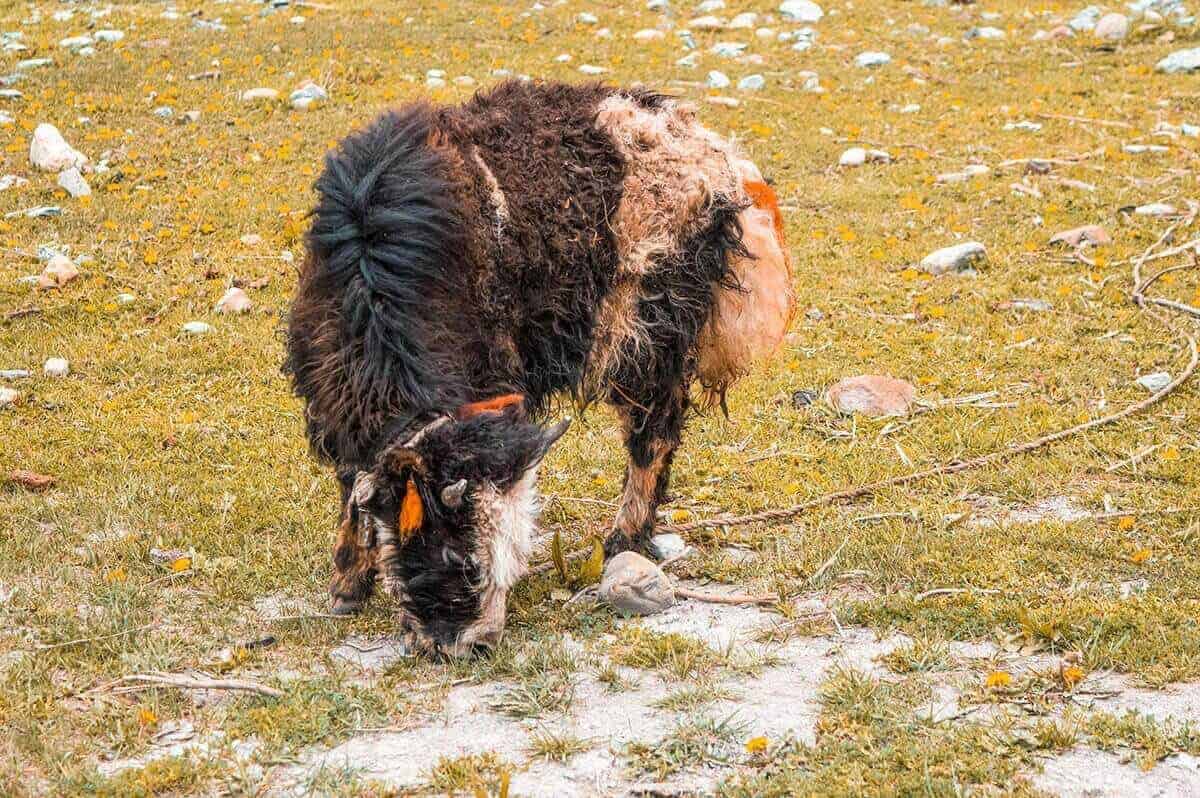
Day Eight: Manang Rest Day
You should spend your one day once you reach Manag in the Annapurna Circuit Itinerary as a rest day. You should spend a couple of nights here to adjust to the altitude, ultimately assisting your body to adjust to the higher altitudes to come.
If you have plenty of energy you can do the side trek to the Ice Lake which is a steep full-day trek.
Day Nine: Manang to Yak Kharka
Manang (3540m) to Gunsang (3900m): 3 km hike which takes 2 hours
Gunsang (3900m) to Yak Kharka (4050m): 7 km hike which takes 3 hours
It may only be a short 3-kilometer hike to Gunsang, but with an elevation increase of over 300 meters, it is not easy. The road ends and now we are on a small path. Prepare for traffic jams of horses and yaks.
Turning a corner the village of Gunsang can be seen in the distance. A large valley provides amazing panoramic views across on our left to the nearby mountain ranges.
Heading out of Gunsang the hike to Yak Kharka is a lot easier than the first portion of today. It may be longer, but it has a steady, barely noticeable incline of 150 meters over 7 kilometers.
There are plenty of swing bridges to cross over and the terrain has now turned completely barren. Just small shrubs cover the ground at this altitude.

Day Ten: Yak Kharka To Thorong Phedi Base Camp
Yak Kharka (4050m) to Churi Ledar (4200m): 1 km hike which takes half an hour Churi Ledar (4200m) to Thorong Phedi (4450m): 5 km hike which takes 3 and a half hours
This portion of the trail is an extremely easy gradual uphill. Though, thanks to the altitude it is still necessary to take a breather every 10 minutes or so. The 150-meter climb over half an hour into Churi Ledar is barely noticeable, maybe these amazing views are taking our mind off it all.
Out of Churi Ledar, there is a large suspension bridge taking us over the river to the other side of the valley then up a steep ascent. The climb is treacherous and the small rocks prevent getting a decent grip.
For each step forward it feels like taking two steps back as you begin to slide back down the mountain. The difficult trails carved into the side of a mountain are not the easiest to navigate, though it is just a quick 15-minute walk to the next portion of the path.
This is one of the most dangerous spots we will come across today and certainly one of the more dangerous parts of the trail.
This landslide zone has caused numerous injuries and at least one death throughout the years. You need to be careful that the path does not slip out below you, as well as watch out for falling rocks.
After about 20 minutes the landslide area finally ends and we arrive straight into the lodges at Thorong Phedi.
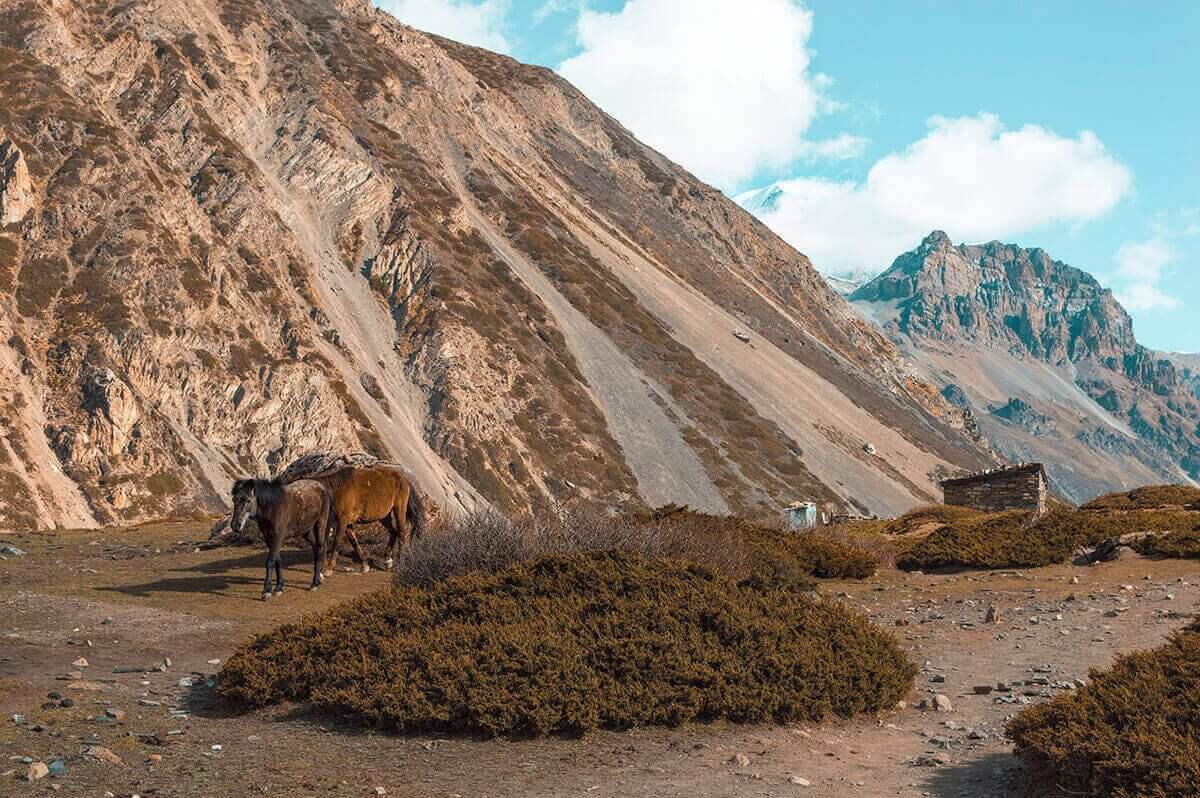
Day Eleven On The Annapurna Circuit Itinerary: Thorong Phedi Base Camp To Muktinath
Thorong Phedi (4450m) to High Camp (4850m): 1 km hike which takes 2 hours High Camp (4850m) to Thorong La Pass (5416m): 5 km hike which takes 4 hours Thorong La Pass (5416m) to Charabu (4230m): 6 km hike which takes 6 hours Charabu (4230m) to Muktinath (3800m): 4 km hike which takes 3 hours
Walking up out of Thorong Phedi to High Camp it is obvious to see how steep of a climb this is just going to be. Ascending about 400 meters in a kilometer is not going to make for an easy climb at all. The ascent is steep as we zig-zag back and forth on the extremely thin path covered in rocks.
Heading up away from High Camp I am feeling a lot better today than I was yesterday morning. The trail ascends gently behind our lodges until they are completely out of view, blocked by the endless rocky mountains.
We zigzag endlessly follow the trail while dealing with the overwhelming feeling of momentary excitement due to the numerous false passes. This goes on for what feels like hours while mountain sickness slowly starts to come over.
At 5416 meters the oxygen levels here are less than half of what they are at sea level.
From our descent from Thorong La Pass, the first hour and a half is a steady descent. The land is barren, just hundreds of rocks making up the ground. We zigzag slowly down the mountain. It is a difficult descent as you try to avoid slipping on the loose rocks.
We watch as the small village of Charabu gets closer and closer. The first portion of the trail is rather steep, but then it flattens out into fields. Coming across a herd of yak nearby a suspension bridge we spot the first signs of Muktinath.
It is a rather large, sprawling village, though, unfortunately for us, the lodges are quite far through it.
We follow the path up and down to the village of Muktinath. Walking through temple areas we watch those worshippings make their way past us on horseback. Muktinath has been an important place for pilgrims over the past 3000 years.

Day Twelve On The Annapurna Circuit Itinerary: Muktinath To Jomsom
Muktinath (3680m) to Jomsom (3330m): 23-kilometer bus ride which takes 1 hour
The bus is just packing on the crowds as we arrive at the bus station which is literally just a shed with a couple of buses waiting out front. James purchases us two tickets and I jump on board.
There are about 10 other trekkers already sitting in the seats. I guess we get charged premium prices to secure a seat. However, the locals and pilgrims must pay less on a first in first-in-first-serve basis.
The middle of the bus is packed with backpacks all stacked on top of each other as the driver tries to fit everyone in.
The seats in local buses here are extremely close together and the bags in the middle prevent them from being able to stretch out fully. Unfortunately, it is not the most comfortable ride. Luckily, the views are great as we pass by the villages of Kagbeni and Eklebhatti.
Thankfully we see the village of Jomsom in the distance. It stretches out quite far, full of flat-roofed two-story buildings. In the far end is where we stay and where you will find the majority of teahouses.

Day Thirteen: Flying from Jomsom To Pokhara
Jomsom (2720m) to Pokhara (1400m): 160 km flight which takes half an hour
In Jomsom, we decided flying back to Pokhara would be the best decision for us. Unfortunately, we were both unwell, and taking a bus down would have been horrific in the vomiting state we were in.
The plane tickets cost $100.00 each which was certainly the most expensive part of the Annapurna Circuit. However, being on one of the small planes, taking off from a crazy short runway, and experiencing the whole airport which is run by the military was certainly a highlight.
Also, you cannot beat the views from that plane.
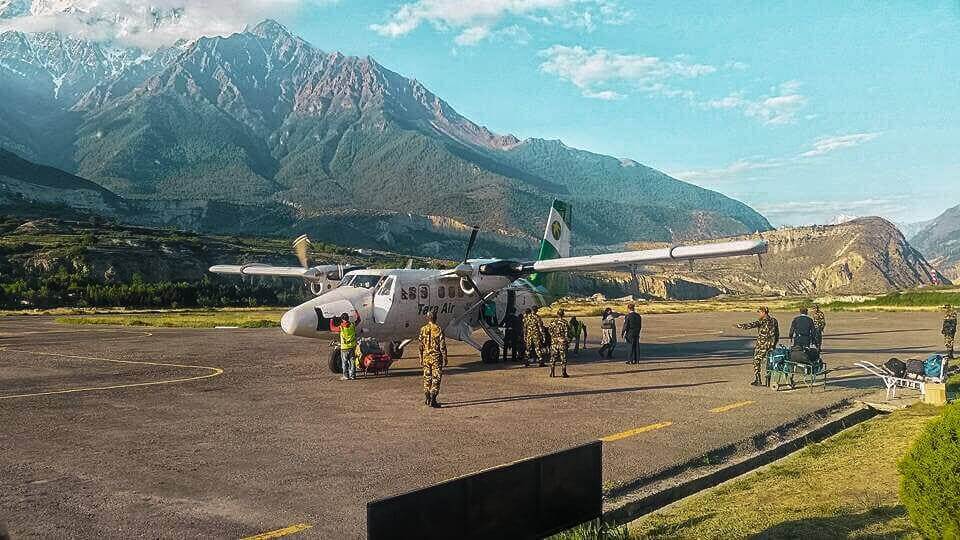
Continuing On The Annapurna Circuit
Perhaps you do not want to fly to Pokhara from Jomsom you can continue trekking the Annapurna Circuit via hiking and taking buses all the way back to Pokhara.
If you have plenty of free time you could perhaps even do the Annapurna Base Camp trek or Poon Hill Trek .
LIKE IT? PIN IT!

Want more Annapurna Circuit Inspiration? Check out….
- POKHARA TO BESISAHAR & BAHUNDANDA- STARTING THE ANNAPURNA CIRCUIT- DAY ONE
- BAHUNDANDA TO TAL ON THE ANNAPURNA CIRCUIT- DAY TWO
- TAL TO TIMANG ON THE ANNAPURNA CIRCUIT- DAY THREE
- TIMANG TO CHAME ON THE ANNAPURNA CIRCUIT- DAY FOUR
- CHAME TO UPPER PISANG ON THE ANNAPURNA CIRCUIT – DAY FIVE
- UPPER PISANG TO NGAWAL ON THE ANNAPURNA CIRCUIT- DAY SIX
- NGAWAL TO MANANG ON THE ANNAPURNA CIRCUIT- DAY SEVEN
- MANANG REST DAY ON THE ANNAPURNA CIRCUIT- DAY EIGHT
- MANANG TO YAK KHARKA ON THE ANNAPURNA CIRCUIT- DAY NINE
- YAK KHARKA TO THORONG PHEDI (BASE CAMP) ON THE ANNAPURNA CIRCUIT- DAY TEN
- THORONG PHEDI TO HIGH CAMP ON THE ANNAPURNA CIRCUIT- DAY ELEVEN
- HIGH CAMP TO MUKTINATH VIA THORONG LA PASS ON THE ANNAPURNA CIRCUIT – DAY TWELVE
- MUKTINATH TO JOMSOM ON THE ANNAPURNA CIRCUIT- DAY THIRTEEN
- FLYING JOMSOM TO POKHARA AND FINISHING THE ANNAPURNA CIRCUIT- DAY FOURTEEN
Disclaimer: This post contains affiliate links. So, if you click on it and purchase something, I get a small percentage at no extra cost to you. As always all opinions are my own and your support is much appreciated.
Tasha Amy is a true backpacker at heart and has been discovering the world on a budget since 2015. Based in Gisborne, New Zealand she will spend many months each year traveling overseas as a solo female traveler before coming home and sharing her adventures online with you.
17 thoughts on “ Annapurna Circuit Itinerary: All You Need To Know About The Best Trek In Nepal ”
Thank you so much for sharing the informative article as well as the beauty of Nepal. after reading this article people can easily travel to Nepal.
Great, thank you for your update its really useful .
Great post of Annapurna
Such an informative article.
Great blog post
Great article about the Annapurna circuit trek… love it…
such informative articles about Annapurna Circuit Trek love to see more articles in future
The pictures look surreal. And the itinerary you’ve shared is so detailed! I hope I get to do this sometime soon. Thanks for sharing.
Great article, and complete with all the information you need. I have done the ABC and I am planning to go back to Nepal do climb Mt. Mera in 2020.
Thanks for the detailed itinerary. We are hoping to do this in the next couple of years and this has made me more determined.
You have me extra excited for Nepal! Cannot wait for trekking!
We loved trekking to EBC and were really wishing we could stay in Nepal longer to do ABC. Your photos are seriously inspiring us to get back there!
I went to Nepal years ago but didn’t do any trekking as it wasn’t the right season. I love mountains and I really hope to do that some day. thank you for a very inspiring and comprehensive guide!
This looked amazing! Nepal is so high on my bucket list + I can’t wait to make it out there! (:
You certainly need to! Its an amazing place
Leave a Reply Cancel reply
Your email address will not be published. Required fields are marked *
- Annapurna Base Camp Trekking Join now
- Everest Base Camp Trek Join now
- Everest Base Camp via Gokyo Lake & Cho La Pass Join now

Everest Base Camp Trek
- Everest Three High Passes Trek
Gokyo Lake Trek
- Pikey Peak Trek
- Everest Base Camp via Gokyo Lake & Cho La Pass
- Everest View Trek
- Annapurna Base Camp Trekking
Annapurna Circuit Trekking
- Ghorepani Ghandruk Trekking
- Mardi Himal Trekking
- Nar Phu Valley Trek
- Khopra Ridge Trek
- Upper Mustang Trekking
- Annapurna Base Camp via Ghandruk Trek
- Annapurna Short Trek
- Tilicho Lake Trekking
- Langtang Valley Trekking
- Gosaikunda Trekking
- Helambu Trekking
Manaslu Circuit Trek
- Tsum Valley Manaslu Trekking
- Chisapani Nagarkot Trekking
- Kathmandu Valley 4 N / 5 Days Tour
- Nagarkot Tour
- Kathmandu, Chitwan, Lumbini and Pokhara Tour
- Kathmandu Valley Day Tour
- Mera Peak Climbing
- Island Peak Climbing
- Lobuche Peak Climbing
- Lobuche Peak Climbing with Everest Base Camp
- Island Peak Climbing with Everest Base Camp
- Who We Are?
- Legal Documents
- Terms and Conditions
- Privacy Policy
- Why With Us
- Fixed Departure
- Tours and Travel
- Travel Insurance
- Booking Help
Entrust us with your tailor-made adventure Trips!
Let us know your travel wishes by answering the questions below. One of our specialists will contact you within 48 hours to refine your request and create with you a tailor-made adventure that reflects your image.
Number of Travellers?
Do you have an idea of starting period, duration, budget.
- I have my exact travel dates
- I have approximate dates
- I don’t have my dates yet
Whom should we send the quote to?

Annapurna Circuit is one of the most famous trekking trails in the world. Since it opened to foreign trekkers in 1977, the Annapurna Circuit Trek has become renowned as one of the most spectacular trekking routes in the world with lush green valleys and fascinating villages that offer impressive snow-capped views of the Annapurna Himalayan Range.
Annapurna Circuit Trek is one of the most popular longest trekking trails in Nepal. The Annapurna Trekking Trail was opened to foreign trekkers in 1977. Annapurna Circuit Trek is the only trek in this region, It touches the top of Thorong La (5,416 m).
Since then, travelers from all over the world have attracted people to the trail. The Annapurna Circuit trek takes you through the world’s seventh and tenth-highest peaks, Annapurna and Dhaulagiri.
Annapurna Circuit Trek has become renowned as one of the most spectacular trekking routes in the world with lush green valleys and fascinating villages that offer impressive snow-capped views of the Annapurna Massif including Annapurna I, Annapurna South, Gangapurna, and Annapurna III, Lamjung Himal, world 8th highest Mt. Manaslu, Pisang peak, Chulu East, Chulu West and the massive range of world’s 7th highest peak.
Annapurna Circuit Trek Information
Starting from less than 1000 meters, it gives us a chance to explore the Himalayas from bottom to top. These 15 days Annapurna Circuit Trek starts from Syange and goes along the Marshyangdi River. It gives scenic views of Manaslu and Himal Chuli to the east.
The trekkers are then led to a lovely village populated by a diverse range of people from various ethical groups. The scenery in the north of the main Himalayan range is equally breathtaking. Annapurna Circuit Trek in Nepal also provided learning about the Tibetan way of life
Annapurna Circuit Trek is the most famous trekking circuit in Nepal. The highest point of this 15-day Annapurna Circuit trek is the Thorong-La Pass at the top of the valley at 5,416 m, which is the major highlight of this 21-day trek. The Annapurna circuit trek walks in a counter-clockwise direction due to the difficulties of crossing the pass.
The trail descends to the west at Muktinath , and we pass the barren Tibetan-like village of Kali Gandaki. It passes between the giant Annapurna and Dhaulagiri mountains. After you cross the Thorong-La Pass from Manang to Muktinath, we head to Marpha and descend to Pokhara. Trekking trails are beautiful and memorable, trekkers will be there in the experience of Annapurna Circuit Trek.
When is the best time to book Annapurna Circuit Trek?
The Best Time for Annapurna Circuit Trek is the months of March to May, Pre-monsoon, and Post-monsoon. This is the suggestion before doing the Annapurna circuit trek of these months. Trekking must be challenging and even risky in the months of winter of December to February, Which are harsh and snowy, and the months of the summer June to August which are humid and wet. These are required and careful consideration of the Annapurna Circuit Trek during time.
How difficult is the Annapurna Circuit trek?
The Annapurna Circuit Trek is difficult. You will be walking on rugged and uphill and downhill terrain for the during of the adventure. You will walk for 5 to 6 hours a day on average so, it the best to be fit in physical shape and get ready for the Annapurna Circuit Trek.
What thing makes the Annapurna Circuit Trek Special?
The Annapurna Circuit Trek is a unique and well-liked choice for trekkers for many reasons, The Annapurna Circuit Trek is highly prevalent in the Mustang valleys and learn about the Tibetan life cycle. Yak Kharka gives a slim chance of spotting blue sheep and snow leopards. The Annapurna Circuit trek to accommodate various schedules and tastes. There are different routes available to the trekker.
Overall, The Annapurna Circuit Trek is a unique experience for all trekkers and over the globe. Its unique combinations of physical hardship, cultural depth, and stunning landscape.
Note: The hotel is a 2-3 star hotel that may adapt to meet the needs of the visitors. Furthermore, we can update and modify the itinerary which is a fundamental framework of a trek on demand .
Traveller Details
Flight details, other information.
- I understand / agree the terms and conditions.
- Trip Starts: Kathmandu
- Trip Grade: Strenuous
- Transportation: Road
- Trip Duration: 21 Days
- Trip Activity: Trekking, Adventure
- Trekking Guide: Available (Male)
- Group Size: 2 - 20 pax
- Fixed Departures: Available
- Min Age: 12 years or above
- Security: 100% Guaranteed!
- Customized Trip Route: Available
- Best Season: Basanta Ritu (Spring),Sharad Ritu (Autumn)
Annapurna Circuit Trekking Itinerary
Day 01 : arrival at tribhuvan international airport.
When you land at Tribhuvan International Airport in Kathmandu, our airport representative will be there to welcome you. You can easily spot them as they’ll be holding an Adventure White Himalaya signboard outside the airport terminal. From there, you’ll be taken to your hotel in our private tourist vehicle for Annapurna Circuit Trek.
Tonight, you’ll stay in Kathmandu, ready to start on your adventure! The guide will provide information about the Annapurna circuit trek itinerary.
Day 02 : Travel to Syange via Besisahar
Today, we’ll start by taking a public bus from Kathmandu to Besisahar. From Besisahar, we’ll continue our journey of Annapurna Circuit Trek to Syange in a jeep. The drive will take about 8 hours, during which we’ll enjoy the scenic views of landscapes, rivers, and waterfalls.
Tonight, we’ll rest in Syange, getting ready for the trekking adventure ahead. we all are too excited about Annapurna Circuit Trek.
Day 03 : Trek from Syange to Dharapani
Today, our trek spans 6-7 hours from Syange to Dharapani. The trail takes us on a descent alongside the Marsyangdi River, crossing a suspension bridge and then climbing towards Sattale (1,550 m). Afterward, there’s a steep path leading to Tal, known for its valley views and waterfalls.
Continuing on this trail of Annapurna Circuit Trek, we enter the Manang district, passing through the village of Khotro (1,860 m). The path winds down through an Alpine forest, crossing a long suspension bridge to reach the small villages of Karte (1,900 m) and Nache. Finally, our journey for the day concludes in Dharapani, a junction for Manaslu and villages in the Manang valley.
Tonight, we’ll stay at a local teahouse in Dharapani, resting up for more adventures on our destination of Annapurna Circuit Trek time.
Day 04 : Trek from Dharapani to Chame
Our Annapurna Circuit Trek route takes us from Dharapani to Chame, a journey of 5-6 hours. We start with a challenging path through forested ridges, offering captivating views of the surrounding mountains as we head up the valley. Along the way, we pass through Bagarchhap with its apple orchards and crop fields, and then through waterfalls and pine forests as we ascend to Tyanja, Kyupar, and finally to Chame.
The trail rewards us with spectacular views of Lamjung Himal, Annapurna II, and Annapurna IV (7,525 m). Chame is an active geothermal region, and you can relax in the healing waters of the hot springs.
Tonight, we’ll stay at a local teahouse in Chame, getting ready for more exploration on our adventure of Annapurna Circuit Trek.
Day 05 : Trek from Chame to Upper Pisang
On the sixth day, we continue our trek to Upper Pisang after having breakfast. The journey takes about 6 hours. As we walk, we pass through dense forests, follow the Marsyangdi River, and enjoy breathtaking panoramic views of meadows and mountains. Along the way, we’ll catch our first glimpse of the impressive Paungda Dada rock face, shaped like a bowl.
After the 6-hour walk, we’ll arrive at Upper Pisang. From here, you can see the majestic Annapurna II towering in the south. This is where we’ll rest for the day.
Tonight, we’ll stay at a local teahouse in Upper Pisang, surrounded by the beauty of the Himalayas. Get ready for more trekking adventures tomorrow! We all are ready for the next Annapurna Circuit Trek route.
Day 06 : Trek from Upper Pisang to Manang
On the seventh day, we keep walking through big hills, jungles, and wetlands. Along the way, enjoy the beautiful landscapes, pass by stupas, and even come across a lama school. After about 5 hours of walking, we’ll reach Manang, a lively and significant stop on our trek. Annapurna Circuit trek is one of the largest settlements along in Manang.
Tonight, we’ll stay at a local teahouse in Manang, surrounded by the serene atmosphere of the mountains. Rest up, as more exciting trekking experiences await us tomorrow!
Day 07 : Rest Day in Manang Village
Today is a rest day in Manang, As per our Annapurna Circuit Trek Itinerary, today is our acculturation day. where we take it easy and let our bodies acclimatize to the altitude. We’ll do some short walks and explore the village, visit a monastery, and make our way to Gangapurna Glacier Lake. In the evening, we return to our accommodation for a good night’s rest. As we follow
Tonight, we’ll stay at a local teahouse in Manang, preparing for the next leg of our trek.
Day 08 : Trek from Manang to Yak Kharka
Following our rest day in Manang, we’re energized and ready for the next part of our journey. Today, we trek for about 5 hours to reach Yak Kharka, ascending by 500 meters. The climb is gradual as we pass through Tenki Manang, leaving behind the Marsyangdi Valley. Continuing along the Jarsang Khola Valley, we eventually reach Yak Kharka at an elevation of 4,000 meters. Here, the landscape changes, and we begin to see fewer yaks and vegetation.
Tonight, we’ll stay at a local teahouse in Yak Kharka, surrounded by the tranquility of the high-altitude environment. Rest well for more trekking adventures tomorrow!
Day 09 : Trek from Yak Kharka to Thorong Phedi
Today’s trek takes us from Yak Kharka to Thorong Phedi, lasting about 5 hours. After a two-hour ascent, the trail descends to cross the river at 4,310 meters. Following that, we climb up to Thorong Phedi at an elevation of 4,450 meters. In recent years, guesthouses have been built here to accommodate trekkers like us.
Tonight, we’ll stay at a local teahouse in Thorong Phedi, getting ready for the challenging but rewarding day ahead. Rest up and enjoy the mountain atmosphere! during Annapurna Circuit Trek time.
Day 10 : Trek from Thorong Phedi to Muktinath
Our Annapurna Circuit Trek Route will descend down to Muktinath we have taken a few pictures of the scenery. Today is a long trek, and we start early, around 4 am, to reach the Thorung-La Pass by 9-10 am. It’s crucial to start early to avoid strong winds that can affect the journey, especially at the Thorong-La Pass. The climb is steep, but the regular route is easy to follow. However, altitude and snow can present challenges. Heavy snow can make crossing the pass difficult. After about four hours of climbing, marked by chortens and prayer flags, we’ll be treated to stunning views from the top.
The next four hours of walking will take us to the sacred town of Muktinath. Muktinath, meaning the place of nirvana, is home to the Muktinath Temple and several monasteries. It is considered a sacred pilgrimage site for both Hindus and Buddhists. The temple is dedicated to Lord Vishnu and features 108 waterspouts around it. Another nearby attraction is the Jwala Mai Temple, which has a beautiful natural spring and an eternal flame fueled by natural gas.
Tonight, we’ll stay at a hotel in Muktinath, taking in the spiritual atmosphere of this significant pilgrimage site. Rest well after a challenging day! This experience gains all about from Annapurna Circuit Trek.
Day 11 : Trek from Muktinath to Jomsom
After the spiritual experience at Muktinath, a renowned pilgrimage site for both Hindus and Buddhists, we embark on a 5-hour drive to Jomsom. Muktinath is situated in the Muktinath Valley at the base of the Thorong La Pass, featuring a Gompa and the temple of Lord Vishnu. The site is known for an everlasting flame fueled by natural gas. Additionally, the view of the mountains from Muktinath is truly breathtaking.
As we journey to Jomsom, as per our Annapurna circuit trek itinerary enjoy the splendid view of Dhaulagiri. Tonight, we’ll stay in Jomsom, resting after the day’s drive on another site there are many difficulties suffering from Annapurna Circuit Trek time
Day 12 : Drive to Pokhara
Leaving Jomsom, we embark on a 7-hour drive back to Pokhara, the city of lakes. In Pokhara, you can indulge in various enjoyable activities. Take a boat ride across the lake, explore the World Peace Stupa, try rafting or kayaking, experience an ultra-light flight, rent a motorcycle or a bicycle, or simply savor a meal along Pokhara’s lakeside while admiring its beauty.
Tonight, we’ll stay in Pokhara, making the most of the city’s diverse attractions and serene surroundings.
Day 13 : Drive Back to Kathmandu
Last day of our Annapurna Circuit Trek itinerary In the morning, we will take a 7-hour drive back to Kathmandu on a tourist bus.
If you’re up for extending your adventure of Annapurna Circuit Trek, there are plenty of options available, such as a Chitwan jungle safari, river rafting adventure, Kathmandu shopping tour, mountain biking, and various other activities.
Tonight, we’ll stay overnight in Kathmandu, concluding our journey.
Day 14 : Final Departure
As your remarkable journey of Annapurna Circuit Trek comes to an end, today marks the day of your final departure. Our team will ensure you are transferred to Tribhuvan International Airport in Kathmandu for your onward flight.
Reflecting on the incredible experiences, diverse landscapes, and cultural wonders you’ve encountered during your adventure of Annapurna Circuit Trek, we hope this journey has left you with lasting memories and a deep appreciation for the beauty of Nepal.
If the allure of Nepal beckons you to return or if you are eager to explore other destinations, our team is ready to assist you in planning your next adventure. Whether it’s the majestic Himalayas, the wildlife of Chitwan, or the vibrant streets of Kathmandu, Nepal has much more to offer. It was a great experience from during Annapurna Circuit Trek time.
Safe travels, and until we meet again!
Annapurna Circuit Trekking Cost & Date 2024 & 2025
Interested in a customized trek just for you? We create private, guided adventures that match your preferences and interests perfectly. To get started, please fill out the form below.
Annapurna Circuit Trekking Includes/Exclude
Cost include.
- Airport pick up (Company Name Plate) & drop off service by private tourist vehicle.
- 3 Night Hotel in Kathmandu and one night Hotel in Pokhara.
- All your standard Meals during the lodge to lodge during the trek (Breakfasts,Lunches and Dinners), each meal one hot drinks.
- All trekking and climbing related permit & fees, (Entry Permit Annapurna conservation fees).
- TIMS (Trekking Information Management System).
- Adventure White Himalaya Treks duffel bag/kit bag and T-shirt.
- Nepal Government license on holder English speaking trekking guide.
- The required number of local staff and porters to carry your luggage during the trek (We assign one porter for every two guests below 25 kg.).
- All our government taxes, vat, tourist service charges.
- Official expenses Insurance for guide and porters.
- Salary for guide and porters.
- All information about trekking, tour and expeditions.
- Kathmandu to Besisahar, Besisahar to Syange Local Bus and Pokhara to Kathmandu Tourist Bus.
- A Comprehensive Medical Kit.
- Certificate of achievement.
Cost Exclude
- International air fare your home Country to Nepal.
- Nepal Entry Visa fees.
- Insurance which covers, medical, emergency evacuation, lost, theft expenses.
- Meals while not on the trek.
- Personal Porter Personal expenses such as snacks, all drink, Wi-Fi, hot shower, gear, laundry, phone calls, etc.
- Personal gear and expenses.
- Tips for the guide and porter.
- Domestic Air fare.
- Personal trekking Equipment.
- Extra night Accommodation in Kathmandu because of early arrival, late departure, and early return from the mountaion (deuto any reason) then the scheduled itinerary.
- Travel insurance: Travel Insurance covers emergency Rescue and Evacuation. (you can buy it in your country you can’t buy it in Nepal)
- Nepal entry visa: You can obtain a visa easily upon your arrival at Tribhuvan International Airport in Kathmandu.
- Tourist Visa with Multiple entries for 30 days: This VISA can be obtained by paying US $ 40 or equivalent foreign currency.
- Tourist Visa with Multiple entries for 90 days: This VISA can be obtained by paying US $ 100. Please bring 2 copies of passport size photos).
Hint: Tips for the guide and porter (tips are not compulsory but this is your satisfaction with them if you are really happy with them service of them you can give as respect as tips). This itinerary is just a guideline. If you are not able you can customize your own.
Annapurna Circuit Trekking Information
Travel details, equipment and gears, formalities and health, the country, responsible tourism.
Physical Level and Preparation
The demanding trip to the Annapurna Circuit trek requires adequate physical preparation. Because the walk involves walking for extended periods and climbing to high altitudes, it needs a moderate to high level of fitness after successfully completing the Annapurna Circuit Trek.
Preparation Tips for Annapurna Circuit Trek
- Cardiovascular Fitness : Regular aerobic exercises that increase endurance include cycling, jogging, and trekking.
- Strength Training : For challenging terrain, bolster your upper body, core, and legs.
- Altitude Acclimatization : To prevent altitude sickness, consider rest days in your plan for acclimatization.
- Mental Preparedness: It’s a mental as well as a physical trip, so mentally prepare yourself for the hardships.
Groups of two to twenty persons are usually led by a professional guide and accompanied by local personnel during the Annapurna Circuit Trek. The small group size promotes camaraderie and unique experiences.
Accommodation
Simple teahouses to luxurious hotels are available for lodging during the Annapurna Circuit Trek trail, depending on your preferences and what’s available along the way. Here is a list of popular places to stay:
- Teahouses: These are straightforward, family-run lodges that offer a bed, simple food, and a cozy setting .
- Lodges: Along the hike, there are settlements with lodges that offer extra facilities like attached restrooms and hot showers.
- Tented Camps: Tented camps are another option for lodging in distant regions; these provide a more daring experience.
Annapurna Circuit Trek, it is important to pack light. Bring only a small daypack with the essentials (water, snacks, layers, camera), as your main gear will be carried between lodges by a porter or yak.
Spirit of Travel
Achieving the top is not as crucial as enjoying the experience and the journey during the Annapurna Circuit trek. Along the way, you will experience Sherpa culture, be in awe of the stunning scenery, and make lifelong friendships with fellow hikers. The beauty and persistence of the natural environment never cease to astound and inspire you on this experience that pushes your physical boundaries and uplifts your spirit.
Season of Annapurna Circuit Trek, distance traveled, services selected, and guide availability all affect the price.
Guided Trek: usually includes a guide, lodging, food, and permissions. It ranges in price from $1,000 to $1,500.
Independent Trek : For between $700 to $1,200, cost-conscious hikers can complete the trail without permits and equipment.
Peak vs. Off-Season: Trekking is more affordable in off-peak seasons (winter, monsoon), but it offers better weather in peak seasons (spring, fall).
Cancellation Fees:
Before beginning the Annapurna Circuit Trek, it’s crucial to be aware of any potential cancellation fees in case your plans change. Before booking a reservation, it’s critical to read and understand the tour operator’s cancellation policy because different operators may have different fees. In general, the closer your departure date is, the higher the cancellation fees may be. Consider purchasing cancellation coverage when purchasing travel insurance to reduce potential losses.
Tips for Annapurna Circuit Trek
- Pack Light : You can avoid paying porter costs by packing lightly. Bring only clothing and necessities.
- Local Currency: For modest purchases along the trail, bringing small quantities of Nepalese Rupees is advised. There are ATMs in larger towns like Pokhara.
- Split Costs: To cut down on individual spending, if you’re traveling in a group, think about splitting the cost of lodging, food, and guides.
What Justifies Getting Insurance?
Insurance is a requirement while embarking on an adventure of Annapurna Circuit Trek, such as a climb to the Annapurna Circuit Trek. Even while it could appear like an extra cost, the comfort and security it provides are priceless. The following are strong arguments for thinking about getting insurance for your hike:
- Emergency Medical Coverage: There are risks associated with trekking to high elevations, such as altitude sickness and injuries, such as being at the Annapurna Base Camp trek. Emergency medical costs are covered by travel insurance, including, if needed, helicopter evacuation.
- Lost or Stolen Property: Personal property can be stolen or lost anywhere, including when hiking. The expense of replacing misplaced or stolen goods, such as equipment, electronics, or passports, may be covered by insurance.
- Emergency Evacuation: You might need to be flown by helicopter to a medical center in the event of a serious illness or injury. Although these evacuations can be expensive, travel insurance frequently pays for them.
- Search and Rescue: Insurance may be able to assist with the costs associated with conducting a search and rescue operation in certain, uncommon circumstances.
Annapurna Circuit Trek is an exciting adventure that passes through many environments with unpredictable weather. Having the appropriate equipment is crucial to ensuring your enjoyment, safety, and comfort during the Annapurna Circuit Trek trip. The following is a complete list of the tools you’ll need:
Small Personal Equipment
- Backpack: A cozy, well-fitting backpack (30–40 liters) to hold water, snacks, additional clothing, and personal goods, among other everyday necessities.
- Trekking Boots: Well-made, waterproof, cozy boots that provide supportive ankles.
- Hiking Socks: Warm, moisture-wicking socks that keep your feet dry and blister-free.
- Headlamp: For usage at night and in lodges with low lighting, a headlamp with additional batteries. This is all the necessary equipment for the Annapurna Circuit Trek.
Personal Pharmacy
- Prescription Drugs: Please include a copy of your prescription for any prescription drugs you may require.
- Painkillers: Over-the-counter analgesics such as acetaminophen or ibuprofen.
- Antibiotics: Wide-spectrum drugs to treat common ailments.
- Medication to prevent diarrhea: Imodium or a comparable drug.
- First Aid Kit: Contains tweezers, gauze pads, adhesive tape, and antiseptic wipes.
- Personal Prescriptions: Any other prescription drugs you may need.
Annapurna Circuit Trek Gear and Clothing
- Base Layers: Breathable, moisture-wicking base layers for insulation and control of moisture.
- Insulation: For lower temperatures, a cozy fleece or down jacket.
- Outer Layer: A windproof, waterproof jacket with a hood to ward off the weather.
- Trekking Pants: Versatile trekking pants with zip-off legs that are lightweight and quick to dry.
- Gloves: For cold weather, mittens or gloves with insulation.
- Hat: For protection from the heat, wear a sun hat or a thick beanie in chilly weather.
Validity of Passport: Verify that your passport is valid.
Nepal visa: Most visitors to Nepal must have a current visa in order to enter the nation. At other border crossings or the Tribhuvan International Airport in Kathmandu, you can obtain a visa. The consulate or embassy of Nepal in your residence country can provide you with the most up-to-date information as visa rules and costs are subject to change.
Medications
- Altitude Sickness Medications: Consult a healthcare provider about taking drugs like acetazolamide, or Diamox, to prevent or cure altitude sickness. It’s critical to talk about the right dosage and any possible adverse effects.
- Personal Prescriptions: Make sure you always have a sufficient amount of prescription medications on hand, as well as a copy of the prescription.
- First Aid Kit : Carry a basic first aid kit at all times, complete with bandages, sterile wipes, painkillers, and any prescription drugs you might require.
- Water Purification : Bring tablets or portable water filtration equipment to ensure you have safe drinking water during the Annapurna Circuit Trek walk.
Annapurna Circuit Trek offers you the opportunity to experience Nepal’s magnificent scenery. Nepal is well known for its gracious people, rich cultural legacy, and stunning Himalayan peaks. This country guide includes information about legislation, customs, ecology, animals, safety precautions, and other pertinent topics for your hike:
Usages & Customs
Honor Local Culture: Nepal is a multicultural country where Hindu and Buddhist traditions coexist. It’s important to honor local customs, which include wearing modestly and removing your shoes before entering buildings such as residences or temples.
Namaste: In Nepal, it’s usual to greet someone with a polite “Namaste” and a small bow. Acquire a few fundamental phrases in Nepali to improve your communication with people there.
Regarding Your Strolls:
Teahouse Lodging: Throughout the hike, some teahouses provide food and lodging. It is customary to place food orders at your lodging because these businesses depend on the business of hikers.
Fauna and Flora
Biodiversity: The Annapurna region is home to a diverse diversity of wildlife, including Himalayan tahr, red pandas, snow leopards, Musk deer, Himalayan monals, and several bird species. When embarking on a journey, it is imperative to show respect for the local fauna and habitat.
Environmental Situation:
Leave No Trace: Reduce your influence on the environment by adhering to the principles of Leave No Trace. This includes eliminating single-use plastics and properly disposing of rubbish.
Local Initiatives: To improve the sustainability of the area, and support neighborhood environmental and conservation efforts.
Minimize Our Carbon Footprint
Hikers are advised to use reusable water bottles and to avoid single-use plastics.
We advocate for hiking with as little fuel as possible and staying at energy-efficient accommodations.
We recommend taking public transit whenever possible as an environmentally responsible mode of transportation.
Preserve Wildlife:
We strongly emphasize the conservation of wildlife and forbid disturbing or endangering it while on the walk.
Our contribution to local conservation efforts keeps the biodiversity of the area intact.
The Commandments of Responsible Travel:
Before the trip
Respect and Research: Find out as much as you can about the local environment, traditions, and culture. Recognize and honor regional customs as a sign of respect for the culture.
Pick Ethical Operators: Make sure that the hotels, tour companies, and other services you choose are firmly committed to sustainable tourism and ethical travel.
Pack With Thought: Pack light and only carry what you need. Avoid using single-use plastics and throwaway things to reduce waste..
During the Annapurna Circuit Trek trip
Respect local culture: Ask for permission before taking photos, dress modestly, and strike up a courteous conversation with the locals when you visit places of worship or cultural significance..
Reduce, Reuse, Recycle : To cut down on waste, use reusable items and recycle as much as you can. Place trash in the proper container.
Energy and Resource Conservation : When not in use, turn off the lights, heaters, and air conditioners to conserve resources. Take shorter showers and use less water.
After the trip
Exchange Knowledge: To encourage moral travel behavior, impart to others your understanding of and experiences with responsible travel.
Think and Learn: Consider how you can travel more responsibly in the future after your experience.
Positive and constructive criticism regarding tour operators’ and lodgings’ efforts at responsible tourism should be directed towards them.
Extend your Trip...
Why not stay a little longer, and make your trip even more unforgettable, by choosing one of our extensions.
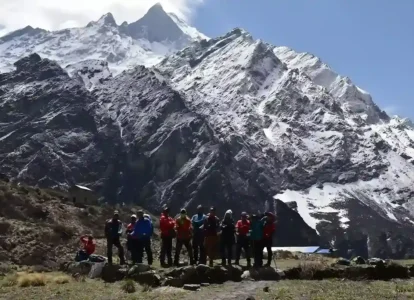
Annapurna Circuit Trekking Reviews
Annapurna circuit trek with adventure white himalaya treks: greatest experience.
Adventure White Himalaya Trek in one word is superb ! Upfront communication with Ganesh was very efficient and the trek went very well. Mr Ganesh receive me at the airport took me safe at the hotel at midnight. The day next we started the trek, our guide Bhoj Raj was a star. He was trustworthy, reliable and always smiling with a great sense of humors. They all were excellent and was perfect in organizing any sort of tour in a perfect way. I can wholeheartedly recommend them, the Adventure White Himalaya Treks. Thank you !
“Visit Annapurna circuit Nepal ”
Professional Tour services , Our Annapurna circuit,Throng -La Pass trek was super awesome which is organizing by Adventure White Himalaya Treks Pvt. Ltd.(best Trekking in Nepal). All the team members are Excellent. Friendly and Helpful; were very encouraging and professional for the whole trip. We really enjoy our Annapurna circuit trip with them. Highly recommended services!!
Add a Review
Trip advisor, you might fall for this too....
Trips popular with our customers, in the same area and with the same activity!


Kathmandu: 15 Days Annapurna Circuit Trek
The Annapurna Circuit Trek is a renowned multi-day hike that takes adventurers through the breathtaking Himalayan landscape of Nepal. Starting in the vibrant capital of Kathmandu, trekkers embark on a 15-day journey that promises awe-inspiring vistas, culture in charming mountain villages, and the exhilarating challenge of crossing the Thorong La Pass . With comfortable accommodations, delectable Nepali cuisine, and expert guidance, this trek offers a unique blend of adventure and cultural exploration. But what makes this trek truly unforgettable goes beyond the physical challenge – it’s the chance to connect with the captivating spirit of Nepal that will leave a lasting impression.
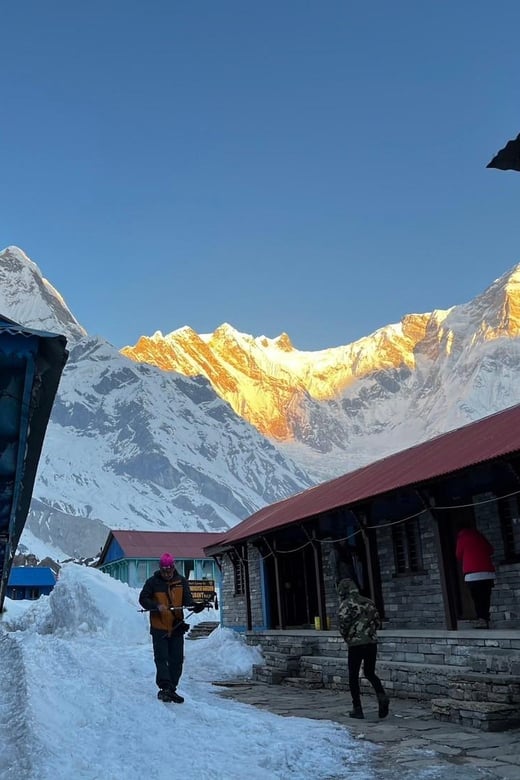
- 15-day Annapurna Circuit Trek starting from Kathmandu, offering an immersive experience in Nepal’s Himalayan landscapes.
- Trek covers the famous Thorong La Pass at an elevation exceeding 17,000 feet.
- Explore vibrant Kathmandu, picturesque villages, and engage with the rich cultural heritage of Nepal.
- Comfortable accommodations in family-run teahouses and local cuisine like dal bhat and apple pie.
- Comprehensive support from a reliable trekking company, including permits, expert guide, and safety arrangements.
More tours and experiences nearby.
- From Pokhara: 5 Day Private Guided Upper Mustang Jeep Tour
- 8 Day Kathmandu,Pokhara, Muktinath (Lower Mustang) Jeep Tour
- Pokhara: 2 Day 4W Drive Mustang Tour With Muktinath Temple
- Kathmandu or Pokhara Budget: 13 Day Annapurna Circuit Trek
Trek Overview

Embarking on the Annapurna Circuit Trek is an unparalleled journey through Nepal’s breathtaking Himalayan landscape .
This 15-day trek offers a diverse array of experiences, from exploring vibrant markets in Kathmandu to conquering the Thorong La Pass at an elevation of over 17,000 feet.
Trekkers will be immersed in the warm hospitality and rich cultural heritage of Nepal’s mountain communities, while marveling at the panoramic views of the Annapurna and Dhaulagiri ranges.
Along the way, they’ll traverse picturesque villages, alpine forests, and scenic landscapes, creating memories that will last a lifetime.
With a starting price of €590.02 per person, this trek promises an unforgettable adventure in one of the world’s most captivating destinations.
Itinerary Highlights

The Annapurna Circuit Trek begins with an exploration of Nepal’s vibrant capital , Kathmandu. Here, trekkers will enjoy the city’s ancient temples and bustling markets before embarking on a scenic drive to Besisahar, the gateway to the Annapurna region.
The journey then continues through picturesque villages , including Tal and Chame, where they’ll witness terraced fields and cascading waterfalls. An acclimatization day in Manang allows trekkers to explore local culture and monasteries.
As they descend, they’ll experience the traditional Nepali hospitality of Muktinath, Marpha, and Kalopani, savoring local delicacies like dal bhat and apple pie along the way.
- Explore Kathmandu’s ancient temples and vibrant markets.
- Witness the stunning landscapes of Tal and Chame.
- Acclimate in Manang and immerse in local culture.
- Savor traditional Nepali cuisine in mountain teahouses.
Accommodations and Meals
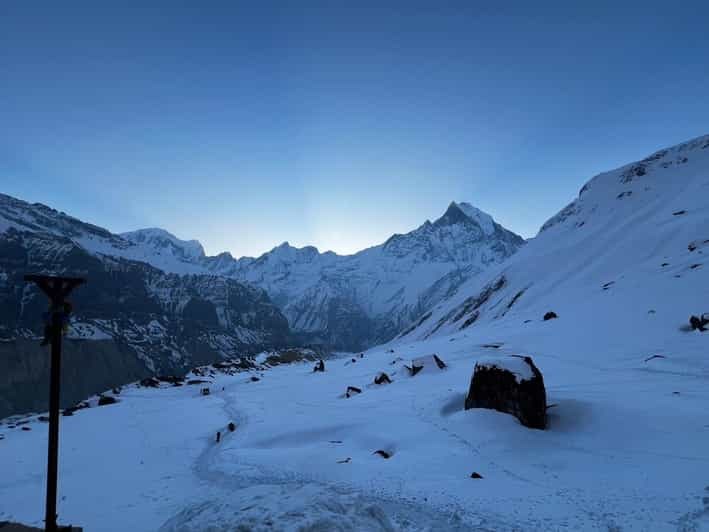
Along the Annapurna Circuit Trek , trekkers can expect comfortable accommodations and delectable local cuisine .
The trek features a network of teahouses , where trekkers can rest and rejuvenate after each day’s journey. These family-run establishments offer basic but cozy rooms, often with shared bathroom facilities.
Meals are served in the common dining areas, where trekkers can savor the flavors of Nepali staples like dal bhat, a hearty rice and lentil dish. Vegetarian options are widely available, and some teahouses even serve local specialties like apple pie, a treat in the mountainous region.
The hospitable staff ensures trekkers feel at home amidst the stunning Himalayan landscapes.
Trekking Permits and Fees
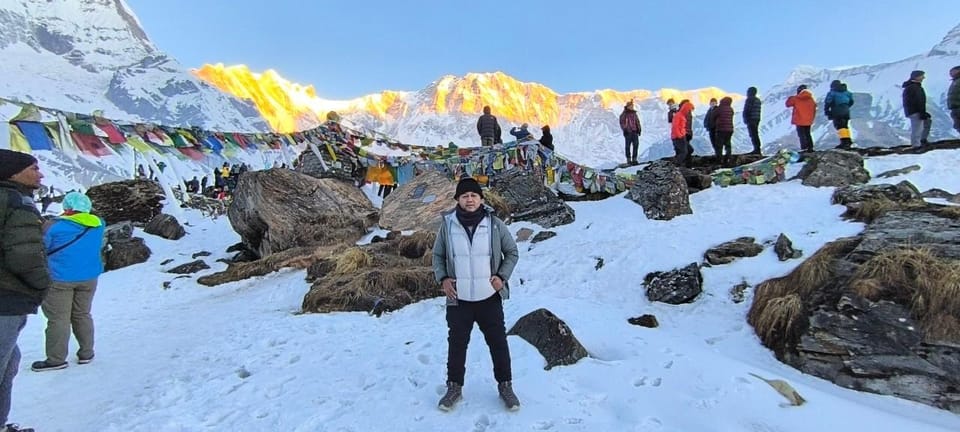
Obtaining the necessary trekking permits and paying the requisite fees are crucial steps in planning the Annapurna Circuit Trek . The trek requires several permits, including the Annapurna Conservation Area Permit (ACAP) and the Trekkers’ Information Management System (TIMS) card.
These permits ensure the protection of the fragile Annapurna ecosystem and provide essential safety measures . Trekkers must also pay national park fees to enter the Annapurna Conservation Area. The fees help fund conservation efforts and support the local communities .
Here are the key permits and fees:
- Annapurna Conservation Area Permit (ACAP) – Approximately $20 per person.
- Trekkers’ Information Management System (TIMS) card – Around $10 per person.
- Annapurna National Park entry fee – Roughly $30 per person.
- Potential additional fees for camping or porters, if required.
Safety and Support
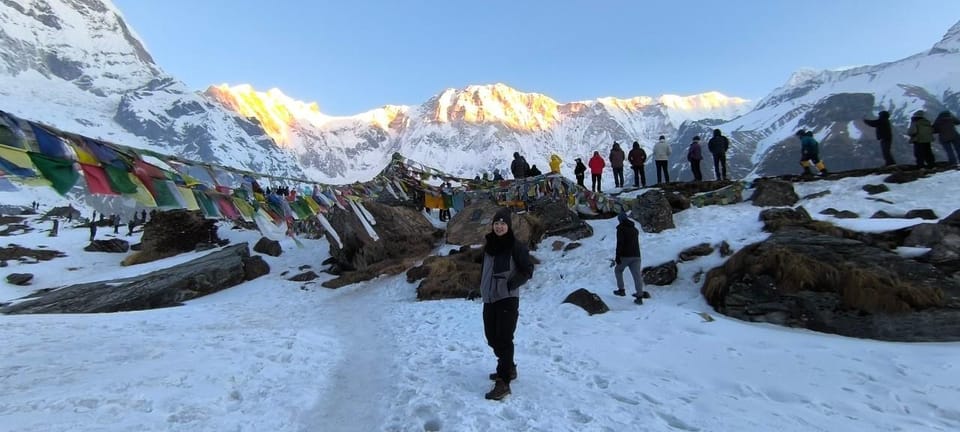
For the safety and well-being of trekkers on the Annapurna Circuit, a reliable trekking company provides comprehensive support throughout the journey.
An expert local guide accompanies the group, ensuring smooth navigation and culture. All necessary trekking permits and national park fees are included, allowing hassle-free access to restricted areas.
In case of emergencies, a comprehensive medical kit and emergency evacuation arrangements are in place. The company’s proven safety record and adherence to industry standards give trekkers peace of mind.
With attentive support from start to finish, participants can focus on the breathtaking scenery and rewarding cultural experiences that define the Annapurna Circuit trek.
Cultural Experiences
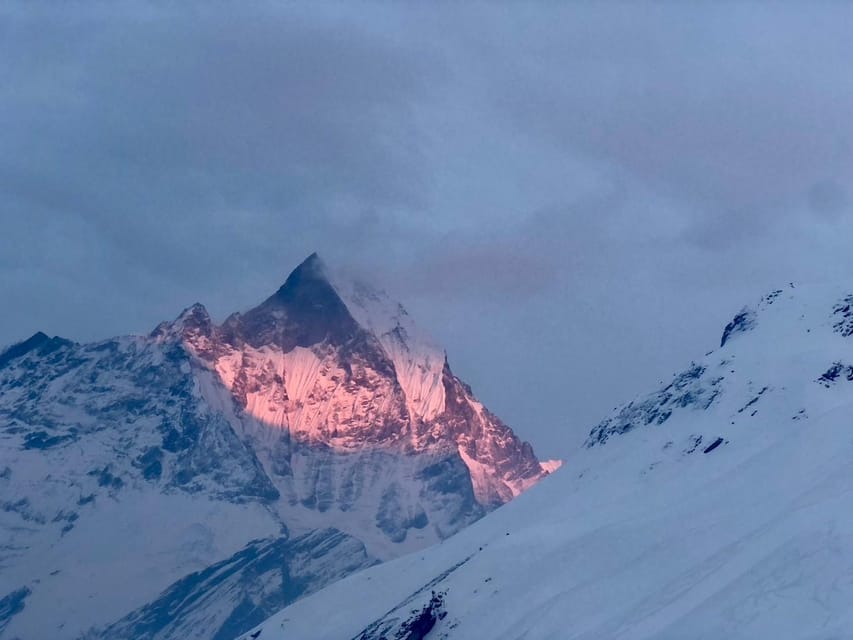
Woven into the Annapurna Circuit trek is a rich tapestry of cultural experiences that immerse trekkers in the vibrant traditions and daily lives of Nepal’s mountain communities.
Along the route, explorers can:
Visit ancient Buddhist monasteries and witness sacred rituals, gaining insight into the region’s deep-rooted spiritual heritage.
Interact with local artisans and learn about traditional craftsmanship , from intricate woodcarvings to hand-woven textiles.
Indulge in the renowned Nepali cuisine , savoring delectable dishes like dal bhat and apple pie in cozy mountain teahouses.
Discover the warm hospitality of Himalayan villagers, who welcome trekkers into their homes and share their vibrant cultural traditions.
Preparing for the Trek
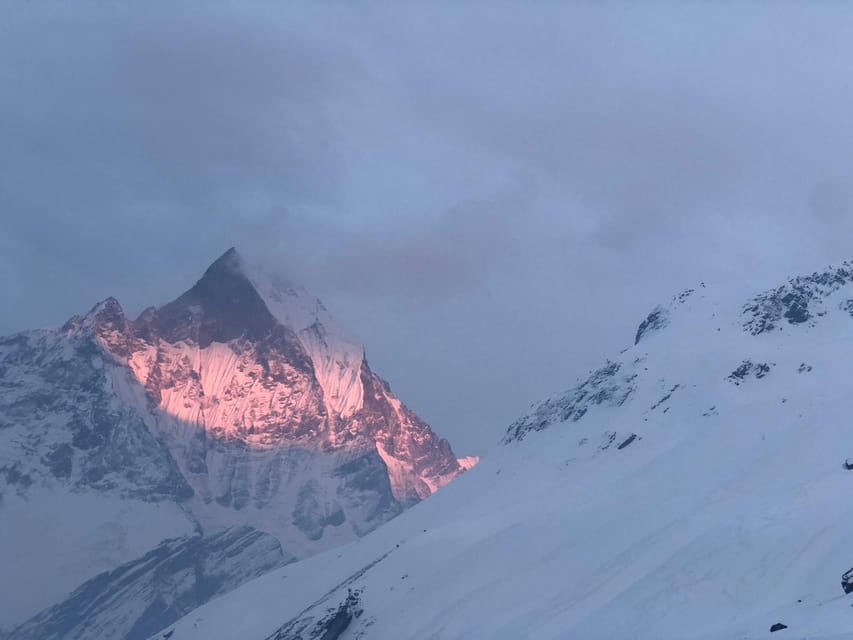
Preparing for the Annapurna Circuit trek begins with gathering the right gear and equipment. This multi-day hike through Nepal’s Himalayan landscapes requires proper preparation to ensure a comfortable and safe experience. The essentials include:
Consulting with experienced trekkers or the tour operator can help fine-tune the packing list. Proper planning and attention to detail ensure a successful and enjoyable Annapurna Circuit adventure.
Trek Booking and Cancellation
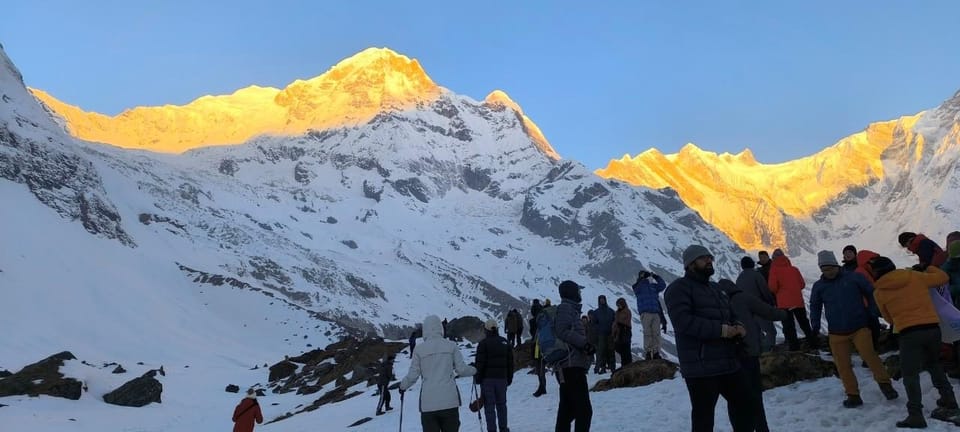
Booking the Annapurna Circuit trek can be a straightforward process, thanks to the availability of reliable trekking agencies that offer comprehensive packages .
These agencies handle all the necessary logistics, including securing permits, arranging accommodations, and providing expert guides.
When booking, consider the following:
Flexibility: Many agencies offer free cancellation up to 24 hours in advance, allowing you to plan with confidence.
Payment options: Some agencies offer a "reserve now, pay later" option, making it easier to secure your spot.
Pickup service: Expect convenient pickup from your hotel or residence, ensuring a seamless start to your adventure.
Safety precautions: Agencies prioritize your well-being, with comprehensive medical kits and emergency evacuation arrangements in place.
Here's a few more nearby tours and experiences we think you'll like.
- From Kathmandu: 18 Days Upper Mustang Trek
- Nepal Odyssey: A Spiritual Journey – Kathmandu to Muktinath
- Pokhara: 4 Day Lower Mustang,Dhumba Lake,Muktinath Jeep Tour
- From Kathmandu: Annapurna Circuit Trek 15 Days
- Pokhara: 9-Day Annapurna Circuit Trek
- From Kathmandu Budget: 12 Day Annapurna Circuit Trek
Frequently Asked Questions
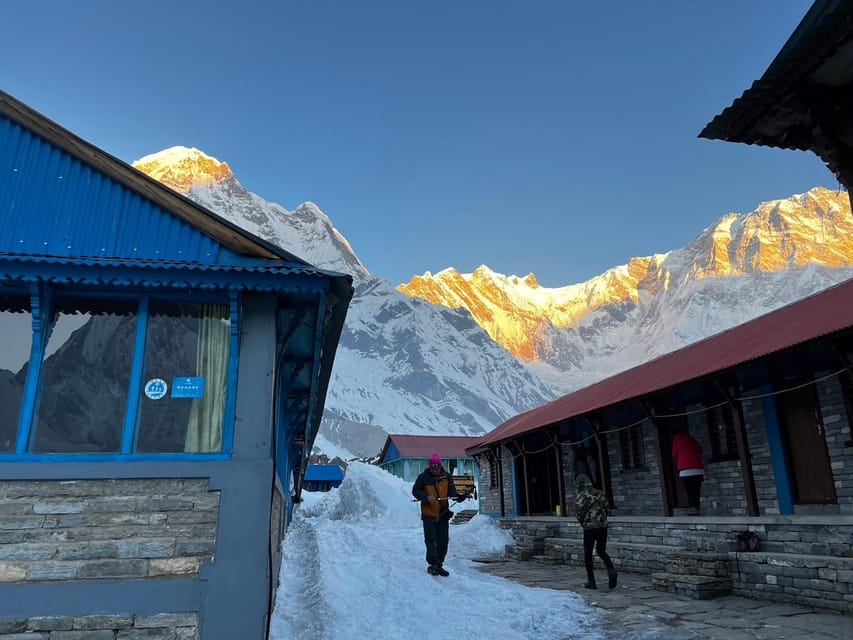
Can I Extend the Trek Beyond 15 Days?
Yes, the Annapurna Circuit Trek can be extended beyond the standard 15-day itinerary. Many trekkers opt to add extra days to explore the region more thoroughly or include side trips to other nearby destinations.
What Are the Requirements for Solo Trekkers?
Solo trekkers must be experienced, self-sufficient, and prepared for the challenges of the Annapurna Circuit. They’ll need proper equipment, navigation skills, and contingency plans for emergencies. Solo trekking isn’t recommended for beginners without prior experience in Nepal’s mountain terrain.
Is There an Option for Private or Customized Treks?
Yes, the trekking company offers private and customized treks for groups or individuals. Clients can customize the itinerary, group size, and pace to suit their preferences and experience level. Flexible options are available to create a personalized Annapurna adventure.
How Can I Obtain a Nepal Visa Before the Trek?
Travelers can obtain a Nepal visa prior to their trek by applying for an e-visa or obtaining a visa upon arrival at Nepal’s international airports. The visa process is straightforward and can be completed in advance to ensure a smooth start to the trek.
Can I Bring Children Under 12 on the Trek?
Children under 12 can join the Annapurna Circuit Trek, but it’s not recommended. The trek involves high altitudes and challenging terrain that may be unsuitable for young kids. Parents should carefully consider their child’s fitness and ability to handle the demands of the trek.
Not for you? Here's more of our most recent tour reviews happening neaby
- From Pokhara: 3 Days Jomsom Muktinath Tour(Lower Mustang)
- From Pokhara: 3 Night 4 Days Muktinath Darsan Yatra
- Muktinath: Yartung Festival
- Annapurna Circuit Trek
- 16-Day Annapurna Region Mountain Biking Tour
- From Pokhara : 1 Night 2 Days Jomsom Muktinath 4wd Jeep Tour
- From Pokhara – : 4 Day Jomsom , Muktinath Trek & Jeep Tour
- Pkr: Exploring the Enchanting Lower Mustang 4-Day Jeep Tour
- Pokhara: 2 Day Mustang Tour With Muktinath Temple
- Lower Mustang Motorbike Tour -8 Days
- Kathmandu: Lower Mustang, Muktinath 4 W Jeep Guided Tour
- Sacred Trails: 3-Day Jomsom, Kagbeni, Mustang Tour
- Mustang Tiji Festival
- 10- Day Kathmandu, Pokhara & Lower Mustang 4WD Jeep Tour
The Annapurna Circuit Trek offers a captivating blend of stunning Himalayan landscapes, rich culture, and personal challenge. Trekkers can expect breathtaking mountain vistas , comfortable accommodations, and delectable Nepali cuisine, all while navigating the famous Thorong La Pass . With expert guidance and support, this 15-day journey through Nepal’s heartland promises an unforgettable adventure for outdoor enthusiasts and cultural explorers alike.
Similar Posts

Paragliding Tandem Flight Experience in Sokobanja
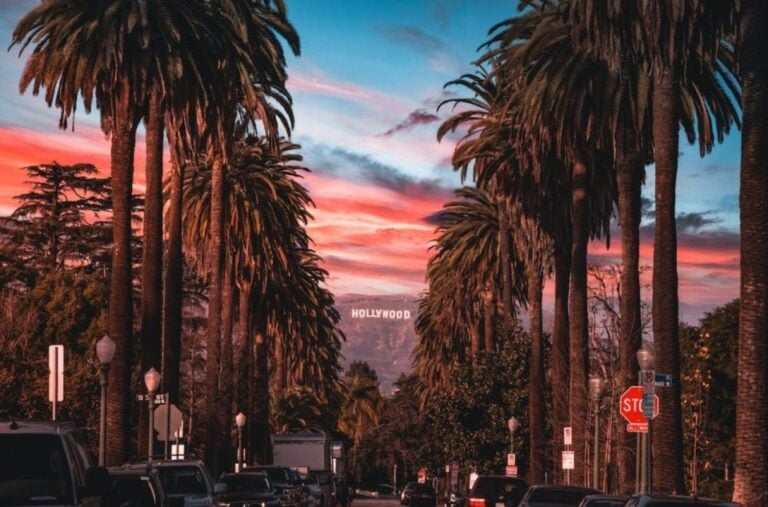
LA: City, Getty Center, and Griffith Observatory Guided Tour

Traditional Spanish Home Dinner

Marrakech Day Trip With Amazing Tour Guide

Photography in Tenerife: Crafting Elegant Visual Narratives

Private Transfer From Kobe Cruise Port to Kobe Airport (Ukb)

- Everest Region Trek
- Annapurna Region Trek
- Manaslu Region Trek
- Mustang Region Trek
- Manang Region Trek
- Langtang Region Trek
- Makalu Region Trek
- Dolpo Region Trek
- Kanchenjunga Region Trek
- Best Selling Treks
- Nepal Trekking
- Luxury Treks in Nepal
- Challenging Treks in Nepal
- Family Treks in Nepal
- Peak Climbing
- Mountain Climbing in Nepal
- Nepal Tour Packages
- Luxury Tours in Nepal
- Helicopter Tours
- Nepal Family Tours
- Bhutan Tour
- Kailash Tour
- Pokhara Day Tour
- Kathmandu Day Tours
- Jungle Safari in Nepal
- Nepal Visa Information
- Packing List for Trekking
- Bhutan Visa
- Fitness Training
- 10 Comprehensive Nepal Trekking Tips
- Flight Cancellation
- Travel Insurance
- The Differences
- Terms & Conditions
Tell us about your adventure
You're interested in
Annapurna Circuit Trek

Trip Duration 14 Days

Max, Altitude 5416m

Type Trekking

Best Season Sept - May

Meals Included

Accommodation Guest House

Activity Trekking

Difficulty Easy
- A trek start through low elevation to Higher elevation ( 5416m)
- Explore the best view Annapurna ranges from Ngawal and Manang
- Experience the local culture in Manang village
- Roaming around Manang and Surroundings
- Observe the best of Thorong La (5416m)
- Visit Muktinath Temple and Jomsom Local Market
Introduction to the Annapurna Circuit Trek
Nestled in the heart of the Himalayas, the Annapurna Circuit Trek stands as one of the most iconic and revered trekking routes in the world. Spanning approximately 140 to 160 kilometers depending on the chosen trails, this circuit takes trekkers through diverse landscapes, beautiful villages, and inspiring views of the Annapurna mountain range.
The journey typically begins in the vibrant town of Besisahar, where trekkers register and obtain the necessary permits for their adventure. From here, the trail gradually ascends through terraced fields, pleasing villages, and dense forests. It provides a real taste of the cultural richness of the region. The trek is an immersive experience, allowing participants to interact with local communities and witness the daily lives of the Gurung, Manangi, and Thakali people.
One of the highlights of the Annapurna Circuit is the crossing of the Thorong La Pass , situated at an elevation of 5,416 meters (17,769 feet). This challenging ascent requires careful acclimatization, and trekkers are rewarded with unparalleled panoramic views once they reach the summit. The pass serves as a gateway between the Manang and Mustang districts, creating a dramatic transition from dense green landscapes to the arid, windswept terrain of the rain shadow region.
As trekkers descend from Thorong La, the trail takes them through the ancient trading route of the Kali Gandaki Valley. This region is home to the world’s deepest gorge and showcases a great contrast between the mountain peaks of Dhaulagiri and Annapurna. The trail meanders through peaceful villages like Jomsom , where apple orchards thrive, producing some of the finest apples in the region.
The sacred pilgrimage site of Muktinath is another significant stop on the Annapurna Circuit. Here, trekkers can explore the Muktinath Temple, a revered site for both Hindus and Buddhists. The temple’s eternal flame and 108 water spouts are believed to have cleansing properties, attracting pilgrims from across the region.
The diverse ecosystems encountered on the Annapurna Circuit contribute to its attraction. Trekkers witness the transition from subtropical forests to alpine meadows and arctic tundra. This variation in terrain also means encountering an array of wildlife, including Himalayan blue sheep, marmots, and eagles, adding an element of wilderness to the journey.
Accommodations along the trail range from teahouses in quiet villages to more basic lodges at higher altitudes. The warmth and hospitality of the locals provide a comforting respite for trekkers, fostering a sense of camaraderie among fellow adventurers.
The completion of the Annapurna Circuit is not just a physical achievement but a spiritual and cultural odyssey. The trek challenges participants, both mentally and physically, and rewards them with a deep appreciation for the natural beauty and cultural richness of the Himalayas.
In conclusion, the Annapurna Circuit Trek stands as a testament to the attraction of adventure and the indomitable spirit of exploration. As trekkers trek the diverse landscapes, overcome challenges, and create great connections with the people of the region, they begin on a transformative journey that leaves an indelible mark on their souls, forever tying them to the majestic Himalayas.
The Best Time for the Annapurna Circuit Trek:
Annapurna Circuit Trek is best undertaken during the pre-monsoon (spring) months of March to May and the post-monsoon (autumn) months of September to November. These seasons provide optimal weather conditions and clear skies, with easy and comfortable trekking experiences for trekkers.
Annapurna Circuit Trek Difficulty:
Annapurna Circuit Trek is graded as a moderate to challenging trek due to the high altitude of Thorong La Pass. Thus, this Annapurna Circuit Trek is recommended for trekkers with a good level of physical fitness and some prior trekking experience. Please note that proper acclimatization is essential for a safe and enjoyable journey.
Conclusion:
Begin the transformative journey on the Annapurna Circuit Trek with Himalayan Trekking . Experience the amazing blend of natural beauty along with the cultural diversity, and personal accomplishment.
Let the majestic Annapurna Massif and its surrounding landscapes etch memories that will last a lifetime.
Join us in exploring the best of the beauty in the Annapurna Circuit Trek .
Your adventure awaits!
Itinerary of Annapurna Circuit Trek
Day 1: arrival in kathmandu (1,300m).
After landing at the Tribhuwan International Airport , you will be picked up by our representative who will drop you off at the hotel. Overnight in Kathmandu.
- 3 Star Hotel in Kathmandu
- No Meal Included
Day 2: Drive from Kathmandu to Besishahar (800m)7- 8 hours
We make our way to Besisahar. After about 5-6 hours into the drive we reach the town of Dumre from where we steer right leaving the highway towards Besisahar.
- Local Guest House
- Breakfast, Lunch and Dinner
Day 3: Drive to Syange and trek to Jagat (1,300m) 4-5 hours
Breakfast and take local jeeps to Syange and star hike to Jagat 2-3 hours. Alternatively, you candirectly drive to Jagat from Besishahar.
- Local Guest house
- Breakfast, Lunch and Dinner Included
Day 4: Trek from Jagat to Dharapani (1,960m) 7-8 hours
We begin our journey with a fulfilling breakfast needed for a good day’s walk. On the first part of the trail, we descend onto a river, cross a bridge, and then into a lush forest. We now climb a steep cliff overlooking the riverbank. On our journey towards Chamje, we see great views of the Annapurna mountain ranges. After Chamje, the trail becomes challenging as we make our way through a steep and slippery path to Sattale. We make our way further through a rocky trail soon descending to a grassy riverbank leading to Tal. From here we move further rugged and winding trails towards the village of Karte.
Day 5: Trek from Dharapani to Chame (2,710m) 5 - 6 hours
This days’ walk is one of the most rewarding as we get tremendous views of the LamjungHimal, Annapurna II, and Annapurna IV (7,525m/24,688ft) and to top it all off we encounter small hot springs too where we canrelax and chill for a bit.
Day 6: Trek from Chame to Pisang (3,300m) 5 - 6 hours
We embark on a challenging journey this day. We walk throughsteep narrow paths, a dense forest towards, and steep slope rising 5000 ft. We are welcomed by fantastic views as soon as we make it through the narrow path.When the valley widens we see the PaungdaDanda, a giant of a rock rising 5,000ft (1500m) above the trail. We continue until we reach upper Pisang. Overnight in Upper Pisang.
Day 7: Trek from Pisang to Manang via Upper Nawal 6 - 7 hours
After a nice breakfast, we start making our way to Manang today. Manang can be reached through two ways. We choose to take the one that takes us to Upper Pisang via Geru since the route is filled with beautiful views of Annapurna and Pisang along with the stunning landscape. Visitors will notice the change in landscape and vegetation this day;the green vegetations give way to desert like arid landscape. At Manang we will visit the largest monastery in Manang -the Barge monastery. Overnight at Manang.
Day 8: Acclimatization day at Manang
As the altitude picks up we must take a day solely just to acclimatize. So, we will spend he day going on a short hike to either BhojoGumba or Gangapurna Lake. If there is some spare energy left in us we would make a visit to the Himalayan Rescue Association atVraga Village. There we can have more information about Acute Mountain Sickness (AMS). Overnight in Manang.
Day 9: Trek from Manangto Yak Kharka(4,110m) 3 - 4 hours
Today’s journey is going to be a short but a fulfilling one. The first part of the trail has us crossing a stream, ascending toTenki and further out of theMarshyangdi Valley into the valley of JarsangKhola. We continuefurther northwards passing near the small village of Ghunsa and then through pastures where horses and yaks graze. At this point we are at the last part of today’s trail. We cross a small wooden bridge; thenpass an ancient old Mani wall in a pleasant meadow to finally reach Yak Kharka. Overnight at Yak Karka.
Day 10: Trek from Yak Kharka to ThorongPhedi (4,600m) 3 - 4 hours
Today’s walk is steep but filled with beautiful views! We climb all the way to ThorangPhedi which is the last village before Thorong La pass.The first part of the journey has us crossing a suspension bridge to reach Ledar village. We climb further passing through high cliffs to reach ThorangPhedi. We get brilliant views of Mt. Khatungkan, Thorung Peak,Mt. Syagang, and Mt. Gundang. Overnight in ThorangPhedi.
Day 11: Trek from ThorongPhedi to Muktinath (3,800m) via Thorong La pass (5416m) 7 - 8 hours
Today’s challenge is the Thorong La pass- one of the highest passes in the world! It is a challenge, but we don’t want to make it that hard, do we? So, we will take the easy, safe route which is crossing the pass from east to west (Manang to Muktinath). All your hard work will be paid off at the end of the day as the views at the top is breathtaking! After reaching the top we descend towards the Muktinath Valley. Overnight in Muktinath.
Day 12: Trek from Muktinath to Jomsom(2,670m) 4 - 5 hours
Today’s journey is going to be a spiritual one! Holy for Buddhists and Hindus, Muktinath is an important pilgrimage site. We visit a temple and a monastery at the first part of our walk for today. Then we make our way to Jomson via Ranipauwa village and Kagbeni.We walk along a plateau above Kali Gandaki River, the world’s deepest gorge for today’s journey! Alternatively, You can take a local jeep to Jomsom.
Day 13: Fly to Pokhara and sightseeing in Pokhara
Morning take a domestic flight from Jomsom to Pokhara, it takes about 30 minutes flight and you will be staying a night in Pokhara. After checked in hotel, rest and take delicious lunch then excursions in the valley.
- 3 star hotel in Pokhara
Day 14: Drive from Pokhara to Kathmandu, 6-7 hours
After a night of celebration, we prepare to leave for Kathmandu for some packing and more celebrations. We say goodbye to Pokhara and get on a 6-7 hours’ drive to Kathmandu. On reaching Kathmandu you will have some spare time to do some last-minute souvenir shopping and resting. A dinner party is arranged to celebrate your successful journey. Overnight in Kathmandu.
- 3 star hotel in Kathmandu
- Breakfast and Dinner Included
Information
The Itinerary can be changed from Jomsom to Pokhara with walking to Poonhill via Tatopani.
Price includes
- All the transportation between airport and hotel
- 2 nights in a 3-star hotel in Kathmandu with breakfast
- 1 night in a 3-star hotel in Pokhara with breakfast
- One way flight from Jomsom to Pokhara
- Transportation from Pokhara to Kathmandu
- Three meals ( Breakfast, Lunch and Dinner) During the Trek
- Farewell dinner at the end of the trek
- All accommodation and meals during the stay in the trek
- An experienced English speaking guide and one porter for 2 persons each of the group
- All necessary paper work and permits (National park permit, TIMS)
- All government and local taxes
Price Excludes
- International airfare to and from Nepal
- Nepal Visa fee ( US$ 30 for 15 days and US$ 50 for 30 Days)
- Lunch and dinner at Kathmandu and Pokhara
- Any personal expense
- Travel Insurance (Must purchase your home country)
- Any type of soft drinks, Boiled hot water, shower, etc, during the trek Extra meals apart from inclusions
- Tips to porters and guides
- Extra Nights hotel in Kathmandu and Pokhara
- All personal, medical, evacuation and emergency expenses
Have any Questions? Check out FAQ'S
Frequently asked questions (faq), when is the best time to trek.
Generally from September to June is perfect time for this trek. If you are interested for best months which are October, November, March and April
Can I book this trip Privately?
USD 1030 / Person
Select Date and Travelers
- Instant Confirmation
- Free to customize
- Support anytime
© 2024 - Himalayan Trekking and Tours (P) Ltd. All Rights Reserved.

10 things I wish I knew before hiking the Annapurna Circuit
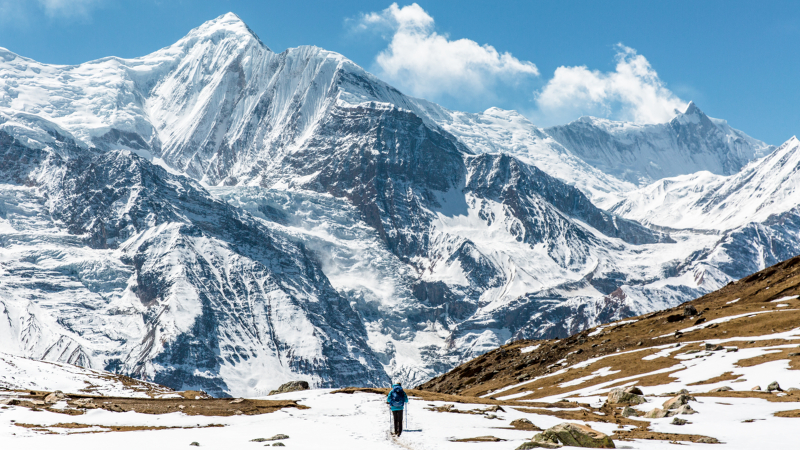
It’s one of the world’s classic long-distance hiking trails, and still one of Nepal’s most popular treks.
The Annapurna Circuit , a 12 to 21-day route that begins in the lush green villages of the Himalayan foothills. Taking trekkers over the 5,416m Thorong La Pass and down to the Tibetan-influenced temples and communities of the Mustang Valley.
If you want to experience a little bit of everything Nepal has to offer, this is perhaps the best trek to set off on, but it’s certainly no easy feat. The circuit is very tough at times, and the high altitude and unpredictable weather of the Annapurna mountain range can make crossing the Thorong La Pass a dangerous task – particularly if you’re not prepared.
Thankfully, I’ve got your back! So, here are ten things you should really know in order to complete the amazing Annapurna Circuit safely and with a smile on your face.
Check out Intrepid's Annapurna treks
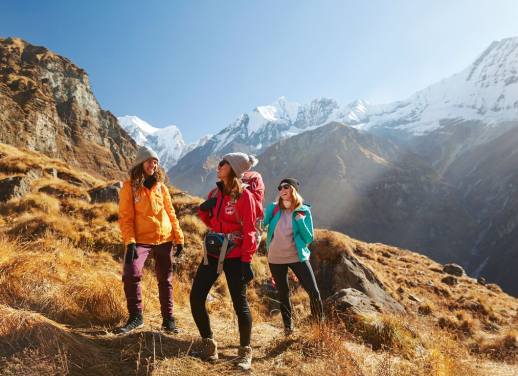
1. Plan the time of year right
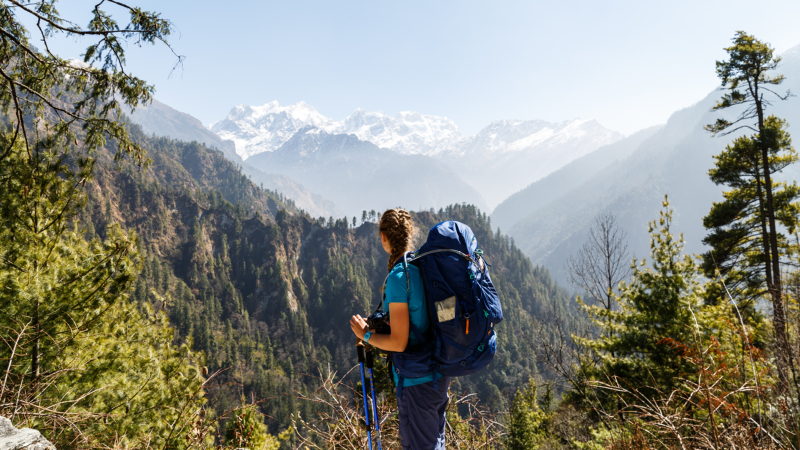
Photo captured by Annapurna Mellor
Like with many of the treks in Nepal, there are certain times of year when the weather conditions are ideal. For the Annapurna Circuit, October and November or April and May are widely considered to be the best times for trekking. The weather during these two seasons is generally clear and dry, and so it’s not too cold when heading into high altitudes. These two seasons are also the busiest times to be on the trail, with many other trekkers from across the world heading into the Himalayas.
You can also trek at other times of the year, but you will need to be a little more prepared for adverse weather conditions. The winter season, December to March, can also have clear skies and spectacular views. But it can be incredibly cold at higher altitudes, with thick snow on the ground that can often cause the Thorong La Pass to close at short notice. If you decide to trek during the winter season, make sure you have extra layers, a thick sleeping bag suited to temperatures of at least -20°C and crampons, which can be bought in Kathmandu and Pokhara.
GO NOW: EXPERIENCE THE BEAUTY OF THE ANNAPURNA CIRCUIT ON THIS 16-DAY ADVENTURE
2. Bring only what you need, leave the rest behind
When trekking on the Annapurna Circuit with Intrepid, Nepalese porters will carry 10kg of your gear. Anything extra will need to be carried on your own back, so packing as lightly as possible is essential. There are some things you need, such as a good quality sleeping bag, warm jackets, medicines, thermal layers and a head torch. But leave your jeans, laptop and makeup back in Kathmandu. You really don’t need them on the trail, and your back will thank you for it!
SUBSCRIBE TO OUR NEWSLETTER FOR THE LATEST TREKKING NEWS, OFFERS AND COMPETITIONS
3. The altitude should not be underestimated
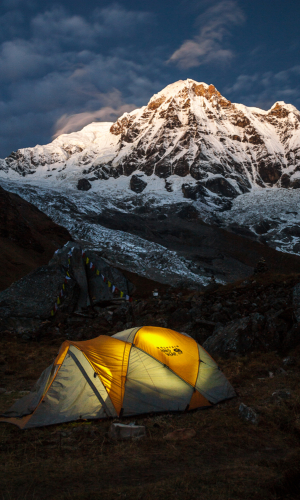
Altitude sickness can happen anytime above 2,500m. It doesn’t matter how fit you are, it can affect anyone and does so randomly. You can stay prepared by taking Diamox, an altitude medication, but aside from that just take it slow, drink lots of water and listen to your body. Before you set off on the trail, read up on the symptoms of altitude sickness so you’re aware of them if you start to feel the effects. Your guides will also be very knowledgeable about altitude and can be an essential source of help if you aren’t feeling well. The Annapurna Circuit reaches over 5,000m, that’s seriously high, and almost everyone will experience some mild symptoms like headaches or difficulty sleeping.
RELATED: ANNAPURNA OR EVEREST? YOUR DEFINITIVE TREKKING GUIDE
4. Be prepared for all weathers, whatever the time of year
While certain times of the year have much more suitable trekking weather (see point one), it is vital to be prepared for all possible conditions, no matter when you decide to go. High in the Himalayas, the weather is unpredictable, and snow, rain or storms can happen at any time. Climate change also means that weather patterns have become even more erratic over the last few years. Even if you’re trekking in October, be prepared for snow or storms on the trail. Pack enough warm clothing, make sure your boots are waterproof and don’t forget your sun cream or a sunhat.
GO NOW: DISCOVER THE HIGHLIGHTS OF THE ANNAPURNA CIRCUIT ON THIS 16-DAY ESCAPE
5. Eat well and look after your body
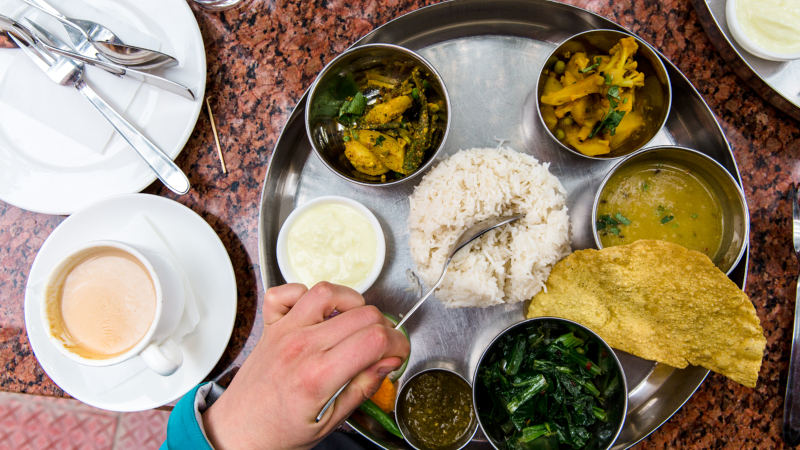
One of the best things about the Annapurna Circuit is the food and hospitality you will receive in the teahouses. Each evening, after a long day of trekking, you will be delighted to sit down in front of a roaring fire and tuck into a plate of dal bhat (a traditional Nepali meal of rice, lentils, vegetable curry and pickle). The food is delicious and very filling, and your body will be grateful for it the next day when you feel revived and ready to head out on the trail again. Other common offerings in guesthouses include garlic soup, a local remedy for altitude sickness and much better than it sounds. As well as, fried potatoes, spaghetti with local vegetables and of course apple pie – which is the Annapurna Circuit’s desert of choice due to the apple orchards growing in many of the villages along the trail. For snacking, I recommend stocking up in Kathmandu, as the cost of items like chocolate bars can get very high on the circuit.
RELATED: 8 NEPALI DISHES YOU HAVE TO TRY
6. It’s good to have a way to purify water
Plastic is a big problem on trekking routes across Nepal, as most of these small villages have no waste disposal system. This is leaving mountainsides cluttered with discarded plastic bottles, which is really not how we want to be treating these areas of striking natural beauty! You can’t drink the tap water in Nepal, and you really do need to be drinking a lot on the trail as you are walking long distances at high altitudes.
I recommend getting a steel reusable water bottle in Kathmandu. Along the trail, there are many villages with purified drinking water stations. Here you can refill your bottle and it actually works out much cheaper than buying bottled water. You can also use water purification tablets or buy a steripen. During the evenings, we would often order pots of hot water or tea and drink that, you can also fill up your bottle with any remaining in the pot and it’ll still be good to drink the next day.
TAKE ME THERE: EXPLORE OUR FULL RANGE OF ANNAPURNA CIRCUIT BREAKS
7. Learn some cultural respect
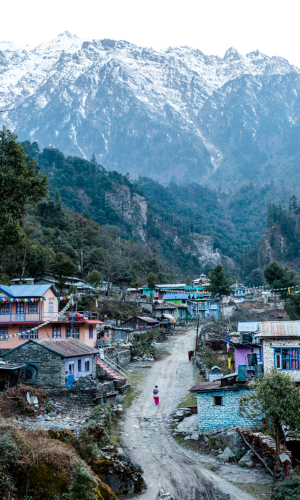
For many people, trekking in Nepal is about mountain views and hiking. But this is also a cultural trail, and it’s important to respect the people that call these villages their home. I recommend learning a little more about the cultures you are passing through. Speak to the families running the teahouses and go visit local gompas or temples. Opening your eyes to the cultures, religions and heritage of the trail will make it a much more enjoyable and meaningful experience, and it also means a lot to the local people when trekkers take an interest in their lives.
RELATED: MY INCREDIBLE MEETING WITH A HERMIT ON A NEPAL MOUNTAIN TREK
8. Don’t run out of cash
Once you leave Besisahar, there are no cash machines on the Annapurna Trail until you reach Jomsom after the Thorong La Pass. So, you need to be prepared and carry all the money you will need for the journey. While food and drinks in the teahouses can be cheap in the lowlands, they increase significantly as you increase in altitude and the road disappears. In Kathmandu, dal bhat is likely to cost you around 200 rupees, but this can grow to around 800 when you get above 3,500m. Western food such as burgers, pasta and burritos (yes, all food you can get on the trail), also tends to be very expensive as you get higher. I would recommend taking at least $20 per day for the trek, and if you’re a big eater or want to drink alcohol, $30-$40 per day is better.
GO NOW: TACKLE ANNAPURNA AND EVEREST ON THIS 31-DAY EPIC
9. Prepare yourself for the Thorong La Pass
Crossing the Thorong La Pass was probably the hardest day of my life! Waking up before sunrise and heading over narrow ridges in thick snow. Then climbing continuously for hours before finally reaching the prayer flags on the pass, breathless and completely relieved. Ok, maybe I’m not selling it so well. But it is essential to be prepared for this day, which will really push even the fittest hiker to the limits.
As long as you’re prepared, wearing enough warm clothes and have acclimatised enough to ensure your body comfortably makes the journey, then reaching the Thorong La Pass is going to be one of the most joyous moments of your trekking trip! Plus, once you’ve reached the top, you get to descend 1,600m to Muktinath, where the air is thick in oxygen and there are even hot showers to look forward to.
GO NOW: LIMITED ON TIME? OUR 5-DAY WALKING TOUR THROUGH THE ANNAPURNA RANGE
10. Be positive, take it slow and enjoy the journey!
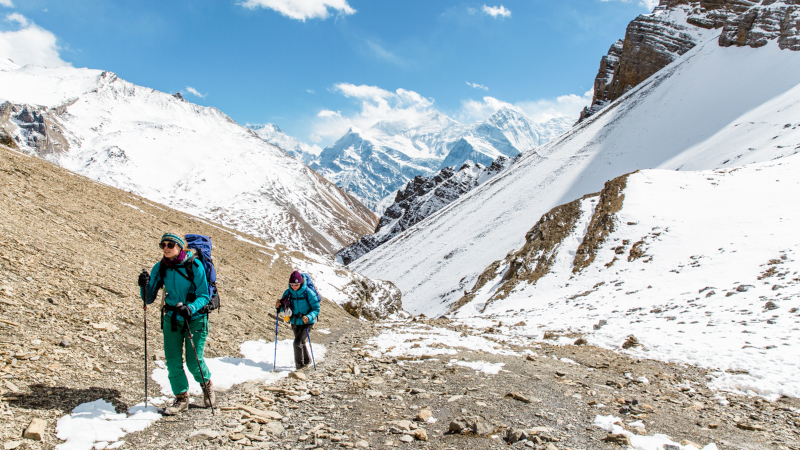
Travelling is meant to push you and challenge you in so many ways and trekking the Annapurna Circuit in Nepal will certainly do just that. While this is a difficult trek at times, it is also an incredibly enjoyable journey and one that can be completed by people of all ages and all fitness levels. The most important thing throughout the trek is to stay positive. Even when your body aches and you’re craving a hot shower, positivity will drive you on and it won’t be long before a breath-taking Himalayan panorama makes you remember why you’re here pushing yourself to the limit. It’s these incredible views, the wonderful hospitality of the local people and the company of your trekking buddies, which really make this a journey you will remember for the rest of your life!
RELATED: WHY CHALLENGING YOURSELF IS SUCH AN IMPORTANT PART OF TRAVELLING
Think you’re ready to take on the Annapurna Circuit? Take a look at our selection of trekking tours that’ll take you there . Already tackled it and looking for a new challenge? Check out our range of walking and trekking holidays from around the world.
Annapurna Mellor
Annapurna Mellor is a photographer, writer and storyteller. Her travels have taken her across Asia, Northern Africa, along the Trans-Siberian Railway and around Europe - always taking the road less travelled and always aiming to go a little deeper into the heart of local culture and people. Her photography work has been featured in National Geographic Traveller Magazine, Lonely Planet Guide Books and in campaigns for many travel brands around the world. Although she is usually dreaming about adventures afar, she is based, most of the time, in Manchester, England.
You might also like
Level up your australian public holidays in 2025, how to make the most of us federal..., make the most of nz’s public holidays in..., top us national parks, how to maximise your annual leave using uk..., 7 incredible hikes in denali national park, unique getaways for your next girls’ trip, how to visit europe in the off-season, best places to travel in march, best places to travel in may, best places to travel in february.
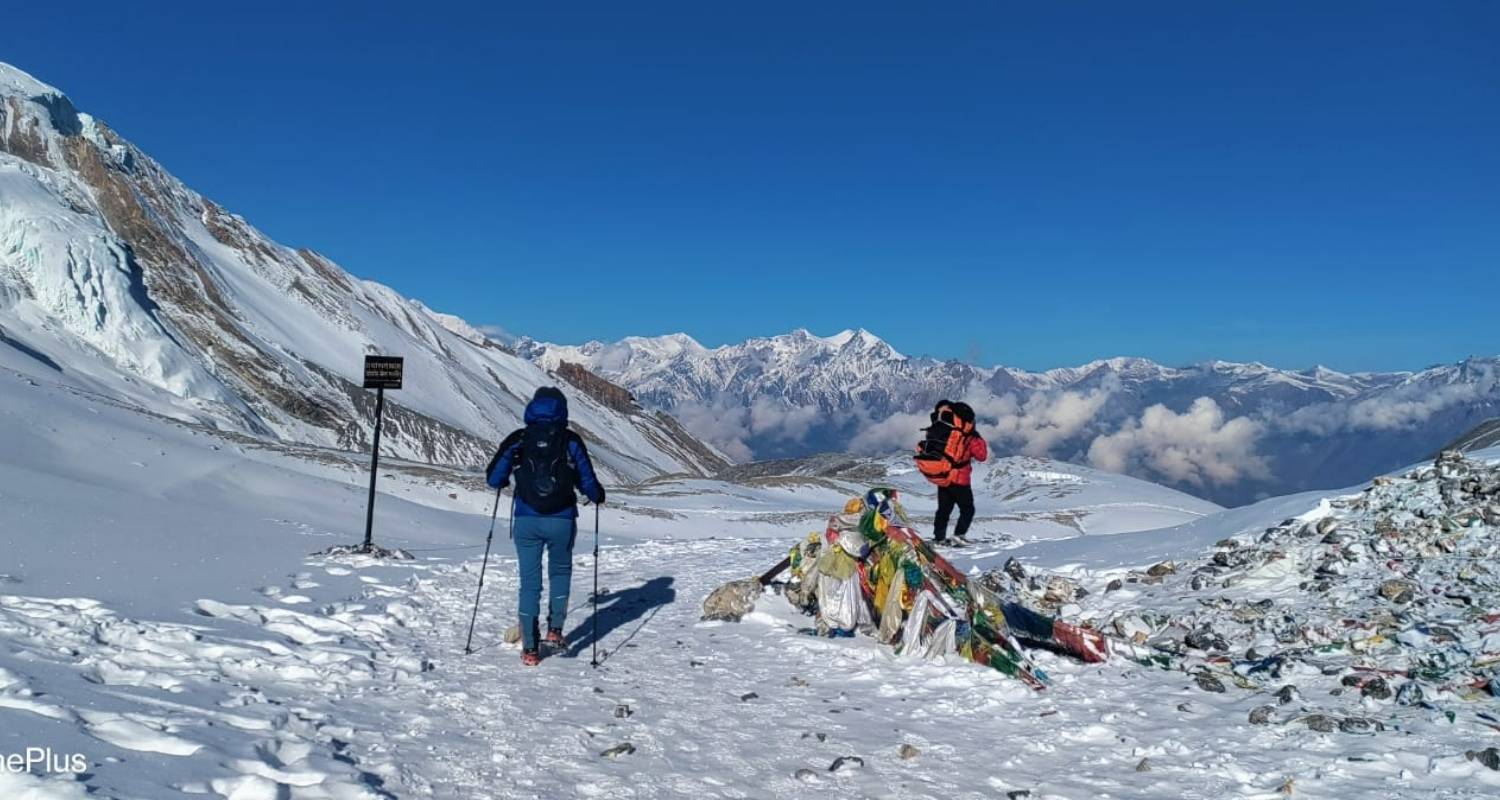
Annapurna Circuit Tours in January 2025
- Choose from 50+ Annapurna Circuit tours
- 300+ verified reviews from TourRadar travelers
- 24/7 customer support
10 best Annapurna Circuit tour packages in January
Compiled by

Melissa Annapurna Circuit travel expert at TourRadar
Annapurna Circuit Trek -10 Days
Annapurna circuit trek 15 days, 15 days annapurna circuit trek (thorong la pass trek), annapurna circuit trekking, annapurna kora trek, short annapurna circuit trek 10 days, annapurna circuit and tilicho lake trek, annapurna circuit trek, real annapurna trek( annapurna circuit trek).

- Mountain Hikes
- Christmas & New Year
- Relax in natural hot springs at Tatopani
- Drive through scenic landscapes to Beshisahar
- Trek through lush forests to Pisang village
“The degree of flexibility was also amazing. I would definitely recommend Alpine Ramble for any of your trekking holidays in Nepal.”

- Hiking & Trekking
- Cross suspension bridges over Marsyangdi
- Trek through lush rice fields to Chamje
- Climb Mt. Khangsar for acclimatization
“The organizer was so flexible to change the plan according to our wishes and it was really amazing.”

- View the remote valleys of Nar & Phu
- Hike through numerous atmospheric villages
- Take a side trip to the high altitude lake of Tilicho
“The views were amazing. The trekking is well organized, and it was an unforgettable experience.”
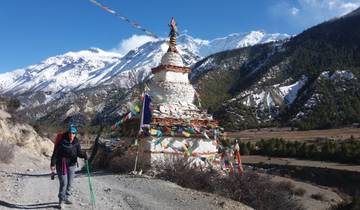
- Explore Thamel's vibrant tourist hub
- Stroll around Phewa Lake in Pokhara
- Cross Thorong La Pass for stunning views
“The trek was an experience of a lifetime, with the challenging terrain and cultural immersion making it truly enjoyable and memorable.”
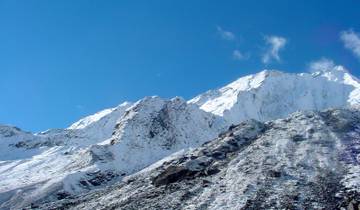
- Visit the largest monastery in Manang
- Relax in Chame's soothing hot springs
- Explore ancient Swayambhunath Stupa
“We had an awesome hike through the beautiful Himalayan mountains. I will recommend this tour to anyone interested in hiking in Nepal.”

- Trek along Marsyangdi River to Pisang
- Visit Manang, the village beyond Himalayas
- Explore pine forests and Himalayan views
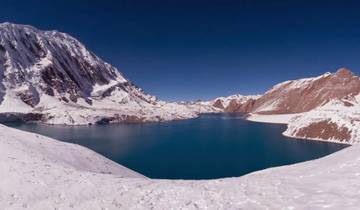
- Meet at Kathmandu airport, transfer to Thamel
- Trek through villages and forests to Dharapani
- Cross suspension bridges, trek to Chame
“I really love this trek as it was more into nature. The trails up and down and along the forest were amazing.”

- Reach 5,400 m over Throng La, the highest point of the trek
- Descend into one of the deepest gorge's in the world - the Kali Gandaki
- Veer off into the remote valleys of Nar & Phu
“The trek itself was wonderful. The planning, meals, rest stops were made by Peregrine Treks and were all of the best quality.”
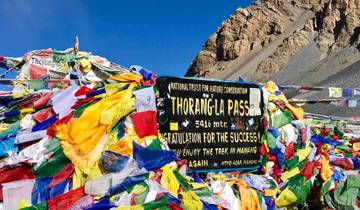
- Local Living
- In-depth Cultural
- Cross the challenging Thorong La Pass at 5416m
- Ascend to the Manang district, viewing Himalayan peaks
- Explore the sacred temples at the Muktinath pilgrimage site
“The Himalayas are the world's most stunning mountain range. The walk was rigorous and difficult (more so for me than for my sister), but it was an unforgettable experience.”
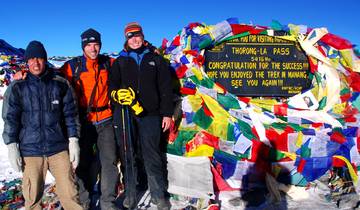
- Experience the sacred Muktinath Temple
- Trek through Annapurna's diverse landscapes
- Cross the challenging Thorong-La Pass
“Apex the Asia is excellent, and I can't speak highly enough about them. Ramesh tailored the trip around the dates I needed.”
Discover TourRadar
Don't have account create here.
ANNAPURNA CIRCUIT TREK

We Offer Group Discount
- Best Price Guarantee
- Hassle-Free Booking
- Team of highly experienced Experts
- 24/7 Customer Support
All Inclusive Cost
A life-changing experience – incredible beauty.
Circumnavigate the Annapurnas – with one peak at 8091m & 28 peaks over 6000m surrounded by the Kali Gandaki Gorge, Marshyangdi River & Pokhara in the south.
The Annapurna Circuit Trek first opened to trekkers in 1980, and today is considered one of the best trekking destinations in the world, passing through Rhododendron forests in the lower regions of the Annapurna and Dhaulagiri mountains. Witness this massif and its many towering peaks that include Annapurna I, II, III, IV, the Dhaulagiri (8167m) , Machchhapuchhre (Fish Tail), Annapurna South and Manaslu.
Sherpa Expedition and Trekking ’s Annapurna circuit trek is perfect for those with a reasonable standard of fitness. The Annapurna trek takes you through the Kali Gandaki Gorge, the world’ deepest gorge and the world’s highest lake, and 300m high Ruptse Falls. The Annapurna Conservation Area has more than 100 species of orchids, Rhododendron forests, sub-tropical marshes, valleys, bamboo and oak forests, alpine glades and hundreds of wildlife species such as Marten, deer, Langoor monkey, and the Snow Leopard. Besides the diversity of flora and fauna, there is the unforgettable hospitality of the people in outposts, villages and towns along the trek.
The Annapurna Circuit trek offers some of the most spectacular views of a multitude of enormous snow-capped peaks and treks through high altitude passes, including the famous Thorong La Pass (5416m) .
Key features of 17 Day Annapurna Circuit Trek
- Ascending the Marshyangdi River valley
- Experience the rich culture of the mountain people in the heart of the Himalayas
- Views of the world’s highest mountains: Dhaulagiri I (7th), Manaslu (8th) and Annapurna I (10th)
- Crossing the Thorong La Pass at 5,416 meters
- The pilgrimage town of Muktinath & sacred Vishnu Temple
- Driving through the world’s deepest gorge and the Kali Gandaki valley
- Bath in natural hot springs at Tatopani
- Magnificent sunrise views from Poon Hill
Day 1 : Arrival at Kathmandu (1,350m) & transfer to hotel.
Sherpa Expedition & Trekking staff will be there to greet you at Tribhuvan International Airport and take you to your hotel, followed by a briefing covering information, do’s and don’ts of your trek. Your safety and comfort are paramount.
Day 2 : Drive from kathmandu to Bulbule (923m/ 3,031ft) Duration: 7-9 hours.
We leave Kathmandu and drive to Besishar after which we take a fairly easy 2-hour trek to Bulebule located near the Marsyangdi River. Tonight we stay at Bulbule.
Day 3 : Trek from Bulbule to Chamje (1410m/ 4,626ft). Duration 5-6 hours.
Today the trail takes us over several suspension bridges, past cascades, through rice fields and across various slopes. The trek is quite short before reaching Chamje where we stay the night.
Day 4 : Trek from Chamje to Bagarchhap (2160m/ 7,087ft) Duration: 5-6 hours.
Leaving Chame we pass through rhododendron, pine and bamboo forests and follow the trail through the valley before arriving at Tal and its cultivated farm plots of wheat, potatoes and other grains. After passing through Dharapani we head in a westerly direction via fir and pine forests until we reach Bagarchhap where we stay the night.
Day 5 : Trek from Bagarchhap to Chame (2710m/ 8,890ft) Duration: 5-6 hours.
From Bagarchhap we continue to the village of Danaque before climbing to Tamang Village where we are offered magnificent views of Manaslu (8163m), Annapurna and other towering peaks. Our trek takes us through several Tibetan villages, such as trek Thanchowk, Kolo before reaching our destination, Chame.
Day 6 : Trek from Chame to Pisang (3240m/10,630ft) Duration: 5-6 hours.
After leaving Chame we pass through Telekhu and along the trail have some breathtaking views of Annapurna and Pisang (6091m) until we have to re-cross on a suspension bridge to the south bank of the Marsyangdi River. After crossing the river we t head higher passing a pine-forest as we trek through the upper reaches of the Manang valley to Pisang. Tonight we stay at Pisang.
Day 7 : Trek from Pisang to Manang (3519m/ 11545ft) Duration: 5-6 hours.
The town of Pisang is the start of our trek in the upper Manang area. Today we head to Braga, a Tibetan village with its unique architecture with houses constructed one upon the other. One of its main attractions is its Gompa, the largest in the Manang region. Manang is popular with trekkers and is also a place to acclimatize before heading to higher altitudes. We stay here for the night.
Day 8 : Acclimatization day at Manang
Medical professionals recommend that before heading to higher elevations that trekkers spend some time acclimatizing. They also recommend staying active. Today we will climb up to Khangsar (3756m) as a way to further help us acclimatize. Overnight stay at Manang.
Day 9 : Trek from Manang to Yak Kharka (4120m/ 13,517ft) Duration: 4-5 hours.
Today we head off on a 10.4 km uphill trek to Yak Kharka passing through juniper forests and may see yak grazing in the pastures. On the route, we pass the only teahouse at Thorong Khola. Depending on the conditions we may decide to go a little further and stay the night at Letdar.
Day 10 : Trek from Yak Kharka to Thorung Phedi (4,560m/ 14,961ft) Duration: 4-5 hours.
Climbing higher we gradually get used to the higher altitude. We follow the east bank of the Jarang Khola and along with the trail view steep bluffs before reaching Thorung Phedi (meaning foothills). If we are lucky we may see the famous blue sheep and even a snow leopard! This is also home to Lammergeyer (bearded vulture). There is also a belief the mythical griffons are in this region!
Day 11 : Trek from Thorong Pedi via Thorong La Pass (5,416m/ 17,769ft) to Muktinath (3,802m/ 12,474ft) Duration 7-9 hours.
Today is most likely the toughest day of the trek, hiking for around 7-8 hours. The higher altitude contributes to the degree of difficulty, and sometimes strong winds in these upper regions. Along the trail we may pass sheep, yaks and merchants transporting their goods. Once we reach Thorong La Pass we will be rewarded with breath-taking views of Annapurna, Gangapurna and eye-catching peak of Khatungkang (6484m). Leaving the pass we descend around 1600 metres and the brilliant Dhaulagiri (Dhavali giri, meaning “White Mountain”) is the highest mountain that is entirely in Nepal. The trail is more undulating and relatively easy before we reach Muktinath where we stay the night.
Day 12 : Trek from Muktinath to Jomsom (2750m/ 9,022ft) Via Kagbeni Duration: 5-6 hours.
From Muktinath, we pass through lush meadows, fruit trees and streams passing through Kagbeni before we reach Jomson in the Kali Gandaki valley. Kagbeni has a well-deserved reputation for its horticulture industry.
Day 13 : Drive from Jomson to Tatopani Duration: 5-6 hours.
The road trip to Tatopani takes about 5-6 hours dropping into the valley of the Kali Gandaki River, the deepest valley in the world. From Marpha to Kalopani we pass via Chokhopani Village, a typical Thakali town well know for its unique cuisine. On the drive, you will be stunned by the awesome views of several famous mountains, such as Nilgiri, Dhaulagiri, Tukuche, and Annapurna before reaching tonight’s destination, Tatopani (meaning hot water). You may wish to bath in the hot pools and unwind.
Day 14 : Trek from Tatopani to Ghorepani (2,860m/9,383ft) Duration 7-9 hours.
Today we ascend 1670 metres, quite a hard slog, and pass through more cultivated farm land with their terraced fields. We climb through a rhododendron forest, spectacular in spring time, magnolia and of course a panoramic view of the mountains. Tonight we stay at Ghorepani with magical views of the Annapurna Ranges and Machapuchare (fish tail) one of the few unclimbed peaks in Nepal due to its religious status – home to Lord Shiva.
Day 15 : Hike up to Poon Hill (3,210m/10,531ft) trek down to Nayapul and drive to Pokhara (8,50m) Duration: 6-7 hours.
An early morning start and we trek up to Poon hil to watch the sunrise, an eye-opening experience that will leave you breathless. As dawn approaches the change in colours will be a magical experience where you camera will go into overdrive! This has to be one of the best places, on any trek, to view the Annapurnas, Dhaulagiri and its many snow-capped peaks. This is an unforgettable experience and will give you photos to boast about! We then head back to Ghorepani for breakfast and after have a 5-hour trek downhill to Nayapul. The first leg of the trek down to Tikhedhunga is a very steep descent after which we pass terraced fields for several hours before reaching Nayapul, and then on to Pokhara for the night.
Day 16 : Drive from Pokhara to Kathmandu; Duration: 6-7 hours.
Today we head back on a 6 to 7-hour drive to Kathmandu with many fond memories of Nepal and its unique culture and geography. These memories will last a lifetime!
Day 17 : International departure from Kathmandu Airport.
Sherpa Expeditions & Trekking staff will transfer you to the airport for your final departure from Nepal. We hope that this epic trek will be firmly ingrained in your memory and will be enough to prompt you to consider your next trek with us!
Costs included:
- Airport-pick up and drop off by the private vehicle.
- Standard twin-sharing accommodation in a three-star hotel in Kathmandu (2 nights only) and Pokhara (1 night only) including breakfast
- Three meals a day (Breakfast, Lunch, and Dinner) During the trek
- Fresh fruit every night after dinner.
- Guesthouse accommodation during the trek in mostly twin-share and occasionally dormitory-style rooms
- Annapurna Conservation Area Project (ACAP) entry permit & Tourist Information Management System (TIMS) permits
- Public bus to Besishar - Bulbule and tourist bus from Pokhara to Kathmandu.
- Shared Jeep /Bus from Jomsom to Tatopani and private transport from Nayapul to Pokhara.
- English speaking guide with all his salary, food, drinks, accommodation, transport, and insurance.
- A strong, helpful porter with the proper equipment (We assign one porter for every two guests.)
- Medical supplies (first aid kit will be available).
- Government taxes and official expenses.
- Use of sleeping bags, down jacket, duffel bag, and walking poles (if you do not have your own, to be returned after you complete the trip).
- Assistant guide group size above 8+ persons.
- Sherpa Expedition and Trekking T-shirt
- Trip achievement certificate after successful trip completion.
- Oxygen meter to check your pulse and oxygen saturation and heart rate twice daily (Very useful to check Altitude Mountain Sickness(AMS) symptoms) which will ensure your health during the trek.
Costs Exclude
- Meals whilst you are in Kathmandu & Pokhara- lunch, and dinner.
- Nepal entry visa fee (easy to obtain the visa on arrival at Tribhuvan International Airport – Kathmandu). $30 USD for 15-day, $50 USD for 30 Days, and $125 USD for 90 Days visa.
- Personal travel and medical insurance.
- International airfare.
- Your personal expenses.
- All the alcoholic and nonalcoholic, soup, tea, coffee, hot chocolate, cocoa, mineral water, extra food, cold and hot drinks on trek ( i.e. those you choose to purchase along the way and during evenings in the tea houses)
- All desserts & sweet things like chocolate, cake, pie, pudding.
- Hot shower and battery charging at the tea houses.
- Tips for the guide, porter, and driver (tipping is expected)
- NOTE: If you return earlier from the trek due to sickness or any problem, the money you paid for the flight, hotel, mountain room, food, etc. is nonrefundable, and you will need to bear the expenses for the hotel, food, etc. in Kathmandu yourself.
The following information will give you some idea about what you need to bring for the trek. It is important you do not forget the essential items, as this will determine your comfort and safety on the trek. Equally important is that you do not burden yourself with unnecessary equipment on the trek.
- All season sleeping bag and down Jacket (we can provide if you need it, but has to be returned after the trek)
- Duffle bag ( Sherpa Expedition & Trekking provide duffle bag during the trek but has to be returned after the trek)
- A wind and waterproof thin layered jacket (a must-have for morning and evenings above 3,000m)
Upper Body- Head / Ears / Eyewear
- A pair of half gloves
- A warmer hat that covers the ears
- Sunglasses
- Sunscreen (35 to 60 SPF)
- Headlamp and an extra set of batteries
- A pair of half gloves for walking poles(if you prefer)
- Warmer shell gloves and liner
- long sleeve t-shirts
- Thermal tops
- wool jacket or pullover
- Sports bras for women and girls
- Water and windproof shell jacket
- Thermal underwear (especially trousers)
- windproof and waterproof trousers
- warmer trousers
- Comfortable trekking pants
- Extra casual sport pants
- A pair of good waterproof trekking boots
- Pair of sandals
- 4-5 pairs of woolen socks
- Sock liners
- Light shoes and sneakers
- First Aid Kits and Medicines
- Assorted adhesive bandages (fabric preferred)
- Blister treatment cream or similar
- Insect / anti-itch ointment
- Ibuprofen or other pain-relief medication
- Diamox (125mg to 250mg tablets for altitude sickness)
- Warps, splints, and wound coverings butterfly bandage
- Water purifying pills
(Note our company guide will carry the medicines and first aid kits during the trek. However, we recommend you bring your personal first-aid kit as well)
Miscellaneous - but must useful on the trek
- 4 passport size photos with original passport
- Water bottle & filter
- Flight details (please make a copy and leave one pic at our office in KTM because in case you want to change your flight date)
- Bathroom kit (conform, should be included toilet paper, plastic bags, hand wipes, towel, and soap, etc.)
Extra things
- Comfortable trekking poles
- Quality energy dry foods (up to you)
- Power bank and music players
- Camera (memory card, chargers, and extra batteries)
GOOD TO KNOW
Accommodation.
You will be accommodated in 3-star hotels in Kathmandu. During the trek, we will be staying at lodges/ teahouses. You may find comfort and better quality teahouses - having attached bathroom at lower levels- until you reach higher elevations, where the accommodation is more basic with bare necessities.
Meals during the trek
In Kathmandu, your hotel includes breakfast, whereas all meals (breakfast, lunch, and dinner) will be provided during the trek. A staple food of the Manang & Mustang regions is potatoes, oats, buckwheat, Sherpa stew, and Tibetan bread. Sherpa’s’ started farming potatoes when the first seeds were introduced to the region in the early 90s. There is a limited choice of food at higher elevations and except many potato dishes. Potatoes are high in carbohydrates – an excellent source of energy needed at high altitudes.
Transportation
We use a private car for sightseeing and for the airport to hotel pick and drop off. We use public transportation or local buses during the trek.
Physical fitness
This can be a challenging trek where you often have to walk 6-7 hours a day. You don’t need past experience of hiking or trekking but if you have done any kind of trekking activities then it is always a plus! We have met people from all walks of life, shapes, and sizes who have completed the trek. The only difficult part is when altitude sickness strikes and the effect that it can have on your body. Before leaving for Nepal it is good if you can prepare yourself physically by increasing your stamina and oxygen intake.
Remember – The better prepared – the more enjoyable your trek!
Photos/videos.
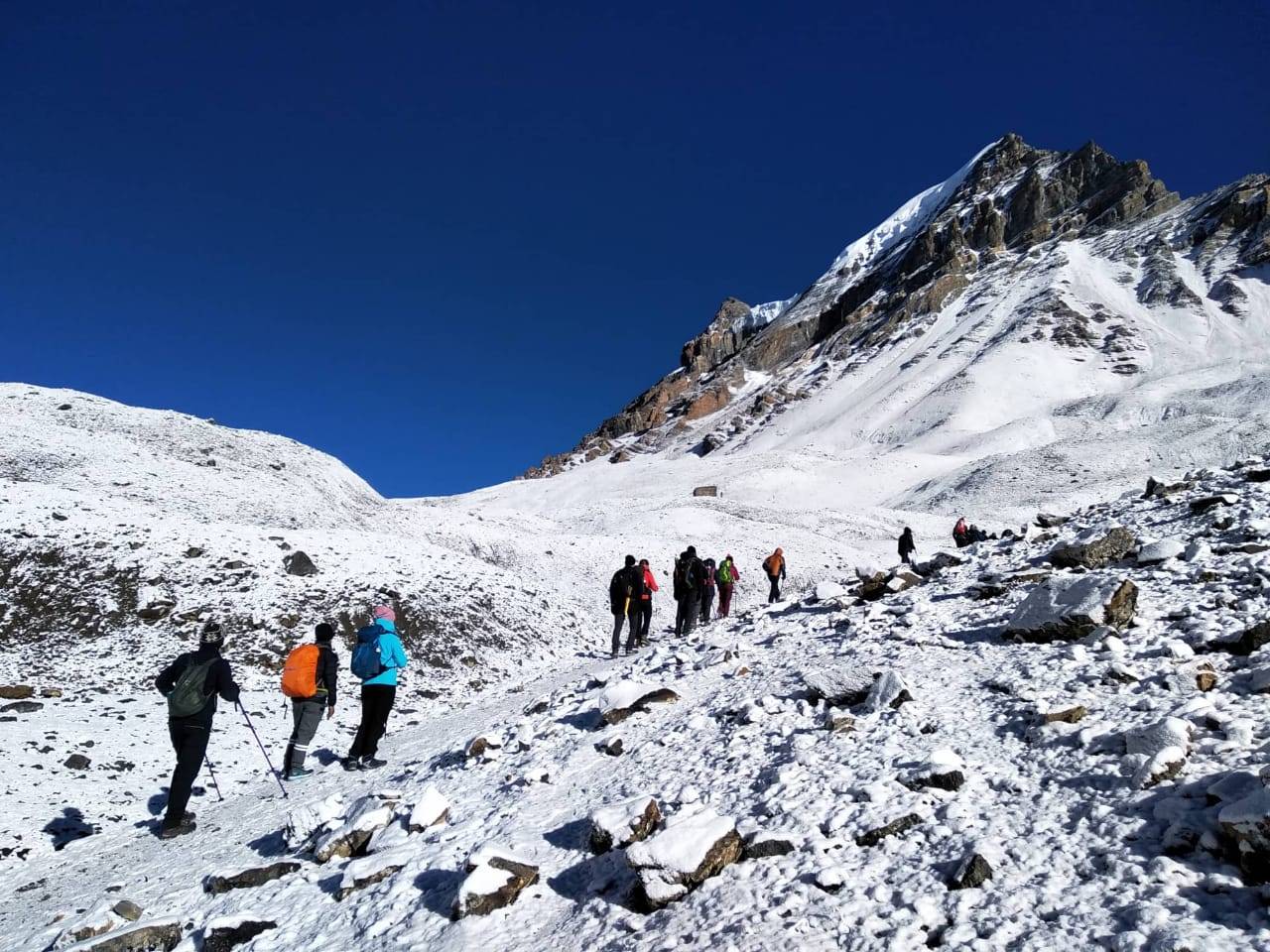
- Personalized Tour
Select a departure month
- Upcoming Departures
Fill out the form below and a Travel Expert will reach out to create your perfect tour.
Travellers(Optional)
I have never hike before, can i make it to annapurna circuit.
Yes, you can. No matter who you are, as long as you are reasonably fit, can walk for 5-6 hours a day and trek/hike a few uphill, Sherpa Expedition and Trekking team will support you to the fullest to transform your dream of standing at Annapurna Circuit into reality.
What is the best Season for trek to Annapurna Circuit Trek?
The pre-monsoon (February, March, April and May) and post monsoon (late September, October, November and December) are considered the best for the Annapurna Circuit trek as the weather conditions become favorable during this time, providing you with good visibility and a suitable atmosphere for Annapurna Circuit Trekking.
Is there an age limit for Annapurna Circuit Trekking?
No, there is no age limit for the trek to Annapurna Circuit but, you need to be in good physical shape and have a positive attitude. We also suggest you to prior to the excursion though we suggest you to please see your doctor and obtain necessary permission and advice, as well as medications for traveling in extreme altitude prior to the excursion.
What are the meals on the Annapurna Circuit Trekking like?
During trekking, you will be served meals in the teahouses. Typical meals are noodles, rice, pasta or potato dishes along with vegetables and egg/chicken/meat dishes. Other items mostly served as breakfasts include egg, pancake, bread, porridge, muesli, and toasts with peanut butter and honey.
What kind of accommodation will be provided during the Annapurna Circuit Trekking?
A teahouse trekking accommodation will be made for you for the Annapurna Circuit Trekking whereby you will be able to stay at tea house (Local lodge) and have wholesome food and neat and clean comfortable bed throughout your trekking journey. This form of arrangement also allows you to carry less baggage; you can trek at your own pace and enjoy the Annapurna panorama on your own schedule. It is also an eco-friendly way of trekking whereby trekkers can have more contact with the local people.
Are there toilet facilities at the tea houses? What opportunities will I have for shower during trekking?
Most of the teahouses on the Annapurna Circuit trail have squat toilet facilities but recently built lodges have western-style toilets as well. Nowadays, flush toilets are also being introduced with number of increasing foreign mountaineers each year. It is highly recommended to carry your own toilet paper and other required toiletries. Hot shower facilities are available. The most common type is a bucket shower, usual buckets with tap filled with hot water and placed in a shower room. Hot shower costs from US$ 2 to 5 per use and the price increases along with the elevation. Attached bathrooms and toilets are not available unless you book for a luxury lodge during the Annapurna Circuit trek.
What kind of clothes do we require for the trekking and is it possible to purchase it in Kathmandu before the start of the trip?
What you want to wear depends on you but we suggest you wear warm clothes during the Annapurna Circuit Trekking. A down jacket, thermal longs and top, comfortable trekking trousers, t-shirts, fleece, windproof jacket, hat, scarf, and gloves might be useful. There are numerous trekking shops in the Thamel area of Kathmandu where you can get all of these items in both local and branded stores alike. Sherpa Expedition and Trekking may also accompany and assist you if required.
Do I need to bring any bags for trekking? If yes, what kind?
During the Annapurna Circuit Trekking, you will be on a long journey for which you will need two bags to keep your belongings. A rucksack/duffle bag and a day bag for personal items. Sherpa Expedition and Trekking will provide you with a duffle bag (which is need to refund after the trek) that you can use throughout your entire journey and even afterward. These bags are durable and hence perfect for any kind of trekking journey. While the duffle bag will be carried by the potters, you will have to carry a day bag on your own. A day bag is a small backpack that has enough room for everything you will need on a day hike such as lunch, water, extra clothing and perhaps a few personnel items like camera, battery chargers, etc.
Do I need to bring any personal equipment like sleeping bags, down jackets, Trekking poles etc?
If possible, we suggest you bring your own equipment. However, sleeping bags and down jackets will be provided to you by Sherpa Expedition and Trekking. With regards to trekking poles, if you are used to walking with it then take them with you, as you will probably find them useful especially on the way down. They are not essential though and the walk is manageable without them. It is mostly a personal preference. If you prefer to take the trekking poles with you on the trekking then you can either bring your own pole or buy it from numerous options available in Kathmandu itself.
Is it possible for me to store extra clothing that I will not need?
Yes, if you have a bag of extra clothing for when you return from the trekking, you will be able to store it safely in Kathmandu Sherpa Expedition and Trekking office. The storage facility is provided by most hotels and lodges in Kathmandu or you can also store it in our office for the duration of the trekking.
What problems can arise on high altitude?
Our itinerary has been specially tailored to prevent any kind of AMS (Acute Mountain Sickness) while moving up to higher altitudes. Normally, altitude sickness starts from 3,600 meters and above. You will be trekking at a relatively slow and gradual pace as part of the acclimatization process. Cut off caffeinated, alcoholic and smoking items. Drink at least 4 liters of water a day. Trek slow. Don't skip the acclimatization days. Better to continue with Diamox (if any symptoms show up). Drink Garlic Soup. In the higher elevation, there is less oxygen in the air and this is more so while crossing high passes. Our expert guides will advise you on how to avoid AMS and treat it when/ if required.
Do I need insurance for Annapurna Circuit Trekking?
Make sure to have both medical and evacuation insurance before coming to Nepal for Annapurna Circuit Trekking. You should be careful in choosing a policy while traveling to a Himalayan country like Nepal as some insurance companies may make special exceptions for adventure travel. If you are confused about the insurance, please inform us and we will help you. It is usually better to arrange your insurance in your country before travel.
How long do I need to walk per day during my trek to Annapurna Circuit?
The trekking will be 5-7 hours a day depending upon the landscape and destination.
How long will it take to reach Annapurna Circuit?
It takes 4 to 20 days to reach Base Camp depending upon the mode of transportation and packages of Sherpa Expedition and Trekking offers.
How safe is Annapurna Circuit Trekking?
We at Sherpa Expedition and Trekking Team always have the safety, comfort, and satisfaction of our valued customers as our foremost priority at all times, and we assure you a wonderful and unforgettable time with us in our beautiful country. Sherpa team members of Sherpa Expedition and Trekking will be carrying all the necessary gear, equipment, and first aid kits and they have extensive first aid training. If a trekker falls sick on high altitude, the leader will decide whether to continue the trek. In case of emergency, Sherpa Expedition and Trekking have a rescue helicopter to bring you back from the higher elevation. Moreover, Sherpa Expedition and Trekking also provides oximeter to monitor the oxygen level at high altitude and offers regular health check-up facilities.
What are the mode of transportation?
You can either trek on foot or by a flight. Sherpa Expedition and Trekking offer exciting and reasonable flight to Pokhara for 4 days and 10 days. Sherpa Expedition and Trekking can also customize your tour as per your necessity.
What if my flight to and from Pokhara is cancelled or delayed?
The flights are usually regular between September and May. But due to high altitude, bad weather and unforeseen technical issues, you may experience a delay or cancellation of the flight. On the occurrence of such events, Sherpa Expedition and Trekking tourist bus will be arranged.
What is the luggage limit for porter and flight to Pokhara?
Sherpa Expedition and Trekking will provide one porter for two trekkers to carry 20 kgs of luggage (maximum 10 kg for each trekker). Please be sure your porters are not overloaded because they do not carry only your equipment but also lift your spirit to reach new heights, and your love, affection, and generosity can be the reason for them to work hard to take you to your destination. However, the weight limit on flights to the Annapurna region, basically to Pokhara is a total of 20 kgs including hand bag and you need to pay an extra amount per kg for the excess baggage. Sherpa Expedition and Trekking pays up to 5 kgs of extra baggage making your total to 20 kgs with your hand bag.
What types of liquid do I need to drink at high altitude?
Garlic soup is a must while trekking. Sherpa Expedition and Trekking recommend trekkers to drink green tea, lemon tea, hot lemon ginger tea and drink at least 2-4 liters of water a day. However, it is better to avoid alcohol and alcoholic beverages, caffeinated items, and hot-chocolates at high altitude.
I am a vegetarian. Am I supposed to get enough meal on my trek?
Sherpa Expedition and Trekking won’t recommend non-veg items because the meat in such places may not hygienic and healthy. Sherpa Expedition and Trekking also encourage to avoid dairy and cheesy items and strongly suggest not to consume them during the trek. So, our packages are suitable for both vegan and vegetarians.
Do I need to tip my porter and guide?
Your guide and porters are a big reason why you got a chance to feel something very few can have. Apart from guiding and carrying your necessities and being mindful of your safety, they want to see you happily succeeded more than anyone like family and help you successfully complete the trek safely. So, your tips reflect gratitude towards them. So, tipping is a recommended culture for porters and guide in Nepal as a gesture of thankfulness.
Can I buy the gear in Nepal and sell it afterwards?
Sherpa Expedition and Trekking will introduce dozens of shops selling knock-off gear in Kathmandu. You can also barter those gears at the knock-off places but be sure you keep the receipt safely. Moreover, you can rent the needed gears if you do not want to buy them.
Is there Wi-Fi on the trek?
Yes, most guesthouses offer Wi-Fi, for a small charge. it cost USD$5 per day.
Are there ATMs available during the Annapurna Circuit Trekking?
ATM services are available only in Pokhara & Jomsom. However, the services might not work or run out of cash. Therefore, we suggest you carry a small amount of money to buy snacks, etc during the trekking.
Will I be able to charge my batteries during trekking in the Annapurna Circuit?
Most of the tea houses/ lodges have electricity whereby you will be able to charge your iPod or camera batteries. Please note that lodges/tea houses will charge you some extra money for the services. The fee may vary from 1 USD to 5 USD per hour.
Latest Traveller’s Reviews
Travel experiences of our clients who recently returned from their trips..
Based On 58 Reviews
Fernando Duarte
United states, december 12, 2023, amazing trek.
We just finished the Annapurna circuit and it was a great experience, with beautiful views and a lot of support from our amazing guide who even made the program more interesting than planned!
Lisa Serrano
December 5, 2023, great trek with amazing guide.
Annapurna Circuit Trek was a great beautiful trek. My guide was amazing and let me customize itinerary extensively. We even added Poon hill trek as I did this trek 3 days earlier and I got a great view of Annapurna Massif.
November 23, 2023
Annapurna circuit.
Great Trek in Himalayan Range and really lived up to its reputation. Always something to see and a good physical challenge. The guide was helpful and suggested about the itinerary and best foods to eat at altitude, I will definitely trek with Sherpa Expedition and Trekking Team.

Write Your Review
Average Customer Ratings
How The Travellers Have Rated This Package
People Considering This Package Right Now Check availability
Write A Review
Your email address will not be published. Required fields are marked*
Download PDF
Your email address is required for downloading package details.*
Recommended On

Subscribe and Win a Free Everest Trek!
Follow us on:.

- MAKE A PAYMENT
- B2B Partner
- OUR PARTNERS
USEFUL LINKS
- Terms and Condition
- Payment Procedure
- Why Sherpa Expidition & Trekking?
- Bhutan Tour
- Helicopter Tour
EXPEDITIONS
- Everest Expedition (South)
- Everest Expedition (North)
- Everest Base Camp Trek
- Gokyo Valley Trek
SHERPA EXPEDETION
Kuala lumpur, malaysia, phuket, thailand, sydney, australia.

Sherpa Expedition and Trekking is one of the pioneers of Trekking, tour and expedition in Nepal which was established on January 07, 1977, with a motto: ‘Enhancing Tourism possibilities across the Globe’. Sherpa Expedition and Trekking is proud to be recognized as the fifth Trekking and Adventure company authorized by the Tourism Board of Nepal.
© Copyright Sherpa Expedition And Trekking. All rights reserved.
Made with in Nepal by TECH 101

Radiant Treks
Annapurna Circuit Temperature and Weather Guide
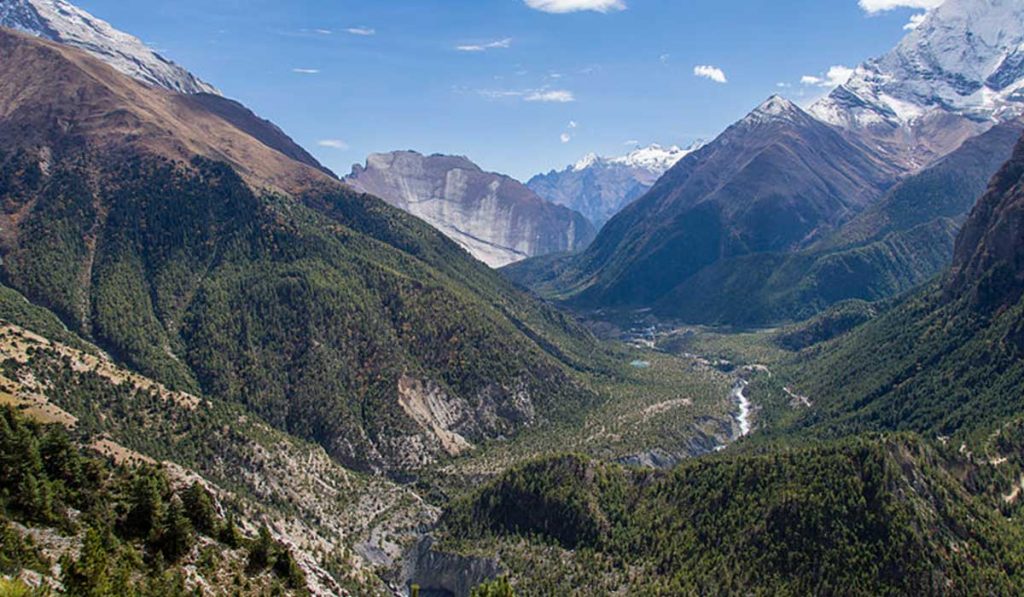
Annapurna Circuit Trek is full of wonder, energy, excitement, distinct culture, and mystical experience. ABC is the second most popular trek following Nepal’s Everest Base Camp Trek. This trekking path is overwhelmed by domestic and foreign trekkers on the paths with strength and enthusiasm.
The Annapurna region is among Nepal’s most critical rain shadow regions. As much of the path lies on the lee side of mountainous Annapurna. This area gets monsoon precipitation of just 10%.
Throughout Annapurna Circuit Trek, you can notice dramatic shifts in weather and temperature. The highest north region has different climatic conditions as compared to the lowest east region. The atmosphere and region’s temperature swings to a lesser extent with an altitude rise.
The maximum daytime temperature during the summer season reaches between 20°C and 30°C. The daily maximum temperature doesn’t reach 20° C during the winter season.
While this trip can be performed throughout the year however, weather plays an important role in deciding whether the trek is on or not.
So trekkers ought to take into account the weather and temperatures of every month before deciding anything.
Four most prominent seasons around the Annapurna region are Autumn, Spring, Summer, and Winter. The worst or difficult season to trek around Annapurna Circuit is Monsoon and Winter.
Annapurna Circuit Weather and Temperature in Autumn months
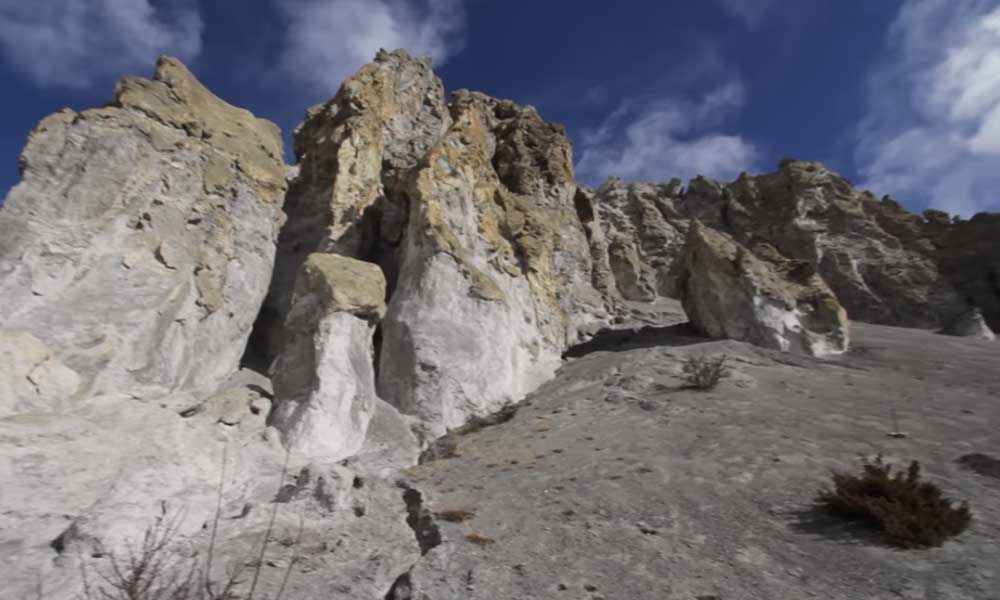
September is Autumn’s first month and also a peak season. The weather is getting bright and transparent day after day with the beginning of Autumn.
Yet the first couple of weeks in September, you will see light downpours showering. Then, around mid-September, the rainy season will go ahead.
From mid-Autumn, you will start getting the signals of a crystal-clearing environment. The temperature begins to fall at about 17°C to 4°C with all the rainfall away.
The highest point of the trek, Thorong La Pass (5416 m) , does have a daytime temperature of around -4°C . From the first month of Autumn itself, certain cloudy skies disrupt the view of mountains.
The alpine terrain, moreover, is here saturated by the monsoon rains and its vegetation. Here you will admire the view of the nice and clean countryside.
The weather is beginning to get better over time. The skies are mostly blue throughout late September.
October falls under the Autumn Season which is the perfect time to go trekking. The weather is steady and accurate, with less rain and chances of snowfall since the rainy season has only just finished. For nearly the entire period, sights of the mountains are unimpeded.
As well in this period, trekking is more convenient, as the days become sunny and warm. The average temperature is 15°C and the minimum temperature is not below 7°C .
The lower regions in the circuit are mostly dry, with a mean daytime temperature of 15°C. The higher regions are much colder than that of the lower region. It is cold early in the morning and in the evening too.
Over the October in upper areas are near to the freezing point. And overnight temperatures hit 7°C to 8°C . The Thorong La Pass becomes much colder than any other circuit spot. . Having heavy and warm clothing in the bag is suggested.
October’s hot and humid days speak out to tourists from around the planet. Also, they all learn and want to see the stunning, unspoiled Himalayan sights. So this is the reason behind the Annapurna delighted with lots of tourists.
The fall season continues straight to the end of November. November is indeed a perfect time to go trekking in Nepal too.
Annapurna Circuit weather and temperature in November is very similar to that of October. There are already shiny blue skies and bright sun during November.
There is no sign of precipitation and heavy snow rendering it to be a problem-free month.
November around the Annapurna Circuits gets an average daytime temperature of 15°C whereas the temperature of the night is around 7°C to 8°C .
Although, the highest pass like Thorung La Pass (5415 m) is still frozen. Areas around the Thorung La Pass can go below to -5°C. There is a perceptible disparity between daytime and nighttime temperatures.
The atmosphere is bright, with practically no cloud remnants. The images of the Annapurna range and the surrounding scenery are breathtaking.
The weather tends to only get colder near the month’s end, which marks the beginning of winter. Everything is fine until late November, after which the weather in this area gets colder. Therefore, this month, bringing warm dense thermal clothing is a must.
Annapurna Circuit Trek Weather and Temperature in Spring months

March is the first of the most pleasant Spring seasons to visit around Annapurna Circuit. It is a surprisingly best trekking month of the year.
This is a season of vegetation and flowers. Rhododendron and pine trees mainly cover the slopes and terrains.
Gradually, winter exits from the atmosphere, keeping the climate colder. With a mild climate, precipitation chances are low.
The lower area has an average daytime temperature ranging between 4°C and -8°C . While daytime weather can score as high as 10°C.
During most of the mornings and evenings, the weather turns colder therefore, you have to dress warmly to avoid any problems. The weather in March is very beautiful, and scenes of snow-covered peaks and tree-covered hills are outstanding.
The warmness of the spring season continues, but with the start of April, temperature rises. Numerous Nepalese festivals, such as the Nepalese New Year, also happens to be in the month of April.
It is also the best month for the trek, and the Annapurna Circuit weather is also favorable alongside it.
In April, enticing Spring also continues to spread a warm climate. With that of the bright sun out and no clouds, trekking on the lengthy Annapurna Circuit trails is seamless. There are smooth views of the mountains throughout.
All through April, upper regions have an average temperature of around 8°C to -4°C . But unlike a temperature of 20°C the lowest areas are still much cooler.
The nights are already as usual getting colder. Therefore, throughout the month you have to wear warm clothes when commuting.
Last month of Spring is May where the maximum temperature ranges around 14°C and 0°C and the peak level in the lower altitudes can be as high as 20°C .
The nighttime is always cold, though, so it is advisable to bring warm clothes that you may need for the night.
May is the hottest month as compared to other months. And evenings with a mean temperature of 5°C are a little cooler. The circuit’s highest point, Thorung La Pass, is also the coldest place this month.
Clouds can be found across the hills to block the scenes. But, by the end of the month, few temperature inversions are expected. So, in May it’s smarter to have waterproof coats, boots, pants when trekking.
[wte_trips_embedder_trips layout=”grid” ids=”731,726,121″]
Annapurna Circuit Trek Weather and Temperature in Monsoon months

It is also the beginning of the summer season, also called Monsoon Season. Throughout this season, the lowest region temperature is about 16°C to 30°C.
While temperatures in the upper area hover around -3°C to -4°C . It will be precipitation season; the tracks are unstable and slippery.
Furthermore, the rains still leave higher sections including Upper Mustang and Manang intact.
The Spring season’s weather is very unpredictable as the precipitation will occur anytime and continuously for 2-3 days . Therefore, the travelers do not find this time span to be trekking in any treks.
The weather is extremely unpredictable so it is highly recommended that trekkers wear waterproof garments.
It is not necessary to carry bulky stuff, it doesn’t help at all. However, you should carry a few lightweight jackets overnight.
However, some daring trekkers are coming in for the Annapurna Circuit Trek even in this month. They arrive here with complete rain gears.
July is really the month of each year experiencing the maximum rainfall. The region is a little cooler than the last month because of the heat, with a temperature of about 18°C to 6°C . The average temperature is approximately 12 ° C .
Owing to the wind from the Bay of Bengal, persistent rainfall occurs throughout the months of July. Also, rain carries clouds and covers views of the mountains. Therefore, mountain views are not guaranteed during this month.
Throughout Monsoon the paths across the scrub places are packed with leeches and mosquitoes. The days are often gloomy and muddy, so it’s recommended that the trekkers carry waterproof coats, trousers, and boots. Wearing a lot of warm clothes isn’t important, a few warmer outfits will work for dawn and night temperatures.
This last 30 days of the Rainy season brings clouds and begin to pour the rain on the field, keeping the region cold and humid.
The mean temperature remains close to July last month. Temperature is also beginning to rise, hitting some 19°C to 23°C.
Few frequent mudslides and erosion may occur which block the tracks. Pathways are wet and muddy, which increases the trekking difficulty.
Storm clouds wouldn’t clear this region in the period, so mountain scenes aren’t likely to turn up.
Trekking in the monsoon season is difficult however it is safe with proper planning and preparedness. Hence, packing on the appropriate rain gear is necessary before this trek.
Annapurna Circuit Trek Weather and Temperature in Winter months

Winter season begins with the month of December. Annapurna Circuit experiences the coldest in the winter season and also in December.
Under a cloudless bright sky, the hills are all covered in snow. Winter is one of the driest of all seasons, meaning no rainfall, or very little.
The average midday temperature of the Annapurna Circuit Trek begins to fall, touching approximately 10 C to 5°C.
As well as the nocturnal temperature decreases to -5°C . In the course of this period, the regions beyond 4000 m are much colder.
Around the beginning of December, the weather will be tolerable. But during the last days of December, the weather begins freezing.
Snowfall can strike at any time, in cold weather. Because of the snow, the routes continue to become difficult.
So, trekking throughout this circuit in the winter season is hard. So, during this month’s stay, you will outfit oneself with all of the winter clothing.
January is among the coldest months of the overall year. Daytime temperature in higher areas is about 1°C to -10°C .
The evening becomes much colder. Although the temperature for the low Annapurna Circuit varies from 7°C to 12°C .
Annapurna’s tracks are less populated, owing to the cold weather. January is ideal for those who love harmony, as they can appreciate the quiet paths. And, owing to an off-season, seeking lodging is seamless.
Throughout this month, views of the mountains are evident. It’s a great time to enjoy the peak view unimpeded.
The days are shorter, with more evenings. You may also enjoy thousands of Stars’ unhindered views.
To alert you that perhaps a visit is constrained to the higher Thorung La Pass. So, you’ll have to review the Annapurna Circuit weather and temperature.
In up to the higher regions the weather is usually volatile. The upper regions are mostly below 1°C.
Primarily, it is too cold to remain out an hour on the hour. During the colder months, therefore, the appropriate clothing is necessary for this trek.
February is here to wave goodbye to the winter season and embrace the spring season. Thus, the above month offers a two-season blend. In February the higher elevation is seeing some heavy snowfall.
There are greater chances of fog hiding views over the mountains. At the beginning of the season, the weather is always cold.
The temperature of the Annapurna Circuit continues to fall from -1°C to -14°C and that is incredibly cold.
The upper areas are colder still than that. But as February ends, the temperature begins to rise, making this couple of weeks diverse.
The days are shorter and nights longer in this month. When you plan on exploring during February, it’s best to come in warm clothes.
You may also like:
- Ghorepani Poon Hill Ghandruk Trek
- Annapurna Base Camp Trek
Ashish Niraula
Ashish Niraula is a seasoned trekker and professional tour consultant based in the country of the Himalayas. He has over seven years of hands-on experience in the sector, which has helped fortify his knowledge and expertise to craft the most iconic and memorable adventure packages in the Himalayas. Ashish’s passion for traveling and the unwavering drive that always pushes him toward excellency, have helped him earn a reputation as a trustworthy advisor in the tourism sector.
As a traveling enthusiast, Ashish has explored all the major trekking routes of Nepal. With years of experience exploring the mystical Himalayas and professional engagement in the field, Ashish honed his skills to design the most iconic adventure experiences in the Himalayas that cater to the adventure palate of every traveler. From organizing the challenging treks to the rugged Himalayas with incredible thrills to facilitating culturally immersive experiences across the traditional settlements in the country, Ashish’s commitment to excellence shines through every aspect of his work.
Popular Topics

COMMENTS
Fitness Level Required For Annapurna Circuit Trek in January and February. Annapurna Circuit trek demands a good level of fitness. The average of 4-7 hours of walking is done every day. The entire trek covers 160km to 230km by foot. The toughest climb of the whole trek is from Thorong Phedi(4,540m) to Thorong La pass(5,416m).
1254. Annapurna Circuit Trek during January and February offers a unique trekking opportunity that explores the second mainstream trekking route in the Himalayas when the region is at its peak. This circumnavigating adventure of the tenth-highest peak in the world, Mt. Annapurna [8,091 meters/ 26,545 feet], in January and February, lets you ...
The Annapurna Circuit and Beyond: Ultimate Guide to Hiking in Nepal (2024) Until 1951, Nepal was off-limits for foreign travellers; a secretive, isolated kingdom kept under wraps from outsiders…. But a change of regime gave birth to a new era of travel, and Nepal has remained a magnet for intrepid adventurers for over 70 years.
The Annapurna circuit typically takes between 16-20 days to complete. This is depending if you decide to tack on a diversion to Annapurna Base Camp and the Annapurna Sanctuary). It covers between 150-240 km depending on when you decide to end the tour or use transportation vehicles.
The standard Annapurna Circuit trek itinerary (from Jagat to Jomsom) takes 9 to 11 days to complete. To complete the full circuit (from Bhulbule to Nayapul) ... Posted on Published: January 5, 2023. Categories HIKING, Nepal. Post navigation. Poon Hill trek - a 2023 guide & itinerary.
January 7, 2024. 22 Min Read. ... Here is a 9-day Annapurna Circuit trekking itinerary where you can find a day-to-day guide that outlines the route, distance, and estimated time for each day of the trek. I also detailed my experience, including the teahouses, lunch stops, and highlights along the way to help you plan your trek effectively. ...
Himalaya Discovery Updated on January 8, 2024 January 5, 2024. Since the Annapurna Circuit trek opened to travelers in 1949. This is still among the most captivating trails in the country. ... Outline Itinerary of 12-Day Annapurna Circuit Trek. Day 1: Arrive in Kathmandu (1400m) Day 2: Drive to Jagat (1300m) Approx. 8 hrs.
The Annapurna Circuit trek was once the most popular tea house trek in Nepal. In about a month it was possible to walk around the Annapurna mountain peaks. This trek was famous for its ethnic villages, natural beauty and easy access from Kathmandu or Pokhara. But the Annapurna Circuit trek has changed tremendously in recent years.
Here is the basic outline of our Annapurna Circuit Trek Itinerary: Day 1: Bus from Pokhara to Besisahar - 5 hours. Besisahar to Bhulbhule - 9km/5.6 miles. Day 2: Bhulbhule to Jagat - 19km/11.8 miles. Day 3: Jagat to Dharapani - 17km/10.5 miles. Day 4: Dharapani to Chame - 17km/10.5 miles.
The Annapurna Circuit is a moderately difficult trek and is challenging for two main reasons. First, it's a relatively long trek. Most people cover up to 230km over 14-18 days or more. Second, it's a high altitude trek. There are a number of days spent at 3500m or higher, including a 5416m pass crossing.
The Annapurna Circuit Trek presents a remarkable and incomparable experience for all trekkers seeking a professional adventure. Spanning across four districts, namely Lamjung, Myagdi, Manang, and Mustang, and covering a vast distance of 160-230 kilometers, this trek provides the opportunity to explore the diverse natural vegetation, cultural beliefs, landscapes, altitude, trail, pristine ...
Himalaya Discovery Updated on February 19, 2023 January 8, 2023. The Annapurna Circuit Trek is one of the best treks in Nepal, if not the world-although road construction in the last two decades has had a significant impact on the trekking experience (more on this later). Note: if you're a mountain biker, the road on the west side is one of ...
Our detailed Annapurna Circuit trek itinerary. Our suggested 2-week Annapurna Circuit trek itinerary. Day 1. Bhulbhule - Ghermu, 15 km/9 mi. Route: Besi Sahar (760 m) - Ngadi (840 m) - Lampata (1017 m) - Bahundanda (1223 m) - Ghermu (1108 m) Starting point - Bhulbhule.
This classic Annapurna Circuit Trek hike used to take about 3-4 weeks to complete by foot with teahouses along the way to offer food and shelter for trekkers, but can now be done in less time. ... December and January offers similar visibility but a drop in temperature that can make the Annapurna Circuit trek very cold or even closed at the pass.
Here is the link to a helpful PDF guide which I highly recommended downloading offline for use while trekking the Annapurna Circuit: Download Annapurna Circuit Guidebook. Annapurna Circuit Itinerary: Important Hiking Information. Annapurna Circuit Permits ... January 4, 2024 at 5:35 pm . Reply. Tour Pokhara says: Such an informative article ...
One of the toughest decisions before trekking Annapurna Circuit is to plan what is the best season and when to go. In this travel guide, we share tips on when is the best time to hike Annapurna Circuit, including the best months and overall the best time to visit this popular Annapurna Range in Nepa ... WINTER: DECEMBER, JANUARY, FEBRUARY. We ...
Annapurna Circuit Trek is one of the most popular longest trekking trails in Nepal. it gives us a chance to explore the Himalayas from bottom to top. ... 7 January, 2025: Guaranteed: Book Now. 23 December, 2024: 12 January, 2025: Guaranteed: Book Now. 28 December, 2024: 17 January, 2025: Guaranteed: Book Now. 2 January, 2025:
The Annapurna Circuit Trek is a renowned multi-day hike that takes adventurers through the breathtaking Himalayan landscape of Nepal. Starting in the vibrant capital of Kathmandu, trekkers embark on a 15-day journey that promises awe-inspiring vistas, culture in charming mountain villages, and the exhilarating challenge of crossing the Thorong La Pass.
Itinerary of Annapurna Circuit Trek. Expand All. Day 1: Arrival in Kathmandu (1,300m) Day 2: Drive from Kathmandu to Besishahar (800m)7- 8 hours. Day 3: Drive to Syange and trek to Jagat (1,300m) 4-5 hours. Day 4: Trek from Jagat to Dharapani (1,960m) 7-8 hours. Day 5: Trek from Dharapani to Chame (2,710m) 5 - 6 hours.
It's one of the world's classic long-distance hiking trails, and still one of Nepal's most popular treks. The Annapurna Circuit, a 12 to 21-day route that begins in the lush green villages of the Himalayan foothills. Taking trekkers over the 5,416m Thorong La Pass and down to the Tibetan-influenced temples and communities of the Mustang ...
Annapurna Circuit Tours in January 2025 4.5 stars on (6,679 reviews) ... "The Annapurna Circuit Trek itself was nothing short of spectacular. The trail took us through a diverse range of landscapes." Henry Johannsen, traveled in February 2024 From US $1,259 Price per day ...
January 9, 2020. Written by Travel Lexx. 4 The Annapurna Circuit Trek is considered one of the best long-distance treks in the world and for good reason. Famous for its stunning scenery, traditional villages and a chance to see some of the world's highest mountains, it really has it all. ... Annapurna Circuit Trek in numbers. Location ...
The Annapurna Circuit trek offers some of the most spectacular views of a multitude of enormous snow-capped peaks and treks through high altitude passes, ... tour and expedition in Nepal which was established on January 07, 1977, with a motto: 'Enhancing Tourism possibilities across the Globe'. ...
Annapurna Circuit Trek is full of wonder, energy, excitement, distinct culture, and mystical experience. ABC is the second most popular trek following Nepal's Everest Base Camp Trek. ... January. January is among the coldest months of the overall year. Daytime temperature in higher areas is about 1°C to -10°C. The evening becomes much colder.